
THE ART AND CRAFT BEHIND THE CAMERA ISSUE 014 MARCH 2023 JESS HALL BSC ASC•LARRY SMITH BSC ASC•MARIA VON HAUSSWOLFF DFF•BEN SMITHARD BSC•LARKIN SEIPLE•OONA MENGES•SALVATORE TOTINO AIC ASC CHECCO VARESE ASC•BENJAMIN LOEB•FRANK VAN DEN EEDEN NSC SBC•GREGORY OKE•LUC MONTPELLIER CSC•CHAS BAIN•BIANCA CLINE INSIDE THIS ISSUE

#SHOOTFILM Learn more at Kodak.com/go/motion © 2023 Kodak. Kodak and the Kodak logo are trademarks. Awards Season recognizes excellence. So do we. Congratulations to the most celebrated productions of 2022, brought to life with KODAK film.
Rascals Publishing & Media Ltd!
Red Lion Yard, Odd Down, Bath United Kingdom BA2 2PP
Tel: +44 (0) 1428 746 375

Editor-in-Chief RON PRINCE ronny@cinematography.world
Special Consultant ALAN LOWNE alan@cinematography.world
Editorial Assistant KIRSTY HAZLEWOOD kirsty@cinematography.world

Advertising Manager CLAIRE SAUNDERS claire@cinematography.world
Social Media & Comms KAZ PEARMAN kaz@cinematography.world
Web Manager IAIN HAZLEWOOD iain@cinematography.world
Art Direction & Creative Kinda Stuff
JAM CREATIVE STUDIOS adam@jamcreativestudios.com tim@jamcreativestudios.com
CONTACT US
News hello@cinematography.world
Ad sales & Subscriptions +44 (0) 1428 746 377

Artwork artwork@cinematography.world +44 (0) 1428 746 375 www.cinematography.world
EDITORIAL TEAM
Ron Prince has over three decades of experience in the film, TV, CGI and VFX industries, and has written about cinematography for 20 years. In 2014, he won the ARRI John Alcott Award from the BSC. He also runs the international content marketing and PR communications company Prince PR. “Count” Iain Blair is a British writer/musician who lives in LA and writes extensively about film/entertainment for outlets including LA Times, Variety and Reuters. He interviews movie stars, as well as Hollywood’s top filmmakers.

Darek Kuźma is a film and TV journalist, translator/interpreter, and a regular collaborator/programmer of the EnergaCamerimage Film Festival. He is an ardent cinephile who has a lifelong romance with the visual language of cinema.
David Wood is a freelance journalist covering film/TV technology and production He was a former technology editor at Televisual, and is a regular contributor to Worldscreen, TVB Europe and Broadcast.
Dylan Bruce is a cinematographer based in London, working primarily on narrative shorts and music promos. Beside his love for simple, humanistic storytelling, he is a keen street-photographer.
Iain Hazlewood has three decades of experience in marketing and media, across music, TV/film and electronics. He writes extensively about the UK’s folk and roots music scene, and interviews DPs and manufacturers in the film world.
Kirsty Hazlewood has over two decades of editorial experience in print/online publications, and is a regular contributor to folk/roots music website Spiral Earth.
Larissa Mori is a trained VFX artist who also writes about filmmaking, computer graphics and associated technologies. She is currently based in Lisbon.
Michael Goldman is an LA-based award-winning, journalist/author, specialising in the art, technology and people involved in filmmaking and cinematography. His is a long-time contributor to American Cinematographer and CineMontage.
Natasha Block Hicks is an artist/designer/maker, who spent a decade as a freelance film and TV camera assistant, and indulges her love for cinema and cinematography through research and writing.
Oliver Webb is a film graduate/freelance journalist based in the UK, and is the founder/editor of CloselyObservedFrames. His interests include screenwriting, British New Wave cinema and the works of Ingmar Bergman.
Cover Image: Chevalier, shot by Jess Hall BSC ASC. Image ©20th Century Studios. All Rights Reserved.
AND THE WINNER IS…
This edition comes hot-on-the-heels of an awards season, perhaps like no other, where much debate was had about those who might lift the industry’s top accolades for their incredible cinematographic endeavours.
We send our congratulations to James Friend BSC ASC on his clutch of BAFTA, BSC and Academy awards, for All Quiet On The Western Front, filmed in arduous conditions, and delivering a powerful antiwar message. Felicitations to camera operator Danny Bishop, ACO Associate BSC SOC, who won the SOC’s top award for his work on that film.
We also send our congratulations to Mandy Walker AM ACS ASC for her historic win at the ASC Awards for her dazzling work on Elvis, which she dedicated to future female cinematographers, and Hélène Louvart AFC who was awarded a Berlin Silver Bear for her outstanding artistic contribution on Disco Boy. Their successes must surely be beacons of inspiration that anything is possible.
We started Cinematography World with the aim of supporting a more diverse and inclusive culture in filmmaking. Indeed, if our own recent celebration of IWD 2023 – where we highlighted the cinematographic talents of women in feature films – is anything to go by, there are plenty of people out there who show that the world has changed, albeit at seemingly glacial speed, and it will go on changing for the better.
If there’s a project that is dear to your heart, please get in touch. We will do our best to support and champion your skills around the world. Stay safe and best wishes.
 Ron Prince Editor in Chief
Ron Prince Editor in Chief
SUBSCRIBE
You can subscribe to the print, digital, or print and digital, versions of Cinematography World. This will cover you for the six issues delivered over a 12-month period. Your email will also be added to our monthly newsletter update, unless you decide to opt out of these news feeds.
Cinematography World is part of Rascals Publishing & Media Ltd! The publishers emphasise that opinions expressed within Cinematography World Magazine are not representative of Rascals Publishing & Media Ltd!, but are the responsibility of individual contributors.
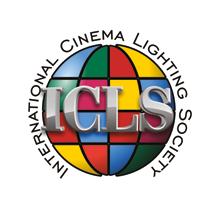
Cinematography World is created using responsibly sourced paper. All inks used during the printing process are vegetable based and virtually free from volatile organic compounds. Waste, paper, ink and consumables are recycled. Where this is not possible waste is sent to specialist centres for safe disposal.

CINEMATOGRAPHY WORLD MARCH 2023 3
ISSUE 014•CINEMATOGRAPHY WORLD
Cinematography World is created using responsibly sourced materials RECYCLE
Everything is possible, if you really believe in the idea of what you’re doing
Cinematographer
Sophie Muzychenko
Ron Prince photo by Joe Short www.joeshort.com
Official Media Partners
Artistic Character. Modern Sensibilities.
ZEISS Supreme Prime Radiance Lenses
The ZEISS Supreme Prime Radiance lenses are designed to provide a unique look, no matter the sensor size. Capable of covering S35, Full Frame and beyond, you can be confident in developing a look all your own, no matter the camera you choose.
For more information: zeiss.com/cine/radiance






CINEMATOGRAPHY WORLD MARCH 2023 5 ISSUE 014•CINEMATOGRAPHY WORLD
38 DAISY JONES AND THE SIX
30 65
52 CHEVALIER
INSIDE ISSUE 014 MARCH 2023 6 VIEW FROM THE TOP• PRODUCER IAIN SMITH OBE 8 PRODUCTION NEWS 16 WHO, WHAT, WHEN & WHERE 24 SMOOTH OPERATOR•ARI ROBBINS SOC 26 OONA MENGES •LOLA 30 SALVATORE TOTINO AIC ASC •65 32 LARKIN SEIPLE •TO LESLIE 36 BEN SMITHARD BSC •THE SON 38 CHECCO VARESE ASC •DAISY JONES AND THE SIX 40 PREVIEW•BSC SHOW ROUND-UP – SPECIAL REPORT 52 JESS HALL BSC ASC •CHEVALIER 56 LARRY SMITH BSC ASC •LUTHER: THE FALLEN SUN 60 MARIA VON HAUSSWOLFF DFF •GODLAND 62 FRANK VAN DEN EEDEN NSC SBC •CLOSE 64 GREGORY OKE •AFTERSUN 66 LETTER FROM AMERICA•ROY WAGNER ASC 68 ONE TO WATCH•SOFIYA MUZYCHENKO 70 STUDENT UNION•KPEDU, FINLAND 72 LUC MONTPELLIER CSC •WOMEN TALKING 74 CHAS BAIN •A TOWN CALLED MALICE 76 BIANCA CLINE •MARCEL THE SHELL WITH SHOES ON 78 BENJAMIN LOEB •SICK OF MYSELF 80 ON TOUR•WARNER BROS. DE LANE LEA 82 SPOTLIGHT•UNIVERSAL PRODUCTION SERVICES 84 GAFFERS CAFÉ•LAS AMAZONAS ELÉCTRICAS 86 SHOOTING GALLERY•BSC EXPO EXTRAS
26 LOLA
60 GODLAND
LOOK TO YOUR LAURELS
Just recently there have been some very positive press announcements emerging from our industry. It seems that collectively we’ve been doing something right.
The British Film Commission announced that UK Inward Investment film and high-end TV production spend reached the record figure of £5.37 billion in 2022. (In 2013, the figure was around £1.3 billion.)
Ben Roberts, the BFI chief executive, said this when the announcement was made: “Today’s record-breaking figures for film and TV production in the UK are great news for our industry and the UK economy, and underline the success of our industry at a global level.
“Our world-class talent, craft and production services, and vital film and TV tax reliefs, have enabled the UK to be a major player in a highlycompetitive global industry. Further investment in expanding studio space UK-wide to meet production demand will continue to build on this economic success and create further jobs.”
A few days later Pinewood announced that Buckinghamshire County Council had approved the go-ahead for the expansion of the studios by a whopping 1.4millionsq/ft (130,064sq/m) to build 21 new stages, a training hub and a publiclyaccessible nature reserve. They declared that the expansion would make Pinewood “the biggest studio complex in the world” and create 8,000 jobs.
Everyone take a bow.
Since the turn of this century, the fight for targeted government support has been a constant goal, led initially by the UK Film Council and subsequently by the British Film Commission, among others.
We chose to focus primarily on the economic arguments in support of the industry. This was language the government could understand and measure. We were able to demonstrate that the multiplier benefit to the UK economy would be of the order of £12.49 for every £1 of tax relief granted.
A good example of a ‘no brainer’.
This inward investment-based strategy was a huge gamechanger, and our industry, building on its reputation for talent, technical quality, state of the art skills and reliability, came together to make sure it worked.
In 2013, the advent of the high-end tax relief for television drama opened-up the possibilities even more, enabling the two previously separate industries to work together for the first time. The emergence of the streaming business, led initially by Netflix, unleashed the demand for filmed entertainment around the world to previously unheard-of levels.
Since then the technical and crew infrastructure has been expanding, led of course by Warners at Leavesden and by Pinewood/Shepperton more recently. Our longterm investment in skills has been broadening the workforce, introducing new entrants and maintaining and modernising our traditionally high level of skill.
has raised subscription prices in America by 38% to staunch financial losses at its Disney+ streaming service.
Netflix is struggling to maintain its business model. Its share price tumbled last year after it announced a net loss of 200,000 global subscribers. It expected to lose many more. Its share price also slid more than 35% in early trading, wiping around $55bn (£42bn) off its value.
Our Hollywood overlords are in turmoil. Read the trades. The studios and streaming companies are desperately trying to redefine how the business can remain profitable.
For this reason, we have to remain incredibly well-informed and alert. The emerging truth is that running up the next Jurassic World sequel will no longer be enough to keep the cash registers ringing in Hollywood.
Hollywood must find ways to strengthen the bond between its customers, the public, and its product, and we must strive to help them do that.
But we must be vigilant.
Our industry’s continuing success is dependent on the control of distant minds coping with the whimsy of a global audience. Sudden and rapid technological change will continue, change must be considered ‘the norm’ and we must collectively remain agile in staying ahead.
More than ever before, the UK is being competed with by rising production centres emerging around the world. These countries are offering generous inducements to an increasingly price-conscious and globalised business, and their skills and facility bases are growing all the time.
The observant amongst us will also be watching the turmoil going on in the studio world as the streaming business becomes a crowded business model under pressure.
At Disney, sudden returnee Bob Iger’s realitycheck is particularly instructive. He has said that 7,000 Disney staff will be let go; studio operating costs will be slashed by $2.5bn; content spending will reduced by a further $3bn. In addition, Mr Iger
To add to the potential challenges we face, we wouldn’t be British if we didn’t throw in some traditional self-harm from left field. At the time of writing, UK film and television studios are attempting to ward-off huge rises in government property tax that could potentially annihilate the very existence of our studios. You couldn’t make this stuff up!
Since the movies began audiences have always rewarded, quality, diversity and innovation. We must always continue to give the audience what they want, but in ways they don’t expect.
So let none of us rest on any laurels, no matter how well-deserved those laurels may be. Make no mistake, the work goes on!
Iain Smith OBE Producer Chair of British Film Commission National Advisory Board

6 MARCH 2023 CINEMATOGRAPHY WORLD
VIEW FROM THE TOP•IAIN SMITH OBE
We have to remain incredibly well-informed and alert












THANK YOU FOR CHOOSING WWW.PANALUX.BIZ PISTOL DoP ANTHONY DOD MANTLE DFF, BSC, ASC GAFFER HARRY WIGGINS THE PENTAVERATE DoP JAMIE CAIRNEY GAFFER THEO MILFORD MY POLICEMAN DoP BEN DAVIS BSC GAFFER ONX NARANG SLOW HORSES, SEASON 2 DoP DANNY COHEN BSC GAFFER PAUL MCGEACHAN MEN DoP ROB HARDY ASC, BSC GAFFER JONNY FRANKLIN OUTLANDER, SEASON 6 DoP ALASDAIR WALKER GAFFER SCOTT NAPIER DOWNTON ABBEY: A NEW ERA DoP ANDREW DUNN BSC GAFFER JOHN CLARKE EMPIRE OF LIGHT DoP ROGER DEAKINS CBE, BSC, ASC GAFFER JOHN HIGGINS ALL THE OLD KNIVES DoP CHARLOTTE BRUUS CHRISTENSEN ASC GAFFER JOHN HIGGINS PEAKY BLINDERS, SEASON 6 DoP MATHIEU PLAINFOSSÉ AFC GAFFER CHRIS GEORGAS THE CROWN, SEASON 5 DoP ADRIANO GOLDMAN ASC, BSC, ABC DoP BEN WILSON DoP RASMUS VIDEBAEK DoP FRANK LAMM GAFFER CHRIS STONES GAFFER ANDY LOWE MAGIC MIKE’S LAST DANCE DoP STEVEN SODERBERGH GAFFER MICHAEL MCDERMOTT
JAMES FRIEND BSC ASC & MANDY WALKER AM ACS ASC IN THE 2023 AWARDS SPOTLIGHT
With the 2023 awards season drawing to a close, James Friend BSC ASC collected a haul of accolades for his work on All Quiet On The Western Front. Friend won the esteemed statuette for Best Cinematography at this year’s Academy Awards, as well as the Best Cinematography BAFTA and the BSC Award for Best Cinematography In A Feature Film.
In his BAFTA acceptance speech, Friend said that the film’s message – that young people can be “poisoned by right-wing nationalistic propaganda” and
DANIEL BISHOP WINS SOC CAMERA OPERATOR OF THE YEAR
The 2023 recipient of SOC’s Camera Operator Of The Year in Film was Daniel Bishop SOC Associate BSC ACO for his work on All Quiet On The Western Front. The recipients of Camera Operator of the Year in Television were Dave Chameides SOC and B-camera operator Cristian Trova for Ozark, S4 Ep 14, “A Hard Way to Go”. .
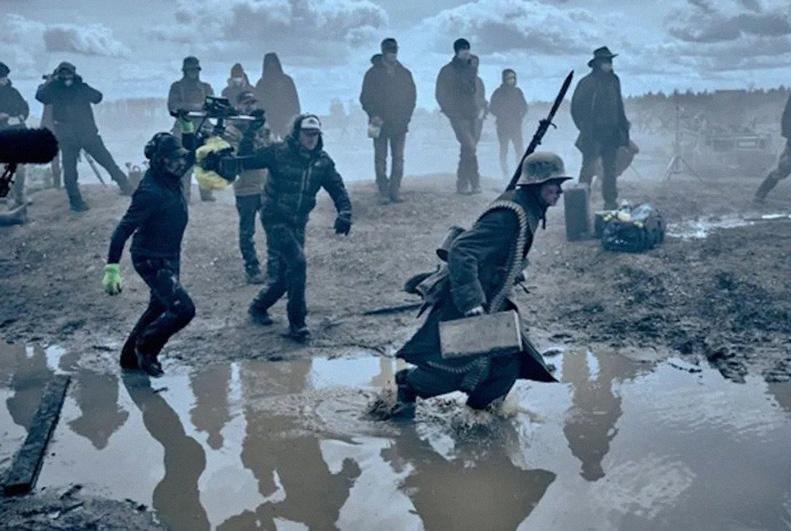

Guests, nominees and decorated industry leaders were among the hundreds who attended the SOC Awards, which returned to an in-person event
that “war is more than an adventure” – is as relevant now as it was more than a century ago when the book of the same name by Erich Maria Remarque was first published.
In addition, Mandy Walker AM ASC ACS made history by becoming the first woman to win the award for Best Feature Film for Elvis at the ASC Awards. As she took to the stage to accept the prize, Walker dedicated the win to “all the women that win this award” after her.

for the first time since the Covid19 pandemic.
A first for the awards, the SOC announced six nominees for Camera Operator of the Year in both the Film and Television categories; and for a second year, the SOC expanded nominations to include collaborative efforts and teams of operators.
During the awards, Oscar-nominated actor Colin Farrell was honoured with the Governors Award, and ARRI Inc. and Hudson Spider accepted SOC Technical Achievement Awards.
ARI WEGNER ASC ACS WINS AT GIRLS ON FILM AWARDS
Ari Wegner ASC ACS won Best Cinematographer at the second annual Girls On Film Awards, rewarding exceptional women in cinema, for her work on The Wonder and The Power Of The Dog.

Girls On Film voters said that Wegner’s work as a cinematographer has gone from strength to strength.
“Ari has won this award for The Wonder and The Power Of The Dog, in which she used moody, intimate yet bold imagery. She can take the viewer effortlessly from a dark, draughty attic with a dying girl, to sweaty, opium-induced dreams of loss, to a brassy, frost-bitten
FRENCH DP HÉLÈNE LOUVART AFC WINS SILVER BEAR FOR DISCO BOY
Irish
Winners announced at the 73rd Berlin Film Festival included French cinematographer Hélène Louvart AFC, who was awarded the Silver Bear for Outstanding Artistic Contribution for her work in Disco Boy, directed by Giacomo Abbruzzese.

The film depicts the intertwined stories of Aleksei, a member of the French Foreign Legion, and Jomo, a guerrilla fighter in a village in the Niger Delta.
On The Adamant, directed and shot by Nicolas Philibert, scooped the coveted Golden Bear prize as the best film of the festival’s International Competition.
The film chronicles a unique day-care centre in the heart of Paris that welcomes adults suffering from mental disorders, offering the kind of care that grounds them in time and space and helps them to recover or keep up their spirits.
Introducing the film, jury head Kristen Stewart said the pic is “masterfully crafted” and acts as “cinematic proof of the vital necessity of human expression.”
PRODUCTION & POST NEWS 8 MARCH 2023 CINEMATOGRAPHY WORLD
countryside, whilst retaining a unity within the film. She has an exquisite eye for tone and composition.”
Photograph Michael Yada ©A.M.P.A.S
DaVinci Resolve now available for iPad

DaVinci Resolve for iPad is the world’s only solution that combines editing and color correction in one software tool. Its elegant, modern interface is fast to learn and easy for new users, yet powerful for professionals. DaVinci Resolve lets you work faster and at a higher quality because you don’t have to learn multiple apps or switch software for different tasks.
Fast Turnaround with Cut Page Editing!
The cut page is perfect for projects with tight deadlines that you have to turn around quickly. It’s also great for documentary work. Features such as source tape for visual media browsing, fast review, and smart editing tools help you work faster. The sync bin and source overwrite tools are the fastest way to edit multi-cam programs, with easy to create perfectly synchronized cut aways!
Hollywood’s Favorite Color Corrector!
The DaVinci Resolve for iPad color page is Hollywood’s most advanced color corrector and has been used to color and finish more high end feature films and television shows than any other system! The color page has an incredible range of primary and secondary color grading features including PowerWindows™ , qualifiers, 3D trackers, advanced HDR grading tools and more!
Blackmagic Cloud Collaboration
DaVinci Resolve for iPad supports the revolutionary Blackmagic Cloud, a whole new way of collaborating using cloud based workflows. Simply create a Blackmagic Cloud ID to log into the DaVinci Resolve Project Server and set up a project library for your project. You can assign any number of collaborators to a project and share projects. Multiple people can work on the same timeline!
No Subscription Costs, No Data Tracking!
DaVinci Resolve is free to download. There are no subscriptions to sign up for, no monthly license fees and no tracking of your usage or data. This means you never have to pay just to keep access to your work. Plus, DaVinci Resolve for iPad is easy to learn as it works the same way as the desktop version that runs on Mac, Windows and Linux.
DaVinci Resolve Free Download SRP is Exclusive of VAT. www.blackmagicdesign.com/uk Learn More!
EVERYTHING EVERYWHERE ALL AT ONCE & WOMEN TALKING TAKE TOP PRIZES AT WGA AWARDS
Daniel Kwan and Daniel Scheinert’s original screenplay for award-season juggernaut Everything Everywhere All At Once (DP Larkin Seiple) and Sarah Polley’s adapted screenplay for Women Talking (DP Luc Montpellier CSC) won the marquee awards at the WGA Awards.
The WGA, which handed-out trophies for the year’s best writing in dual ceremonies in Los Angeles and New York City, also gave Apple TV+’s Severance wins for Drama Series and New Series, and FX’s The Bear for Comedy Series. HBO’s The White Lotus won for Limited Series, and Last Week Tonight with John Oliver won for Comedy Variety Talk Series.

ADAM INGLIS JOINS HARBOR UK AS SENIOR COLOURIST
RTS award-winner and BAFTA-nominee Adam Inglis will join Harbor’s UK creative talent line-up as senior colourist, starting early summer 2023. With a global reputation that has seen him collaborate with a host of acclaimed producers, directors, and cinematographers from the UK, US, and Europe, Inglis has high-end scripted features and TV dramas on his credit list, as well as iconic, award-winning wildlife documentaries such as Planet Earth II and Our Planet.
His work in 2020 on Apple TV’s Earth At Night In Colour won two RTS West awards, one RTS award, and was nominated for a BAFTA. Other highlights include Sherlock Holmes, Mr. Turner and Wolf Hall.

Speaking on Inglis’s addition to Harbor’s global talent roster, operations director Thom Berryman and commercial director James Corless said, “We are so privileged to welcome Adam on the team after such a long time collaborating with him as a freelancer. He brings an exceptional level of artistry and technical expertise to the grading process. Additionally, he’s a great collaborator, and we can’t wait to have his input in the growth of Harbor in London.”
EURO CINE EXPO ANNOUNCES COLLABORATION WITH HFF – THE MUNICH FILM SCHOOL
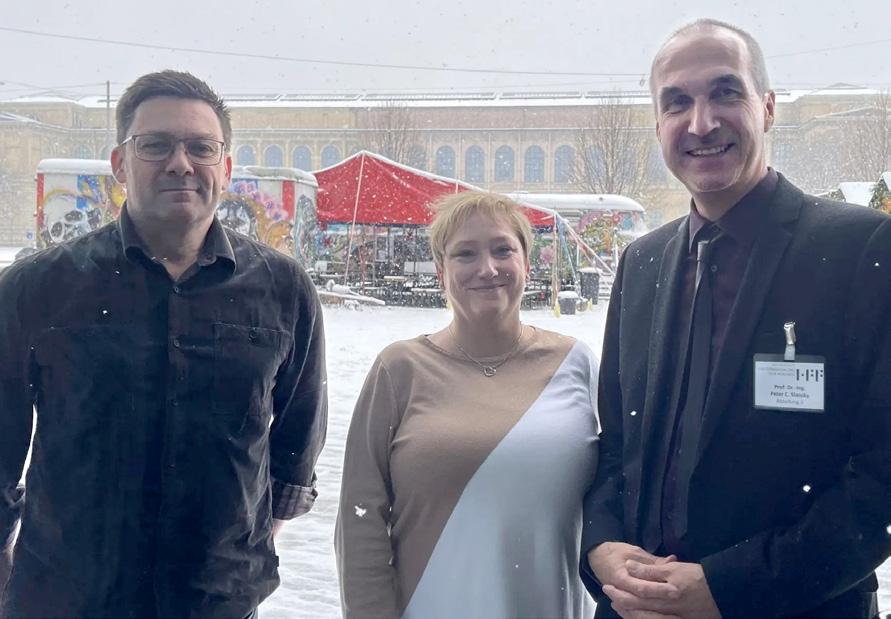
Euro Cine Expo is excited to announce an exciting collaboration with HFF –Hochschule für Fernsehen und Film München, the Munich Film School.
As one of the most renowned film schools in the German-speaking countries, HFF Munich offers its students a choice of film-related study courses, provides professional training for directing documentary and fiction films and series, editing, production, screenwriting, and cinematography; as well as VFX supervision and production.
HFF will be curating a number of events throughout Euro Cine Expo including a presentation on “The lens and the look. Why different lenses with the same optical parameters make different images”
The school will also be presenting the results of a survey on the importance of the following four topics for cinematography teachers:
• Virtual Production – Shooting in LED volumes
• Multi-camera shooting
• Sustainability and green shooting
• The use of analogue film in teaching (digital) cinematography.
Claire Saunders, Euro Cine Expo event director commented:
“Euro Cine Expo 2023 is excited to announce this collaboration with HFF which will mutually promote and support our organisations. We look forward to welcoming many film students from HFF as well as other film schools, along to our event, helping to encourage the next generation of talent into this thriving industry.
DP EVELIN VAN REI BECOMES MEMBER OF THE NSC
DP Evelin Van Rei has been invited to join the Netherlands Society of Cinematographers. Van Rei was the recipient of the Angénieux Special Encouragement award in 2022, allowing her to use Angénieux’s cutting-edge lens technology to film her next project.

She has been interested in cinema since the age of eleven and decided to study at the Cambridge School of Art in England, where she discovered her fascination for the art of images. She is the first self-
taught cinematographer to receive the Angénieux endowment, after French-Mexican Pamela Albarrán (2021), Indian Modhura Palit (2019) and Chinese Cécile Zhang (2018).
Her credits include Bad Sisters (3 episodes), Vera and 100 Vaginas, along with many music videos including artists such as Sam Fender.
Van Rei commented, “The NSC invited me to talk about my work and ethos at the Netherlands Film Festival last year, and have since been such a
warm, and welcoming community. I owe a special thank you to board members Joris Bulstra NSC, Josje van Erkel NSC, and bureau coordinator Barbara Suters, and my proposers Myrthe Mosterman NSC and Guido van Gennep NSC.”
PRODUCTION & POST NEWS 10 MARCH 2023 CINEMATOGRAPHY WORLD
LEITZ ELSIE CHARAKTER BY DESIGN

WWW.LEITZ-CINE.COM
AVAILABLE NOW
RED LAUNCHES SUPER35 V-RAPTOR AND V-RAPTOR XL CAMERAS
COOKE OPTICS AUGMENTS S8/I
FF LENS RANGE WITH FOUR NEW FOCAL LENGTHS
Cooke Optics has announced the launch of four new focal length lenses – 27mm, 35mm, 65mm and the highly anticipated 18mm – joining the S8/i Full Frame (FF) series range. Evolving the renowned ‘Cooke Look’, S8/i FF lenses deliver images that have an organic feel and a smooth, spherical bokeh effect with minimal colour fringing. S8/i lenses enable cinematographers to capture images with a high level of dimensionality.

“We are excited to launch additional S8/i lenses into what’s already a market-leading range for full frame production,” said Tim Pugh, CEO of Cooke Optics. “Further focal lengths offer cinematographers even more choice and flexibility to achieve their creative visions.”
Red Digital Cinema has announced the availability of the V-Raptor 8K S35 and V-Raptor XL 8K S35 featuring Red’s powerful, new S35 sensor. The new 8K S35 sensor has the same fast cinema-quality sensor scan time as its 8K VV counterpart, which is twice as fast as previous generations while maintaining incredible dynamic range with 16.5+ stops and coverage for Super 35mm lenses.

The V-Raptor XL 8K S35 also includes Red’s new integrated electronic ND system, allowing for precise control of density in 1/4, 1/3, and full stop increments, providing never before seen exposure and depth of field control.
“The V-Raptor and XL have produced some of the best imagery I’ve seen, and now that performance is available to the filmmakers who prefer the Super35 format,” said Red Digital cinema president Jarred Land. “Not just from the users who love their vintage S35 lenses and the flexibility of 8K, but the shooters working in areas like wildlife filmmaking and broadcast television. We’re excited to start seeing what they create with the new S35 cameras.”
RUBEN ÖSTLUND NAMED JURY PRESIDENT AT 76TH FESTIVAL DE CANNES
Fifty years after fellow citizen Ingrid Bergman, Swedish director Ruben Östlund, a two-time winner of the Palme d’or, will preside over the jury of the 76th edition of the Festival de Cannes to be held from May 16 to 27, 2023.

“I am happy, proud, and humbled to be trusted with the honour of jury president. Nowhere in the film world is the anticipation as strong as when the curtain rises on the films in Competition at the Festival. It is a privilege to be part of it, together with the Cannes audience of connoisseurs,” declared Östlund.
With a track-record of only six features, the filmmaker was selected twice at Un Certain
Regard, where he was awarded the Jury Prize in 2014, before later entering the competition. No sooner did he appear there that the Palme d’or was awarded to him twice; first for The Square at the 70th Festival de Cannes, and then for his next film acclaimed last year, Triangle Of Sadness, both shot by Fredrik Wenzel.
After studying cinema in Gothenburg, Östlund directed his first feature film, The Guitar Mongoloid (DP Tibor Gent), in 2004. On the edge of the documentary genre, the film describes the intersecting destinies of outcasts in a fictional city that closely resembles Gothenburg. Humour as a tool of sociological description was already apparent.
By inviting Östlund to preside over the jury, the Festival de Cannes wishes to pay a tribute to films that are uncompromising and forthright and which constantly demand that viewers challenge themselves and that art continue to invent itself.
“As president, I will remind my colleagues in the jury about the social function of the cinema,” added Östlund. “A good movie relates to the collective experience, stimulates us to think and makes us want to discuss what we have seen. So let’s watch together!”
PGGB PROMOTES MICHAEL BEAVAN TO DEPUTY CEO
The Production Guild of Great Britain (PGGB) has announced that Michael Beavan has been promoted to the position of deputy CEO.

Beavan joined the PGGB team as director of partnerships and projects in 2021 with a remit to grow the reach and profile of PGGB across film and television sector partnerships. In the past two years he has driven a 50% increase in company affiliations with the Guild and forged new business partnerships around the country in support of
PGGB operations, including the rollout of six new Nations and Regions committees and special events to improve diversity and inclusion, such as the recent, first-ever, PGGB Talent Showcase, sponsored by Disney Studios Content and supported by Entertainment Partners.
As deputy CEO, Beavan will work primarily with PGGB’s CEO and board of trustees to develop and deliver the Guild’s business strategy and oversee operational delivery.
PRODUCTION & POST NEWS 12 MARCH 2023 CINEMATOGRAPHY WORLD
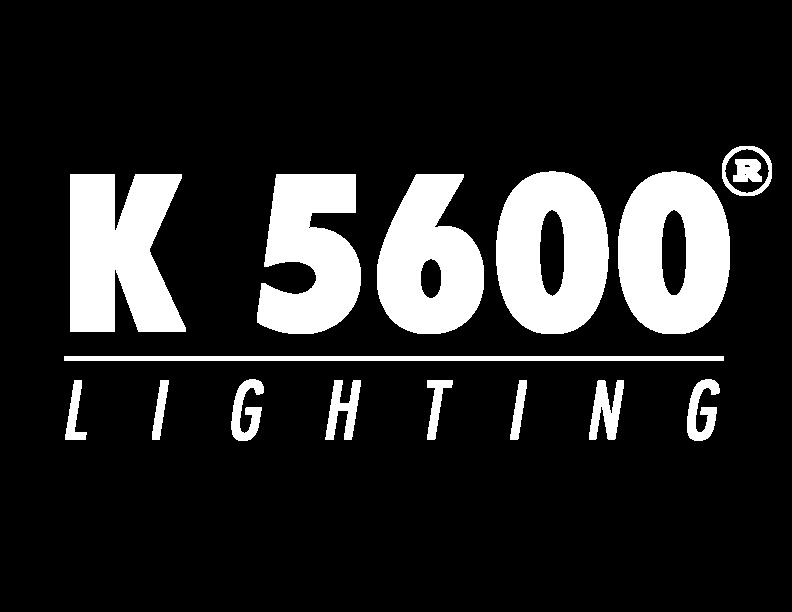
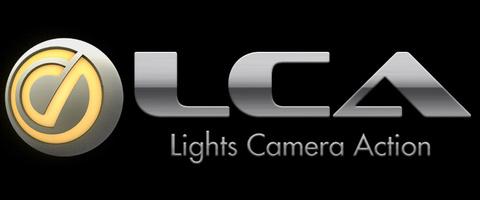


Call your local dealer or contact us : info@k5600.eu For the UK LCA I T ' S N O T J U S T T H E P A I N T ! ! !
To celebrate 30 years of existence, K5600 Europe has dedicated 10 units of each Jokers and Alphas featuring a 10 year warranty.
BFI INVESTS £14M
IN UK’S
FUTURE WORKFORCE AND FILMMAKERS OF TOMORROW
The BFI has announced £14m National Lottery ‘good cause’ educational funding for 5-18 yearolds. Investment in three programmes of UK-wide activity will see a significant shift in focus in how the BFI will support film education with National Lottery funding going forward, an outcome of its new ten-year strategy published last year.
The BFI is awarding funding to two UK-wide partners to deliver three targeted work streams: BFI National Lottery Teaching with Film, BFI National Lottery Young Creatives and BFI National Lottery Careers and Progression. Into Film, receiving £12.4m over three years, will work across all three programmes, and National Saturday Club will receive £1.5m for the same period to collaborate with Into Film to deliver Young Creatives. The change in focus and development of the three programmes has been informed by the industry and public consultation undertaken by the BFI when devising its National Lottery Strategy 20232033, and will see activity starting in April 2023.
Leigh Adams, director of education and learning, said, “Screen culture has a unique power to support learning and expand horizons, so we’re focused on extending our reach to more children and young people. The funding announced will see us connect with more schools to ensure teachers, educators and career professionals can bring screen culture into the classroom as a powerful tool to support learning across the curriculum, and open doors to a range of career opportunities.”
Almost £5m for Teaching with Film will result in a change of focus for Into Film, the film education charity, to see it prioritise bringing screen culture into formal education settings to benefit more 5-18 year-olds.

The £6m Careers and Progression programme will aim to ensure 11-18 year-olds have access to expert careers information, guidance and advice on entering the screen sector. Proactive and rapid upskilling of school careers leads will give them insight, tools and resources to open doors to the vast array of job and career opportunities available.
CVP CELEBRATIONS OF INTERNATIONAL WOMEN’S DAY 2023
CVP,one of Europe’s leading providers of professional video and broadcast solutions, hosted a vibrant exhibition showcasing a collection of photography by female cinematographers as part of the celebration of International Women’s Day on 8th March 2023.

Entitled, ‘A Female Perspective – Gallery’, the exhibit displayed a collection of beautiful and powerful photographs from the Mark Milsome Foundation’s (MMF) latest charity calendar, under its Prints For Mark initiative. The 2023 calendar, titled “The Female Perspective” was shot by members of Illuminatrix, the society of UK-based female cinematographers.
Prints For Mark seeks to honour the life of cinematographer Mark Milsome BSC by supporting young people as they enter the British film and television industry. Funds from this year’s calendar will enable the MMF to develop entry-level positions, creating more diverse opportunities behind the scenes, whilst continuing to promote better health, safety and wellbeing practices for the industry.
Each print from this year’s calendar represents a unique feminine perspective from all walks of life with images focusing on politics, family and business, using high quality photographs shot all around the world.
Andra Milsome, founder of the Mark Milsome Foundation, said, “I would like to thank each and every one of these talented women who have helped us bring together this wonderful collection of inspiring photographs for the Mark Milsome Foundation’s 2023 Charity Calendar.
“This is an incredible way to honour the fifth-year anniversary of Mark’s passing and his legacy, and to promote more equal opportunities in our industry. The foundation would also like to thank CVP for hosting the exhibit at its ARRI Creative Space so that more people have access to these beautiful prints.”
Also celebrating International Women’s day, Cinematography World has added a selection of exclusive articles featuring female DPs such as Mandy Walker AM ACS ASC, Natasha Braier ADF ASC, Judith Kaufmann BVK and Autumn Durald Arkapaw ASC to its website, showcasing the many incredible women in cinematography worldwide.
For Young Creatives, Into Film and the National Saturday Club (each awarded £1.5m of National Lottery funding) will work collaboratively on UK-wide, community-based programme for 11-16 year-olds. With a focus on those living in educationally, culturally and socially disadvantaged areas, the programme aims to galvanise local organisations to deliver a quality offer of entry level practical filmmaking training outside of the curriculum.
These programmes see the BFI continuing its long term support of Into Film, plus building on a successful pilot which saw the BFI support the National Saturday Club to deliver the Film&Media programme for the last two years. They also complement the recently announced BFI Film Academy Plus, which will deliver in venue education activity by partners across the UK, while further funding to continue a more comprehensive BFI Film Academy offer, plus significant investment in supporting skills, will be detailed in the continued roll-out of the new strategy.
HAWK LONDON TO OPEN SUMMER 2023
The Hawk Guys,’ Peter Martin and Wolfgang Baumler, have announced their collaboration with Peter Joarder and Charles Heales to create a new state-of-the-art operation in London. Hawk London will be established as a full rental service company including cameras, lenses and grip equipment. This addition to the Hawk and Vantage family means Hawk Anamorphic lenses and all other Hawk and Vantage products can be rented and serviced in the UK.
“At Hawk, we’re proud of our 30-year track record of constant lens innovation,” said CEO and co-founder Peter Martin. “Our success has always fuelled our further endeavours. Throughout that
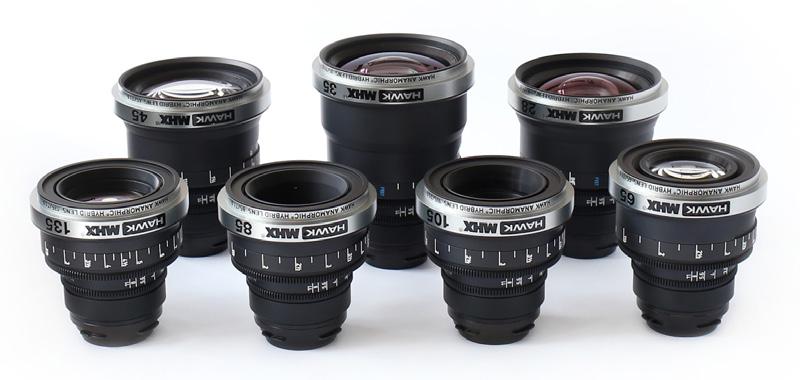
time, we’ve worked with major British producers on the biggest projects, from Star Wars right up to The Little Mermaid. With Hawk London, we’re putting down roots in the vibrant UK market, and looking forward to continued success in tandem with our partners there and around the globe.”
Hawk London is supported by facilities worldwide including Weiden, Los Angeles, Paris, Prague, Marrakech, Leipzig, Brussels and Berlin. This significant investment represents a serious, long-term commitment to the presence of Hawk in the British market.
PRODUCTION & POST NEWS 14 MARCH 2023 CINEMATOGRAPHY WORLD
‘
RED V-RAPTOR



Available Now The DSMC3 generation of cameras offer the most powerful and advanced cinema camera performance on the market. The V-RAPTOR and V-RAPTOR XL systems are both now available with either the “8K VV + 6k S35 Multi-Format” sensor or the all-new “8K S35” version. CVP is Red’s only UK Premium Reseller, and is proud to be the only RED Certified Service Centre in the UK, offering first line local support, repairs and service for RED’s full range of cameras and accessories. Book a demo demo@cvp.com Get in touch +44 (0) 208 380 7400
EVERY PICTURE TELLS A STORY
Our regular round up of who is shooting what and where
SCREEN TALENT:
George Burt recently shot the movie Joe Baby, starring Harvey Keitel, Ron Perlman, Dichen Lachman and Willa Fritz.

LUX ARTISTS:
Rob Hardy BSC ASC has finished shooting The Book Of Clarence directed by Jeymes Samuel. Jessica Lee Gagne continues on S2 of the Apple TV+ series Severance with director Ben Stiller. Adam Newport-Berra lit a Bud Light commercial directed by Trey Edward Shults. Mauro Chiarello Ciardo shot a Hoka ad with director Ian Pons Jewell. Rasmus Videbaek is shooting on The Crown S6, directed by Erik Richter Strand. Diego Garcia framed an EE spot with director Daniel Wolfe and a Corona ad with director Nico Perez Vega. Henry Braham BSC is lensing The Instigators with director Doug Liman. Sebastian Blenkov filmed an Accenture TCV with director Sam Brown. Pat Aldinger shot a Gatorade ad with director Henry Scholfield. Jarin Blaschke is shooting Nosferatu, directed by Robert Eggers. Michael
McDonough BSC ASC continues on The Decameron, directed by Michael Uppendahl. Ben Fordesman lensed




Staropramen and IBM commercials directed by Ian Pons Jewell.
Lol Crawley BSC is shooting The Brutalist with director Brady Corbet. Crystel Fournier AFC continues on Blood River, directed by Angela Terrail. Julien Poupard AFC has wrapped on a currently unnamed feature, directed by Ladj Ly. Nicolas Bolduc CSC is shooting Ourika with director Marcela Said. John Lynch is prepping Rivals with director Elliot Hegarty. Magnus Joenck is lensing Psycho Killer with director Gavin Polone. Steve
Annis shot an Army commercial with director Rupert Sanders, and an Audi ad, directed by Dan Di Felice. Nanu Segal BSC continues on Curveball with director Philip Martin. Daniel Landin BSC lit a Snapchat spot with Andreas Nilsson, and a C4 commercial directed by Daniel Wolfe. Bobby Shore is prepping The Way with director Michael Sheen. Ruben Impens SBC filmed a Heineken ad, directed by Frederic Planchon. Adolpho Veloso is lensing A Queen At Sea with director Lance Hammer.
WORLDWIDE PRODUCTION AGENCY:
PJ Dillon ISC ASC is shooting on HBO’s House Of The Dragon S2 with director Alan Taylor. Ruairí O’Brien ISC BSC continues principal photography on We Were The Lucky Ones with directors Thomas Kail and Neasa Hardiman for Hulu in Romania. Tony Slater Ling BSC is lighting Cold Storage with StudioCanal and director Jonny Campbell in Italy. Baz Irvine ISC BSC is shooting on Apple TV+ Wool S2 with director Michael Dinner. Ed Moore BSC has graded Hijack with director Jim Field Smith for Apple TV+. Arthur Mulhern ISC is prepping Fremantle’s Euston Films/BBC Nightsleeper with director Jamie Stone in Scotland. Björn Charpentier SBC continues principal photography on Netflix’s The Gentlemen with director Nima Nourizadeh. Callan Green ACS NZCS is prepping for The Gentlemen with director Eran Creevy. Manoel Ferreira SASC continues on Amazon Prime’s Alex Rider S3 with director Brian O’Malley. Joel Devlin is lighting My Sister’s Bones with director
Heidi Greensmith for BKStudios. Catherine Derry is filming A Thousand Blows with director Tinge Krishnan for Disney+/Hulu. Jamie D. Ramsay SASC is prepping on Goodrich with director Hallie Meyers-Shyer for Pascal Pictures in LA. Paul Morris has started on Time S2 with director Andrea Harkin for BBC. Luka Bazeli is lighting the feature The Glasshouse at Black Hangar Studios. Anna Patarakina FSF has wrapped principal photography on Two Brothers Pictures/BBC/ Amazon Freevee’s Boat Story with director Alice Troughton. Tibor Dingelstad NSC has concluded principal photography on Paramount+/Buccaneer Media’s The Doll Factory with director Sacha Polak.
Vanessa Whyte has graded the third series of Ted
with directors Declan Lowney, Destiny
16 MARCH 2023 CINEMATOGRAPHY WORLD
W HO, WHAT, WHEN & WHERE
Lasso
This page: DP George Burt (l) on Joe Baby with actors Ron Perlman and Harvey Keitel, and crew; Natasha Duursma at the camera; DP Arseni Khachaturan with director Luca Guadagnino on Bones And All; and Mauro Chiarello Ciardo (B&W on the dolly).
Ekaragha and Erica Dunton, and is prepping Apple TV+’s Horseface with director George Kane. Nathalie Pitters had done the DI on Dreaming Whilst Black with directors Jermain Julien and Joelle Mae David for BBC/A24. Richard Donnelly ISC has graded Sanctuary with director Lisa Mulcahy for AMC in Dublin, and done additional photography on The Three Body Problem with Jeremy Podeswa for Netflix. Andy Hollis has done the grade on Showtime/C4’s Entitled with director Tim Kirkby. Matthew Fox was in South Africa with Yousef and Pretty Bird on a Robinsons ad. Thomas Revington travelled with RSA to South Africa for and M&S spot, directed by Marie Schuller. Benjamin Todd wrapped an Elephant Kind promo for Riff Raff and director Rich Hall, and went on to shoot an IKEA spot with Division
Entertainment, with director Gulshan Singh. Pete Rowe is shooting Fable Pictures’ Hullraisers S2 with directors Ian Fitzgibbon and Aaron Hillier. Alistair Upcraft is prepping for Quay Street Productions’ Fool Me Once in Manchester. Matt Wicks is lighting Vigil S2 for World Productions and director Andy De Emmony. Phil Wood is shooting Quay Street Productions/ITV’s After The Flood with director Azhur Saleem.
INDEPENDENT TALENT:


Dan Atherton is prepping for new TV series Trinity, directed by Brady Hood. Chas Bain’s A Town Called Malice has released on Sky. Ole Bratt Birkeland BSC is in Vancouver prepping Andrew Stanton’s In The Blink of An Eye Bjorn Bratberg recently wrapped on Annika S2, and is now



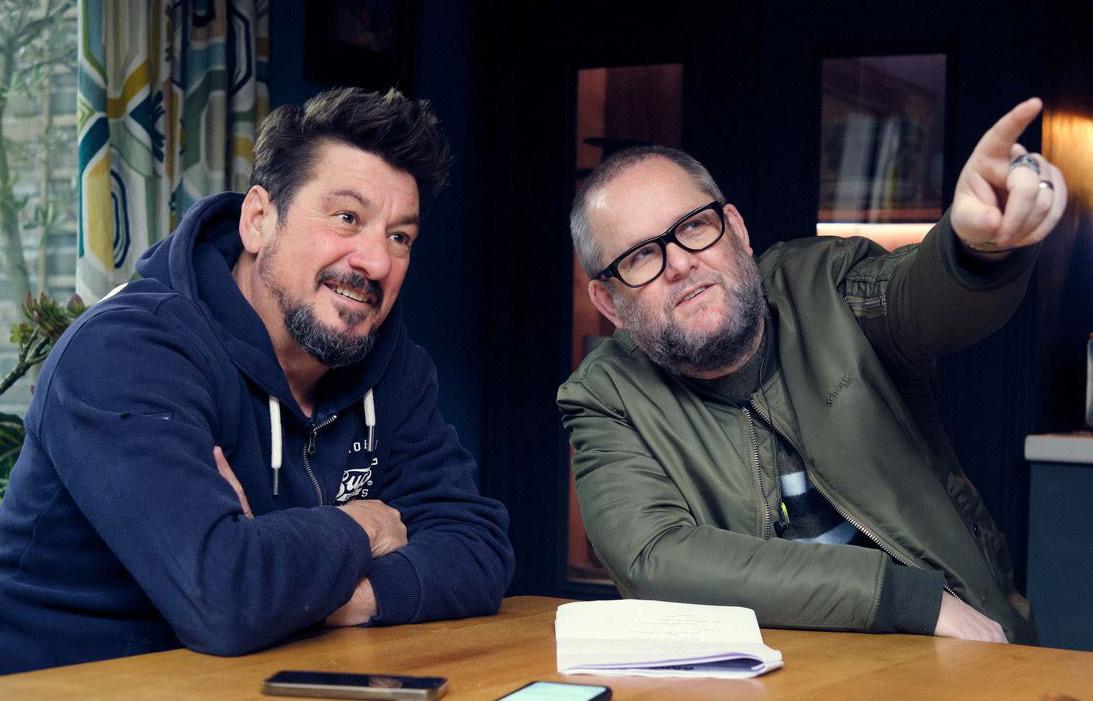

has started shooting Andor S2 with Janez Metz. James Rhodes’ debut feature film, Femme, premiered at the 2023 Berlinale, and he has been shooting various live concerts including Elton John’s Farewell from Dodger Stadium. George Richmond BSC is prepping Deadpool 3 for Sean Levy. Chris Ross BSC is prepping The Day Of The Jackal Ashley Rowe BSC is shooting Belgravia with John Alexander. Martin Ruhe ASC has been shooting ads with Uncle Shortbread, Bjorn Ruhmann and The Sacred Egg. Mark Waters is shooting a C4 short called Anfamol directed by Judith Dine. Maja Zamojda BSC is shooting block 1 on My Lady Jane, based on a book by Brodi Ashton, Gemma Burgess, Cynthia Hand and Jodi Meadows.
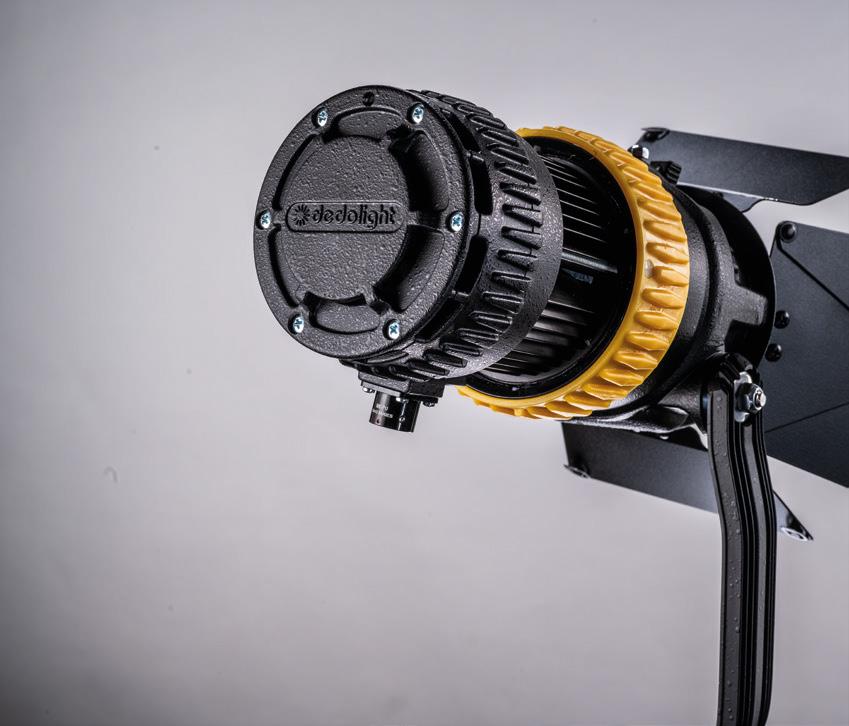

WHO,
&
WHAT, WHEN
WHERE
UK and Ireland Rental and Sales Distribution: www.cirrolite.com Visit the dedolight website: www.dedoweigertfilm.de
High
Video mode up
50.000
All DMX on
(8/16
The ultimate solution ANZ_CineWorld_05-22_final.indd 1 05.05.22 20:42
WIZZO & CO:
NEO ballast serves all dedolight LED 20 to 90 Watt. Mono-, bicolour, UV, IR, battery or AC operation Dimming smooth to
0.2%
Speed
to
fps
board
bit) Option wireless
Photograph by Dušan Martinček
This page: (clockwise from top) – DP Lukasz Zal PSC; Manoel Ferreira (l) with director Brian O’Malley; Arran Green on Count Abdulla; Ashley Barron ACS on Dangerous Liaisons. photo by Dušan Martinček; and Bjorn Charpentier on The Gentlemen.
Moscow alongside director Sam Miller. Susanne Salavati has graded The Lazarus Project S2. Dymtro Nedria has wrapped on For Your Eyes Only Antonio Paladino has completed the grade on James Marsh’s feature Dance First. Ryan Kernaghan continues on the feature Kneecap Fede Alfonzo has completed the colour grade on feature Made In Dublin Charlie Goodger is prepping on Big Boys S2 alongside director Jim Archer. Matthias Pilz has grade the feature Excursion, directed by Una Gunjak. Karl Oskarsson IKS is prepping. Ben Magahy has graded Sky drama Smothered Seppe Van Grieken SBC continues on an embargoed drama. Nicola Daley ACS is shooting the final episodes of Halo Jan Richter-Friis DFF continues on Fear The Walking Dead in the USA. Steven Ferguson is with director Chris Addison on Breeders S4. Chas Appeti continues on an embargoed drama. Carmen Pellon Brussosa shot short film Wolf, directed by the Blaine Bros. Luke Bryant is shooting Extraordinary S2 alongside director Jennifer Sheridan. Christophe Nuyens SBC continues to shoot an embargoed drama. Tim Sidell BSC shot with Jaime James Medina and completed the grade on short film Kink Darius Shu shot for director Pawel Jamark, and Will Bex for Johnny & Will. Joe Douglas framed for Bjorn Ruhmann, Franklin Dow with David Stoddart, Hamish Anderson with Andrew Lane and Peter James with Elliot Dear. Arran Green shot with Troy Roscoe and Henry Gill with Dustin Tan. David Procter BSC lit for Juriaan Booij, and Theo Garland for Chris Balmond.
ECHO ARTISTS:
Stuart Bentley BSC is lighting the feature We Live In Time, directed by John Crowley. Federico Cesca ASK is grading his episodes of Netflix’s Top Boy, alongside director Myriam Raja. Rachel Clark has completed the grade on Lucy Cohen’s Knockers Nick Cooke has wrapped on Bring Them Down, directed by Christopher Andrews. Bonnie Elliott ACS is shooting episodes of Daina Reid’s series The Veil for Hulu. Will Pugh is lensing BBC Studios’ documentary The Great Rhino Robbery, directed by Jesse Vile for Sky Documentaries. Bartosz Swiniarski has completed on Jurgis Matulevicius’ feature China Sea Niels Thastum

DFF shot episodes of thriller series Veronica, with director Jonas Alexander Arnby. Chloë Thomson has wrapped on documentary Witches, directed by Elizabeth Sankey. Evelin van Rei NSC is working on Ludovica Musumeci’s feature I Am Felix Wiedemann BSC shot blocks one and three of ITV series Three Little Birds, directed by Charles McDougall. Nicolas Cannicioni, Nadim Carlsen DFF, Carlos Catalan, David Chizallet AFC, Andrew Commis ACS, Ruben Woodin Dechamps, Edgar Dubrovskiy, David Gallego ADFC, Charlie Herranz, Jo Jo Lam, Macgregor, Anders Malmberg, Lachlan Milne ASC, ACS, NZCS, Michael Paleodimos, Korsshan Schlauer, Noel Schoolderman, Maria Von Hausswolff and Sean Price Williams have all been shooting commercials.
VISION ARTISTS:
Benedict Spence is in Hungary shooting the Netflix series Eric with Benedict Cumberbatch, directed by Lucy Forbes. Anna MacDonald is gearing up to shoot the short film The Talent, produced/starring Emma D’Arcy, directed by Thomas May Bailey and shot using volume technology. Anna is also prepping to shoot dramatic reconstructions for the feature-doc Stranded In Space about the Apollo 13 mission, directed by Pete Middleton, vis Insight TWI Films. Jonas Mortensen has graded the Sky feature Bonus Track, directed by Julia Jackman. Nick Morris has graded Netflix series The Fuck It Bucket for Left Bank, and teamed up with longterm collaborator Harry Lighton to shoot second unit on Sky/AMC drama Mary And George starring Julianne Moore. Kia Fern Little has been grading The Long F Off, an instalment of C4’s anthology series On the Edge, directed by James Doherty and produced by BlackLight TV, and is continuing to shoot an NDA’d Apple TV music documentary on a high-profile British star. James Blann shot the Guardian documentary Digital Divide with new directors Right to Roam, exploring the process of digital exclusion. Will Hanke has been shooting on Starstruck S3 for Avalon/BBC, directed by its star, Rose Matafeo. Courtney Bennett worked with Somesuch on an album film for an NDA’d artist, directed by Renee Osubu. Ryan Eddleston is shooting an NDA’d BBC3 short, written and directed by

Uncle Shortbread and produced by Nick Coupe for Hat Trick productions. Rhys Warren shot a period short World War 2 drama, called Bracia, with director Theodore Bhat. In commercials, Arthur Loveday lit for New Balance with director Craig Bingham at ITV. Eoin McLoughlin worked again with creative director Christopher Simmonds on Gucci ads. James Watson continues shooting with Manchester-based outfit Chief. Jim Jolliffe is back with Dark Energy. Kai Blamey was abroad with Lammas Park shooting football with Jade Ang Jackman. Luke C. Harper lit fashion and sports pieces with Tom Dream. Luke Scott has been shooting Crime & Investigation promos for A+E Networks. Martin Hill was in Mexico with Snapper Films. Richard Mott teamed-up with Neil Harris at Smuggler. Spike Morris is shooting a range of commercials with Agile Films. New signing Tim Fok has been lighting comedy and food pieces with Rollo Hollins. Tim Green lensed a variety of tech pieces with photographer and director Dan Tobin Smith.
LOOP TALENT:

welcomes DP Chris Fergussson to its roster. Chris recently shot the revamped Bad Education series for Tiger Aspect/BBC, and lensed the UK shoot for upcoming period drama Ten Pound Poms. Kyle Macfadzean’s series Class premiered on Netflix and was featured in The Guardian’s ‘Seven Best Shows To Stream’. Lorenzo Levrini is shooting a feature in Rome with Elsinore Film. His previous feature, Amanda, had its UK premiere at the Curzon Soho. Ali Little is prepping for an HETV drama with Clerkenwell Films. Ali Asad is shooting a feature with director Neil Marshall in Malta. Jon Muschamp has wrapped on the feature The Trap directed by Lena Headey. Emma Dalesman is back from India for the location leg of The

 This page: (clockwise from top) –Arran Green Count Abdulla; Jo Jo Lam at the IFFR worldpremiere of Playland; Tom Turley on Chemistry Of Death.
Opposite: Martyna Knitter during production on My Eyes Are Up Here.
This page: (clockwise from top) –Arran Green Count Abdulla; Jo Jo Lam at the IFFR worldpremiere of Playland; Tom Turley on Chemistry Of Death.
Opposite: Martyna Knitter during production on My Eyes Are Up Here.
18 MARCH 2023 CINEMATOGRAPHY WORLD WHO, WHAT, WHEN & WHERE
Buckingham Murders Tania Freimuth shot a feature in Dublin. Martyna Knitter graded a BBC series Matt North shot on a BBC Drama. Matt Gillan’s film Home is screened at BFI Flare. Jerry Amadi-Pradon is in talks for various HETV productions. Rik Burnell’s documentary, Red Herring, screened at the True/False Festival. Tom Turley is shooting commercials and meeting for features. Olly Wiggins lit for director Marcus Liversedge Aman K Sahota has been shooting with They Gather and Kode Media. Tom Watts is lensing spots. Bertrand Rocourt continues shooting with Juergen Teller. Paul MacKay has been working with Craft, Nick Bennet with The Gate, Recipe and ITV. Chris O’Driscoll has been shooting ads around Europe. Camera Operator Alice Sephton has joined Loop Talent Diary Service. Jem Rayner GBCT ACO operated dailies on Outlander James Anderson ACO did a stint in the USA on a documentary project. Jack Smith is shooting in Jamaica on a Paramount feature. Grant Sandy-Phillips recently wrapped on Midtown Laura Seears collaborated with new DPs on various music promos. Michael Vega, Gary Kent, Michael Eshun-Mensah and Sebastien Joly ACO have been shooting spots.
UNITED AGENTS: Remi Adefarasin BSC has wrapped the feature Locked In for Gaumont/ Netflix with director Nour Wazzi. Søren Bay DFF has graded Three Little Birds with director Yero Timi-Biu for Tiger Aspect Productions. John Lee BSC is shooting Fool Me Once for Quay Street Productions/Netflix, with director David Moore. Philippe Kress DFF is prepping Domino Day with director Eva Sigurdardottir for Dancing Ledge/BBC3. Danny Cohen BSC is prepping Spook Street, the second series of Slow Horses for Apple TV. Damian Paul Daniel is filming pilot Kirkmore for Fudge Park. Martin Fuhrer BSC and Kieran McGuigan BSC are focusing on short form. David Higgs BSC is in post on Anand Tucker’s feature The Critic Matt Lewis is filming in Manchester on Philip Barantini’s series Boiling Point. Laurie Rose BSC has concluded on The Lord of the Rings: The Rings of Power S2. Bet Rourich AEC is filming Isabel Coixet’s latest film, Un Amor John Sorapure is in post on Guillem Morales’ feature The Wasp Simon Tindall is meeting for various long form projects. Ollie Downey BSC is prepping two episodes of Wool for Apple TV+/AMC. Laurens De Geyter SBC is shooting Couple Next Door, directed by Dries Vos Sam Heasman has graded Supacell for Netflix. David Rom is shooting the
EB1812P GEN 2
18KW/12KW/9KW/6KW
opening block of Amazon’s The Devil’s Hour S2 and Simon Stolland is working on short form Si Bell is prepping the feature Giant for director Rowan Athale. Sam Chiplin, Juan Sarmiento G., Kate Reid BSC, Anna Valdez Hanks and Charlotte Bruus Christensen DFF ASC are reading and meeting. James Friend BSC ASC is one of two DPs on Star Wars franchise Paradox for Lucasfilm. Anton Mertens SBC is under offer to light Kidnapped, a BBC Three series with Al Mackay directing. Milos Moore has started prep on the second block of A Thousand Blows for Disney+ with director Ashley Walters. Neus Ollé AEC BSC is lighting Disney+ series Las Largas Sombras in Spain for director Clara Roquet. David Raedeker BSC is lighting FX series Say Nothing with lead director Michael Lennox Niels Reedtz Johansen is prepping for director Hayley Easton Street’s next feature The Climb Ed Rutherford is shooting The Serpent Queen S2 in France with director Stacie Passon. Ben Wheeler is lighting for director Paul Whittington on This Town for Kudos/BBC. Barry Ackroyd BSC is filming The Sympathizer in LA for director Fernando Meirelles. Alex Barber lit a McDonalds spot with director Joy Kilpatrick for MJZ, and an Andrew Douglas project in Cape Town. Philipp Blaubach is with director Rupert Wyatt doing additional photography of Desert

BALLAST
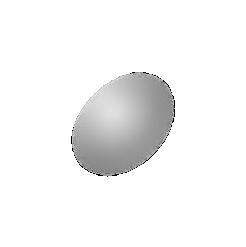
NEXTGEN BALLASTS WORK IN THE

POWER
DESIGNED TO OPERATE IN HIGH HUMIDITY

STABLE WITH THE HARSHEST OF POWER SUPPLIES
1000HZ HIGH SPEED
RUGGED
www.powergems.com
WHO, WHAT, WHEN & WHERE CINEMATOGRAPHY WORLD MARCH 2023 19
ELECTRONIC
GEMS
PROVEN RELIABILITY HARSHEST
CONDITIONS
Warrior in Saudi Arabia. Daniel Bronks shot the latest Inhaler music video, ‘If You’re Gonna Break My Heart’ for director Hugh Mulhern vis Riff Raff, London. Simon Chaudoir was in Athens for Merman US on a Mastercard ad with directors AB/ CD/CD and a shot a TSB commercial in London with director Finn Keenan for Riff Raff Films. Lasse Frank lit a Lurpak TVC in Warsaw with director Axel Bryfors for Creators Inc. Nick Gillespie is shooting upcoming TV series Trigger Point 2 in London. Florian Hoffmeister BSC is lighting Night Country in Iceland for director Issa López. Stephen Keith-Roach lensed a Thames Water ad with directors Dom & Nic via Outsider. Alex Melman framed a Specsavers job for director Vince Squibb at Academy, and a Lotto spot for director Jake Mavity at Rogue Films. James Oldham lit an Omaze commercial with director Adam Lambert at Transmission. Matias Penachino shot a Cupra job with directors Manson in Barcelona, and a Renault TVC in Cape Town with director Daniel De Viciola bvia Prodigious. Simon Richards filmed a Santander spot for director Guy Manwaring at Pulse, and a Cityfibre Ad for director Sam Cadman at Another Film Company. Miles Ridgway is shooting the feature Daddy’s Head for director Ben Barfoot. Chris Sabogal shot a Bissell TVC for director John O Hagan at Hungryman, London. Joost Van Gelder was in Cape Town shooting a Samsung commercial for director Adam Berg at Smuggler, and lit a Formula E ad for director Sam Walker. Daniel Vilar is shooting TV series Welcome to Derry in Toronto. Marcel Zyskind was in Paris on an Enedis commercial for Cyril Guyot through Hotel Particular.
CASAROTTO RAMSAY & ASSOCIATES: Greg Duffield is prepping on the Apple TV comedy Trying S4. Matt Gray wrapped on The Killing Kind with director Zara Hayes, and started on ITV’s new series Mr Bates vs The Post Office Ebba Hult was in Paris shooting the latest Alexander McQueen runway show. David Katznelson DFF BSC is shooting The Tattoist Of Auschwitz for Sky Atlantic with director Tali Shalom-Ezer. Frank Lamm is with director Florian Cossen on Hera Picture’s Mary & George Hélène Louvart AFC is in Rome shooting Eran Riklis’ Reading Lolita In Tehran Kate McCullough ISC was nominated for the ASC’s Spotlight Award for The Quiet Girl David Pimm is prepping on We Were The Lucky Ones, filming in early May. Michael Wood BSC is getting ready for Hellboy: The Crooked Man with director Brian Taylor.
PRINCESTONE:
Of the agency’s DPs… Diego Rodriguez is filming Poised, a feature-doc about Steven France, ex-MMA champion, directed by Toby Robson and
produced by Two Yanks And A Brit UK. Of the agency’s camera/Steadicam operators… Simon Baker ACO is still on The Crown S6, with directors Christian Schwochow, Alex Gabassi and Stephen Daldry and DPs Adriano Goldman ASC BSC ABC and Sophia Olsson for Left Bank Pictures and Netflix, in Majorca, Barcelona, Paris, England and Scotland. Cosmo Campbell ACO is shooting on Extraordinary 2, a comedy series for Sid Gentle Films and Disney+, with DP Alvaro Gutierrez and Toby MacDonald directing, at Three Mills Studios and locations in East London. Michael Carstensen ACO was on block one of Mary And George series

Of The Dragon S2 for HBO. Fabrizio Sciarra SOC Associate BSC GBCT ACO shot reshoots with the main unit on Mission Impossible 7 - Dead Reckoning Part 1 with director Chris McQuarrie and DP Fraser Taggart. Peter Wignall ACO was in Turkey on The Ministry Of Ungentlemanly Warfare, Guy Ritchie’s new World War II drama feature for Jerry Bruckheimer Films, with DP Ed Wild BSC, starring Henry Cavill and Eliza Gonzalez.
MY MANAGEMENT:
for Hera Pictures with Oliver Hermanus directing and Alexander Dynan as the DP, starring Julianne Moore and Nicholas Galitzine, and has since been on the Blood Unit on House Of The Dragon S2 with DPs PJ Dillon and Catherine Goldschmidt among others. Rob Hart ACO has been working on the Buccaneer Media.Paramount+ series The Burning Girls with director Kieron Hawkes and DP Gary Shaw. Tony Jackson ACO was in Bucharest on 20th Television mini-series We Were The Lucky Ones with director Thomas Kail and DP Tim Ives. James Layton ACO did Steadicam on the feature Promised Land for Revolution Films with director Michael Winterbottom and DP Giles Nuttgens BSC, starring Harry Melling and Douglas Booth. Dan Nightingale ACO has wrapped on Sexy Beast, a prequel TV series of the film for Paramount+, with director Michael Caleo, DP Bebe Dierken BVK, starring James McArdle, Emun Elliot, Sarah Greene and Stephen Moyer. Peter Robertson Associate BSC ACO is filming on Sky’s eightpart Mussolini biopic, M. Son Of The Century, at Cinecitta with director Joe Wright and DP Seamus McGarvey BSC ASC. Joe Russell ACO shot on Andor S2 with DP’s Christophe Nuyens SBC, Mark Patten BSC and Damián Garcia. Sean Savage Associate BSC ACO SOC finished shooting Netflix’s Straight Shooter series and is now on House
now represents the renowned Alexander Witt ASC. Now based in London, Alex is known for second unit work on Resident Evil: Apocalypse (2004), The Bourne Identity (2002), Terminator Genisys (2015) and No Time To Die (2021), and is currently in Mexico filming, The Border, based on Don Winslow’s award-winning, critically acclaimed Border trilogy, for FX/ Disney. The agency also welcomes Ben Chads, a highly-experienced DP in commercials, feature films, television dramas and documentaries. Adric Watson lensed on music videos for Pete Doherty with director Niall Trusk, Philip Selway with director Will Williamson, and a 19 Crimes ad with Imposter director Malia James. Tobia Sempi AIC has wrapped on The Paradox Effect, starring Olga Kurylenko and Harvey Keitel directed by Scott Weintrob, in which an innocent woman is forced to confront a dangerous kingpin who has kidnapped her young daughter. Sy Turnbull teamed-up with director Duncan Christie on a McDonalds ad in Zurich via Rocket Films. Nikita Khatsarevich shot music videos for Master Piece with director Luis Hindman, a music video for artist Julia WieniawaNarkiewicz, plus a Jameson TVC with director Martin Raffier. Allison Anderson lensed on Nordstorm with director Nadine Ijewere, and the short As We Speak with Park Pictures’ director Jason Harper. Arnaud Carney was in Qatar on Fashion United CR Runway, and in for YSL Paris with director Fabien Constant. David Lanzenberg is in New York on Ben Stiller’s Apple TV workplace thriller Severance S2 with director Uta Briesewitz, starring Patricia Arquette, Adam Scott & Christopher Walken. Tomas Tomasson is shooting second unit in Iceland on True Detective S4 for HBO/True North. Carlos Veron shot a third music video starring and directed by Keaton Henson in Brighton. Chris Dodds filmed for Russell & Bromley with photographer Kino, Charles Tyrwhitt with director Sam Robinson and shot the short Restless with Ned Champain. Craig Dean Devine lensed This Is Gay with Baby Cow directors Kirk Flash and Rupert
 This page: Tony Jackson on set of We Were The Lucky Ones.
This page: Tony Jackson on set of We Were The Lucky Ones.
20 MARCH 2023 CINEMATOGRAPHY WORLD WHO, WHAT, WHEN & WHERE
Majendie. Daisy Zhou shot for Fox Sports with Moving Parts director Travis Hanour, Walgreens in Vancouver with Somesuch director Mollie Mills and a music video in Rio for artist Kelela and director Yasser Abubeker. Darran Tiernan ISC is filming HBO Max’s The Penguin with director Craig Zobel in New York. Deon Van Zyl was in South Africa shooting ads for Cutwater with 1st Ave Machine directors Mathery, plus Ford Ranger with Darling Films director Zee Nthuli. Dominic Bartels is shooting with Black Lab director Marcus Thomas on Furniture Village. Ekkehart Pollack lit ads for Deka with Zauberberg director Max Miller in Bucharest, plus Hyundai and BMW with director Tibor Glage. Filip Marek lensed on Oppo with director Jara Moravec in Barcelona, and the TV series Mozaika with director Jasmina Blazevic in Prague. Ian Forbes shot pick-ups on Netflix’s Heartstopper S2. Jallo Faber FSF FNF shot for Disney in Orlando and Hopi in Istanbul with director Martin Aamund, plus Sambai Chili in Kuala Lumpur with director Owen Trevor. Jo Willems ASC SBC lensed on a Cadillac spot in LA with director Joseph Khan, and for Reese’s with Cornershop director Wilfred Brimo. Jon Chema lensed a Toyota ad in Warsaw and Barcelona with director Krzyszlof Grajper, before shooting second unit on a Marvel feature in Atlanta. Lee Thomas lensed on Ora, a documentary which shot in Egypt, Pakistan, Grenada and Cyprus with Kay Oh director Karim Shabaan.
WHO, WHAT, WHEN & WHERE
Rise Of The Lakers
Dynasty S2 in LA. Todd Martin has finished the feature Judo with director Guy Nattiv in Georgia, and lensed a Delta TVC with Iconoclast directors Alaska at Frontdoor. Tuomo Virtanen lensed a Multi Zuppe spot via The Family with director Luis Cevero. Vincent Warin shot a mini-documentary series with director
Max Witting shot for HomeServe with director Calum Macdiarmid, and for Jaeger with Wild Island. Minka Farthing-Kohl has wrapped on TV murder-mystery Under The Bridge with director Catherine Hardwicke in Vancouver, for ABC Signature/Hulu. Nicolaj Bruel DFF is back in Italy prepping on The Leopard for Netflix with director Tom Shankland. Paul O’Callaghan lensed two Honda TVCs with directors Teddy Powell and Al Clark, and an Audible ad with Fabian Ramaekers at Sassy Films. Pete Konczal ASC has wrapped on an episode of Fargo S5 in Calgary. Pieter Vermeer has graded Muzzle, starring Aaron Eckhart, directed by John Stalberg Jr. Ravenna Tran shot a short in Lyon called Je T’Aime, Julie, with director Fiona Nova, and another short for RADA with director Josh Archer. Robbie Ryan BSC ISC lensed for director Sophie Muller on a Jessie Ware music video, and for Kim Gehrig on a big advertising campaign in LA for Somesuch. Shaka Agina shot the short Oya Dance with director Naomi SoneyeThomas, and flew to Bujumbura in Africa to shoot a film for the charity Tearfund with director Dawit at Friend London. Stuart Dryburgh ASC shot pick-ups for Amazon Prime series Fallout with director Jonathan Nolan. Sveta Aparina lensed on the short Run with director Lucas Worcester, and a Barnados charity shoot with director Keith McCarthy at Object & Animal.
Todd Banhazl has wrapped on Winning Time: The


Renaud Bertrand about Ouissem Belgacem, a talented football player who describes himself as French, Arab, Muslim and homosexual, exploring the prejudices and hostile attitudes against gay people in football.
SARA PUTT ASSOCIATES: Duncan Telford has wrapped on The Greatest Show Never Made

The trailer for The Lovers has been released, a series starring Johnny Flynn and lit by Emily Almond Barr at the end of 2022. Giulio Biccari has completed on King Shakur in South Africa, and is prepping Rebus for Eleventh Hour.

Jan Jonaeus is lighting The Mallorca Files for Clerkenwell Films.




Aga Szeliga
ACO was nominated for the Operators Award for her
CINEMATOGRAPHY WORLD MARCH 2023 21
This page: (clockwise from top) – Ekkerhart Pollack shooting on Good People in Egypt for Hyundai; Deon van Zyl - studio shooting for Cutwater down in Cape Town; Deon van Zyl shooting Ford Ranger with director Zee Ntuli; Max Witting filming in Saudi Arabia and and promo for Netflix’s You S4; Arnaud Carney shooting a commercialin Milan with Steadicam op Luca Sportelli 9l) and 1st AC Roberto Mule; Jallo Faber and a hairy critter; and (centre B&W) Ben Chads shooting for Neom.
work on House Of The Dragon Al Rae ACO is in Vienna working on The Palace, a six-parter starring Kate Winslet, directed by Stephen Frears. Andrei Austin ACO did dailies on My Lady Jane and Séance Andrew Bainbridge ACO has wrapped on One Day Chris Maxwell Assoc ACO has completed Screw S2. Danny Bishop ACO continues on LucasFilms’ The Acolyte, after
MCKINNEY MACARTNEY MANAGEMENT:
Stuart Biddlecombe is prepping
The Veil for FX. Sergio Delgado is shooting A Gentleman In Moscow for Showtime/Paramount+.



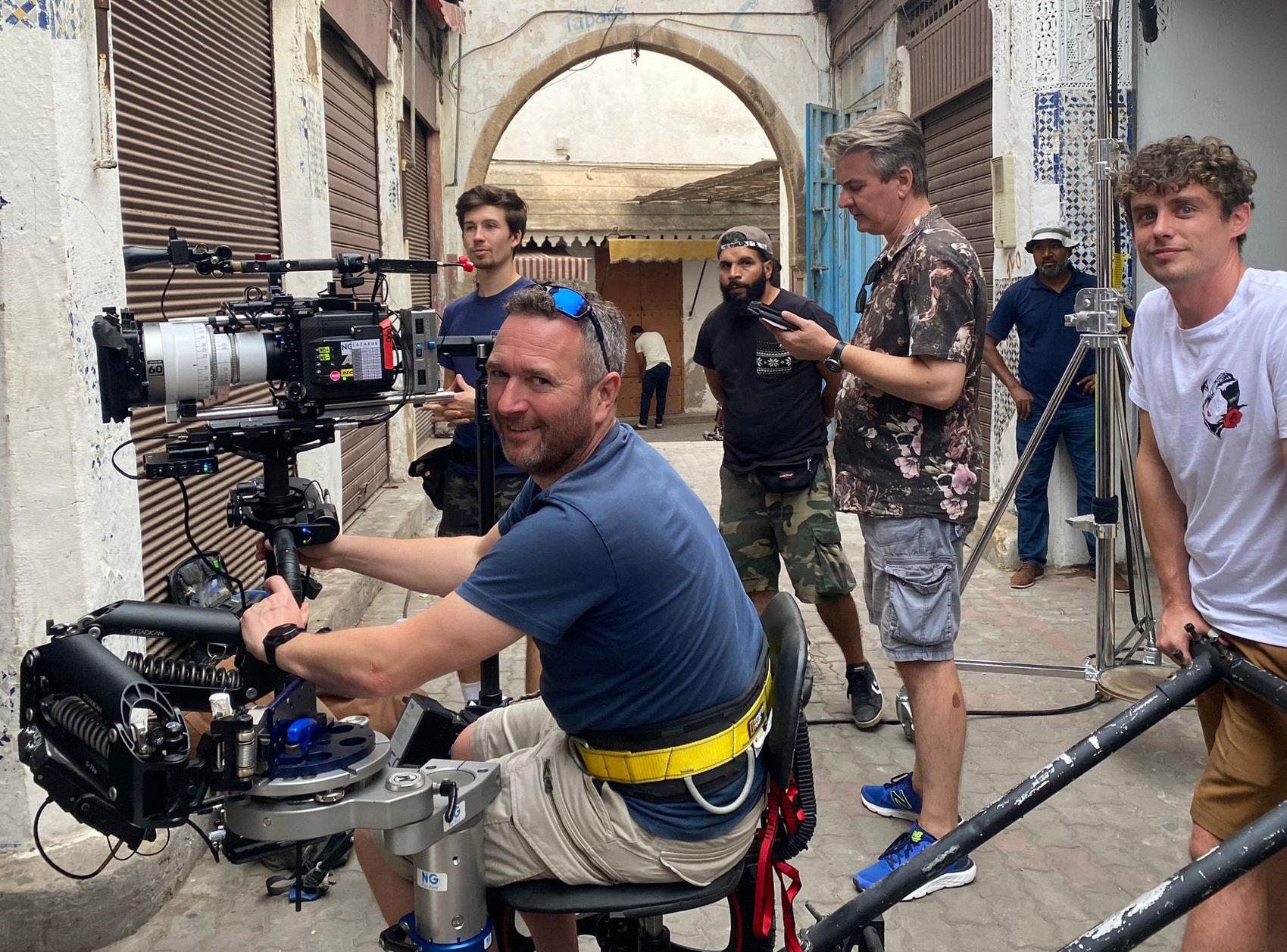






Michael Filocamo has wrapped on Screw S2 for C4. Gavin Finney BSC recently finished filming My Lady Jane in London. Jean Philippe Gossart AFC is filming on Lord Of The Rings: The Rings Of Power S2 for Amazon. David Luther just wrapped on Alex Rider S3 in Malta for Amazon. Dale Elena McCready BSC NZCS is shooting Belgravia for ITV. Alessandra Scherillo has been shooting commercials.
recently winning the Operators Award (Film), and being nominated for an SOC Camera Operator Award, for his work on All Quiet On The Western Front Ed Clark ACO is operating on Curveball, directed by Philip Martin, based on the book ‘Scoops’, and was nominated for the Operators Award for his work on SAS Rogue Heroes George Amos is in Turkey on Ministry Of Ungentlemanly Warfare, helmed by Guy Ritchie. Ilana Garrard ACO was in Italy on Netflix’s The Decameron, lit by Michael McDonough BSC ASC and directed by Mike Uppendahl. James Frater ACO has started on The Gorge, starring Anya Taylor-Joy and Miles Teller. James Leigh ACO has wrapped on The Lazarus Project S2. Julian Morson ACO operated dailies on Wicked Rick Woollard ACO worked on ads for Louis Vuitton in Paris, where production shut down the Champs Elysees and shot on top of the Eiffel Tower. Tanya Marar ACO was nominated for the Operators Award for her work on House Of The Dragon Tom Walden ACO is in Slovakia on Sky’s eight-part drama The Tattooist Of Auschwitz Vince McGahon ACO continues on Apple TV/See Saw Films’ Slow Horses, and won the Operators Award (TV) for his work on the last series. Will Lyte ACO has wrapped on Boat Story for Two Brothers Pictures, and started on Horseface Zoe Goodwin-Stuart ACO continues on The Acolyte for LucasFilms.
22 MARCH 2023 CINEMATOGRAPHY WORLD
& WH ERE
WHO, WHAT, WHEN
This page: (clockwise from top) Alexander Witt in Mexico, filming La Jolla (The Border) for FX/Disney; Lee Thomas and crew; Nikita Khatsarevich on-set for Papaya films; Ouissem Belgacem on a documentary, with 1st AC Adrian Freyermuth (l), DP Vincent Warin and director Renaud Bertand (r); James Leigh and two different dollies; Ed Clark in a dust cloud; and Craig Dean Devine shooting School Spirits for Paramount.
WHO, WHAT, WHEN & WHERE

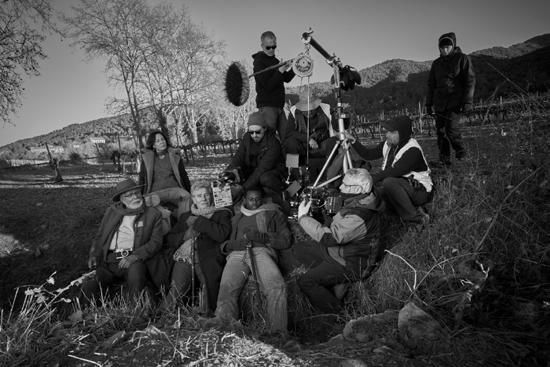


BIGGER IT JUST GOT
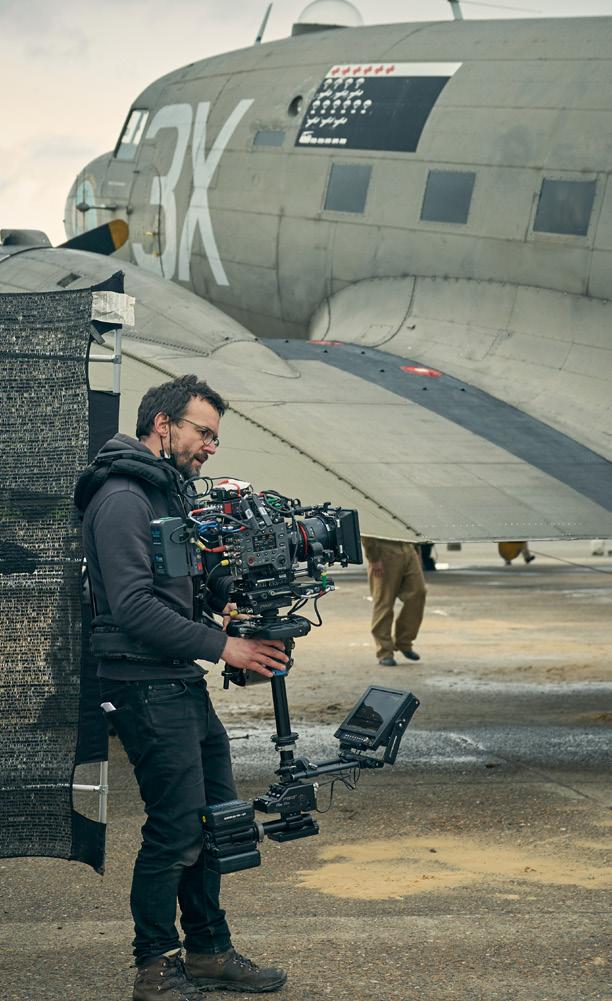
JOINING THE FAMILY: THE FAT-RABBIT AND DOUBLE HEX SNAPBAG FOR BIG LED PANEL FIXTURES




 This page: (clockwise from top) – Ed Clark; David Luther on Alex Rider; Ed Clark with the Steadicam.
Peter Zeitlinger ASC has been working with director Marc Recha on Centaurs Of The Night, filming in the ancient Cistercian monestary of Poblet in Catalonia, shooting 4:3 format
Photography by Lucia Faraig
Photograph by Sergi Miranda
One frame fits your large LED panel lighting fixture: ARRI Skypanel 360
This page: (clockwise from top) – Ed Clark; David Luther on Alex Rider; Ed Clark with the Steadicam.
Peter Zeitlinger ASC has been working with director Marc Recha on Centaurs Of The Night, filming in the ancient Cistercian monestary of Poblet in Catalonia, shooting 4:3 format
Photography by Lucia Faraig
Photograph by Sergi Miranda
One frame fits your large LED panel lighting fixture: ARRI Skypanel 360
ECL
DMG Lumiere Maxi Mix Double & Triple Litepanels Gemini 2x1 Quad array
TWCXL Panel
CINEMATOGRAPHY WORLD MARCH 2023 23
GO PLAY YOUR VIDEO GAMES
By Natasha Block Hicks
As a youth, Ari Robbins SOC (a.k.a. Steadijew) was unaware that the hours he spent glued to his Nintendo might be preparing him for a career as a top Hollywood camera operator.
“The controls are different,” he elaborates, “but there’s that similar sense of where you’re looking and where you’re going with video games.”
Robbins first considered a career in filmmaking as a teenager, thanks to his older brother, DP Eric Robbins, who was already making inroads into the industry. At 18, he took a place at the Community College in Los Angeles to boost his exposure to the right crowd, but before long found himself too busy with crew internship roles to continue with his studies.
Initially, however, the camera department was not in Robbin’s sights.
“I’m highly disorganised!” he laughs, “I did two days as an intern 2nd AC and was advised not to work in camera. I had to learn that attention to detail later.”
The term ‘Steadicam’ was occasionally bandied about in the circles Robbins was networking, and his first encounter on a short film with a live operator, Nick Franco, proved to be a revelation.

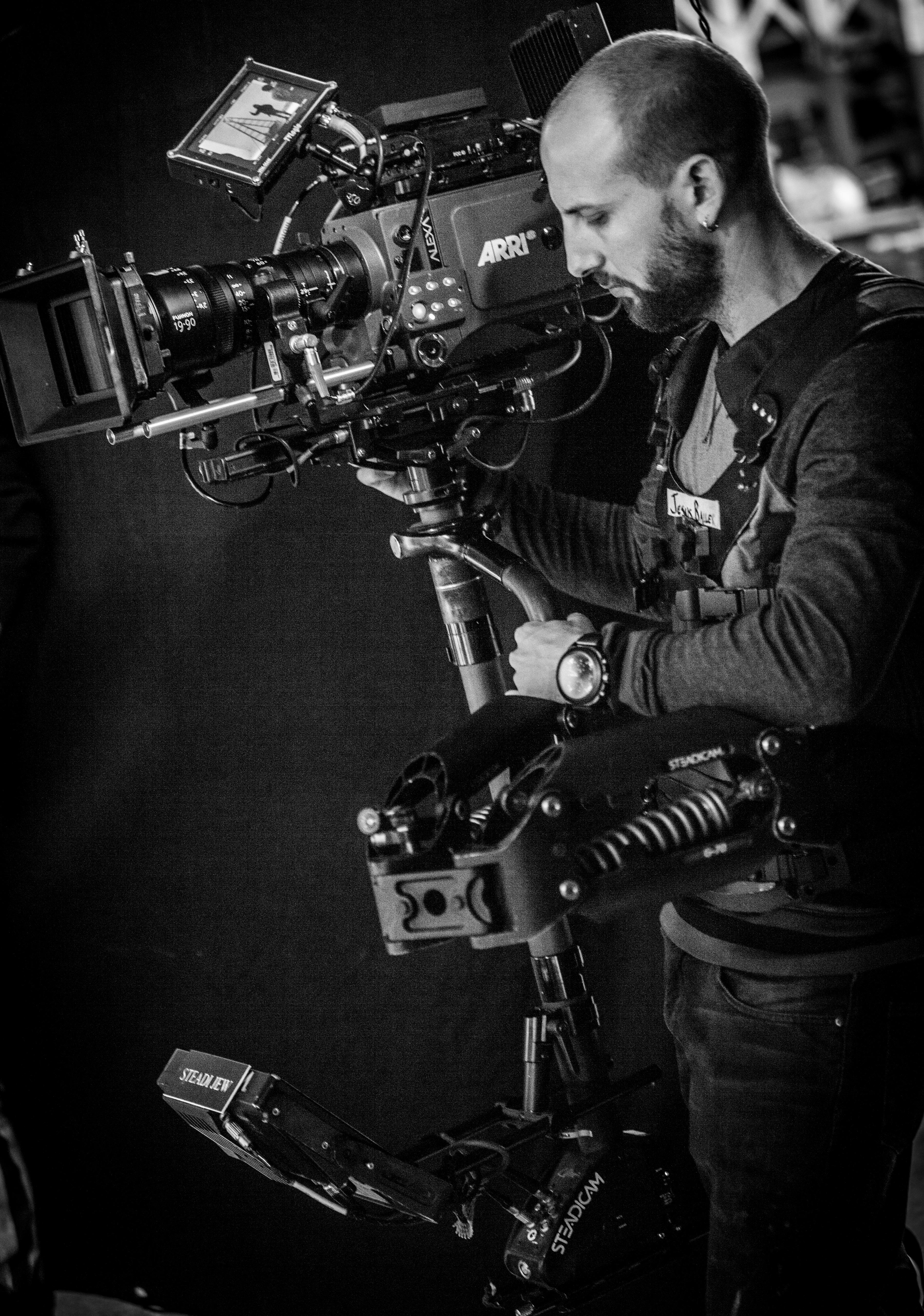
“It took me half-a-second to realise that this was what I wanted to do,” recalls Robbins. “He let me try it on and that was it, I was absolutely decided that was what I wanted to do.”
Robbins attended a Steadicam Operators
Association workshop, then hunted down the best kit he could afford, a Steadicam Model III, initially launched in 1983.
“I got it on to set for the first time on my 21st birthday,” remembers Robbins. “It took me the entire day to figure out how to put the pieces together, but it was incredibly exciting.”
Learning on the job, with his relatively primitive rig that he had to counter-balance using coke cans
III to balance for heavier cameras, another operator selling-off a vital bracket charged Robbins three times the second-hand value, simply because he was young and it was the only one available in LA.
“I’m happy to tell that story because it is part of my history and it’s part of that truth,” states Robbins. “As operators, one of the greatest things we have now is this wonderful community where that sort of thing doesn’t happen anymore.”
A chunk of Robbin’s early experience was forged on music videos, and this is where he first got the sense that his perseverance might be paying-off.
“There was this moment where I realised I was booked for three days one week and two days the next, and I thought, ‘maybe this will work’,” he relates.
While shooting on a short film, Robbins happened to meet DP Larry Reibman, and a few months later, bumped into Reibman again at Warner Brothers, where the production of Pretty Little Liars (2010-2017) was underway.
“I said, ‘Hey Larry, what are you doing here?’,” relates Robbins, “and he replied, ‘Well, I shoot this whole show!.”
and wrenches, Robbins describes his early career as a time when “competition and arrogance in the industry were more free-ranging than support and consideration.”
For example, when trying to upgrade the Model
Reibman, who went on to shoot 100 episodes of that series, invited Robbins to take some days on the production. This was Robbins’ first real taste of shooting on network television, and he worked on two episodes in 2014.
“Driving to the Warner Brothers backlot every day felt so real,” relates Robbins. “They call it ‘The
SMOOTH OPERATOR•ARI ROBBINS SOC
24 MARCH 2023 CINEMATOGRAPHY WORLD
Camera operating… it’s a natural, rhythmic part of life
Photography for this page kindly provided by Stefania Rosini
Jungle’. There’s a gentleman working there who helped plant it 60 years ago. I had a sense of being part of a family much older than me, and that really stuck with me.”
During his time on Pretty Little Liars, Robbins met camera operator Brian Bernstein SOC, who became an unofficial mentor to the rookie.
“Brian showed me the tricks-of-the-trade and educated me about on-set etiquette and studio form,” says Robbins. “My career would never be where it is now without his instruction.”
Robbins continued to work on short form productions, including music videos and commercials, often operating for directors such as Vincent Haycock on multiple projects. And it was Haycock who first united Robbins with DP Linus Sandgren FSF ASC, who in 2015 was seeking an operator for the feature musical La La Land (2016, dir. Damien Chazelle).
At that point, Robbins had limited movieoperating experience, citing studio-shot horror Mother’s Day (2010, dir. Darren Lynn Bousman, DP Joseph White) as his only previous feature of scale. However, he suspects that it was the combined effect of Sandgren’s lighting and grip crew and La La Land ’s choreographers all suggesting Sandgren tried ‘the music video guy’ that persuaded the Swedish DP to give Robbins a shot.
Other crew members were initially reserved but supportive.
“I was this young guy that no-one knew,” remembers Robbins, “everyone was a bit nervous that first rehearsal day. We ran the scene 25 times and I don’t think I missed a single mark. I could almost hear the collective sigh of relief.”
La La Land shifted Robbin’s internal view of his role as an operator.
“When you’re playing with someone’s dream project,” he explains, “you sense the gravity of your responsibility and how much you’re willing to give to make sure it goes well.”
Robbin’s dedication and skill on La La Land was recognised by his peers with the SOC’s 2017 Camera Operator Of The Year Award.
“It was a dream come true,” beams Robbins. “If someone had said I had to retire the next day, I
would have happily done so.”
Thankfully, no-one forced retirement on Robbins, and on one of his next features, White Boy Rick (2018, dir. Yann Demange, DP Tat Radcliffe BSC) he met his production supervisor and wife-to-be.
“She always tells me that I should have chosen A Star Is Born (2018),” jokes Robbins, referring to the Lady Gaga vehicle he was also offered, “but I chose White Boy Rick because the script was amazing. I’m glad I did.”
In recent years, short form credits have become a rarity on Robbins’ CV, with feature films such as Da 5 Bloods (2020, dir. Spike Lee, DP Newton Thomas
oners, it is one of the more subtle scenes of which Robbins is most proud: a four-minute dolly shot circling through and around two characters in conversation on a sofa. This shot saw Robbins on an O’Connor manual head and dolly grip Joe Belschner on the dolly and jib arm.
“Joe and I had to be perfectly engaged together, moving seamlessly with the actors as they were speaking,” details Robbins. “It sounds simple, but it was not. Joe had about 50 marks and I was slinking around the couch panning and tilting. At one point I had to slide down the wall. That intimacy was down to a razor’s edge.
“I can imagine this sort of thing is like when pack animals hunt together, in the way they just silently read each other,” he continues. “An audience watching the scene probably won’t even realise any of that even occurred.”
Now married, and mindful that even the fittest Steadicam operator won’t fly the rig forever, Robbins is laying the foundations for a secure future with hopefully a little more of that rare commodity called ‘free time’.

Sigel ASC), Everything, Everywhere All At Once (2022, dirs. Daniel Kwan & Daniel Scheinert, DP Larkin Seiple) and White Noise (2022, dir. Noah Baumbach, DP Lol Crawley BSC) keeping him busy.
“It feels like every part of the job is a highlight now,” Robbins enthuses.
A particularly “wild ride” Robbins enjoyed midpandemic was working on Bardo, False Chronicle Of A Handful of Truths/Bardo, Falsa Crónica De Unas Cuantas Verdades (2022, dir. Alejandro G. Iñárritu, DP Darius Khondji AFC ASC).
“To be challenged as an operator is the most enjoyable thing,” muses Robbins, “and there was nothing simple or straightforward about Bardo.”
Although Bardo abounds with plenty of impressive and complicated sweeping Steadicam
Robbins has founded a bespoke lens and camera rental house with his brother Eric, called Visual Harassment, offering a wide range of equipment from the latest cameras, such as the ARRI Alexa 35, Sony Venice II and a variety of film cameras, to a rare selection of custom and one-of-a-kind vintage lenses, many of which the duo have rehoused for modern systems. Robbins has also been involved with testing the ARRI Trinity, now Trinity II.
“It’s very neat getting to play with the new tools coming out,” he muses. “I’d like to see that as a future prospect: working with manufacturers to design new things for the challenges of tomorrow’s filmmakers.”
Although still excited about aspects of the gaming world such as VR, and its convergence with filmmaking, Robbins no longer choses the gaming console as a way of winding down
“I live it every day,” he reasons, “and although some shoots can be really intense, I feel that when you love your job as much as I do, there’s actually nothing to wind down from. Camera operating, it’s just a natural, rhythmic part of life.”
CINEMATOGRAPHY WORLD MARCH 2023 25 ARI ROBBINS SOC•SMOOTH OPERATOR
This page: Ari Robbins SOC operating on Everything Everywhere All At Once, photo by Allyson Riggs. Opposite: Operating on Vintage Trouble’s music video Gracefully.
When you’re playing with someone’s dream project, you sense the gravity of your responsibility
TIME-TWISTER
By Ron Prince
It’s England, 1938, and sisters Thom (Emma Appleton) and Mars (Stefanie Martini) have built a device, called LOLA, that can intercept radio and TV broadcasts from the future, revealing glimpses of things-to-come on a circular screen. Using this clever, clairvoyant contraption they are exposed to iconic musicians before they have been born, become obsessed with Stanley Kubrick movies, and learn about female empowerment. Mars documents their personal experiences on film using a 16mm sound-sync camera they’ve been able to make by having the ability see into tomorrow’s world.

When they learn about the escalation of war in Europe, and the blitzkrieg bombardments of London, the sisters feel compelled to use their apparatus as a weapon of military intelligence to issue warnings and help save lives.
However, the past, present and future become more and more entangled. Thom is increasingly intoxicated by LOLA, and Mars begins to realise the terrible

LOLA•OONA MENGES
Described as a ‘hidden gem’, Irish director Andrew Legge’s movie debut, LOLA, seamlessly intercuts real World War II newsreels with fictional filmed material – shot with judgement, knowledge and prowess on Kodak 16mm/35mm B&W/colour film by DP Oona Menges – to deliver an authentic, found-footage, documentary-style, sci-fi story like no other.
The love that went into this film, and the final result, say so much about what we need to hear right now
26 MARCH 2023 CINEMATOGRAPHY WORLD
consequences of its power. As their relationship falls apart, Thom makes an error that leads to a catastrophic outcome. Can the sisters’ love for one another save the world they stand to lose?
The 79-minute, €1.5m Euros, Irish/Welsh co-production, was written by Legge and Angeli Mcfarlane, from a story by Legge and Henrietta and Jessica Ashworth. Replete with tell-tale scratches and sparkles of film that has been locked-away for decades, LOLA elegantly balances the sister’s experiences against dark and foreboding images of WW2.
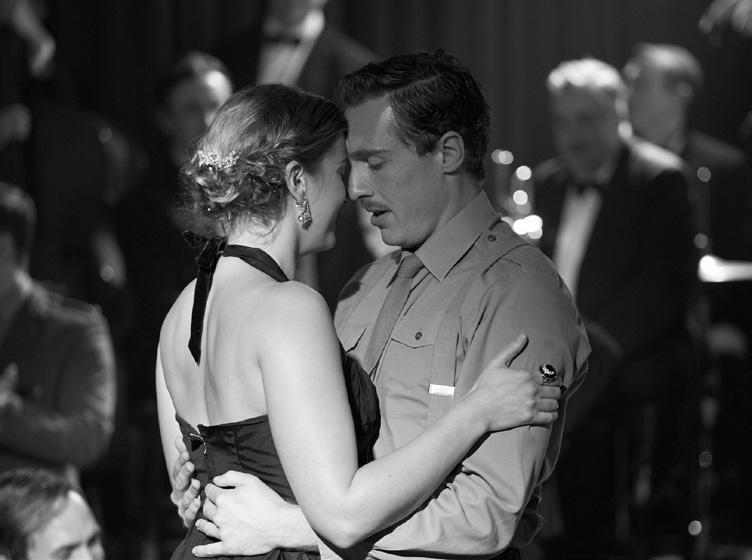

The film also features a notable soundtrack and songs, written by Neil Hannon of The Divine Comedy, including a rearranged version of ‘You Really Got Me’ by the Kinks, music by Elgar and footage of David Bowie performing ‘Space Oddity’.

“I loved the premise of the story, especially at a time when extremism abounds and people are frequently at each other’s throats, whilst we should be trying to get along and save the planet.” says Menges. “I was really struck by Andrew’s empathy for
the feminine, and his understanding about the genuine sororal affection between the sisters too.
“But I was also drawn to this film by the challenge of shooting Mars’ personal documentary footage, and the task of matching that live-action material with real newsreel/archive footage. Andrew did not want to do any digital manipulation to achieve this result. It all had to be done in-camera, using filmmaking instruments as close as possible to that time, which I thought was brilliant and exciting.”
Menges’ references included a lookbook made by Legge, encompassing photographic stills as well as extensive newsreel footage of London during WW2, plus archive footage from The Third Reich. Legge’s tome also comprised films such as the French sci-fi classic La Jetée (1962, dir. Chris Marker, DP Jean Chiabaut) and the alternative-history movie It Happened Here: The Story of Hitler’s England (1966. dir. Kevin Brownlow/ Andrew Mollo, DPs Kevin Brownlow/Peter Suschitsky). A further reference was Legge’s own multi-award-winning short, The Chronoscope (2010, DP Eleanor Bowman),
in which the protagonist builds a machine that can look into the past.
“During our early conversations I discovered Andrew has a great love for the chemistry and magic of celluloid film, and was even going to develop some of the film himself at home in an old Soviet-era developing tank,” says Menges, whose credits include The Host (2020), Lovely Little Farm (2022) and Ruby Speaking (2020).
“However, one of the first things he said to me was, ‘If you don’t go for it, this isn’t going to work.’ By which he meant it had to feel real, as visually-authentic as possible. If we were filming scenes that felt too expository, or looked too much like a drama, he would shut them down. So, when considering my approach to the cinematography, I had to fully-embrace the idea of seeing things through Mars’ eyes, or a newsreel cameraman, and find different ways to mess with the picture in-camera to make the results look plausible.”
With this intriguing brief, Menges’ sought-out an appropriate camera and lens package, her automatic

OONA MENGES•LOLA
CINEMATOGRAPHY WORLD MARCH 2023 27
Images courtesy of Signature Entertainment.
choice being a call to the legendary Joe Dunton MBE and his son Lester.
“Over many decades in the industry, Joe and Lester have accumulated a lot of old film cameras and vintage lenses, and know exactly how they work,” she remarks. “It was fun and illuminating to discuss with them the looks I needed to achieve and the tools to help get me there.”
After a good deal of deliberation and testing, Menges chose an ARRIFLEX 416 16mm syncsound camera, a three-turrett ARRIFLEX 16ST, plus Legge’s own spring-wound Bolex 16mm, to shoot Mars’ live-action documentary footage. Simulations of newsreel and other archive material would be captured on 35mm film, using a combination of ARRIFLEX 35BL 4 and ARRICAM LT 35mm cameras, plus a clockwork Newman Sinclair as used by Stanley Kubrick.
The array of vintage lenses included Zeiss Super Speeds, Bausch & Lomb Super Baltars, Cooke Panchros, Angénieux and Kern Switar optics, as well as the prime lenses that came with Legge’s vintage Bolex camera.
“Amongst this amazing collection, we had cameras and lenses that no-one has used for 50 years. Some were a little temperamental and needed constant attention, nurturing and careful handling throughout the shoot,” says Menges. “But, they were all authentic, which was really important to Andrew.”
“Additionally, some of the gates in those old cameras added marks and scratches to the film, which was just what we wanted.
“When shooting B&W, I sometimes put a basic red gel as a filter over the lens, to differentiate tonality, to make a blue sky look more threatening, or the interiors appear more textured and dramatic. I also used black stockings to diffuse the image and make highlights bloom, and encouraged flaring down the lens to blow-out highlights. I even flashed or fogged the negative as we shot by opening the door on the camera.”
After a month of test and prep, production on LOLA got underway for six weeks during September and October 2022. The chief location was an uninhabited country house –retaining original period features such as scones and wallpaper – and its surrounding estate, in Killadoon, a 30-minute drive from Dublin, Eire.
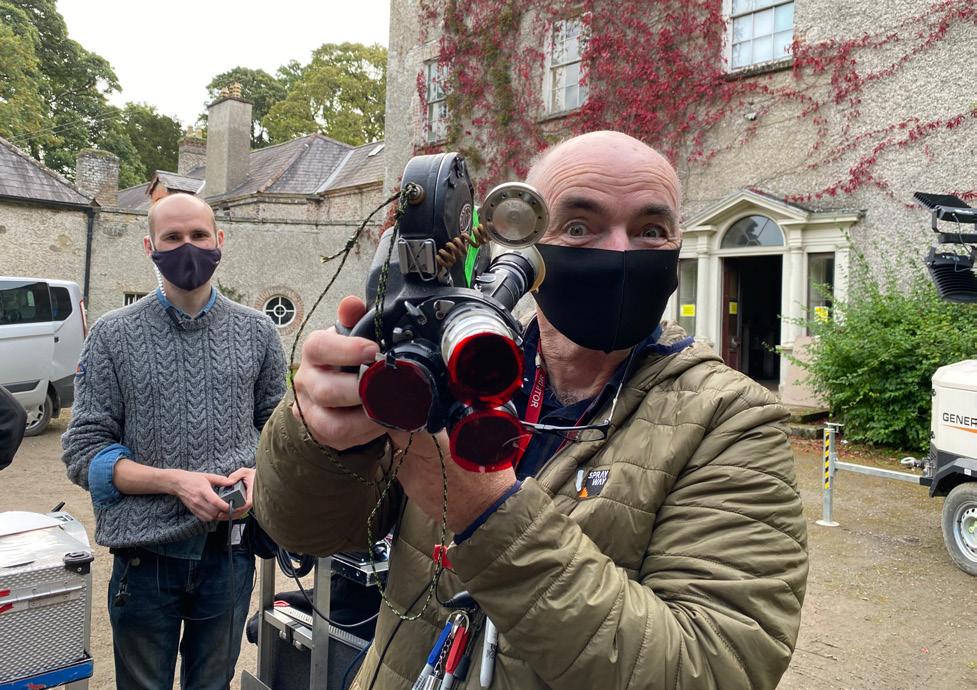


During production Menges resided at Legge’s home in Dublin, where the director developed some of the B&W 16mm footage himself in his basement darkroom, and where Menges had a large LED screen installed to review and compare footage that had been shot against newsreel and archive footage that Legge wished to incorporate into the final film.
“Although the vast majority of the filmed footage was developed at Cinelab, Andrew wanted to distress some of the Bolex footage, and processed several 100ft-rolls of the 16mmm DOUBLE-X himself,” says Menges. “This involved developing at a high temperature, which caused the emulsion to break and created reticulation –a mosaic of grain – that looked quite beautiful. To add other artefacts to the images, the bath in developing tank itself had contaminants, which Andrew referred to as ‘sludge’.”

After testing different filmstocks and screening the results for Legge to make a final decision about which to use, Menges captured the mainstay of the production using EASTMAN KODAK DOUBLE-X B&W negative, in 35mm 5222 and 16mm 7222 formats, supplemented with KODAK VISION3 500T 35mm 5219 and 500T 16mm 7219.
‘The DOUBLE-X has lovely grain and pleasing contrast, plus subtleties in tone that I knew would assist in depth-of-field separation in the image for composition purposes,” Menges explains. “I typically rated the DOUBLE-X at 200ISO in Tungsten and 250ISO in daylight. But I also pushed it quite hard to increase the grain and contrast in different interior/exterior lighting situations in order that the results would get us visually-close to look we intended,” she explains.
“I used 500T colour stock as some of the archive material I had to match to contained many shades of grey, and I knew that grayscale would render better when the colour images were drained to B&W later in post production.
Along with exposure, Menges was not afraid to harness a panoply of old-fashioned tricks, as well as some extreme measures, to achieve the desired result.
“We unravelled all of the raw, unexposed filmstock across the floor, trod on it with our shoes, and scratched it with our fingernails as it ran on a rewind bench, before it went into any of the cameras, which was pretty good fun,” she reveals.
Whilst Menges operated handheld for most of the production, she had to school actress Stefanie Martini, playing Mars, on how to operate the camera for a number of scenes involving mirrors, which included carefully-choreographed handovers between the pair. The camera and lighting crew included Connor Hammond working as focus puller, Leo Windsor as loader, and Simon McGee as gaffer.
“Andrew did not want LOLA to look lit, as that would break the concept,” says Menges. “This was quite a task in itself, as I needed certain levels of illumination to bring contrast to the image when shooting on B&W. So I used my own CRLS reflectors to bring light in through windows, and had strings of festoons, antique Lowell lights, plus Tungsten bulbs in practicals.”
As part of co-production agreement, the final colour grade was completed at Gorilla in Cardiff, with colourist Stuart Fyvie. “As the looks has been baked-in on film, very little was needed by way of VFX or image enhancement to blend the footage together,” Menges notes.
“I trained and grew-up as a loader and 1st AC on film productions, and still take B&W stills. So it felt comfortable, like coming home, to shoot on 16mm and 35mm film, and it was so much fun to have all those old film cameras and lenses at my disposal,” Menges concludes.
“There was no way you could have made this film as authentic as it needed to be by shooting digitally. There’s a special magic to working with film, the tricks and techniques you can employ incamera and in the processing, to create something unique and distinctive. The love that went into in this film – from the script and the way it was made –was extraordinary, and the final result say so much about what we need to hear right now.”
28 MARCH 2023 CINEMATOGRAPHY WORLD LOLA•OONA
MENGES
We unravelled all of the raw, unexposed filmstock across the floor, trod on it with our shoes and scratched it with our fingernails
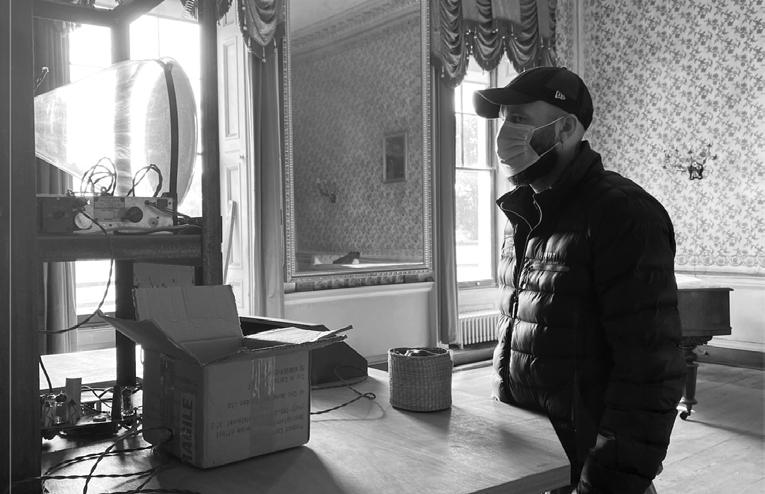


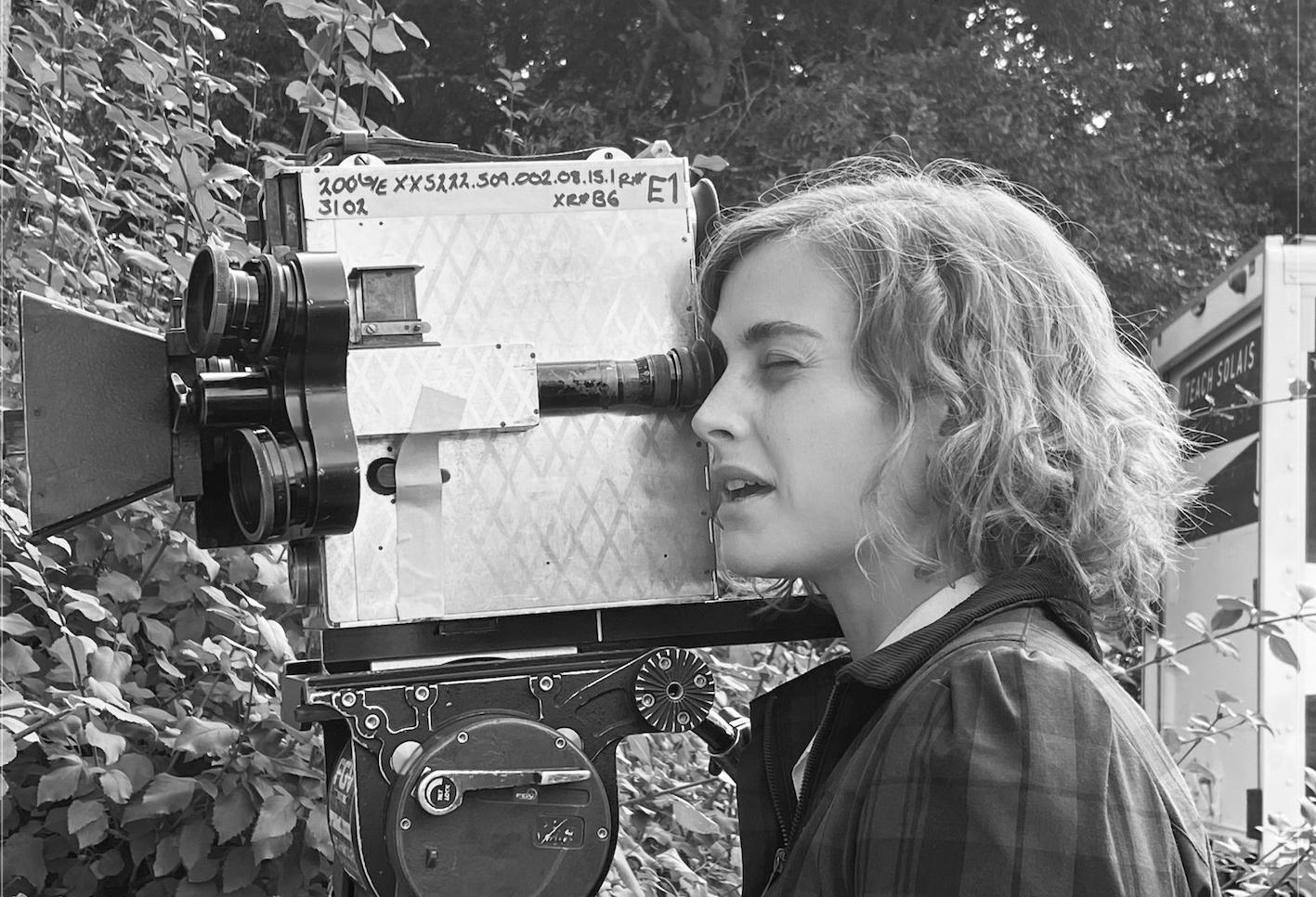


OONA MENGES•LOLA CINEMATOGRAPHY WORLD MARCH 2023 29
Opposite: DP Oona Menges operating different cameras, and 1st AC Connor Hammond with the C-camera. Photos courtesy of Oona Menges.
This page: LOLA director, Andrew Legge, photo courtesy of Signature Entertainment; Joe Dunton MBE BSC prepping the Newman Sinclair; and actress Stepfanie Martini at the the camera. BTS photos courtesy of Oona Menges.
CRETACEOUS CAPER
By Darek Kuźma
Writers/directors Scott Beck and Bryan Woods’ high-concept, sci-fi spectacle, 65, benefitted from DP Salvatore Totino AIC ASC’s love of adventure and penchant for out-of-the-box solutions.

65 is a thought-provoking, survival thriller about two characters stranded on an unhospitable alien planet – Cretaceous Earth – when a spaceship carrying cryosleeping passengers crash-lands. Ruled by dinosaurs and other nasty creatures, and with no Homo sapiens nor even Australopithecus in sight, pilot Mills (Adam Driver) and a young girl named Koa (Ariana Greenblatt), both speaking different languages, embark on a risky trek through swamps, forests and mountains, to find an escape shuttle that will take them home.

Totino is a DP who is accustomed to working in difficult conditions. He shot in sub-zero temperatures in The Himalayas and The Dolomites to make Baltasar Kormákur’s immersive Everest (2015), and was elated to hear the directors of 65 were adamant about shooting much of the movie on-location.
“Along with the obvious challenges that I like, what also excited me about this project was that the script had a really personal touch, it felt like it came from within. Scott and Bryan wrote it six years ago and you could tell that it lived inside them,” says Totino. “They’ve been friends since sixth grade, making films with a little camcorder. They directed small horror films, and wrote A Quiet Place (2018, DP Charlotte Bruus Christensen DFF ASC). This was to be their breakout, and I wanted to be a part of it.”
Part of the challenge was to keep-up with the directors’ vivid imagination. “They drew 900 storyboards and were adamant about certain shots. There’s a scene where Mills and Koa sleep in the mouth of a cave and wake-up hearing something sinister. Scott and Bryan imagined a 270-degree dolly shot with the camera moving around. But, as we shot during the on-set of the Covid pandemic, rental houses weren’t accessible to provide the necessary equipment.
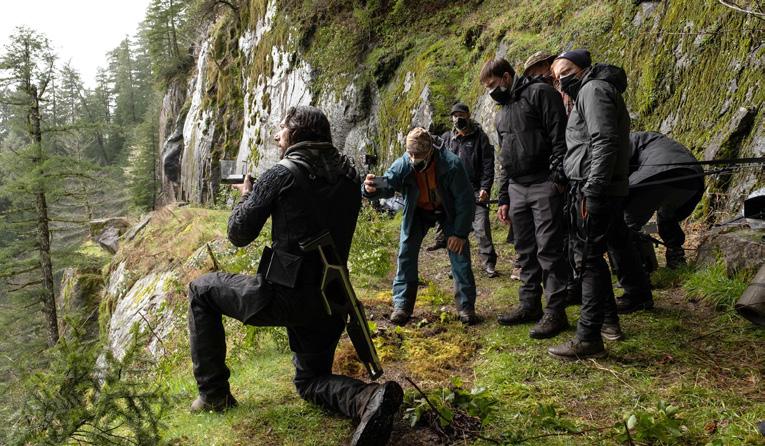
“So, we ended-up building a small dolly ourselves with a Cinemoves Talon head and a wireless remote drive. The dolly plate was 12x12 inches and went on 13ft. diameter circular track. It turned out that part of the set, which was built out of Styrofoam, was a bit too small for this rig. Fortunately, the sculptor and the art department were gracious enough to make it bigger for the track.”
Totino first talked to Beck and Woods about the project in August 2020 and flew into New Orleans by mid-September for eight weeks of prep. The principal photography started on November 23rd and continued until February 21st 2022, and included a stint in Louisiana’s Kisatchie National Forest, before wrapping

in Oregon. The interior of the spaceship was built at New Orleans’ Second Line Stages.
“It was strange being in New Orleans at the time, as the city was dead quiet. Then the fun began. When we started shooting in the nearby Louisiana swamps, a specialist team came in to make sure there were no alligators in the area, and erected fencing around where we were going to shoot. We had a snake wrangler onset, and at nights had to use flashlights on the floor so as not to step on anything that might bite. Shooting in such crazy environments can be tough, but it really enhances the experience,” he laughs.
experience of being on Earth, 65 million years ago, for the first time,” Totino explains. “I decided to embrace Anamorphic in 2.35:1, because I thought it would be great to shoot as wide-open as possible to get a bit of banding on the top and the bottom of the frame, a sort of out-of-focusness that makes the world feel like a scary, foreign place.”
“It was my first time using the Sony Venice, but I’d seen Claudio Miranda ASC’s original camera tests and did a bunch of my own. I liked the dual ISO factor, and shooting at ISO 2500 allowed me a bit more freedom in the locations, and went some way to countering the speed of the V-Lites. All are T2.2 except for the 110mm and 140mm which are T3.5.”
Totino adds, “I shot with two cameras to give more coverage and detail for the editor to play with after, and didn’t operate much myself during this production. I used to operate more when I shot on film, but with digital you have to deal with so many different aspects, that I felt it was better to sit by the monitors, like a conductor, communicating with everyone through headsets.”
There are a lot of VFX in 65, especially when grand carnivores, like T-Rex, roam across the screen, yet the film feels tangible due to the careful location scout.
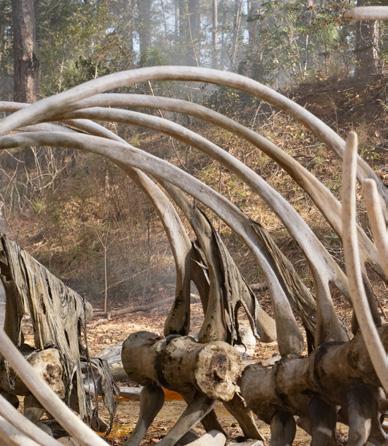
Totino shot 65 at 6K using Sony Venice equipped with a set of Hawk V-Lite Anamorphic lenses. Additionally, he shot some VFX and flashback scenes using the Sony Venice Rialto head and spherical Cooke S4 lenses.
“As Mills and Loa don’t understand each other, there wasn’t a lot of dialogue to cover. I wanted to keep a sense of fear and tension, and give the viewers the
“In the forest, it’s really dark, quiet, you don’t know what’s around the corner. We wanted to keep moving the camera with Mills and Koa to enhance the tension. I had dollies, Steadicam, Technocrane, whatever was needed,” he reveals. “One of the shots Scott and Bryan wanted included a 300-foot tracking shot through the forest, where Mills and Koa come into frame and the camera begins to track their moves, doing 180 and

30 MARCH 2023 CINEMATOGRAPHY WORLD 65•SALVATORE TOTINO AIC ASC
Along with the challenges that I like, the script had a really personal touch… it felt like it came from within
360-degree pans to depict them looking nervously around. The forest floor was too uneven for Steadicam, so we tested Defy Products’ lightweight Dactylcam cable-cam system, and that proved a lifesaver.”


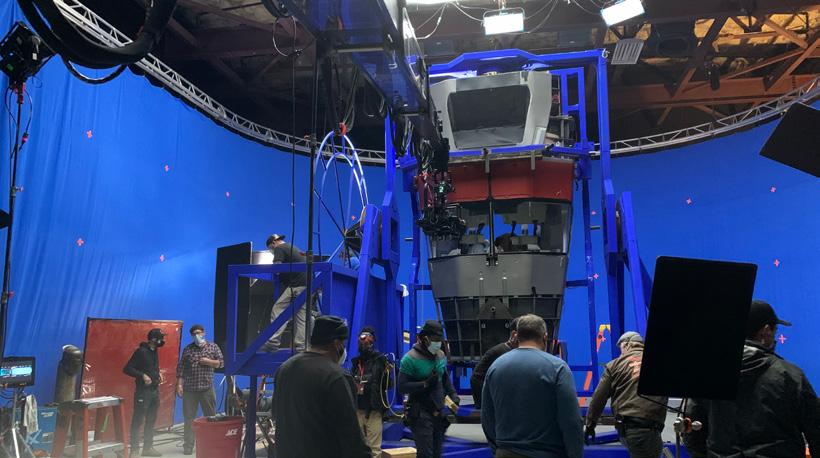

Needless to say, 65’s spaceship interior scenes required some studio work, and Totino was keen to bring something different to the look, working with gaffer Andy Ryan.
“The lighting was all LED, and we created pulsing lights from a dimmer board. I went with orange around the ship and blue in the cockpit, to create a contrast to the cool white that most science fiction films use,” he says. “I always try to bring the outside world in with light. So when we’re inside the ship during the day, I introduced a lot of warm light from outside, and used HMIs to have a nice punch and depth to the light. This also gave nice flares through the lenses.”
Lighting the locations and the cave scenes were a different matter. “For the swamp night exteriors, I used a couple of Condors with LED balloons to give it a nice, soft toplight. It was different in the cave. There were small openings where I could shine a toplight down. I also bounced ARRI L5s and L7s into the cave ceiling to illuminate the colour in the set design. Once in a while I’d use an Astera Titan Tube to highlight the actors’ eyes, when we wanted to see them in the frame,” he declares.
A key lighting challenge came with the film’s impressive, grand finale set-piece, when a spectacular meteor shower descends from the sky to illuminate Mills and Koa’s journey.
“I recalled I’d done a commercial a few years ago, where I was filming a horse in the middle of a desert at night, using airborne flares on parachutes to created
the effect of a shadow dance. So, our special effects supervisor got a bunch of flares and constructed a proper mortar to launch them,” marvels Totino. “We did tests in prep and got permission to use them in the forest. During the shoot we mortared around 600 flares across

environments, we made a LUT that I basically used for the entire film. The LUT had this slight, almost inconceivable grain to it that, along with a solid contrast level. It made the images feel a bit more film-like, making our effort to immerse people in Mills and Koa’s experience more effective.”
Unfortunately, Totino was not able to attend reshoots and pick-ups that took place later in California and Ireland, but he is happy with how the film turned out.


“It’s always tricky when others finish your work,” he muses. “You shot it, you had a relationship with the directors, you developed the visual language. But Matt Jensen ASC, Chung-hoon Chung and Flavio Labiano, who covered for me, did a solid job.
“What’s important for me is that I felt I was Scott and Bryan’s close collaborator all the way, as opposed to being just a hired-hand. My family emigrated to America, I was lucky to find a way to make a living, and to express myself through images. After so many years in the business, projects like 65 still give me great pleasure in the job.”
the forest, between 40 to 200 feet in the air, which gave this amazing orange-red shimmer of moving colour, and a really dramatic effect.”
The final colour grade was done with Totino’s longterm collaborator Sean Coleman at Company 3, where the work was mostly focussed on enhancing what was achieved in-camera and combing the visual effects.
“Because I have a very good relationship with Sean, I was able to bring him in early in the process. Based on the tests I’d shot in prep in different lighting

SALVATORE TOTINO AIC ASC•65 Images: Film image copyright 2022 CTMG, Inc. All Rights Reserved. BTS photos courtesy of Salvatore Totino AIC ASC.
CINEMATOGRAPHY WORLD MARCH 2023 31
I embraced Anamorphic in 2.35:1, shooting as wideopen as possible, to get a sort of out-of-focusness that makes the world feel like a scary place
BEYOND REDEMPTION?
By Ron Prince
Capturing the micro-budget indie, To Leslie, in 2-perf on Kodak 35mm filmstock, delivered a textural, grittyedge to the portrait of a character seemingly beyond salvation.
Directed by Michael Morris, from a screenplay by Ryan Binaco, and framed mainly handheld by American cinematographer Larkin Seiple, the movie became a surprise awards contender when Andrea Riseborough was nominated for Best Actress at the 2023 Oscars for her performance as the woebegone lead.
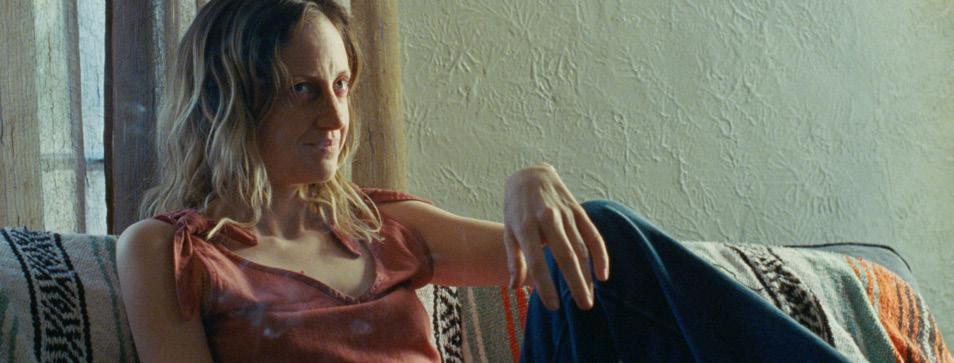
The film follows Leslie, a troubled single mother and manipulative alcoholic, who wins $190,000 on a local lottery in West Texas, only to squander the winnings on drink, smokes and soft drugs. Six years on, she is destitute, living a nomadic life between seedy motels or roughing-it on the streets, her belongings stuffed inside a pink suitcase, and unafraid to turn tricks to pay for her dependency.
A reunion with her estranged 20-year old son, James, does not go according to plan, after she steals money for liquor, and Leslie finds herself back in the town where the locals, former friends, have long-since ostracised her.
Amongst the malevolence shown towards Leslie, there’s a tiny ray of hope in the goodwill and benevolence from Sweeney, a motel manager, and its oddball proprietor Royal. Can Leslie grasp a shot at redemption, or will she succumb to yet another vodka shot at the local neon-lit bar?
“Right from the very beginning, I wanted To Leslie to have the real, authentic texture, grit and grain of celluloid film,” says Morris, who started-out as a theatre director in the UK, before embarking on a successful career in TV, helming prime-time shows such as Better Call Saul To Leslie marked his directorial debut in features.
“As a character, Leslie was of great interest to me, and the storytelling in the film was very much about the subtext and the unspoken, as opposed to episodic TV, where there’s a need for the exposition of plot or character development. I really connected
with Ryan’s script and the opportunity to build a story from the ground-up, to create a movie with an empathetic, rather than a judgemental, point-of-view.” Morris adds, “Many of my original visual references were actually from mid-20th-century street photographers, along with films from the ’70’s and ’80’s, which were all obviously captured on film back in the day. I didn’t purposefully set-out to make an edgy period-style movie, but I knew that the qualities of film would help to convey an appropriate down-and-out atmosphere in the overall aesthetic.”
“I had never worked with Larkin before, but connected with him on the strength of the images he makes,” says Morris. “He is a great artist and craftsperson, and he saw what I saw in the script – an unvarnished human story, a portrait of a woman in crisis. When he came on-board as the cinematographer, we were of one mind that To Leslie had to be shot on film.
“With the full backing of our producers, we tested 35mm and 16mm film, alongside digital cameras, where we experimented with digital grain and film emulations. It was clear from those tests that there was only one choice – 2-perf 35mm film – as it gave the authentic look-and-feel to the storytelling that I originally envisioned, with an epic, widescreen aspect ratio. Digital just didn’t work at all.”
Although the story is based in Texas, production
Photographic inspirations included the beauty of the mundane in street photography by William Eggleston and Helen Levitt. Cinematic references encompassed Wanda (1970, dir. Barbara Loden, DP Nicholas Proferes), about a lonely housewife, who drifts through mining country until she is taken-in by a petty thief, and two films lensed by legendary cinematographer Robby Müller – Paris Texas (1984, dir. Wim Wenders), which focuses on a traumatised drifter attempting to reconnect with his brother and seven-year-old son, plus the psychological drama Breaking The Waves (1996, dir. Lars Von Trier).
on To Leslie took place, over just 19 shooting days, at locations north of Los Angeles, in December 2020 during the Covid-19 pandemic. These included the towns of Lancaster, Agua Dulse and Piru, California.
To Leslie marked Seiple’s second full-length feature on film, having previously shot Luce (2019, dir. Julius Onah) on 35mm in 3-perf Anamorphic, although his other celluloid experiences include a multitude of shorts, commercials and music videos, including the multi-award-winning ‘This Is America’ for Childish Gambino.
“It was a treat to be able to shoot on film again,” says Seiple. “The subject matter of To Leslie was raw, and we wanted to make things look honest, authentic and photographic, to live in Leslie’s skin, which is exactly what film does by default.”
Shouldering the camera himself, Seiple went with an ARRICAM LT 35mm camera, fitted with an HD video assist from IndieCam, capturing the action through Master Prime lenses. The camera package was supplied by Keslow Camera in LA.
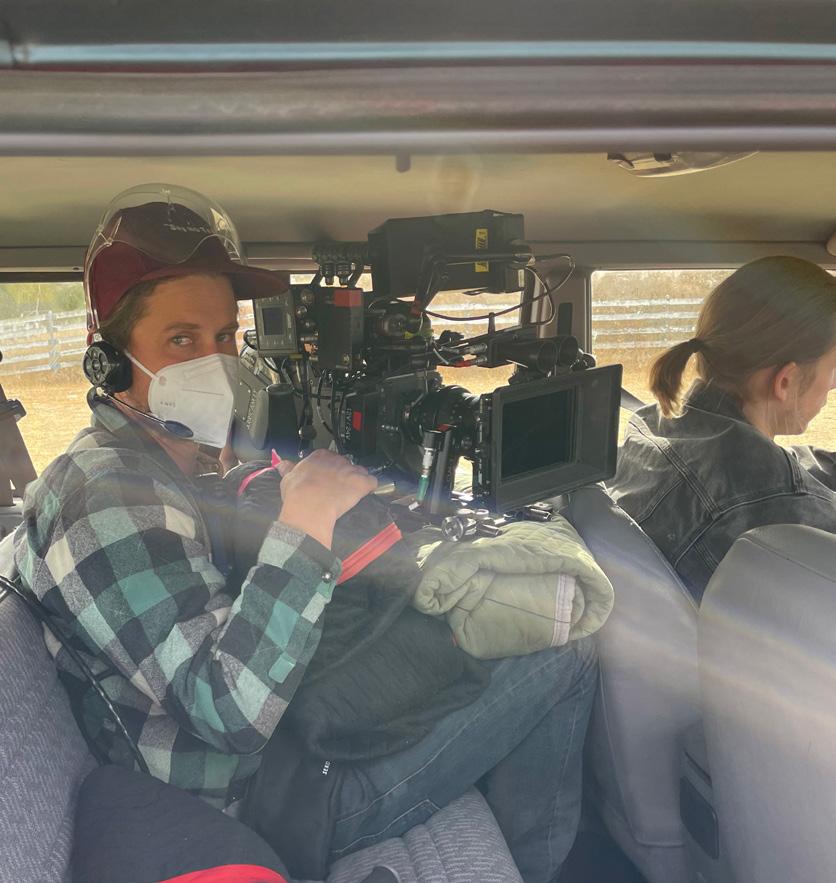
“The Master Primes are lovely, sharp lenses,” notes Seiple. “They look great wide-open and have a documentarian feel to them, which was perfect for this production. Using the IndieAssist, Matt Sanderson, my 1st AC, did a great job keeping focus on Andrea in often difficult and fastmoving situations.”
The DP opted to capture To Leslie entirely on KODAK VISION3 5219 500T filmstock, shooting

32 MARCH 2023 CINEMATOGRAPHY WORLD
TO LESLIE•LARKIN SEIPLE
Shooting on film heightens the experience… and gives you a sense of pride and focus
From the very beginning, I wanted To Leslie to have the authentic texture, grit and grain of celluloid film

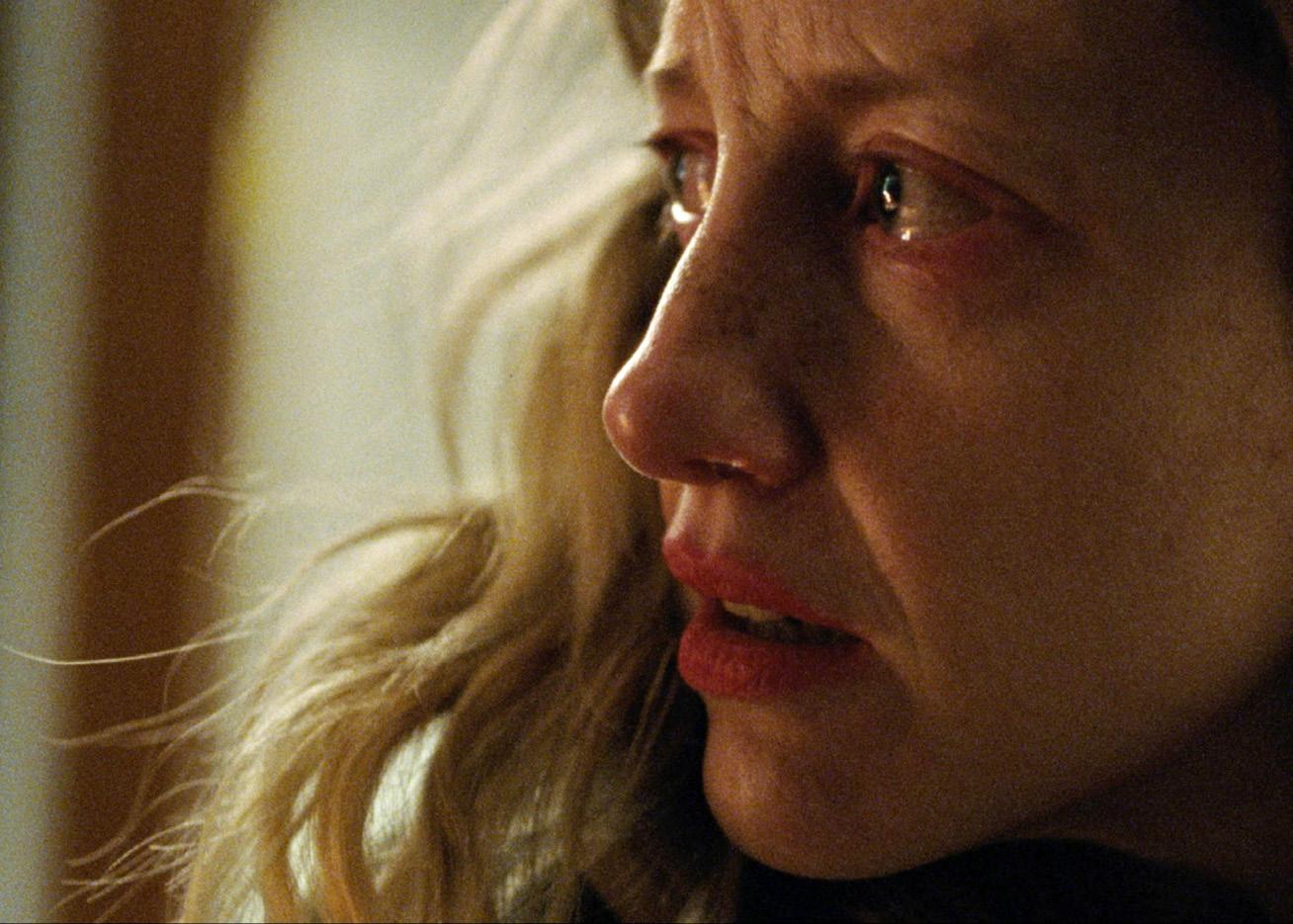



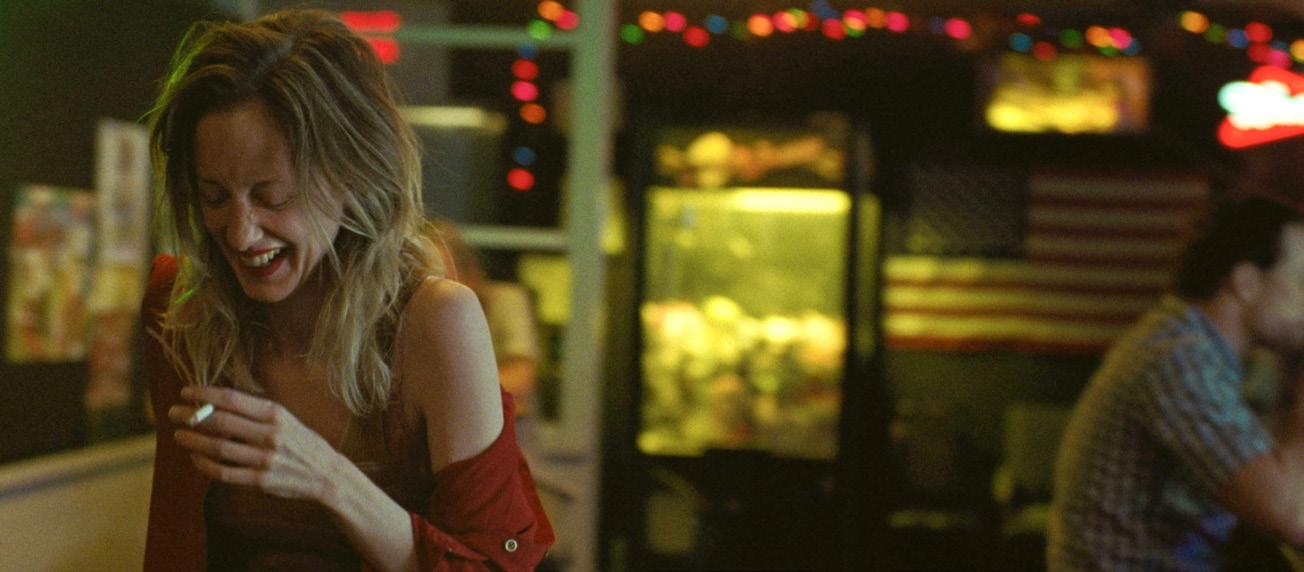


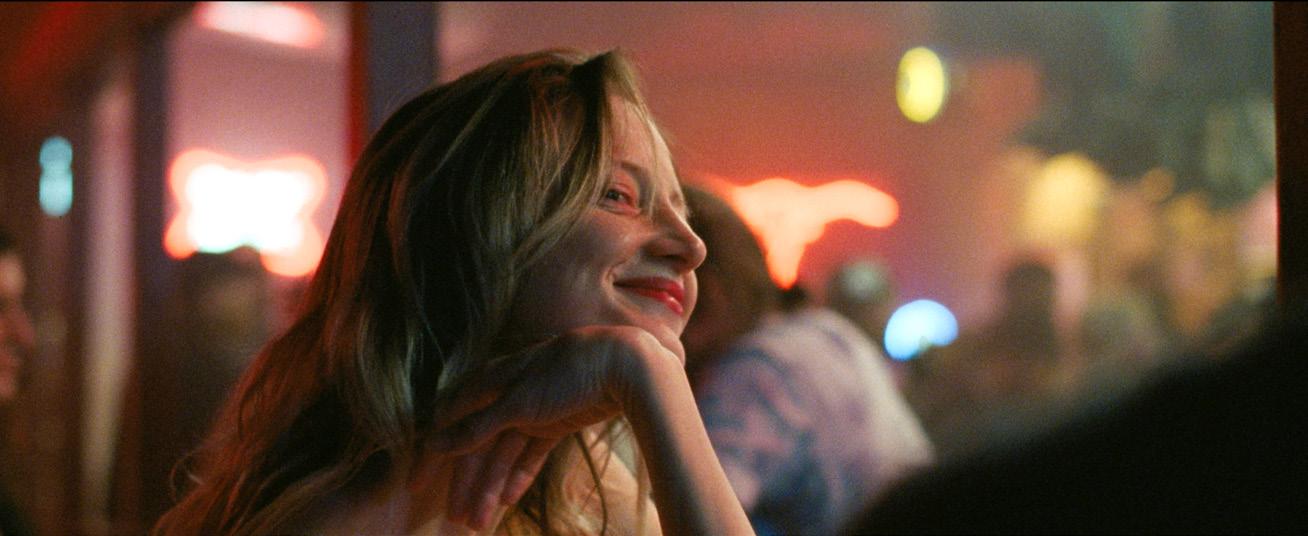



LARKIN SEIPLE•TO LESLIE CINEMATOGRAPHY WORLD MARCH 2023 33
Images: To Leslie, directed by Michael Morris. Images courtesy/copyright Momentum Pictures.
uncorrected. Film processing and 4K scanning of all rushes was done at Fotokem in LA.
“We had a very tight budget, and the team at Kodak in LA were very supportive in helping us to source rolls of unused filmstock from other productions,” explains Seiple. “I went with just one filmstock, the 500T, as I wanted a visual consistency in grain, texture and colour across the entire movie.
“Also, the 500T is surprisingly versatile for shooting the whole gamut of bright day exteriors to low-light and night scenes that we were going to encounter during production. Things like flares, over-exposed highlights, mixed colour temperatures, neon lights and sodium vapour street-lighting, all look so natural on film, but can easily look false, brash or just plain cheesy when you shoot digital.
“But, most importantly, this film was all about staying with our character in close-ups, and medium close-ups, the way celluloid renders skin tones, in all different lighting conditions, just feels natural and realistic.”
Shooting 2-perf 35mm, also known as Techniscope, was first introduced by Technicolor Italia in 1963. Movies such as The Ipcress File (1965, dir. Sidney J Furie, DP Otto Heller BSC) and The Good, The Bad, And The Ugly (1967, dir. Sergio Leone, DP Tonino Delli Colli AIC), along with more modern productions, including Sound Of Metal (2019, dir Darius Marder, DP Daniël Bouquet NSC) and the HBO TV series such as I Know This Much Is True (2020, dir. Derek Cianfrance, DP Jody Lee Lipes), were all originated using the format.
2-perf uses a two film-perforation negative pulldown per frame, instead of the standard fourperforation frame of normally-exposed 35mm film. Along with yielding a widescreen aspect ratio, shooting 2-perf 35mm doubles the running time of the filmstock in the camera magazine, maximising stock and lowering processing costs. Which is just as well as Seiple reports that some scenes in To Leslie, which appeared as just a few lines in the script, often blossomed into lengthy takes to convey the narrative.
Apart from two notable moments in the film, when the camera slowly tracks with or into Leslie, as she contemplates life-changing decisions, To Leslie was shot entirely handheld.
“We wanted the camera to be with Leslie, to witness the fragility of her life, her vulnerability, and react to the freewheeling nature of her actions, observing but not judging. Michael and I both felt that shooting handheld was the best way to portray that,” says Seiple.
“When it came to the shoot, Andrea was alive in every shot, always doing something interesting, sometimes unpredictable. As 2-perf is economically-efficient, we could keep the camera rolling, let her go and shoot longer takes than we might have originally planned for. Although it was quite a job keeping up with her, she is an amazing actress and we didn’t need many takes to get what was needed. We endedup with a shooting ratio of around 4:1.”
Along with Matt Sanderson working as 1st AC, Seiple’s crew included Pat O’Mara as key grip, Jamie Young as dolly grip, with Jake Lyon as gaffer.



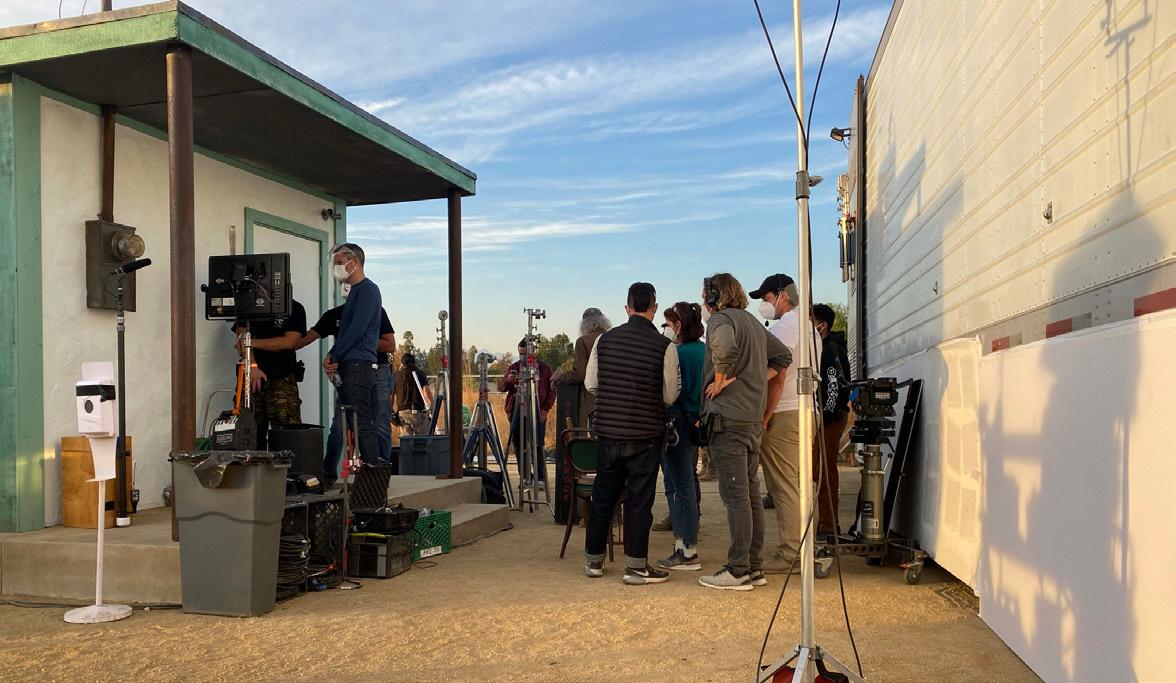

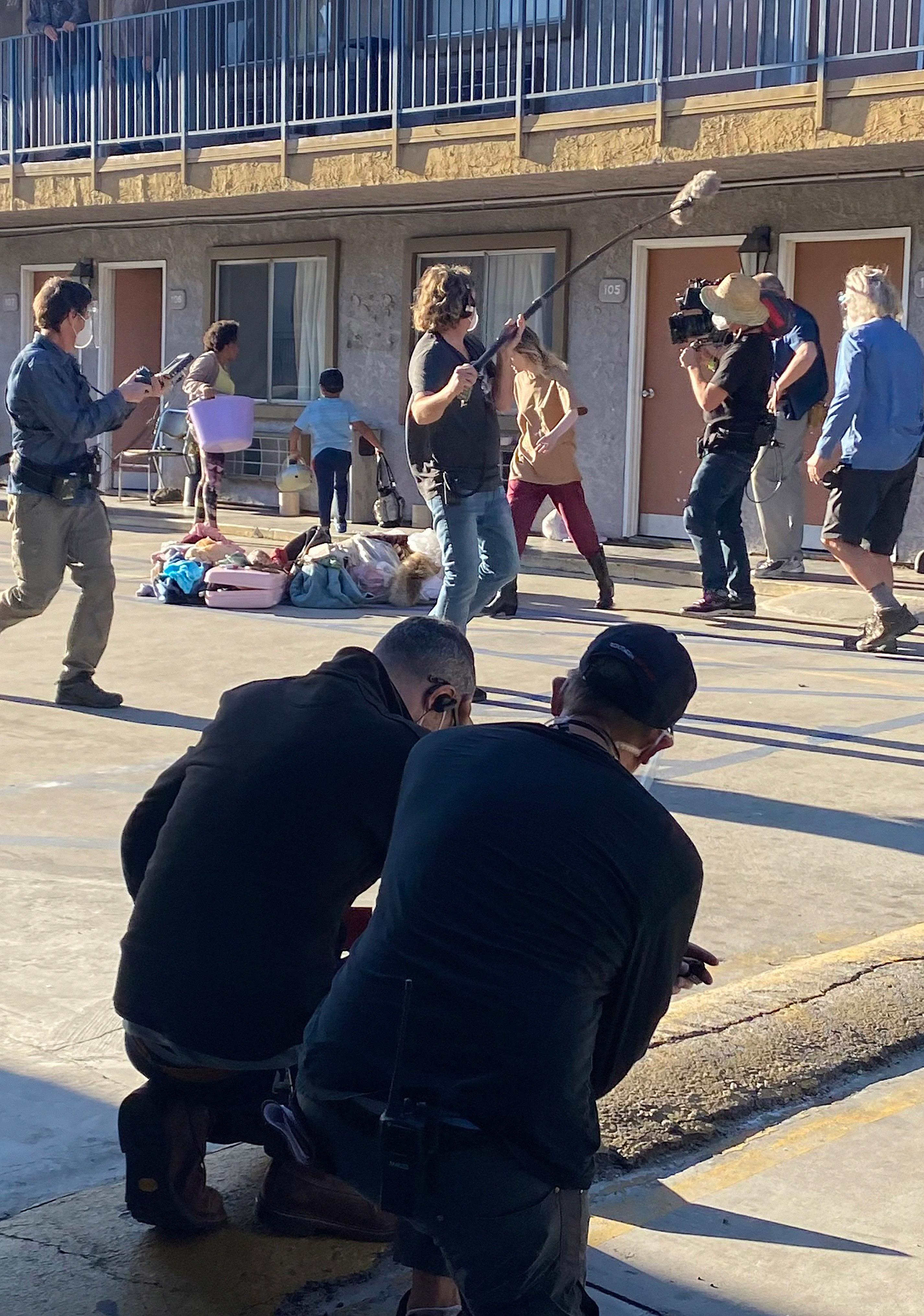
Seiple’s overall goal for the lighting was for naturalism, which saw day exteriors being filmed as much as possible in available light. Along with Tungsten bulbs in practicals, interiors were illuminated with wireless LED fixtures – including LiteGear Litemats and neatly-concealed Astera Titan tubes – positioned to give Riseborough and the other actors freedom of movement, and
networked together via a lighting desk, to enable speedy adjustments when necessary.
Both Seiple and Morris remark on how much they enjoyed the experience of shooting To Leslie on film.
“I love it when you hear the 1st AD call ‘Action’. The camera vibrates on your shoulder and you know it’s gametime,” says Seiple. “Shooting on film heightens the experience, makes you feel like you are shooting something of importance, and gives you a sense of pride and focus. And I’m immensely proud of the onscreen result.
Morris adds, “What’s wonderful about film is that it’s precious. You know it will run out. So, on each and every take, there’s more focus and concentration than on a digital shoot, when the cameras keep rolling. It’s like the moment the curtains come-up at the theatre, and actors and the crew know they have to be ready. This feeling filters to everyone. It makes the set a really dynamic place to be. Everyone leans-in to make sure they get it right. You can see it in faces and body language.
“I am so happy that I got to shoot To Leslie on film, and I would shoot on film again in a second. But I’m even more delighted that its textural qualities created the perfect aesthetic for Andrea’s incredible performance as Leslie, enabling such a small film to receive so much attention and allowing a lot of people to find it.”
34 MARCH 2023 CINEMATOGRAPHY WORLD TO LESLIE•LARKIN SEIPLE


Sony VENICE 2 And Extension System 2 Available Now VENICE 2 offers a choice between 8K and 6K full-frame sensors, each offering exceptional picture quality with incredibly wide latitude and gamut. Thanks to new internal recording capabilities, users can capture even more colours and detail within the compact body they already know. Learn more cvp.com/sony Book a demo demo@cvp.com Get in touch +44 (0) 208 380 7400
FATHERS AND SONS
By Darek Kuźma
Seasoned
cinematographer Ben Smithard BSC joined forces once again with playwrightturned-film-director Florian Zeller, to tell an emotionally-harrowing story of a family on the verge of collapse.


Peter (Hugh Jackman) is an esteemed Manhattan lawyer with a bright future, that will probably include working for a senator preparing for the next presidential election. Recently married for a second time, he has a young and caring wife, Beth (Vanessa Kirby), and a newborn son, for whom he would like to be a far better father than his career-driven dad (Anthony Hopkins) ever was to him.
One day, Peter’s ex-wife, Kate (Laura Dern), alarms him that their teenage son seems to be struggling with some form of depression and has dropped out of school. Nicholas (Zen McGrath), once a cheerful boy who took his parents’ divorce hard, confesses to Peter that life weighs him down and he dreams of moving in with him. The father agrees, trying to make amends for past wrongs, yet despite his and Beth’s best efforts, Peter and Nicholas’s lives begin to unravel.
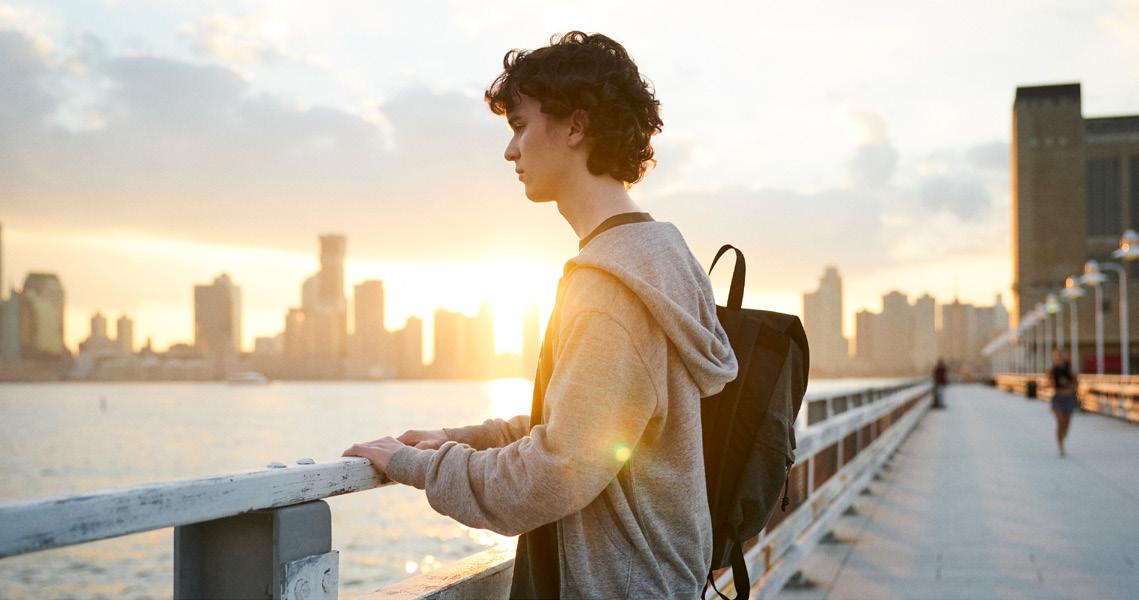
Smithard was keen to work with Zeller on making yet another of his plays into a truly cinematic experience. Their previous collaboration, the Oscar-winning The Father, took us inside the fragile mind of an elderly man gradually crushed by dementia. The Son makes us consider an adolescent grappling with mental illness, inspecting how traumas are passed from fathers to sons in an increasingly volatile world of endless professional and personal distractions.
“Both films put their families to the test, but are rather
different,” says Smithard, whose previous credits include My Week With Marilyn (2011), Alan Partridge: Alpha Papa (2013), Goodbye Christopher Robin (2017), Viceroy’s House (2017) and Downton Abbey (2019). “The Son is more straightforward, less complex narrative-wise. What you see is what you get. It has more locations, more scope, yet the process of making it was quite similar to that of The Father.”
This process included Smithard spending two weeks with Zeller in a production office and going through every scene in detail.
“We already had our locations locked, the set design was done, so we worked on schematics and storyboards I’d drawn, and even acted out some of the scenes,” explains the DP. “We spent two weeks discussing angles, blocking and character arcs. Without distractions. Getting inside Florian’s head again and letting him inside mine was intense, but very helpful, as I got to know the film inside-out.
“I cherished these kinds of preps with Florian on both films, because when we went on-set, I didn’t need to ask him too many questions. He would focus on the barrage of decisions he had to make each day and gave me a freehand in putting what we talked about into practice.”
As we get to observe Nicholas, wandering around New York during his school-time and reacting anxiously to Peter and Beth’s efforts to put him at ease, the question about what exactly he is suffering from, matures into what Peter can do to better understand and empathise with his suffering son. Not only does this lead to a number of uncomfortable situations that may deepen the boy’s trauma, but also makes Peter confront his own father in a gripping sequence that sheds new light on the whole story.
“Because the subject matter is pretty hard and emotionally dense, Florian didn’t want the film to look moody or gloomy, rather to create a cinematic realism that would emphasise what’s going on without influencing how the audience feels towards the characters.”
Thus, Smithard decided on the same camera/lens package he had used on The Father – namely the Sony Venice camera and Zeiss Supreme lenses.
“Sony Venice covers everything you want during highend filmmaking, and you can do anything with it in post. It was perfect for the many subtleties on this project,” he declares.
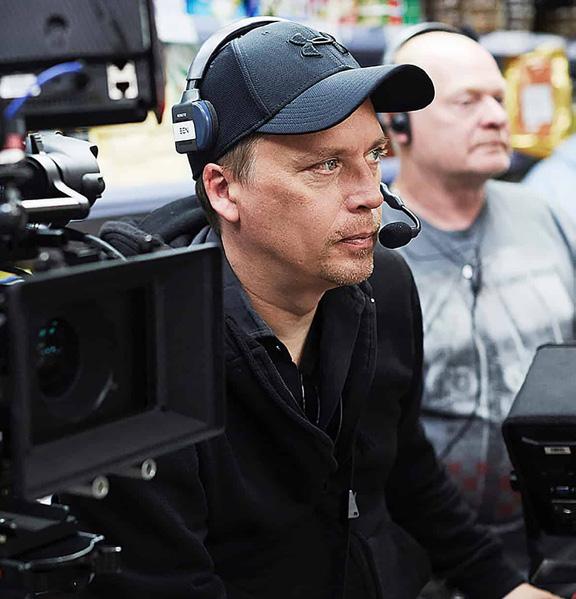

He equipped the Sony Venice with Zeiss Supreme Primes (18, 21, 25, 29, 35, 40, 50, 65, 85, 100 and 135mm), as well as Angénieux Optimo 19.5-94mm T2.6 and Zeiss Compact 28-80mm T2.9 zooms. As always, Smithard operated the camera himself and approached the composition instinctively.
“The film starts quite conventionally in terms of framing, but then, incrementally, things start to crack, which I addressed by displacing the characters from the centre of the 2.39:1 frame. You can feel their emotional turmoil without being distracted from the performances.”
The Son was a single-camera shoot and some of the more emotionally-intense scenes demanded a level of empathy and physicality that benefitted from Smithard’s decades of experience and instinct. Like the one in which Peter and Kate are confronted by a psychiatrist in front of a sullen Nicholas.

“I love shooting emotionally-challenging ensembles handheld. We shot this scene at the end of a long day. I knew I’d have one take at it, two at most, and it was tricky

36 MARCH 2023 CINEMATOGRAPHY WORLD
THE SON•BEN SMITHARD BSC
as I had to follow the performances and be at the right place at the right time. When Nicholas jumps up, I had to stand behind Hugh and Laura, then follow him and turn around to see the parents’ reactions,” he says. “I was very close to the actors and it would have been very easy for me to crash into them or for them crash into me.”
As the film deals with emotional traumas, the fragility of developing adolescent identity, and the underlying message is that in some cases love may not be enough, Smithard’s lighting was also instinctive.
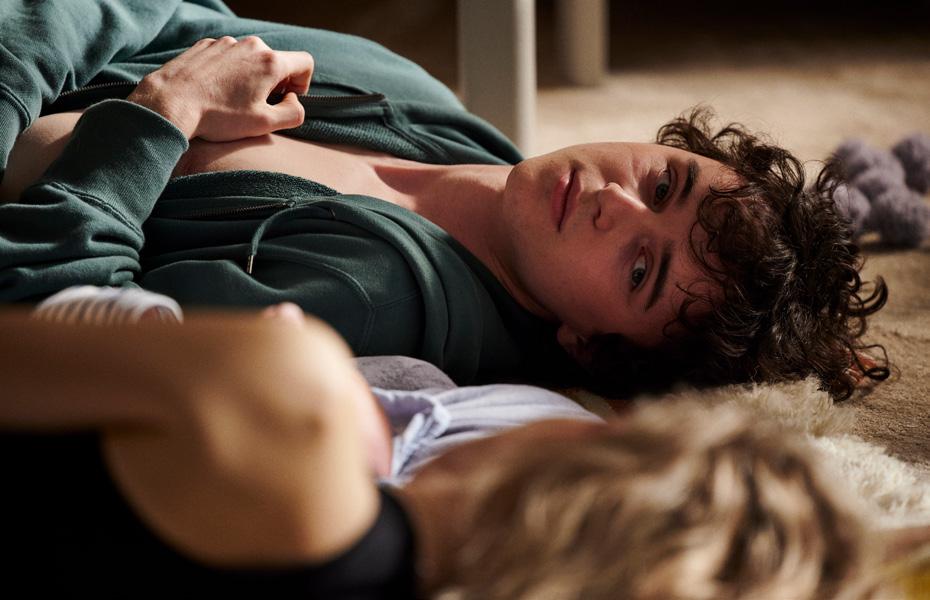
“When you’re doing this for years and years, it’s hard to explain how you go about lighting. Because it’s not a process, it’s you. How can you define ‘you’? For me, lighting is about helping the actors feed-off the atmosphere of the scene.
“When we went to the south of France to shoot a flashback scene on a boat with Peter, Kate and young Nicholas, I could’ve built a lighting rig on the boat, but it would have become too mechanical. So, I put the camera on my shoulder and opened-up to those precious moments that happen from time to time. Hugh was steering the boat, we had sunlight behind us, and there was no need for additional light.”

Apart from this short excursion and a three-day trip to New York to shoot some exteriors and live plates, most of The Son was done from September to October 2021 at OMA:X Film Studios in London, where Peter and Beth’s apartment was built. The production gaffer was Sol Saihati.
“In terms of lighting, I had a standard Tungsten package, plus some LEDs,” says Smithard. “I always try to make the light stem from the mood of a scene and follow the arc of the story, so this tried-and-tested way of shooting
a studio set was perfect. In The Father almost all the light sources were Tungsten. On The Son I also used ARRI SkyPanels quite extensively because of how flexible they are colour temperature-wise. You can put twenty of them up and they will all look the same.”
Unlike shooting The Father where the creation of the protagonist’s apartment took literally the entire soundstage, leaving little or no room for anything else, this time Smithard had more options.
manipulated plates from the real Manhattan.”
Infusing the studio scenes with life and enhancing the emotional continuity of the film during the DI grade was the final touch to help fully-immerse the audience in Peter and Nicholas’s respective journeys.

“Because we had several London locations standing-in for New York, part of the grade was about polishing the images,” says Smithard. “However, we mostly spent time subtley augmenting details to make the relationships and the traumas resonate with the audience, but without giving away that we had to manipulate colours, framing and camera movement to tell this story.”
And they definitely succeeded. For when the end credits roll, we do not question the filmmaking mechanics, we have been too engrossed in The Son’s observations on the hardships of parenthood and life’s curious ways, to worry about that.

In the end, whatever similarities The Son and The Father share, this is an entirely different film that stands on its own.
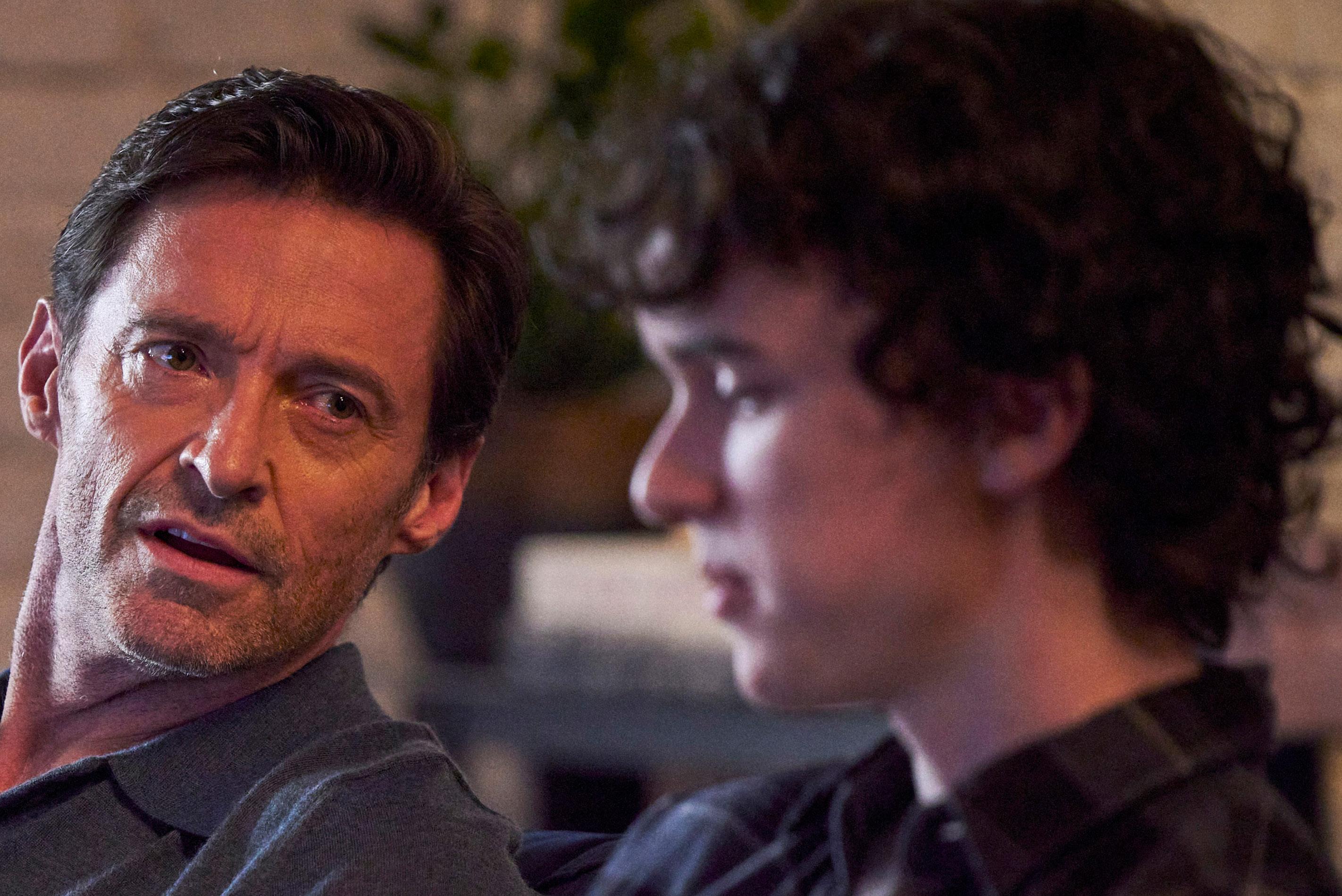
“We had lots of space which was brilliant because we had to raise the set off the ground at six feet to simulate the height of Peter and Beth’s Manhattan apartment. It has big windows which you see through at various times of day, and it all had to feel natural,” he reveals. “We had Rosco SoftDrop Translight, just like in The Father, which is effectively a big photograph of 100 x 40ft. When I did the grade with my regular colourist Gareth Spensley at Company 3, it was a canvas onto which we also
“It makes you think about your children and young people – because at the end of the day, you have to look after their mental health and well-being too. We hear about that all the time in the news, especially in the times of Covid, but many of us just don’t listen,” says Smithard.
“The Son is trying to say exactly that we need to listen and be watchful. It’s a very poignant film, a very honest film, a very truthful film, about a very important subject matter, and it needs to be discussed through these lenses.
“For me, it was another great experience to work with Florian again. We’ll see what the future brings, but I’d be very glad to do another one with him.”
BEN SMITHARD BSC•THE SON
CINEMATOGRAPHY WORLD MARCH 2023 37
Images: Copyright Black Bear Pictures/See-Saw Films.
Getting inside Florian’s head and letting him inside mine was intense, but very helpful
For me, lighting is about helping the actors feed-off the atmosphere of the scene
SEX & DRUGS & LONELINESS
DaisyJones&TheSix, the new and original Prime Video series about the rise and fall of a fictional 1970s rock’n’roll band, benefitted from cinematographer Checco Varese ASC’s experience and visual savvy.
In a way, Daisy Jones & The Six is the same old story of a fight for love and glory as it charts the rise of a 1970’s band of Pittsburgh blues-rockers and a non-conformist LA singer/ songwriter to the very top, only for them take a dramatic nosedive. It’s a story of sex, parental heartaches, drugs, tortured affairs, atonement for past sins and rock’n’roll. But, being framed by documentary footage of decades-older band members reminiscing the good and bad times, the story is told through a series of clever adagios and crescendos. What remains – and what resonates louder than music and lyrics – are the individual stories of young folks who either burnt too brightly, or were never able to peak in the shadows cast by the others.
The project had quite a long and arduous development –it was prepped before Covid, the cast were already learning to play and sing the original songs, yet principal photography only started in September 2021 – but cinematographer Checco Varese knew it was worth the wait.
“I was pitched the idea of shooting a 1970’s musical series when I was shooting Them (2021, six episodes) for Amazon. I was born in the 1960s, in Peru, so I didn’t know that world, but I made my name in the US in the 1990s doing hundreds of music videos. So, I felt I had much to offer Daisy Jones & The Six in terms of shooting ensembles and giving music a visual identity,” he explains. “At the end of the day, the movie camera is another instrument, it can be a violin complementing an orchestra, it can be a bass guitar enhancing a rock band.”
Varese established the look of Daisy Jones & The Six and shot the first five episodes with director James Ponsoldt. The series was done in two blocks, September to December 2021 and February to May 2022. DP Jeff Cutter shot most of the second block, with Varese returning in May 2022 to work with director Will Graham on an episode taking place in Greece.
“We prepped as if it was one big movie,” says Varese. “Sure, we had to adhere to the structure of episodes, having 12-15 days for each one, but it’s a story of fighting loneliness with music. The characters have dysfunctional families, or were abandoned, or didn’t feel loved, and they try to fill-up these holes by travelling the country with a group of people who feel the same. It’s easier to think about all of that as a movie.”
Big chunk of the second block was done in New Orleans where the crew used the Tad Gormley Stadium for the band’s greatest concert, but Varese and Ponsoldt’s episodes were shot mostly on location in LA.
“I bought some records and saw some documentaries, to get a sense of the ‘70s. I didn’t use a lot of film/music references, but did watch The Deer Hunter (1978, dir. Michael Cimino, DP Vilmos Zsigmond ASC HSC) and The French Connection (1971, dir. William Friedkin, Dp Owen Roizman
ASC) to understand working-class America of that time,” he claims, referring to the band’s humble Pittsburgh beginnings.
By Darek Kuźma
different venues, from seedy bars to large stadiums, but the pandemic made it impossible to have dozens of extras in the background. We decided to make the story even more about the band members, about their relationships, about them playing together, singing, looking at each other. We intertwined these with a few digitally-enhanced shots from behind the band, and it worked,” reveals Varese.
“You stand in front of an audience, even in a tiny bar, and when they cheer at you, that’s the love your alcoholic mother or absent father never gave you. So, yes, Covid helped us to focus more on the human drama.”
Varese admits he is agnostic about film cameras and shoots on whatever fits the project. In this case, he knew Daisy Jones & The Six should be a Sony Venice show.
“My biggest inspiration was the research done by the art department. They had a large office with an entire wall covered with thousands of period pictures. I stopped by every two days to take photos with my iPhone.”
Highlighting the relationship between the band’s two leaders, Daisy (Riley Keough) and Billy (Sam Clafin), and their rapport with the rest of the group, was paramount.
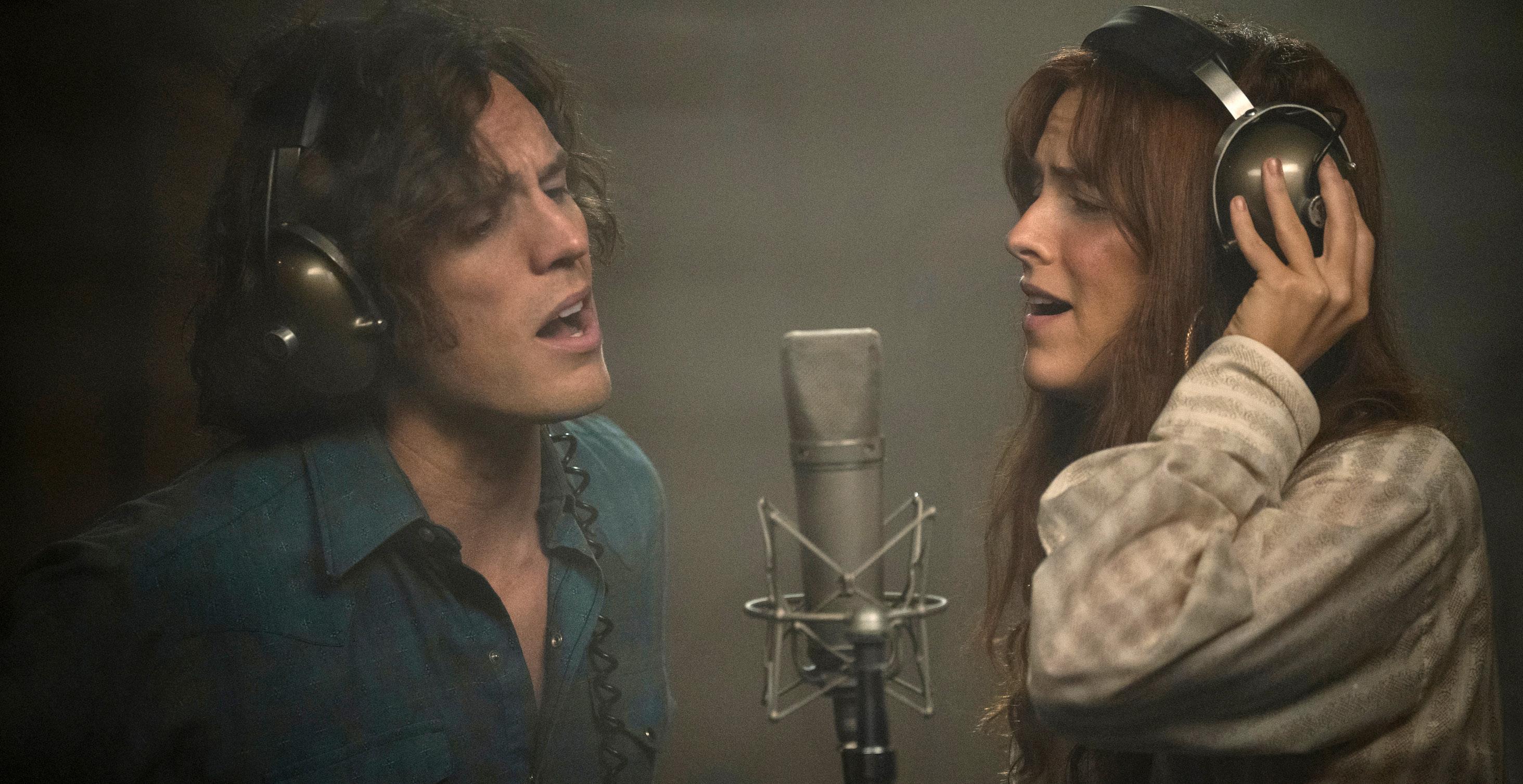
“I started my career doing documentaries and news coverage, and I still value being an observer. We shot mostly with 28mm and 40mm lenses. We did dollies with remote heads, operated handheld, used Steadicam and Technocrane too, yet it all came down to making it cinematic without losing the intimacy, the emotional impact.”
This explains why he shoot long takes as much as possible. “If there’s a scene with Billy and Daisy recording in a studio, we start in a wide shot and push to Daisy singing, then the camera moves gently to the left to reveal Billy singing, looking at her. We push to Billy and that’s it. You don’t need tricks or seventeen cuts for that.”
Funnily enough, Varese says that shooting during the Covid pandemic helped Daisy Jones & The Six to reach this level of
“I could go on-and-on about the Sony Venice and its features – its great sensor, latitude, contrast levels – but for me it was instinctive. I just felt it would be perfect for this production,” he asserts.

“We had three Sony Venices and its cousin, the Sony FX3, which I was the first cinematographer to use in a series, on Dopesick (2021). The Sony FX3 looks like a camera you’d take on your holidays, but has the same sensor as the Sony Venice, it shoots 4K, and it is compact, which was very important when we went Athens and then to the little Greek island of Hydra to shoot Daisy going into a rock’n’roll exile in the wilderness.”
The choice of lenses for the show was far less instinctive.
“The series covers over a decade of their lives, so we had a six-day-long hair and make-up test – a rare thing these days. I took advantage of that and tested lenses from 17 different manufacturers. In the end, I picked the Angénieux Optimo Primes because they allowed an internal filter,” he says.
“When the Covid hit, the cast kept rehearsing and they became almost professional musicians. No one was pretending, they were genuinely playing the music and singing the songs. I wanted to maintain this musical and emotional realism without losing the cinematic realism we designed. I decided to equip Optimos with Tiffen Glimmerglass 1/8 to achieve this, and then put a net behind the lens for the ‘60s Pittsburgh working class part.”
To shoot the first block, Varese brought an eclectic lighting package. “We had to be careful not to destroy the immersion. For concerts in small bars, it was basically a mix of rock’n’roll Pars and a period disco balls. For bigger concerts we used Pars, Parcans, Canons and spotlights. For the non-concert scenes we had an array of LEDs, mostly ARRI SkyPanels and LiteGear LiteMats. It was a fun challenge.”
intimacy and poignancy.
“There were many concert sequences in the script, in
Shooting in Greece was a different matter. “Hydra is not the Santorini-like Greece of white buildings with blue roofs. It’s more rustic and wild. No roads, no cars. We had to transport the gear on the backs of 60 mules. There was no way I could take big lamps, so I took a bounce and three or four little

38 MARCH 2023 CINEMATOGRAPHY WORLD
DAISY JONES & THE SIX•CHECCO VARESE ASC
I started doing documentaries and news coverage, and still value being an observer
lamps. Plus, I used a lot of practicals from the art department.”
The look was supported by a LUT that Varese designed with his friend, Stefan Sonnenfeld, at Company 3 in LA.

“The LUT resembles Kodak film from 1980s. It has the same colour, a bit of grain. It’s obviously digital, but Stefan created it through scanning a negative from 1980s,” remembers Varese.

“I believe colour transmits emotions and enhances the arcs of the characters. In Pittsburgh, it’s a bit colder, the light is limited, has little bounce. When they go to sunny California, the light comes crashing through the windows, the sky is blue, the palm trees green, the mountains yellowish, the ocean enticing. When
things are good, the look is romantic and affirming. When it begins to fall apart, the mood gets darker – it’s still warm and cinematic, but with more reds and browns instead of oranges.”

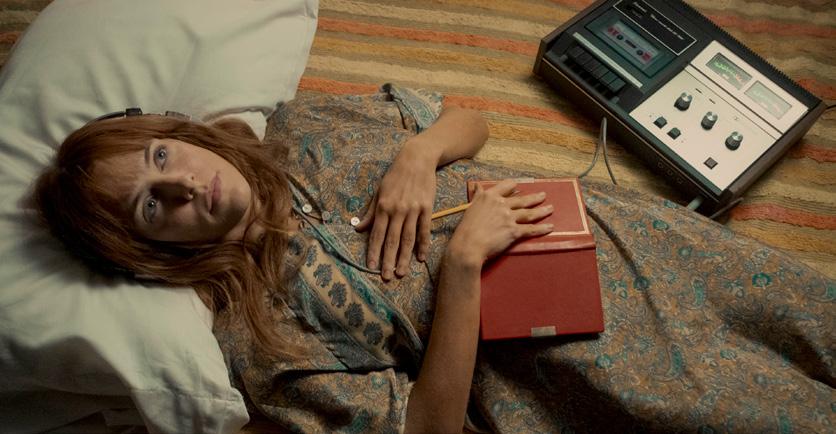
Needless to say, Varese is proud of how Daisy Jones & The Six turned out, and that, despite all of the obstacles he and the rest of the cast and crew had to overcome, the series accomplishes the most important thing: it makes the viewers deeply understand the characters over their long and turbulent
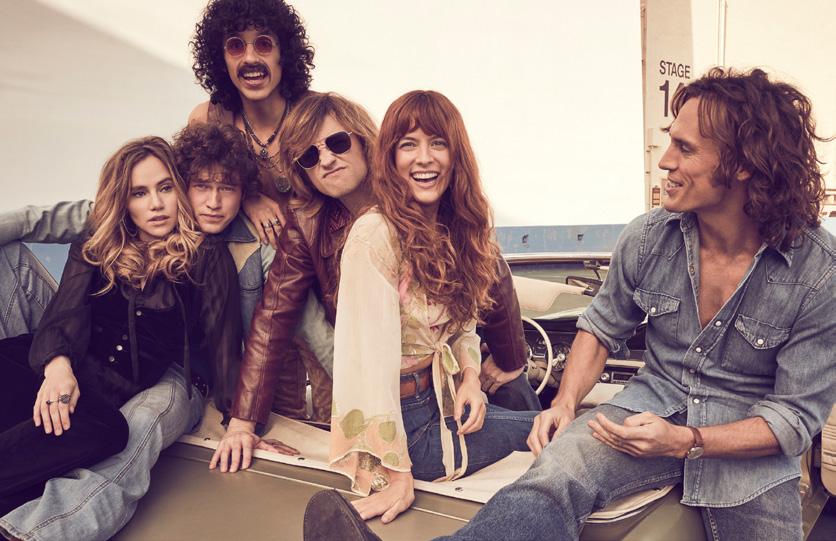

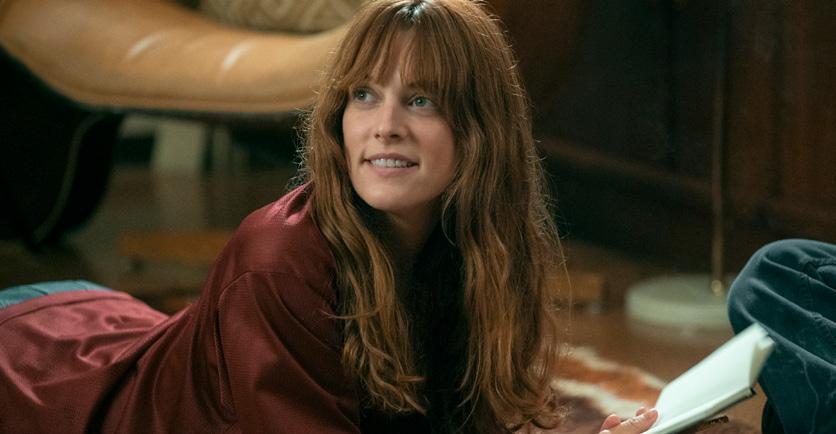
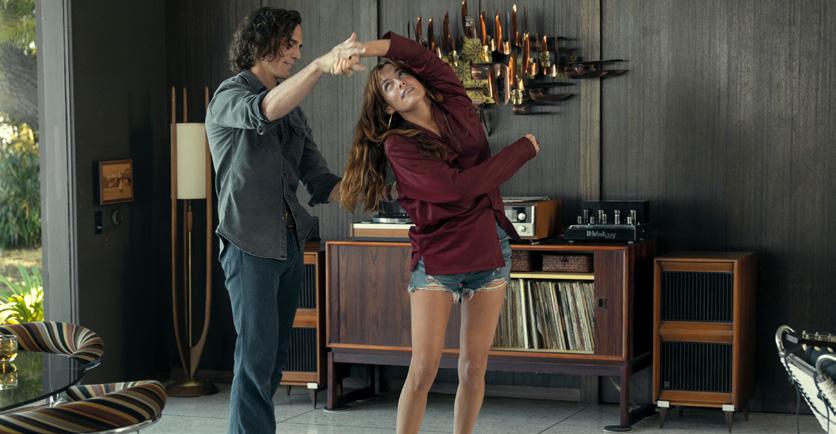

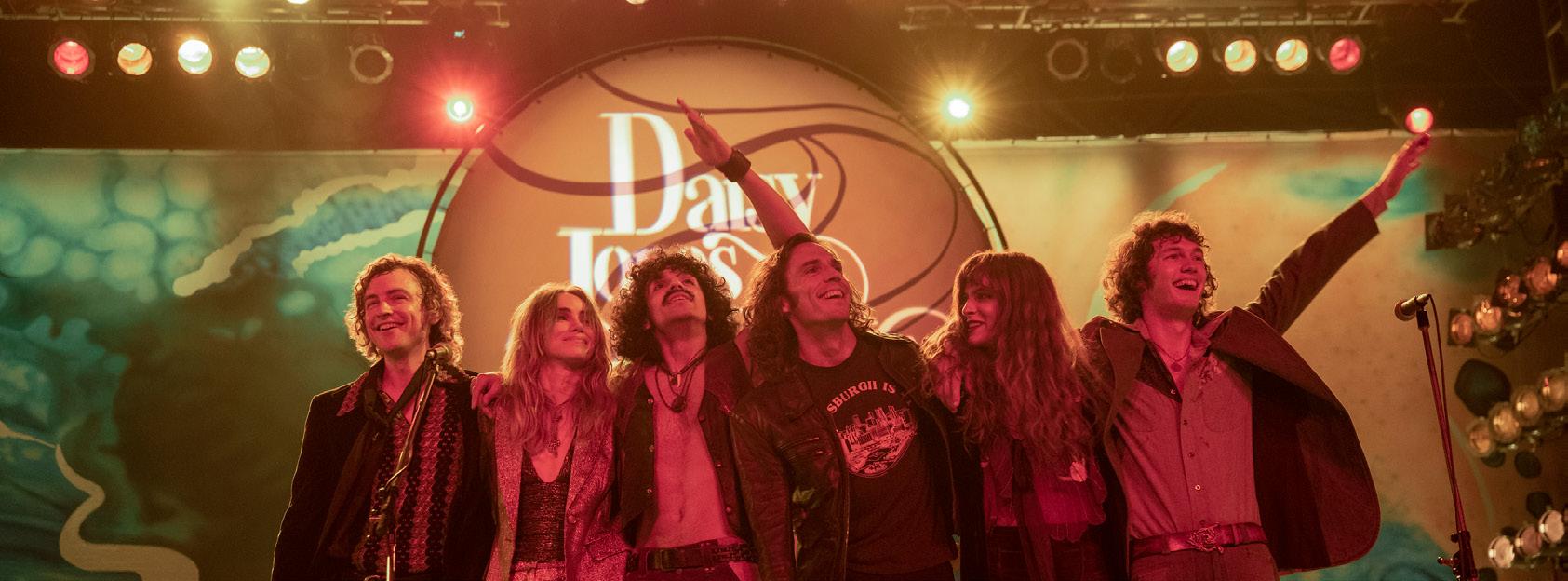

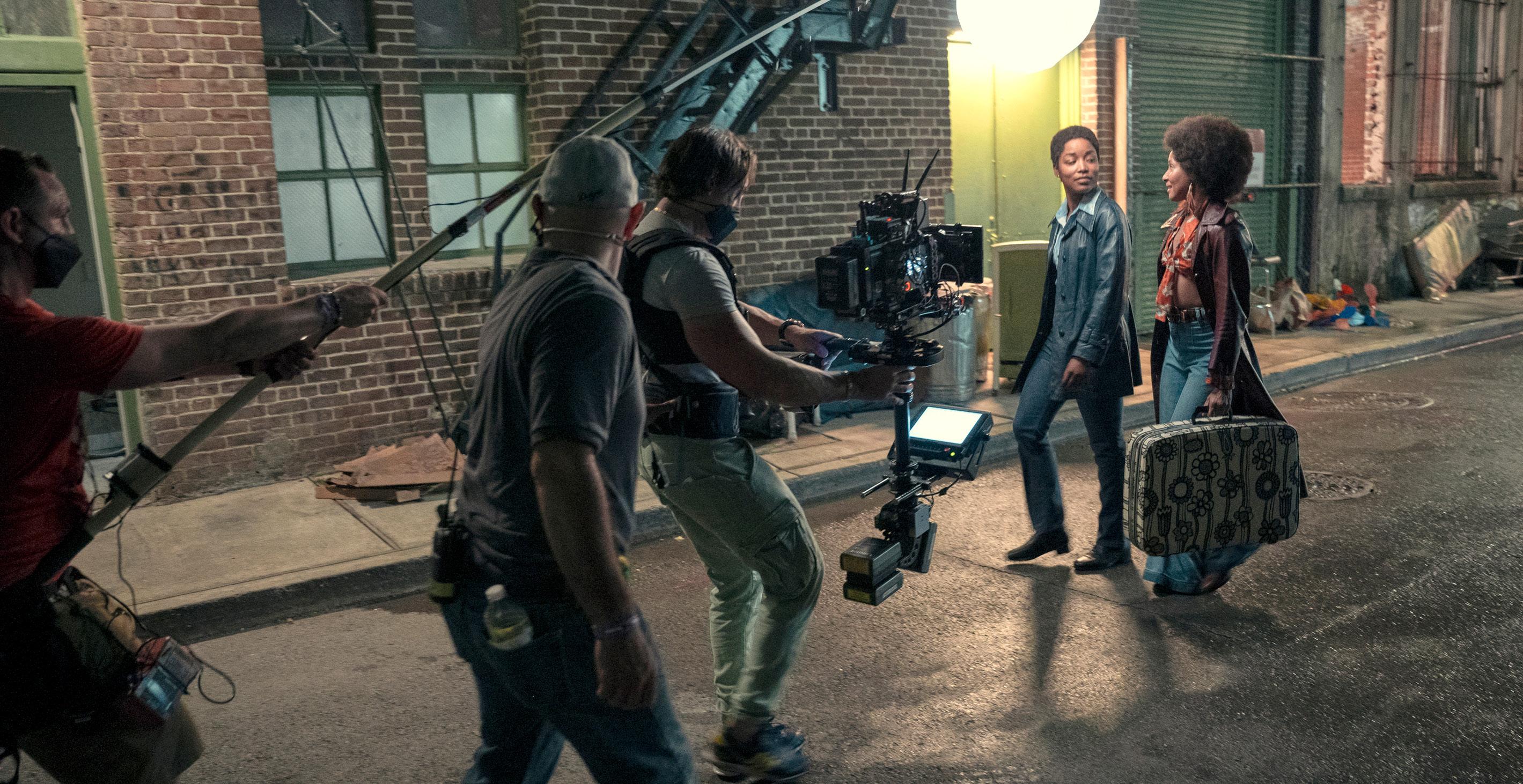
journey; their ambitions, dreams, fears, what makes them tick and what makes them freeze in the most unexpected moments.
“The show wouldn’t have a reason to exist if you could not relate to the characters, and feel what they feel,” he says. “Besides, I always try to observe the worlds I create as if I was an audience member. I ask myself every morning when I go to the set, ‘What is this scene about? What does the audience need to see and feel?’ I don’t see any other way.”
CHECCO VARE SE ASC•DAISY JONES & THE SIX
CINEMATOGRAPHY WORLD MARCH 2023 39
Images: Copyright Amazon Studios.
I picked Angénieux Optimo Primes because they allowed an internal filter
SHOWSTOPPERS
A-C ENTERTAINMENT
A-C Entertainment had a swathe of new products in its ever-expanding range of lighting, interface and support products. Brand development manager, Neil Vann, talked us through the Prolight ECL range of panel and tube lighting, rapidly becoming a fixture on many productions. Notably, the ECL NanoPanel TWC light got a lot of interest – a pocket–sized, battery-powered luminaire that can be placed virtually anywhere. Working seamlessly with the whole ECL range, set to the same address, they all adjust to the same colour and output simultaneously, and Neil aptly described it as a “get out of jail card.”

Networking products included Luminex network/data infrastructure and Wireless DMX, the “glue” in the middle of lighting and data workflow. As for their range of support products, “It doesn’t matter how many lights you’ve got, you’ve still got to rig them,” said Neil, and they have support solutions for every application. www.ac-et.com
ARRI
The Alexa 35 is a 4K Super 35 camera with ARRI’s first new sensor for 12 years, featuring 17 stops of dynamic range delivering filmlike highlights. Shooting in Monochrome? Try the Alexa 65 Monochrome, Mini LF Monochrome and the XT Monochrome. ARRI Signature zoom lenses on show included 16-32mm T2.8, 2475mm T2.8, 45-135mm T2.8, and the 65-300mm T2.8. Impression V filters give a vintage feel to Signature Prime and zoom lenses with four negative and four positive dioptre filters to incrementally shift the focus characteristics and bokeh effects.
The Trinity 2 rig shares 80% of components with the Artemis 2, for easy transition. Trinity 2 has a new sled design, modular battery hanger, gimbal low-friction bearings, and self-centre mechanism, with choices of 19mm carbon, aluminium or steel rods Inside the ARRI Orbiter, new 25 and 35-degree projection optics means the six LED light can transform into many different types of fixture, including open face, Fresnel, projection, soft light and more. www.arri.com
ARRI RENTAL
ACO – ASSOCIATION OF CAMERA OPERATORS

The ACO was formed to celebrate and promote the technical and creative skills of the camera operator, and to enrich these skills by being at the forefront of developments in technology and production methods.


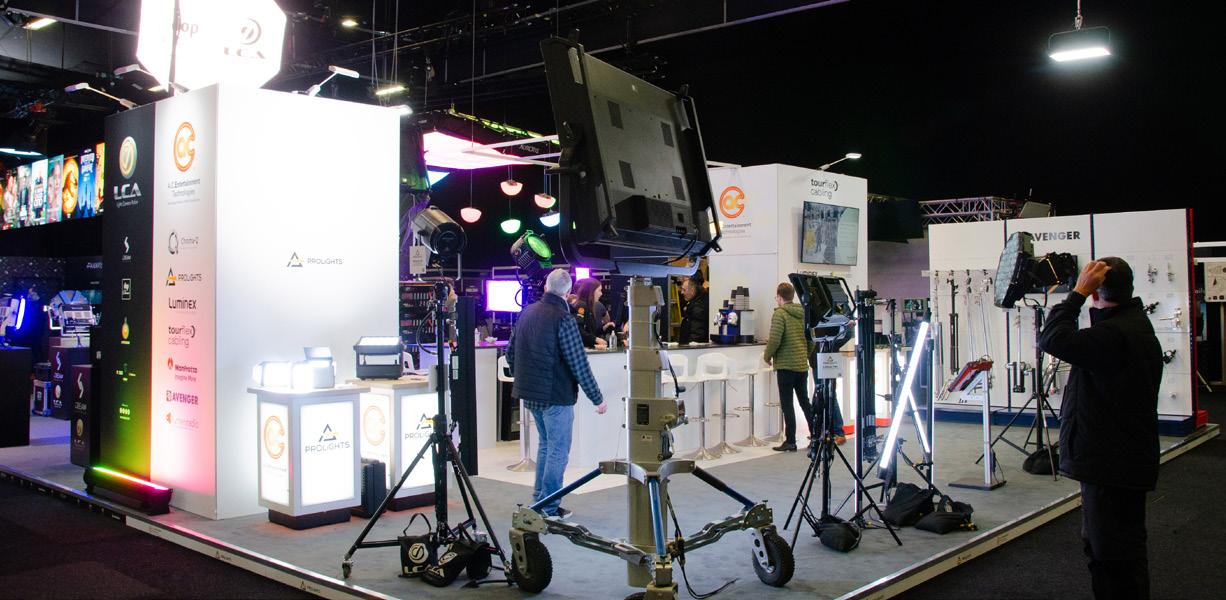
As well as furthering the art of camera operating and mentoring the younger generation coming through, the association is particularly concerned with promoting awareness and knowledge of health and safety procedures on-site, especially in the light of the deaths of Mark Milsome and more recently Halyna Hutchins.
The stand welcomed familiar faces, as well as students and ACs looking to connect with the association and begin their journey into the world of camera operating. The ACO offers its members vital support in the field of camera operating with members benefitting from a wealth of knowledge accessed via its network. As well as a regular newsletter, In The Frame, members and friends of The ACO are also able to access a range of educational and training articles and webinars on its website, specialising on different areas of work, for example aerial filming with drones. www.theaco.net
APUTURE
The brand new INFINIBAR garnered a lot of attention. A range of rectangular LED lights, the INFINIBAR can be infinitely and seamlessly connected, end-to-end with no visible gaps between lights, and come in three different sizes: the PB3 (1ft), PB6 (2ft) and PB12 (4ft). The fixture features 10 connectors that can be rigged to create both 2D and 3D building options. The INFINIBAR contains a RGBWW LED chipset, which enables XY, advanced HSI and white-point control between 2000K and 10,000K, as well as a CRI of 96. This product is aimed at a range of prosumer and professional productions, to open opportunities for practical lighting as well as hidden lamps on-set. Alongside this, Aputure also featured a host of other fixtures from its Light Storm and amaran range. www.aputure.com
The Heroes large format lens collection is made up of unusual optics, designed to supplement a main lens set. Look lenses have a Look lens ring at the front to controllably detune the intensity of its characteristic optical swirly bokeh. Currently 50mm, 57mm and 80mm lenses. The T.One lenses are claimed to be the first cine lenses to be truly-useable at T1 with no drop in image quality, allowing work at low light levels with minimal depth-of-field.
ARRI has developed a set of Prime DNA LF lenses, focal lengths between 28 and 200mm, T1.6 to T2.8, for the smaller sensor size of the Alexa LF system, comprising re-housed vintage optics with a new multi-blade iris for circular bokeh. The Alfa lenses have a softer feel than Master Anamorphics.
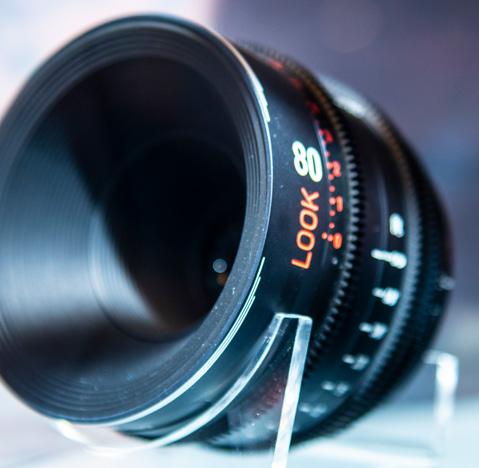
ARRI’s VariCon2 filter device adds coloured light to darker areas of the shot using LED lights in the mattebox. DPs like the embedded look they give as it cannot be removed in post-production. www.arrirental.com
BLACKMAGIC DESIGN
The Blackmagic stand was one of the most popular at the show. Patrick Hussey, head of communications, expressed surprise at the breadth of visitors at all levels, not just the high-end. There was a lot of interest in DaVinci Resolve with Blackmagic cloud and remote collaboration workflows, where the project file sits as a library in the cloud and media is pushed out to Dropbox or Google drive, effectively offering localised media at different destinations with the project files being the only shared element, syncing with the local media so users can collaborate. It’s also affordable at $5 a month per library.
The Cintel film scanner has evolved. Originally designed for remastering filmstock to higher resolutions, it is now in-demand as an archiving tool. The latest version has capstans rather than sprockets to avoid damaging archival stock.


You can’t forget their unique range of cameras as well, which is where many attendees were getting hands-on. Their 12K camera is getting a lot of interest in virtual production where the entire image can be shot at 12K and then in post you can choose which portion of the frame to take a 6K plate from.
www.blackmagicdesign.com
An A-to-Z of supercool cinematography kit and services as shown at the 2023 BSC Expo.
40 MARCH 2023 CINEMATOGRAPHY WORLD ROUND-UP•BSC EXPO 2023
Reporting and photos by John Keedwell GBCT, Dylan Bruce, Kirsty Hazlewood, Iain Hazlewood, David Wood and Ron Prince. Seminar photos by John Daly BSC.
CAMERIMAGE
Over from Poland, Dariusz Wyczółkowski told us he was very happy and kind of surprised with attendance at last year’s festival of cinematography in Toruń – recording 90% of its pre-Covid 2019 numbers and welcoming guests from a record 51 countries.

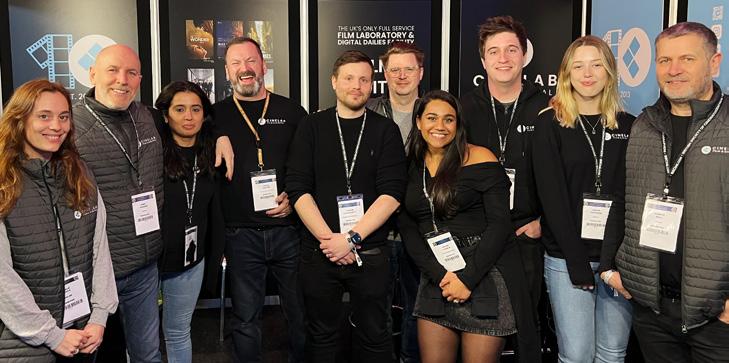
Established 30 years ago, the festival has evolved from a small-scale, innovative idea to a now globally-recognised event hosting key players, and with 800 cinematographers attending last year, exhibitors and visitors flocked to the event at the CKK Jordanki.
On that note, the festival awaits a brand-new venue, with the first step of construction starting in September 2023. A studio that can host workshops, and other technical events connected to the festival, should be in operation by 2026, with the main venue including a 1,500-seat screening auditorium on-schedule to be erected afterwards. The prospects for this unmissable annual event continue to be very much on the rise. www.camerimage.pl
CANON
Tom Storey of Canon UK said that their main conversations were around the new full-frame 8K R5C and the C70 camera models. The R5C is an RF lens mount video and stills camera, with a single switch between modes. The 8K native raw video mode shares the same interface as their cinema EOS cameras in a stills-style body and form factor. The C70 EOC video camera again has a small form factor, whilst being a dedicated to video, with a 4K Super35 sensor an 16-stops of dynamic range. It’s the first Cinema EOS camera to have an RF lens mount. New cinema lenses include the Flex Zoom

45-135mm and 20-50mm full-frame models, both boasting a constant T2.4 across the zoom range. Their new Super 35 lens is the C8 15-120mm zoom, which will effectively work on full-frame cameras with the use of a 1.5x extender. www.canon.co.uk
CHIMERA LIGHTING
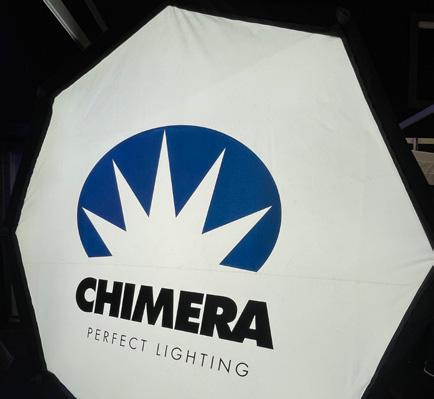
New additions to the extensive Chimera OctaPlus Lightbank family are the 2ft and 6ft options. These diffusers are handcrafted in Colorado, with the two new modifiers featuring high and low heat options for compatibility with HMI/Tungsten and LED fixtures alike. Furthermore, the Octa 5 is now compatible with the Creamsource Vortex 8, as well as the lantern and pop-bank that fits this popular LED panel to offer beautiful, wrapping octagonal light.
Chimera’s time-tested Panel Frames were also on display. Panel Frames are available in seven sizes, with ten fabric panel styles to choose from and 18 window pattern designs that can be attached with a frame mounted holder for unique effects.
www.chimeralighting.com
CINELAB FILM & DIGITAL
Cinelab, which sponsors and supports the Straight 8 film competition, reported huge enthusiasm for shooting on celluloid amongst film students, graduates and up-coming filmmakers, all eager for knowledge about film processing and workflows. A key message, both on the stand and in a special seminar session, was about its DFD (Digital Film Digital) analogue intermediate process for authentic film looks, where digital footage is shot to film and the developed negative is scanned back to digital. Within that process the images soak-up properties inherent in celluloid emulsion – like grain and texture. Cinelab’s DFD service is popular in shortforms, but more recently Ari Wegner ACS used it on The Wonder.
The company fielded enquires about its ultra-high res OXScan for 12K 15-perf IMAX / 8K 35mm, designed in response to a growing trend of new ‘ScanOnce’ large film format productions. On a separate note, Cinelab collects and upcycles several kilogrammes of silver every month from its photochemical baths, and was showing an impressive collection of film-themed jewellery – rings, bangles, bracelets – designed and made by Claire Richardson and Natalie Daniels. www.cinelab.co.uk www.fromthesilverscreen.co.uk



CINEO LIGHTING
In Cineo Lighting’s advanced and impressive LED range, the focus was on the technological capabilities of the new Quantum Studio, alongside the Quantum Ladder, Reflex R15, Quantum II and LB800 LED fixtures.




The Quantum Studio uses a full 500W and generates over 30,000 lumens of output. As part of Cineo’s Quantum series of highpower soft lighting, the Quantum Studio utilises new LED technology created for the Quantum II, reaching a TM-30 rating of +99. The Quantum Studio offers full connectivity for remote operation using DMX/RDM, ethernet or WIFI and advanced control via Cineo Lighting’s own Stagelynx app. The intuitive menu interface for Cineo Lighting’s fixtures will be appreciated by gaffers and their crew, and is due to the fact they run on C2 OS and are all computer-controlled with an integrated Raspberry Pi. www.cineolighting.com

CIRRO LITE
Cirro Lite, lighting distributors and stage designers, showcased an impressive array of products this year. Especially popular was the Kino Flo Mimik VR, featuring a revolutionary, patented technology that translates an incoming RGB video signal into five individual emitters to mirror content from the LED wall. Where LED screens traditionally output between 800-1200 nits, the Mimik outputs a powerful 8,000 nits for lighting talent and set elements in virtual production environments.
Alongside this, the Matthews Air Climber, which stretches to a massive 25ft drew lots of attention at the Cirro Lite stand. With its pneumatic air-power to climb to the top, it allows for efficient work with heavy lamps on-set.
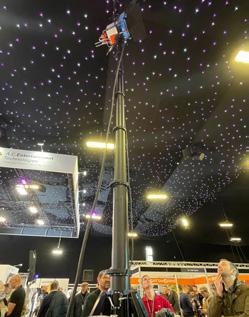
Fiilex, creator of colour LED Fresnels, had a host of fixtures at the Cirro Lite stand, including the Q Series range and P3 Colour. The company manufactures their own LED chips in California that feature a very compact design, to create crisper shadows. www.cirrolite.com

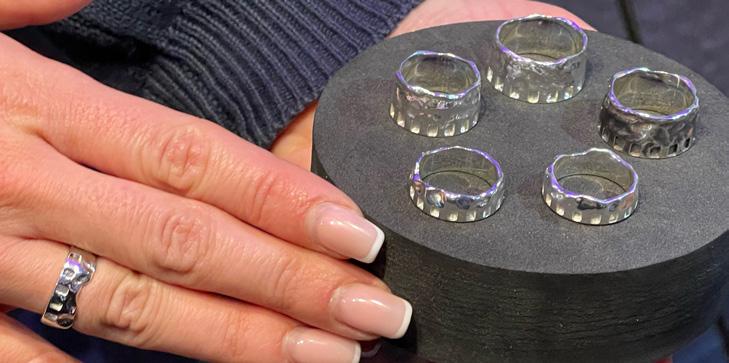
BSC EXPO 2023•ROUND-UP CINEMATOGRAPHY WORLD MARCH 2023 41
COOKE OPTICS

Cooke Optics had a busy stand with many visitors exploring the look of the Varotal FF Zoom range. Having recently added the 1940mm wide zoom, the Varotal/i FF series offers focal length coverage from 19mm to 215mm, giving cinematographers huge flexibility from three zoom lenses. Matched to the S7/i FF and S8/i FF, Varotal can augment Cooke primes as part of a lens system, achieving the beautiful, classical skin tones that characterise the legendary Cooke Look. The Varotal/i FF offers a completely new design, total absence of breathing, chromatic aberration and distortion.
Supporting the Varotal/i FF were the S8/i FF, a complete range of perfectlymatched high-speed (T1.4) full frame cine lenses and the flagship of the Cooke prime lens series. Both the Varotal/i FF and S8/i FF were featured with respective demo films, proving their optical ability and classic Cooke Look at the BSC show this year.

www.cookeoptics.com
CVP
The mezzanine was once again occupied by CVP. Its ever-popular lens bar was back, as was its fully-equipped camera range – offering the only place at the Expo to be able to evaluate virtually every high-end cinematography camera and lens combination that could be thought of.


Virtual production was one of the hot topics at the show, and CVP had a full virtual production studio set-up at one end of its section at the show. The combination of camera and tracking systems, to the whole LED ‘volume’ as it has been dubbed, and onto the software and processors that make it work, was demonstrated and made comprehensible to all.
CVP has also created a finance company, CVF, to expressly cater to the needs of productions and freelancers. Headed by Rebecca Price to offer tailored solutions, CVF benefits from the knowledge and experience of CVP run by a team with specific experience in finance.
www.cvp.com
DEDO WEIGERT / DEDOLIGHT
At the Dedo Weigert stand, the full Lightstream system was cleverly rigged with a multitude of reflectors and fixtures. A new and unreleased 2.5K parallel beam lamp was on-show, providing considerably more output than its trusty predecessor, the PB70.

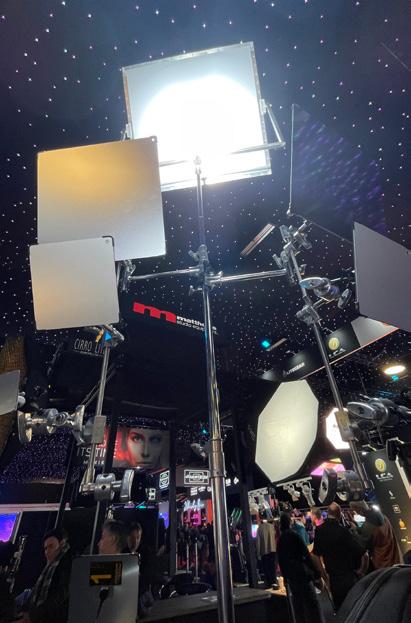
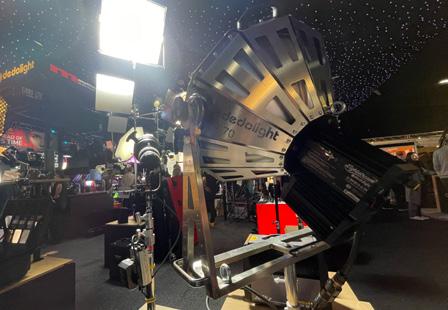
In the reflector range, the Lightstream, Lightstream Table Top and Lite system create a multitude of creative lighting possibilities for a range of productions. The Lightstream reflector range can be used in combination with Prolycht multicolour lights, fitted with Dedolight optics, to create realistic foreground lighting on a subject in front of an LED wall.
This collaboration between Prolycht and Dedolight emphasises the idea of infinity lighting, where reflected light greatly reduces the amount of fall-off.
Prolycht and Dedolight’s collaboration has also resulted in the birth of the new Dedo Neo Colour, a full spectrum LED RGBACL focusing lamp showing at the BSC Expo. www.dedolight.de
DESISTI LIGHTING
Rome-based lighting company, DeSisti, presented its Muses Of Light, a collection of visually-striking bi-colour LED lamps. This family of LED’s were designed in collaboration with renowned cinematographer Vittorio Storaro and DeSisti.
Notably, the final LED fixture in the series is the Aurea (The Circle), is an incredibly powerful 2,400W LED lamp that features a narrow beam angle of 11 degrees. The combination of power and a narrow beam makes it the perfect fixture to use with mirrors and reflectors. The pleasing aesthetic of the lamp meant it was also used as both a decorative and utility fixture in the Fendi Fall Winter 2023/2024 show.
Alongside the Muses, DeSisti’s Vari-White + Colour LED fresnel range and soft lights were at the show, featuring their impressive phosphor technology to produce a brighter LED fixture. www.desisti.it

DRIVING PLATES
The company provides stock background plate footage, but can also integrate with a main unit and stunt drivers to create bespoke footage. Camera arrays can vary, but multiple RED cameras can positioned on the bonnet, the boot and sideways, shooting at 45-degrees, overlapping by 30%, and in a near-nodal arrangement to minimise stitching errors. An up angled reflection shot is also taken. The footage is stitched together to create the reality background. Actors can see the road ahead via a monitor, and can react to the road turns ahead. On most shoots a rental car is hired, and the gear is designed to travel almost anywhere in the world. All images can be viewed inside the vehicle and will record simultaneously. The footage is optically-stabilised and delivered in 4K or 1080 as 9 x QuickTime files. www.drivingplates.co.uk www.drivingplates.com
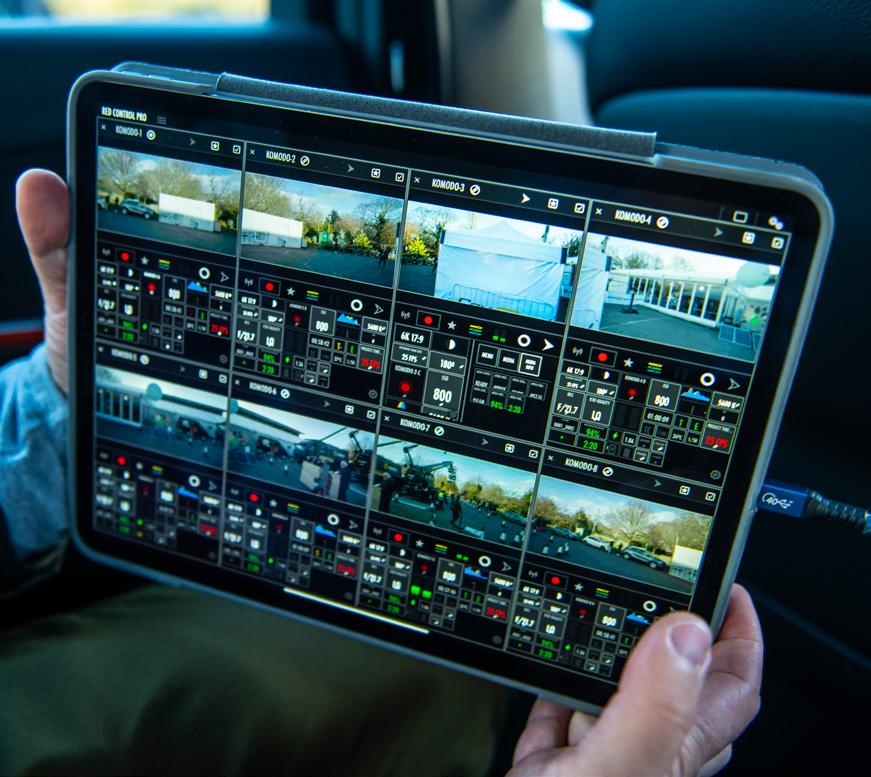
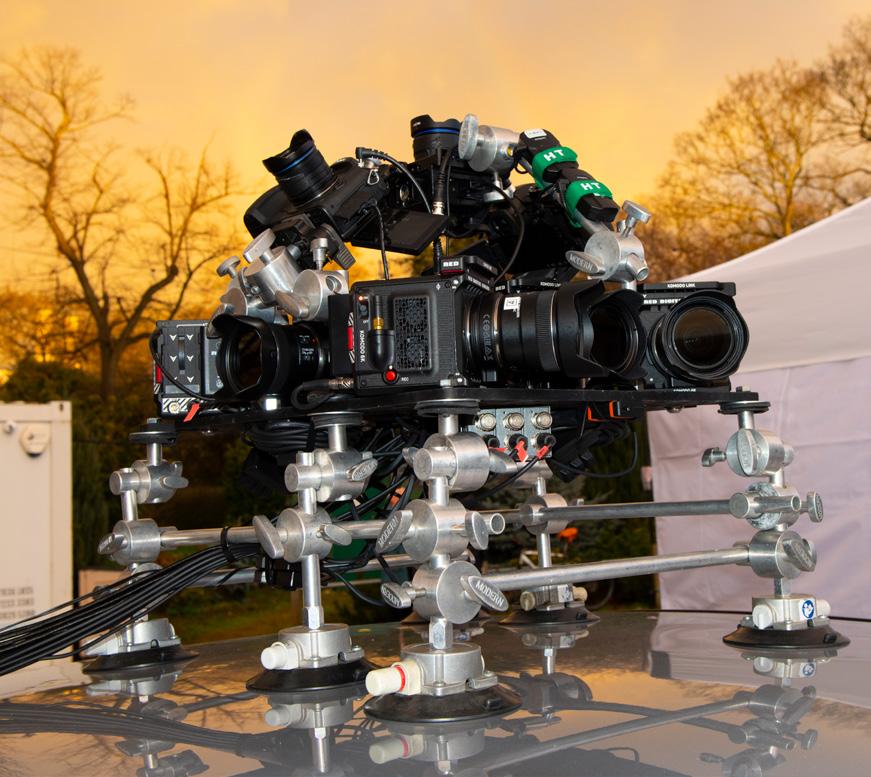
42 MARCH 2023 CINEMATOGRAPHY WORLD ROUND-UP•BSC EXPO 2023
FUJIFILM
The HZK 25-1000mm F2.8-F5.0, a large TV-style box zoom lens was something that caught the eye. This lens is designed to be used on S35 cameras with a PL Mount, helping to create a cine look at long range. With an impressive
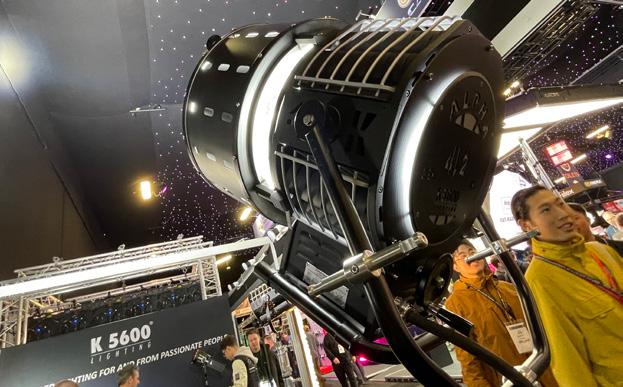

K5600 LIGHTING
K5600 Lighting, a company that is renowned for focussing on high-quality, bi-colour LED and HMI units, presented its popular Alpha LED and HMI lamps. This included the Alpha LED 300 and Alpha 2.5K/4K HMI, equipped with the new Spacebeam adapter.
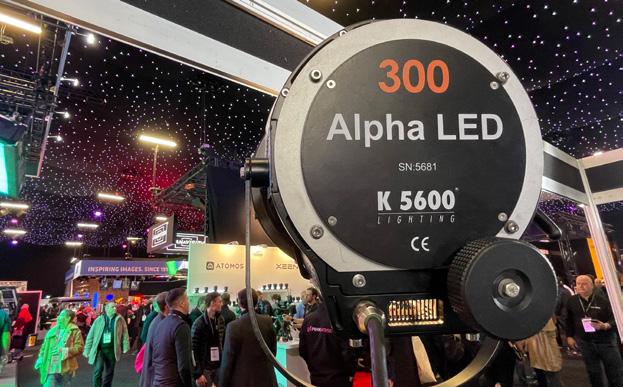
A more recent addition to K5600’s arsenal is the exciting Moduloo Ex battery, a product of the recent
zoom and aperture range it is rather unique. There was only this one in the country at show time, and it was recently used on the USA Superbowl. Also on show were the popular Premista lenses for large format sensors.
In terms of stills cameras there was a huge variety, up to the GFX100S 102 Mp camera.
Plus the X-H2S open gate 6.2K ultra-low rolling shutter and the 8K capable X-H2 www.fujifilm.com
GRIP FACTORY MUNICH
GFM had a jolly old time entertaining. On show was the GF-Mod Jib, whioch allows for a jib set-up in different lengths. The 150cm, 120cm and 50cm modules can be connected through a dovetail system enabling a reach between 80 cm to 400 cm. The GF-Tube Dolly features a centre plate with four removable skateboard wheels, a 3/8” hole pattern and underslung adapter. Existing GFM adapters Mitchell plates or Bowl mounts are available.
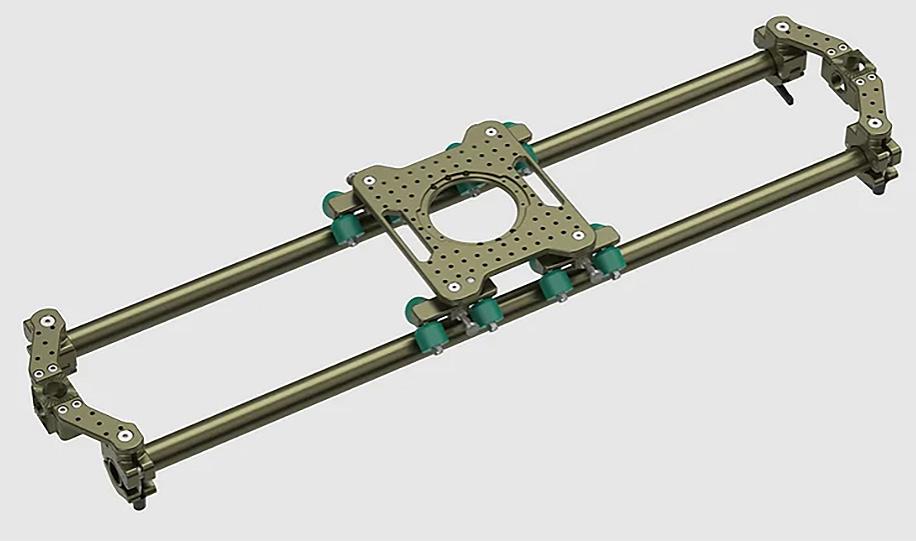
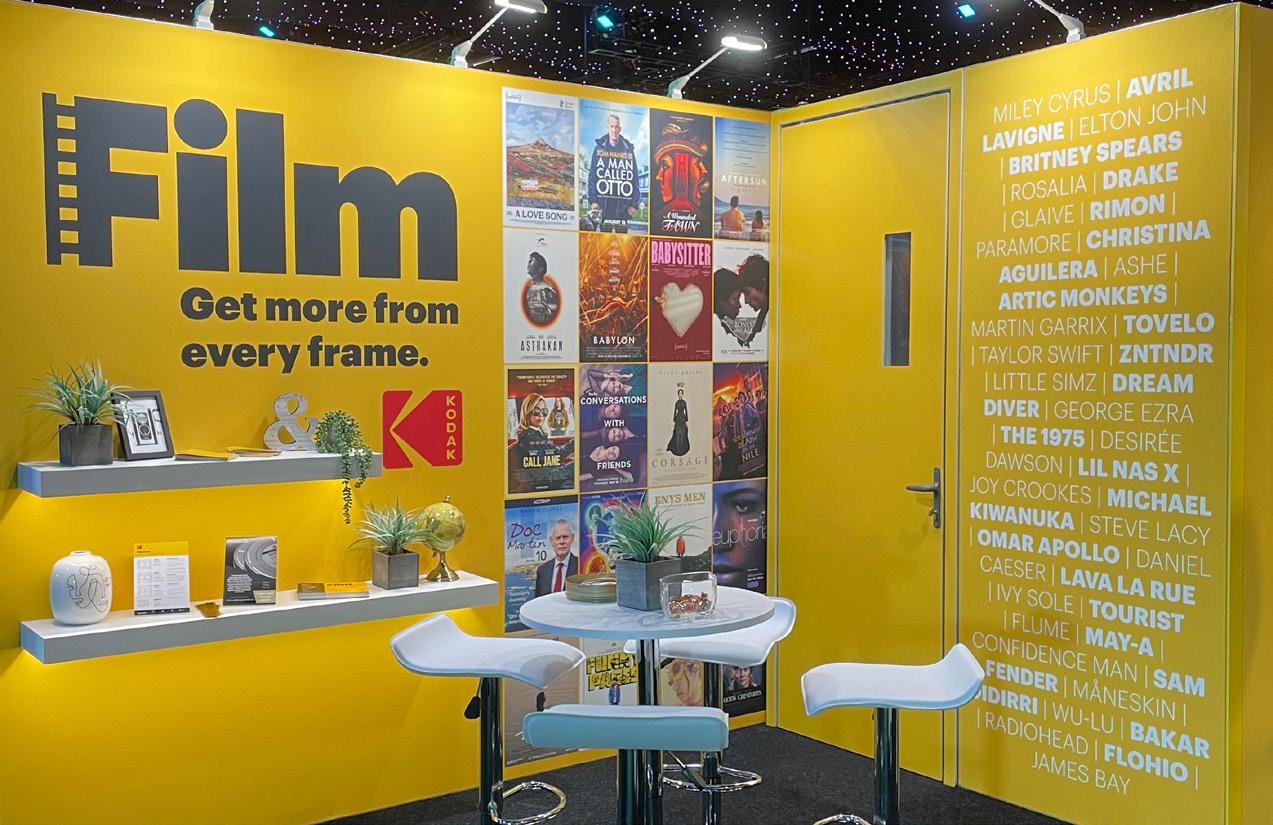
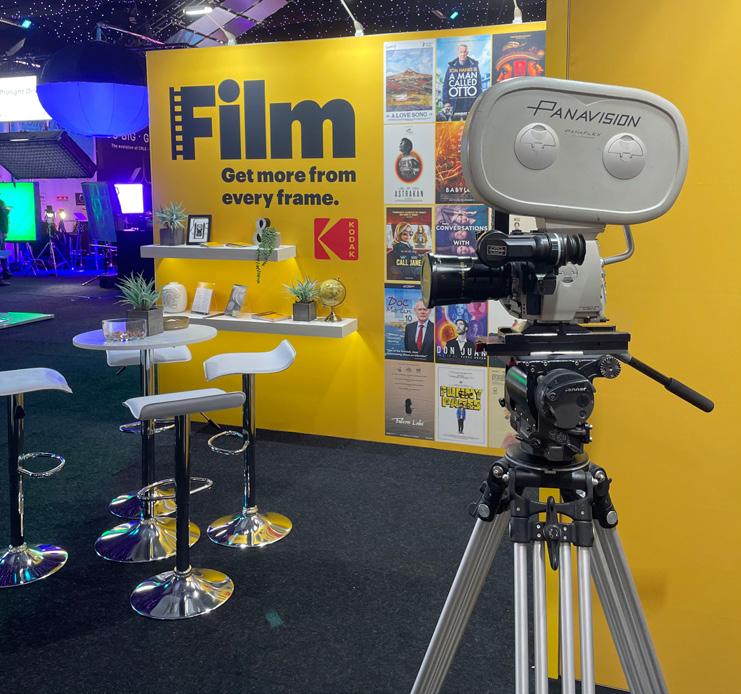
The GF-Turtle Base in three and four leg options are the grip’s Swiss army knives. www.gripfactory.com
GREEN VOLTAGE
Sustainability is now a key factor in film production. Big diesel generators are the most visible (and audible) culprits in pollution on-location. Green Voltage are pioneers in batterypowered generators and they had two highly-portable models at the show. Company director, Adam Baker, said, “We’re primarily a rental house only stocking batteries to help people see better ways of using batteries. They’re a silent power-source, giving the opportunity to get power closer to set, as well as into places where a traditional generator couldn’t go –such as an underground car park, hotel bedroom, a bus or even strapped to the roof of a car!”

Offering clean and silent power their generators are small and easily transported. The company had a mobile unit and trailer-mounted version with solar charging on display. Adam also said, “We’re investing in larger units so we can supply a larger scale, further reducing productions carbon footprint and emissions.” www.greenvoltage.co.uk
partnership between K5600 and TYVA Energie. The battery range has been out since January and features three sustainable, portable energy stations: the PowerCase E2 (3 kW), PowerBox E5 (5 kW) and PowerBox E11 (10 kW). Powered by TYVA Energie’s lithium batteries, these energy stations are silent, waterproof, feature a modular design, and allow for battery reconditioning, making them an ecoresponsible solution to power on set. www.k5600.eu
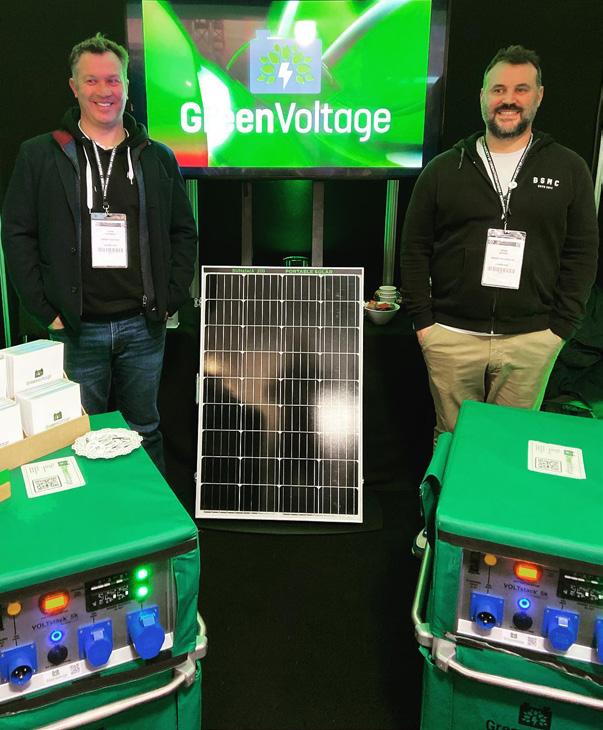
KODAK
With movies such as To Leslie (2023, dir. Michael Morris, DP Larkin Seiple), the upcoming Oppenheimer (dir. Christopher Nolan, DP Hoyte Van Hoytema FSF NSC ASC) and Killers Of The Flower Moon (dir. Martin Scorsese, DP Rodrigo Prieto AMC ASC), all highlighting the continued love for shooting on celluloid, Kodak enjoyed a very healthy and continual stream of visitors to its stand.
From film students to leading DPs, the company’s UK representatives engaged in convivial conversations about the efficiencies and benefits of shooting on analogue film – – using 8mm, 16mm, 35mm and 65mm formats – and the negative processing, scanning and long-term archiving and preservation services available via Kodak Film Lab based at Pinewood Studios. www.kodak.com
CINEMATOGRAPHY WORLD MARCH 2023 43 BSC EXPO 2023•ROUND-UP
LCA
A real eye-catcher at the LCA (Lights Camera Action) stand was Creamsource’s new FrameSync software. With FrameSync, the Vortex8 and Vortex4 can be triggered from an external source, such as a syncgenerator, or the genlock output of a cinema camera, to ensure that it is synchronised with the camera shutter. This is incredibly useful when using effects such as strobe, where a lack of synchronisation between the camera and the lights can cause issues such as frame-tearing and flash-banding.
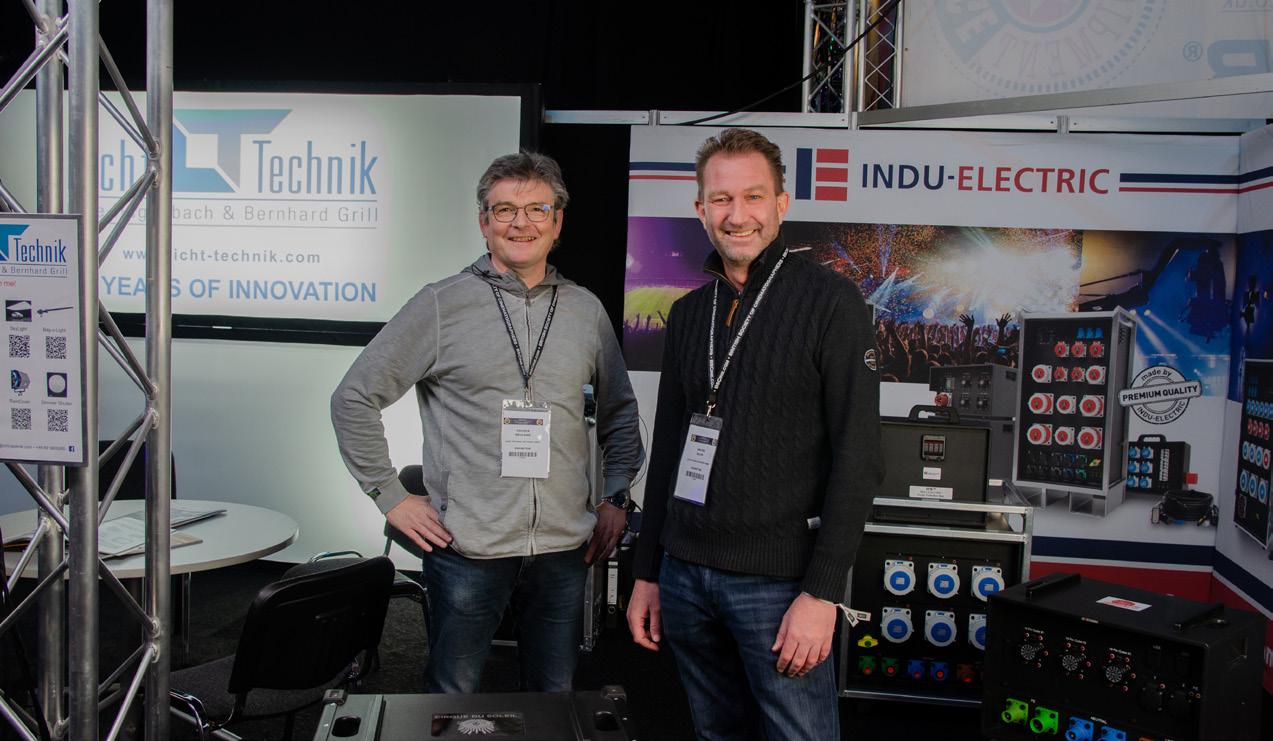
Alongside Creamsource’s technology at the LCA stand, Litegear’s Auroris X and new Auroris V are fullcolour, modular LED light sources. The
Leitz showcased its much-anticipated Hugo cine lenses, which are among the most compact, high-speed optics available for cinematography. Based on the iconic Leica M glass, the lightweight and fast Hugo full-frame lenses feature a production-ready housing with expanded focus and iris scales, an LPL mount, and T1.5 aperture through the set, with the option of an additional 50 mm T1.0 lens. Their character-rich, centre-weighted image is reminiscent of older optics, but with modern coatings and greater reliability.
Also on show were the Elsie lenses, designed from the ground-up as premium cine lenses with full-frame performance and a consistency in size and speed to serve a broad range of productions.

According to regional sales manager EMEA/India, Kevin Parker, Leitz has observed an increasing demand from a broader market for its lenses, as well as its traditional customer base, with DP Henry Braham BSC rumoured to once again be using a combination of Red cameras with Leitz lenses for his next project. Watch this space!
www.leitz-cine.com
LICHT TECHNIK
The most noticeable product from LichtTechnik was its Bag-o-Light’light-diffusor, an inflated diffusor up to 18m long that works with PAR lights and spot lenses. The interior reflective qualities assure even lighting throughout the length of what is effectively a long strip of light. With the light mounted on one of their stirrups you couldn’t miss it as it waved across the aisle.
The company’s new Skylight LED panel and Motoryoke range of motorised stirrups got a lot of attention. They have stirrup models for virtually every kind of light fixture and application, offering fast and silent light support and movement.
3m x 3m Auroris X is ideal for overhead rigs, whilst the newer, 1.5m x 3m Auroris V is perfect for floor-supported lighting setups and smaller overhead rigs.
And finally, standing tall at the LCA stand was DoPChoice’s largest lighting modifier yet. The Fat-Rabbit easily mounts a choice of 8-ft Double-Hex and 6’x5’ Snapbags to large and multiple fixture arrays for ARRI Skypanel 360, Triple/ Double DMG/Rosco MAXI Mix and Vortex 8 to name a few.


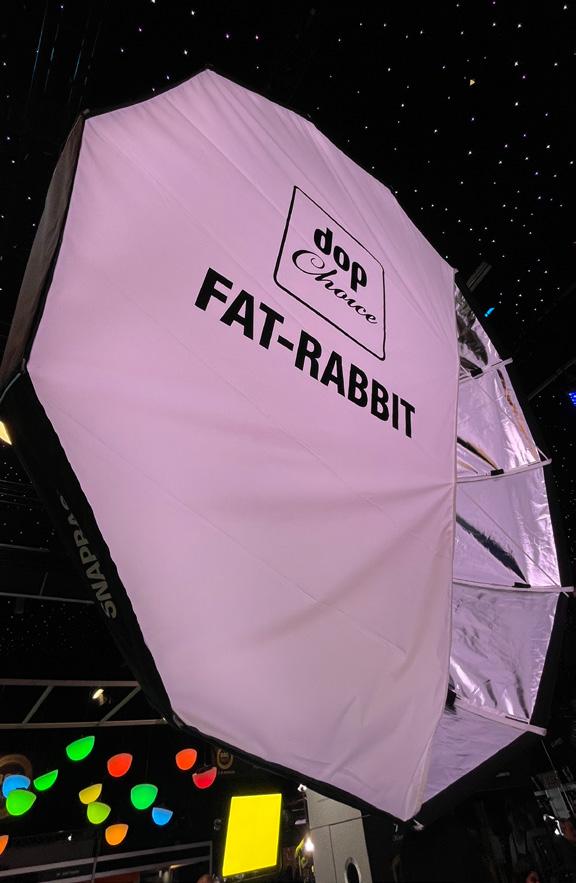

www.lcauk.com
The Skylight comes in a range of sizes and light modules, each DMX dimmable via a controller or PC interface. Licht Technik also produces great common sense lighting accessories, such as the waterproof rigid rain cover for all sizes of the ARRI Skypanel.
www.licht-technik.com

LEITZ
44 MARCH 2023 CINEMATOGRAPHY WORLD ROUND-UP•BSC EXPO 2023
MBSE
MBS Equipment Co are long-time supporters of the BSC Expo and were integral to its smooth operation this year. Under the management of gaffer Terry Lewis, MBSE provided almost 10km of cabling, plus electrical infrastructure, to distribute power to the show. This vital work ensures the quality and longevity of the Expo and is a strong indicator of how extensive MBSE’s resources are.
With bases around the world, MBSE is home to one of the largest equipment inventories, incorporating a vast selection of energy efficient and LED solutions. Recent productions supported by the company, include titles such as: Ant Man And The Wasp: Quantumania, Luther: The Fallen Sun, Star Wars: Andor and Mission Impossible: Dead Reckoning Part One, to name just a few.
MBSi, the MBSE in-house technical branch, is responsible for pioneering new lighting products. These include the Vulcan Automated PAR 18 and the aptly-named AquaBat, full colour waterproof LED baton lights. www.mbseco.uk
MOVIETECH
The veritable camera house was recently incorporated into Sunbelt Rentals UK, and now incorporates camera, lens, grip, lighting, logistics and more. Lighting company PKE and Alphagrip are also included in the group.
Sunbelt has huge resources, so what does it mean going forward?
Well, it’s the ability to expand the amount of new gear that can be bought, offer camera and lighting packages, as well as location services, and collaborate on more projects simultaneously, and to be keenly competitive due to economies of scale.
The expansion means a need to move into new 145,000sq/ft premises in Stockley Park soon.
Movietech’s camera inventory includes 16mm/35mm film cameras, digital ARRI Alexa LF and XT Plus, Sony Venice 1 & 2, plus Rialto and F65, Red DSMC2 Monstro, Helium and Dragon, plus lenses including Atlas Orion, ARRI Signature and Zeiss. www.movietech.co.uk
NANGUANG PHOTO & VIDEO SYSTEMS CO. LTD
Nanlux showcased a range of its trustworthy, powerful LED fixtures. Notably, there was a new projector mount for the Evoke 1200, which enables precise focussing of the powerful LED. Adding to the family is the Evoke 1200B, a bi-colour version of the original Evoke 1200 providing CCT control between 2700K and 6500K, IP54 rating, wired/ wireless DMX options and a whopping 18,570 lux at 3-meters 5600K with a 45-degree reflector attached. Alongside the Evoke was the Dyno series, the 650C and 1200C RGBWW LED soft lights are some of the brightest available.
With Nanlux covering larger-scale productions, Nanlite offers LED fixtures for the prosumer and content-creator audiences. The Forza range was popular at the show this year, with the new 500Bii and 300Bii proving their ability to utilise minimal power draw and provide accurate colour control at a lower cost. www.nglbg.com
P+S TECHNIK
Company MD Gerhard Baier talked us through the latest developments at P+S Technic. First-up was the AproXima range, close-focus versions of the highlyregarded Technovision full format Anamorphics. Previously the close focus distance was 2’ 4”, then a DP asked if they could get closer still, to just 1’ 6”? Gerhard considered it and decided that they could get to that “approximately” – hence the name. Production versions can focus down to 1’ 2” without losing any T-stops, incredible for a full format front Anamorphic lens.
Super 35 remains a fantastic narrative format for visual storytelling. Hence the Evolution range gets a new design, optically the same but with a swathe of mechanical improvements. Likewise with Super 16, P+S have fitted lenses with a Sony e-mount, ideal when partnered with the Sony Venice.
Gerhard enthused about Hasselblad medium-format Zeiss lenses for their heritage and quality, the lenses that went to the moon on the Apollo missions. “There is a ton of resolution there, with contrast and a clear pristine look,” he enthused. So they rehoused, lowered the close-focus distance, and added gears to be able to selectively defocus the image for today’s cameras. Nice work!
www.pstechnik.de
PANAVISION

On the packed Panavision stand, complete with popular whiskey bar, multiple cameras were set-up to showcase a selection of the company’s renowned proprietary lenses for both Super 35 and large-format image acquisition. Cameras included the Panavision Millennium DXL2, Red Komodo, Red V-Raptor, Phantom Flex 4K, ARRI Alexas in many forms, ARRI Amira, Sony F35, Venice and Venice 2.
Evolving from a 2016 presentation by Panavision’s lens expert Dan Sasaki, the company showcased a new and incredibly-helpful characteristics/comparison chart for its Anamorphic and spherical lenses, detailing the optical attributes that distinguish one lens series from another.
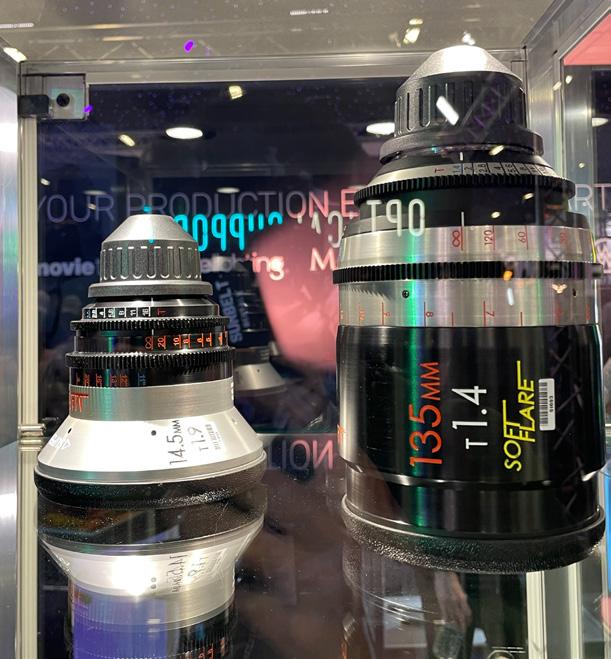
Adam Brown, brand marketing director EMEA, explained that with Panavision’s wide range of proprietary optics covering the gamut from sharp to soft and high contrast to low contrast, these charts make it easier for filmmakers to select lenses whose optical characteristics match their vision for the project.
Also on the stand was Michael Cioni, formerly at LightIron, now with Adobe’s Frame i/o, who has been hard at work on the company’s camera-to-cloud initiative. The impressive demo included cameras from Red and Fujifilm, plus kit from Atomos and Teradek, that have been enabled with Frame i/o’s camera-to-cloud tools. Stay tuned on this one!

Products on display from the Panavision Group also included the latest from Panalux, rental provider of lighting and power solutions for features, series, commercials and live events, including the new Panalux Allegra C range of fullcolour LED heads.
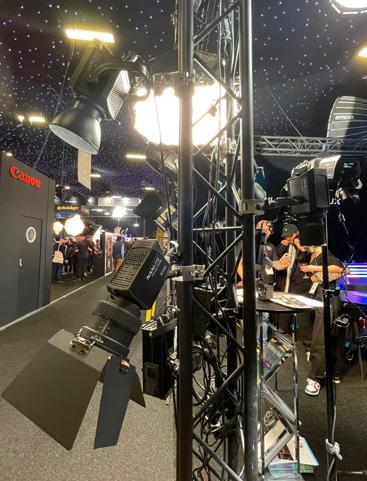
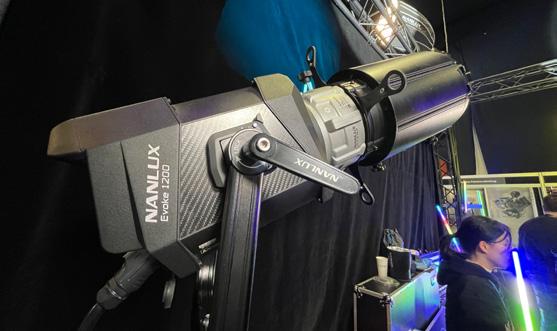
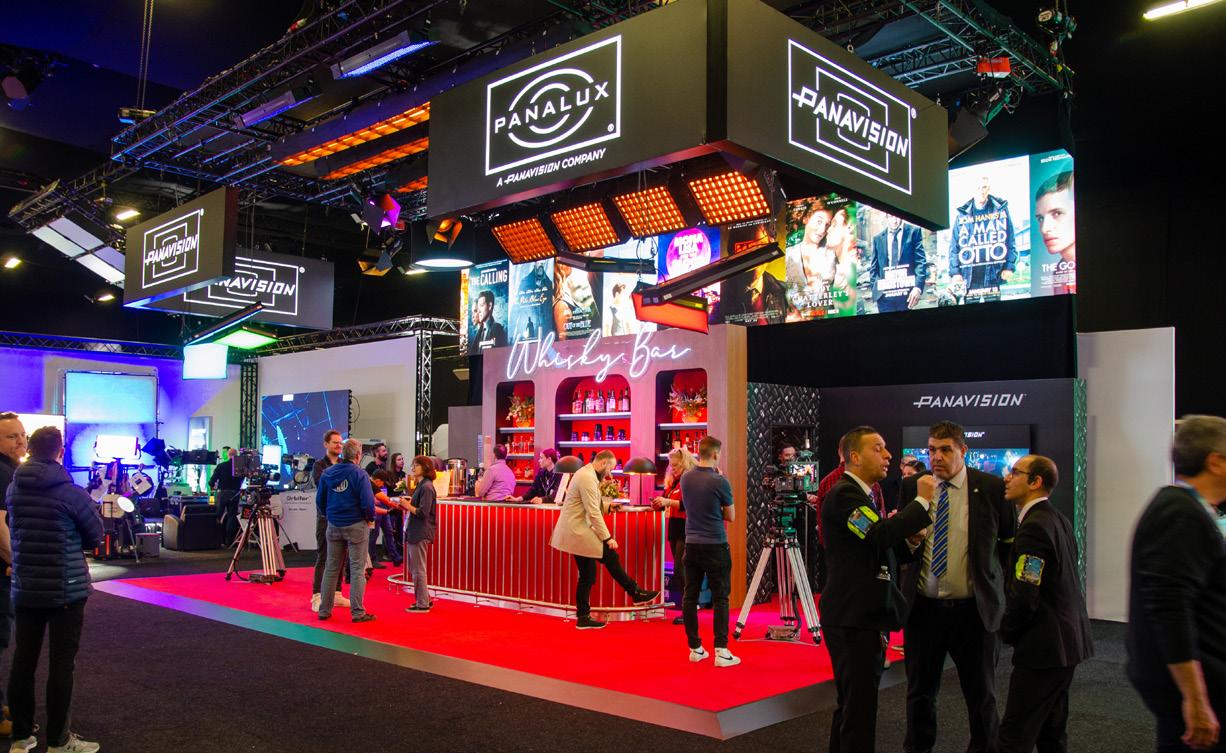
www.panavision.com
www.frame.io
BSC EXPO 2023•ROUND-UP CINEMATOGRAPHY WORLD MARCH 2023 45
ROUND-UP•BSC EXPO 2023
PANALUX
Lighting products, designed/built by the R&D team at Panalux in London, were all being showcased. Several 3x2 Sonaras created a warm backlight overhead, also available in 4x4 and 4x1. Different lightweight Panalux Allegra fixtures were suspended overhead transitioning through intense colours.

RATWORKS ENGINEERING
Ratworks has an enviable reputation for camera-support equipment, with a plethora of handheld kit offerings, plus a raft of accessories for the new ARRI Alexa 35, all designed and made in the UK.

Head honcho Ed Ratcliffe explained how his experience as a loader on-set drove him to design countless items to make life easier on-set, saying, “The business was born from my frustrations basically.”
Rodlight is a Panalux exclusive. A 5.0 X 4 soft inflatable fixture was integrated into stand. These lightweight, rapid-inflatable LED fixtures come in 1.6m, 2.5m and 5m lengths, with 320mm diameter. Using RGBA+WW+CW LEDs creates a spectrum from 2,000K to 20,000K with five colour modes: RGB, HSI, Gel, Effects and X/Y. Control is by DMX, Lumenradio CRMX, RDM, Bluetooth. The 5m (17ft) version weighs just 4.4kgs (9.7lbs). The 600W fixture can be powered by 24V DC or 85264V AC.
Also on show, the notable Velvet Kosmos a 400W motorised glass Fresnel zoom 15° to 56° lens fixture, with control on the lamphead and remote control via the Goya app. Mains or battery powered, and IP30-rated. www.panalux.biz
PANTHER
Christian Heinz, area manager for Panther, expressed happiness at how busy the Expo was this year and talked us through their dollies, cranes, tracks and camera support equipment.

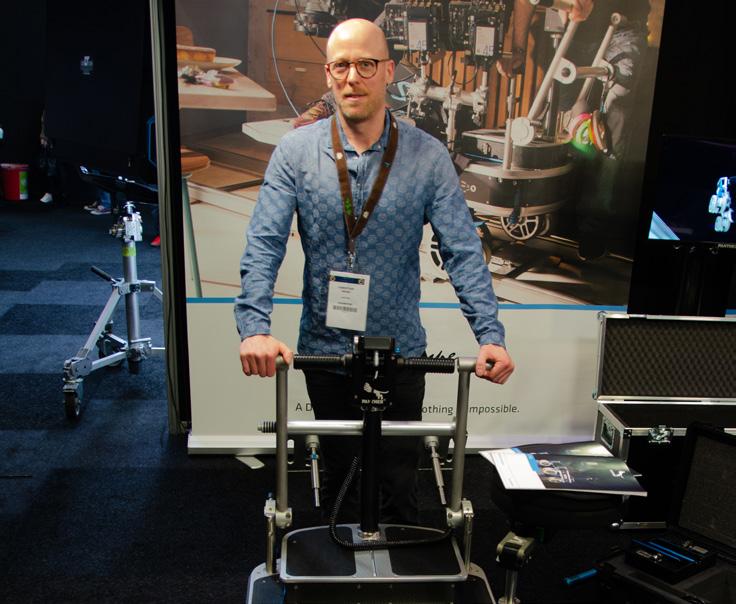
The Panther S Type Dolly Series 3, comes with a faster arm than previous models and even less vibration. A battery-run system, rather than hydraulics, offers programmable movement, and all-day operation without recharging. The arm can go below horizontal avoiding the need for a separate high-low rig. The arm can be removed making the whole unit highly portable.
The EasyRider electric rickshaw dolly is a trike with the ability to mount the camera fore and aft, or with a remote head, and, of course, with an operator sitting facing backwards. The multi-way suspension ensures a smooth and comfortable ride for the camera operator. The trike also accelerates quickly and silently. www.panther.tv
PIXIPIXEL
London-based camera, grip and lighting rental company, Pixipixel, showcased its latest additions in lighting, grip and camera, including Mamiya Sekor 645 lenses and other new optical products. The carbon-neutral company also introduced its new Optix lens, designed and engineered in-house by camera technical director, Renos Louka.]
The Optix Extreme lens covers full frame and features modified and enhanced optics producing a unique wide-angle view with 17mm focal length, 2.8 T-stop and minimum focus of 11 inches.
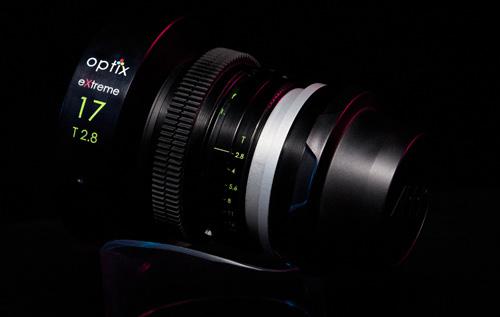
The company’s Mechanix range was also on display , ncluding the Rotating Magliner Moy Mount, Rotating Camera Mount, and Dual Monitor Trolley. Marketing manager Kristina Mladenova commented, “We had a very busy couple of days, with many visitors and a very good reception to the new lens.” www.pixipixel.com
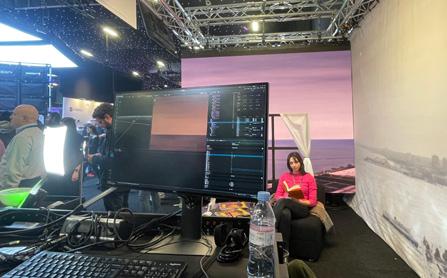
Being able to handle these kind of products shows the company’s attention to detail, each item built to levels of quality that match and often exceed to original equipment of the cameras that they complement. The range of hand grips in particular stand out as they are engineered for a hard life, whilst putting the ergonomic requirements of the operator at the forefront. Durability allied with all-day convenience and comfort are integral to everything Ratworks produces. www.ratworksengineering.com
RED DIGITAL CINEMA
Red had the new V-Raptor 8K S35 on display. A limited edition is available in grey with the Wildlife Society Of Filmmakers logo. The 8K 120fps capable camera has the same body and accessories as the V-Raptor VV, with a smaller sensor than DSMC2 Helium. This means users can use the Canon 501000mm lens for wildlife and shoot full 8K, was well as vintage S35 lenses. Another eyecatcher was the Monochrome Ranger Monstro, used to shoot B&W images on Mank, Emancipation and The Sparks Brothers. Technically it gived a far higher definition image than a colour digital camera as the pixels in the sensor records light levels, not a combination of three RGB pixels.
The new RF-PL Mount with metadata passthrough is made of a titanium core and supports Cooke /i lens communication and record triggering. Red Connect allows for 8K RAW Streaming and Real-time offload / edit. www.red.com
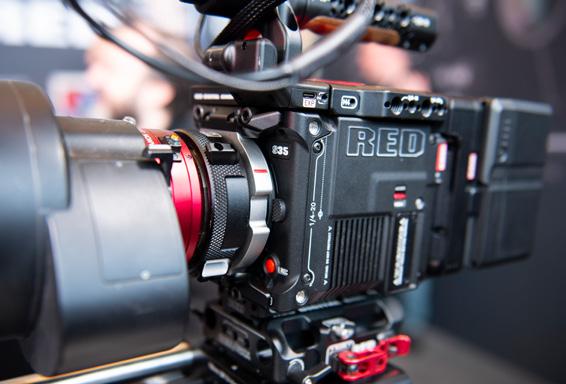
ROSCO LABORATORIES
In Rosco’s growing DMG Lighting arsenal, the DMG Dash and DMG Mazi were extremely popular at the show. The DMG Dash is a pocket-sized, 500 lumen softlight, that provides full-spectrum colour rendering thanks to Rosco’s patented six-chip Mix technology. This enables it to produce the same colour quality and True Rosco Colour gel matches that the other Mix lights do. Multiple DMG Dash units can be assembled together using the DMG Dash Link to create brighter sources, with a four-light array presented at the show.
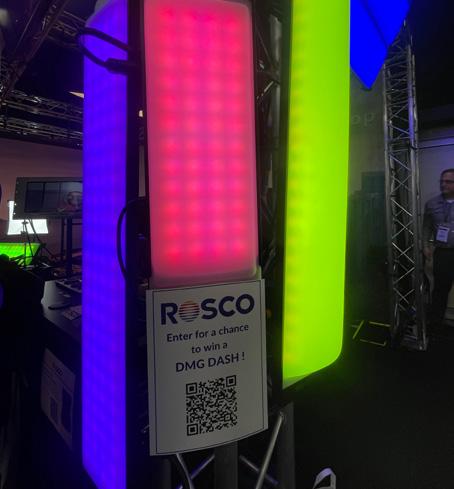
In the world of special effects, Rosco’s aptly-named X-Effects LED projector system

was throwing patterns on a Rosco SoftDrop. This system is able to maintain 100+ lumens at over 65ft and can achieve a variety of lighting effects by changing gobos or adding colour into different mechanical positions. Rosco covers both the analogue and digital worlds, now creating digital backdrops for film and broadcast television.
www.rosco.com
46 MARCH 2023 CINEMATOGRAPHY WORLD
ROTOLIGHT
Rotolight has taken its Neo 3 compact light and its Aeos 2 mid-range light and expanded them with two new pro models which add additional power, additional triggering for photography studio users, as well as ‘master of lights’ presets from a number of famous names in cinematography – giving users access to signature lighting looks and some additional special effects as well.
SUNBELT RENTALS
The UK’s largest equipment rental provider, Sunbelt, bought Movietech, PKE Lighting, Alpha Grip and Media Access Solutions in the last year. This branching-out, into various departments of film and television production, has strengthened the company, offering clients an integrated, full-service production solution. This was preceded by Sunbelt’s acquisition of William F. White International in 2019.
As an environmentally-conscious company, Sunbelt has invested £135 Million in the last 18 months in sustainable energy solutions. Sunbelt’s stand at the BSC Expo was decorated with a vast array of camera bodies, lenses and lighting fixtures, including the new Alexa 35, Sony Venice, Hawk zooms and ARRI Skypanels to name a few. www.sunbeltrentals.co.uk/sectors/film-tv/
TIFFEN
The expanded ranges mean that customers can now access the products at different price points and with different feature sets. Business development manager Tim Haskell told us Rotolight had enjoyed very positive reception the show.




“We’ve been showing the new lights to DPs and production companies for the first time here, many of whom are looking for small run and gun lights or medium but really lightweight portable kits,” he said. “We’ve worked long and hard to make a really intuitive touchscreen interface, meaning they are very user-friendly and everyone who touches and tries them immediately ‘gets’ them.” www.rotolight.com
SONY
Sony showcased its range of filmmaking technology, from image and audio capture, to on-set and post-production monitoring, through to virtual production solutions.
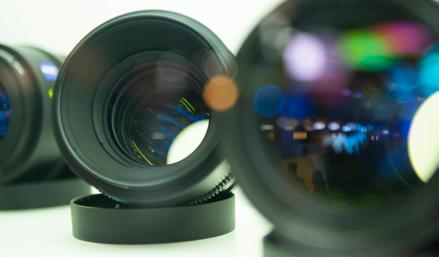

With Sony shortly opening a virtual production training facility at its Digital Motion Picture Centre (DMCP) at Pinewood, the Venice 2 camera was seen working in harmony with Sony Crystal LED panels as part of a complete virtual production system. Specifically-developed for virtual production, these Sony Crystal LED panels offer exceptional colours, resolution and a pixel density far superior to conventional LED array systems.
Sony’s business development and DMPC manager, Will Newman, explained, “Low-resolution backdrops are a sizeable problem when shooting in a volume, especially on smaller screens, since the larger the pixel pitch the further away your subjects must be. For example, working with a 2.5mm pixel pitch or even higher means the camera is optimally placed minimum eight metres away but with Sony Crystal LEDs having a of pixel pitch of just 1.2mm this distance can be halved.”
In addition, Sony showcased the FR7, the world’s first full frame interchangeable lens PTZ Camera, as well as the PXW-FX9 v3.0 in Anamorphic mode, the popular FX6, the compact FX3 and FX30 plus a selection of Alpha lenses to try out. www.sonycine.com
SUMOLIGHT
A blazing wall of colour at the Sumolight stand, the SumoSky is an interactive lighting system. It features an expandable 160W, per unit, LED wall with reduced rigging time compared to other LED solutions. The system is highly-customisable, for both vertical and horizontal use. It supports pixel mapping, RBGWW, 16-bit colour and a smooth background for keying. It can be built up to a massive 100 meters wide and more that 15 meters high. The building time is so fast that the SumoSky riggers were out of the BSC Expo by 5pm the same day!

Sumolight were offering the ability to use the SumoSky as a greenscreen tool at the show, with it being possible to move the greenscreen around during action. Also at the stand was the modular SumoMax, a high output RGBWW lamp with a clever hexagonal, modular design. www.sumolight.com
The highlights included Warm Diffusion filters: Antique Black Pearlescent, Antique Pearlescent and Antique Satin, along with Black Fog and Night Fog diffusion. Black Fog combines a Black Pro-Mist with Fogs. Night Fog combines Fog with proprietary new Dark Con, a light control technology to darken light areas and leaving shadows alone.
Professional ND filters for popular drones include DJI Avata, Mini 3, Mini 3 Pro, Mavic 3, Mavic 3 Classic, Air 2S, FPV, Inspire line, Pro.
The Steadimate RS for Ronin RS2, RS3, or RS3 Pro converts the handheld motorised gimbal to a full-body worn stabiliser. The addition of an arm allows Steadicam type moves.

The classic Lowel Tota light has been upgraded to the Tota LED XL. A daylight-balanced LED panel floodlight, with innovative foldable design, it has 216 individual LEDs on the 8” x 8” panel, and produces a 60° beam at 5600°K ±200°K, with 98 TLCI and 96 CRI. www.tiffen.com
VIVENDUM
Anton Bauer showed the VCLX NM2 600Wh NiMH block battery. With advanced battery management, the 2.4” colour LCD screen displays the remaining runtime, charge time or active power draw and internal “smart logging” of over 40 potential errors. Two XLR4 ports (24A at 14.4V) and one XLR3 (16A at 28V or 12A at 48V) means high-current fixtures can be powered. There is also a USB-A output.
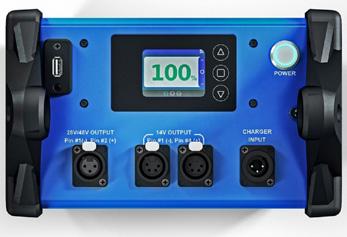
The blue anodised aluminium case has moulded end caps and handle grip. Operating temperatures between -20C to +60C. Approx. dimensions are 10 x 13 x 6 inches (255 x330 x153mm). Weight 13.3kg. NiMH battery chemistry means it is safe to fly.
Quasar Science’s Double Rainbow (RR) is a linear LED with two rows of high fidelity RGBX pixels producing vibrant, saturated colours and an intense white light. Available in 2ft and 4ft lengths. Rainbow 2 is a tuneable white-light fixture and the highest RGB colour saturation, incorporating multiple pixels that enables smooth flicker free dimming. Supplied in 2ft, 4ft and 8ft lengths.
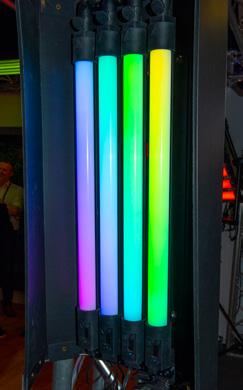
OConnor’s Ultimate 1040 Fluid head delivers ultra-smooth pan and tilt fluid drag. It works together with OConnor’s Sinusoidal Counterbalance system for accurate balance at any point in the tilt range, no matter the payload. www.videndum.com
ZEISS
Supreme Prime Radiance lenses are available in eleven focal lengths – from 18 mm to 135 mm – all with a T1.5 maximum aperture. The small front diameter of 95mm is on all lenses, apart from the 18mm and 135mm. Positioning of the focus and iris rings means consistent coverage, aperture, size, weight and ergonomics. All the lenses across the family cover sensors from Super 35 and smaller to full frame and beyond (FF+).
Supreme Primes are available in 14 focal lengths, all T1.5 unless stated. 15mm T1.8, 18 mm, 21 mm, 25 mm, 29 mm, 35 mm, 40 mm, 50 mm, 65 mm, 85 mm, 100 mm,135 mm, 150mm T1.8 and 200mm T2.2
Compact Prime CP.3 and CP.3 XD lenses are ten lenses to cover from 15mm T2.9 to 135mm T2.1. The Cinema Zoom lenses range from 15-30mm, 28-80mm, and 70-200mm, all T2.9. There is no visible breathing in-use, with round out-offocus highlights ready for 8K and beyond.
www.zeiss.com
BSC EXPO 2023•ROUND-UP CINEMATOGRAPHY WORLD MARCH 2023 47
TALKING S H O P
By David Wood
This year’s BSC Expo seminar programme was nothing if not well-attended. Hundreds crowded into the seminar theatre at Battersea Evolution, London, to hear an eclectic range of debates and discussions relevant to contemporary filmmaking.

Top of the agenda was ARRI Solutions’ deep dive into the world of virtual production, with senior figures in virtual production pointing to some of the major themes in what is a rapidly evolving world.
Good communications are key to successful VP shoots, according to VP supervisor Stacia Pfeiffer, who stressed, “It’s important to have all the heads of department involved in communications.”
Creative Technology’s director of innovation, Will Case, added, “Collaboration is the magic word. The technologists have to be further-up the chain to talk to the DP.”
Pfeiffer added that the biggest issues in virtual production occurred with production companies making their first forays into the technology. “Companies expect the speed of pre-production to be the same as usual, but you have to be prepared for the fact that it will take more time. Most of the VFX work, typically done in post, now has to be done in pre-production,” she emphasised.
Similar issues surfaced during a session on the impact of virtual production (VP) on film lighting, where DP Balasz Bolygo BSC declared: “VP is about the gaming world colliding with the film world, and ironingout the communication between those two worlds takes time.”
DP David Procter, who worked using VP sets on the Joe Connor-directed, Ellie Goulding pop promo, ‘Like A Saviour’, said that he could see the role of a virtual gaffer specialising in lighting virtual environments evolving to co-ordinate the work of the Unreal Engine artists and the lighting team.
“On the pre-light for the Ellie Goulding promo we couldn’t see that the Unreal 3D artists were trying to match our colours at the same time as we were trying to match theirs. We were chasing our tails on that one.”
Some misconceptions remain, declared Bolygo. “There is, for example, the misconception that virtual production doesn’t need real lighting sources, but in reality you are always looking for LED or interactive sources that can tidy-up skin tones.”
Virtual sets weren’t the only technical innovations under discussion at BSC Expo. Cinematography World editor-in-chief Ron Prince led a discussion with Cinelab’s Film & Digital department on the art of adding celluloid looks to digitally-originated productions.

Cinelab’s DFD analogue intermediate process –transferring digitally-captured footage to film, and then processing and scanning back to digital, with an authentic film look applied – has been used recently on films such as The Wonder (2021, DP Ari Wegner ACS ASC). It was also used on BBC Films’ forthcoming surfer movie, Silent Roar, shot by DP Ruben Woodin Dechamps, to help Red Komodo footage bed-
Williams, releasing later this year. Wilson added, “Shooting in 4K, the DFD process adds texture to the detail, and it helps blend the images nicely together and gives an interesting look.”
Creative aspects of visual storytelling also came under the spotlight in a Red-sponsored talk with Frozen Planet II producer Yoland Bosiger and underwater cameraman Hugh Miller, who told us how the latest technology had influenced the most recent blue-chip BBC Natural History Unit series.
Bosiger singled out the use of drones, as a good example. “Thermal drones allowed us to film nighthunting, plus we used a high-speed racer drone for the first time to shoot an avalanche in the Rockies.”
in nicely with 16mm film.
Cinelab’s Adrian Bull explained that, “Over last ten years a lot of talk has been about dynamic range and resolution in the digital image. What we get out of film with the DFD process is just about the grain and texture of film, but a range of more nuanced characteristics such as flares and instability that bring a great aesthetic to the picture.”
Cinematographer Erik Alexander Wilson BSC, who shot the award-winning Landscapers with DIT and dailies from Cinelab, used the DFD process on Better Man, a big-budget, VFX-laden biopic about Robbie
For Miller the advance which has opened-up new possibilities is not a camera technique but the use of bubble-free rebreather diving technology. “We were able to go back and shoot sequences underwater that we always wanted to do, but couldn’t. We’ve always wanted to film Weddell seals under the ice, but normal scuba apparatus releases bubbles, which are a seal threat display. Rebreather technology allows us to be quiet under the ice and not disturb wildlife,” he revealed.
Tricks of the trade adopted by TV drama came under the spotlight in with a panel of DPs including Gavin Finney BSC (Good Omens, The Undeclared War), Ed Moore BSC (Hijack, Somewhere Boy), Laurie Rose BSC (Peaky Blinders) and Vanessa Whyte (Ted Lasso, All Creatures Great And Small ).
Ed Moore stated, “A gigantic part of our job is getting the best out of the team. My advice is don’t rock the boat for the sake of doing so. People will do
48 MARCH 2023 CINEMATOGRAPHY WORLD SEMINARS•BSC EXPO 2023
You have to be prepared for the fact that pre-production on virtual production will take more time
Photos: courtesy of John Daly BSC.
Image from The Wonder, courtesy of Netflix.
better work if you allow them to contribute and be creative.”
“Don’t spend too much time trying to curate your career when you are young and less experienced,” advised Rose.
“Take all the jobs offered at the beginning, because all experience is worth something. Even if it’s to confirm what you don’t want to do.” For Vanessa Whyte the whole job boiled down to, “How you present yourself in interviews and how you present yourself onset.”
In interviews, striking the right balance between presenting a prepared vision for a show’s visual look and being prepared to listen is important.

“Don’t go in and present your vision when it’s not what the producer wants,” she added.
“You have to be prepared to pick-up on what the director or the producer want. It might be different to how you see it and, if you don’t recognise that, it can mean you don’t get the job.”
Do be prepared to spend more on things like lighting if it will save you time, advised Gavin Finney. “The most expensive thing of all is time. You might ask for double the amount of gear, so
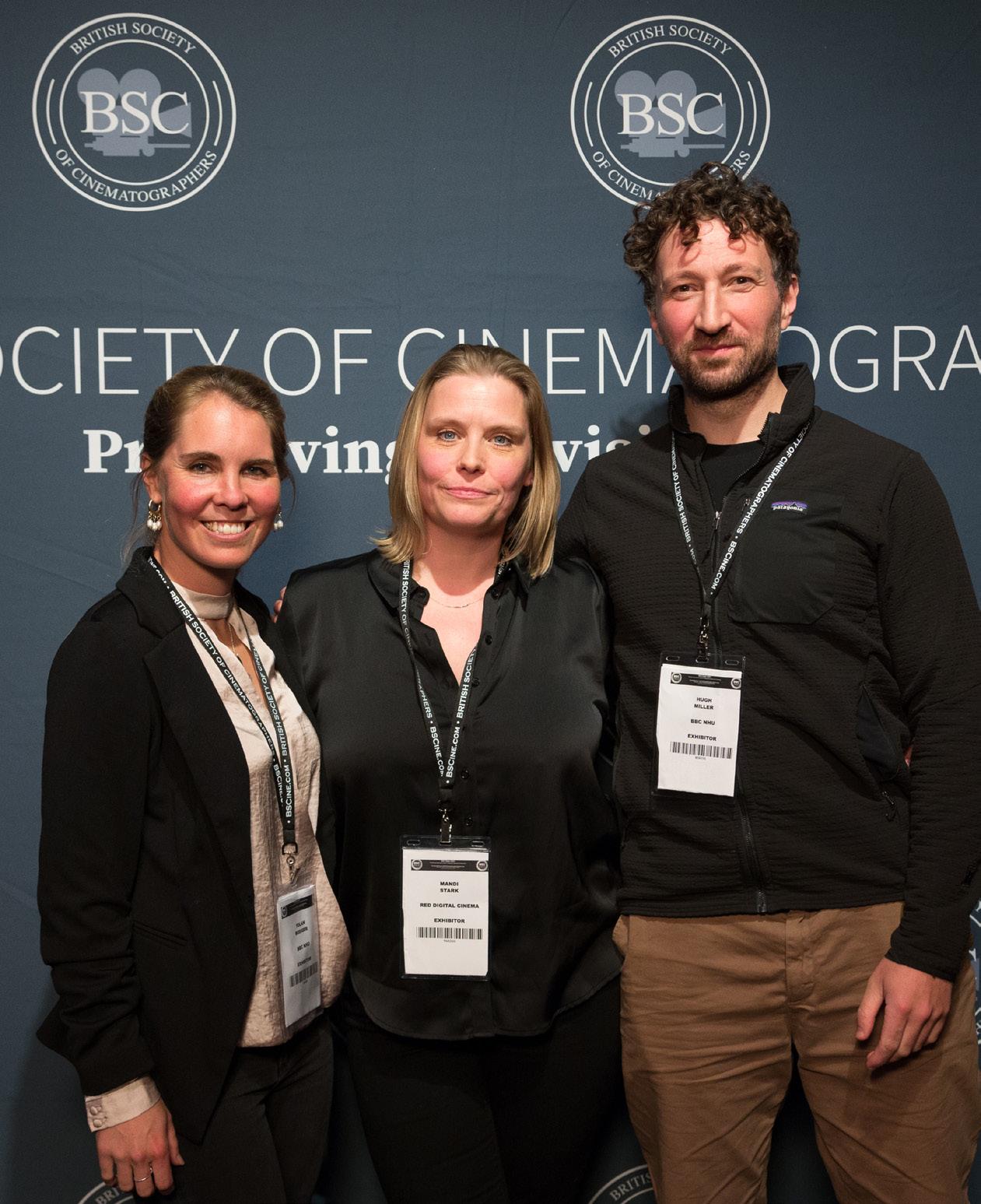
that both ends of the street are lit at the same time, so you don’t have to wait to switch them around.”
Last, but not least, Ben Davis BSC’s session on shooting the award-winning The Banshees Of Inisherin He explained how, during the initial scouts to find locations in 2020, he, McDonagh, production designer Mark Tildesley and 1st AD Peter Kohn, were quarantined for ten days together in a house on the Galway Coast –the best part of year before production actually began.

“It’s incredible there, and I was seduced by the natural beauty of the coast and the seascapes. We shot through August, September and October 2021, with our cast and crew quarantined, which meant production was kept really small.
“The reality is that the bigger a film gets, the harder it becomes to make. I always want to keep films small and controllable –which never seems to happen. But on this film it did. We were a tight knit group in a an enchanting location, and it was one of the best productions I have ever worked on.”
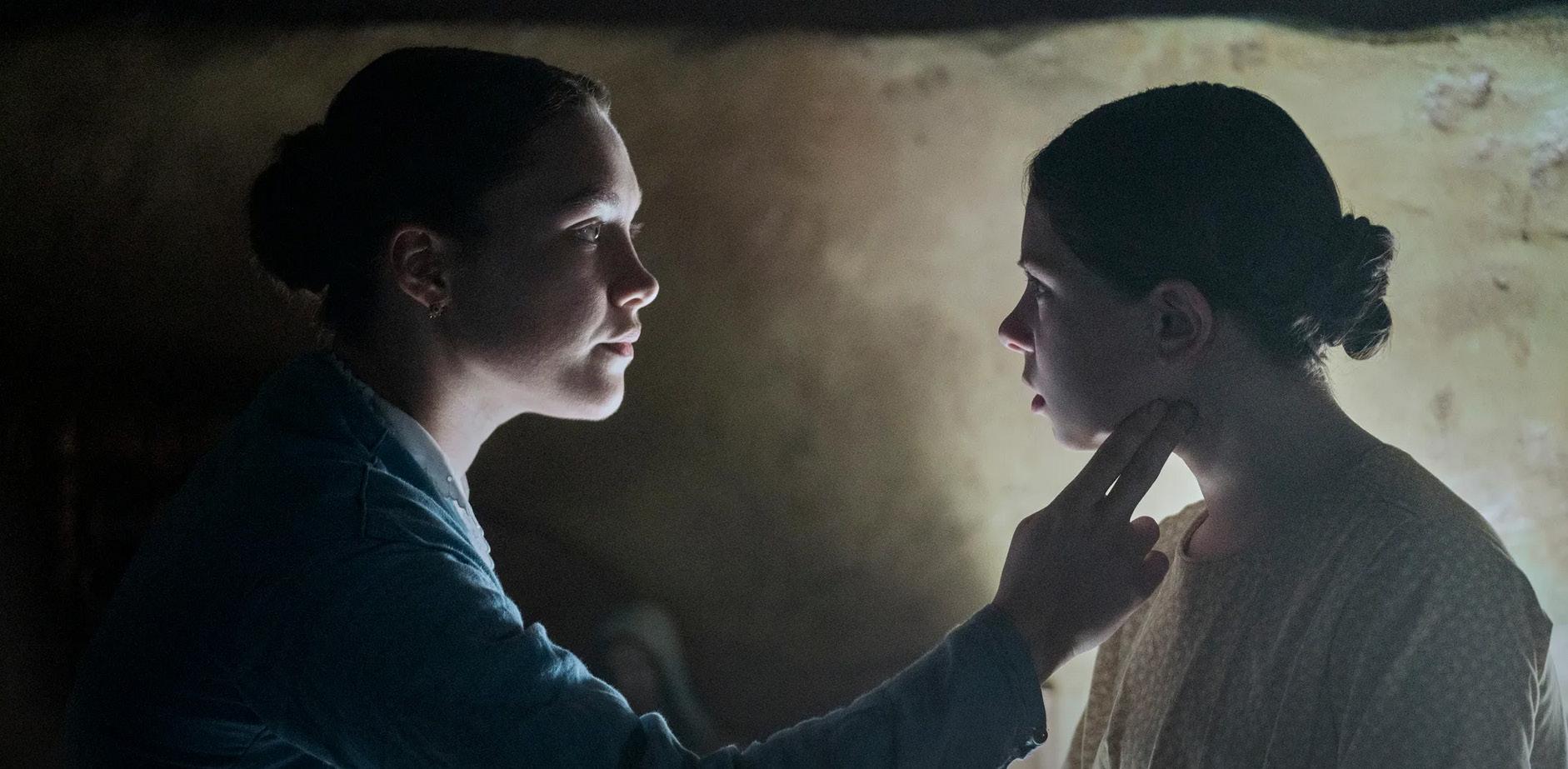
CINEMATOGRAPHY WORLD MARCH 2023 49
Don’t rock the boat for the sake of it… people do better work if you allow them to contribute and be creative
IN ANY WAY SHAPE OR FORM

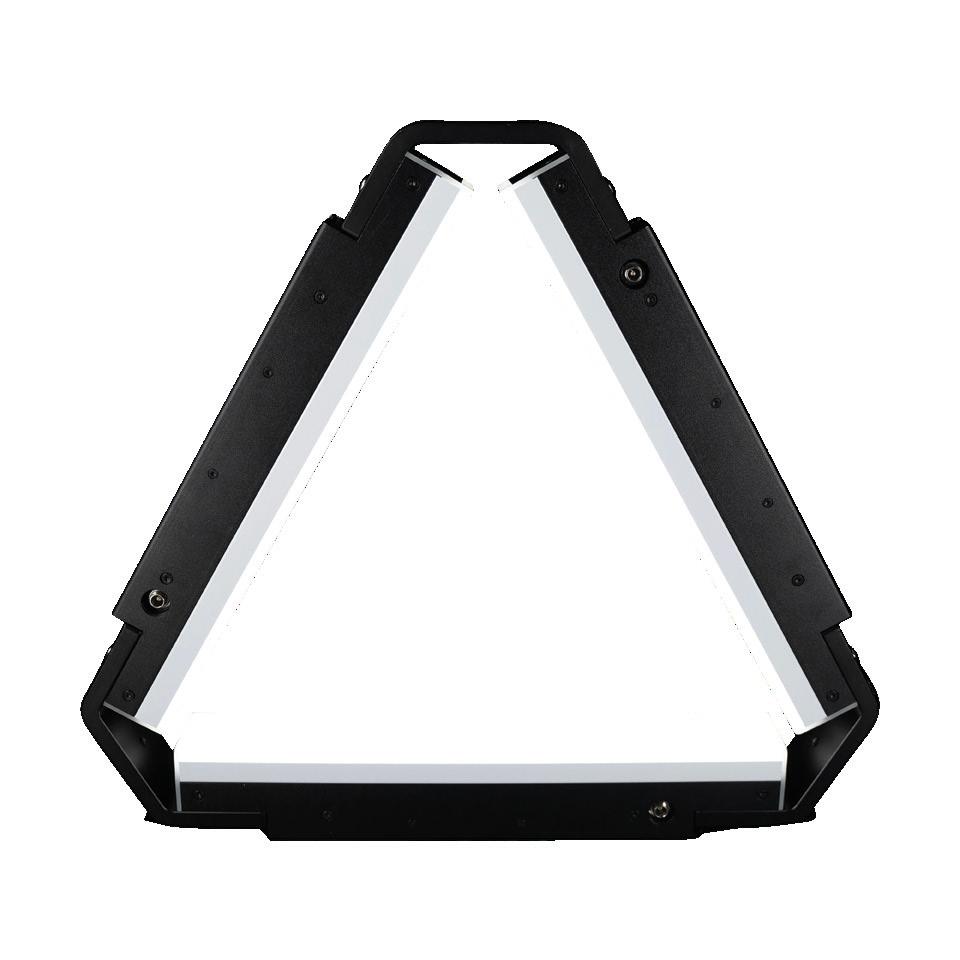




APUTURE.COM NOW AVAILABLE IN 30, 60 & 120 CM
HEART STRINGS
By Michael Goldman
For cinematographer Jess Hall BSC ASC, shooting director Stephen Williams’ historical drama, Chevalier, was one of the most compelling opportunities of his professional career.
Hall insists the movie represents “some of my best work” and, in many ways “pushes the boundaries of low-light digital cinematography.” But more important than all that, “the movie is extremely personal to me as it recounts the story of a significant African-European artist.”
Hall explains that when his agent first sent him the script, he felt as though “they had actually finally found something that connected to my life and interests on a very personal level.”
Chevalier recounts a significant period in the life of the French-Caribbean violinist, composer and swordsman, Joseph Bologne, Chevalier de SaintGeorges, who was an important member in the court of French queen, Marie Antoinette, at a time in history when the rage of revolution was just starting to percolate on the streets of Paris.
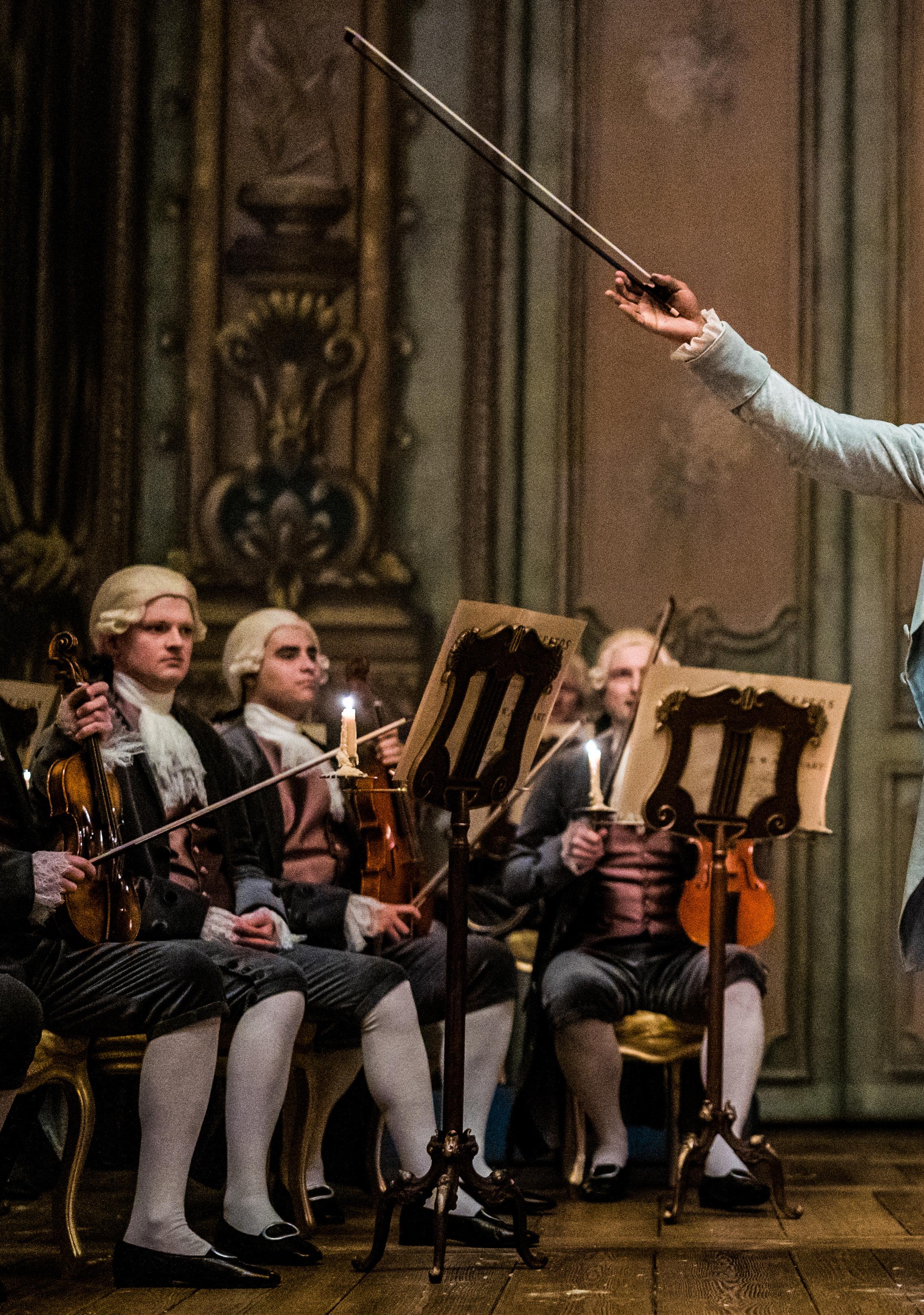
His achievements were many – modern scholars rank him as one of the era’s preeminent composers and, at one time, he was considered the top swordsman in Europe. Those accomplishments, and Chevalier’s unique position of dwelling in a so-called bourgeois class that he clearly was not a part of, were even more incredible, considering the fact that Bologne was the illegitimate son of a French plantation owner on the Caribbean island of Guadeloupe and one of his slaves.
Hall was particularly drawn to this story – of a black man rising to the highest levels of French society
at the most turbulent time in its history – as he is the son of a Jamaican father, whom he describes as “a radical intellectual,” and a British mother who is a historian specialising in the Caribbean and the British Empire. As such, Hall was exposed at an early age to complex ideas around art, culture and social equality. Filming the movie, therefore, meant more to him than simply fulfilling another job.
“The themes in the film connected personally to the legacy of my own family and my own life experience,” Hall relates. “I knew I could bring a special insight to this project. Chevalier existed essentially between two cultures. I know what it is like to inhabit a double consciousness, to be of Caribbean and European heritage, and to explore that space through artistic practice and expression.
“For a cinematographer, I think it is quite unusual to have a project that feels so personal. Often, when you begin a commercial project, you have to try and find a
way in. On this project, I already had a very clear way.”
The path Hall then had to travel included early decisions on how to create a lighting aesthetic for the period piece in ways that would best help tell the story, and evoke some of the many references he came up with during his extensive research phase.
“I grew up experiencing two very different kinds of light,” Hall says. “There was the hard equatorial light of Jamaica, where I spent my summers with my extended family, and then, there was the soft, silver-gray light of Northern Europe. My artistic sensibility represents a fusion, and in moments, a tension between these two opposing forces.”
Hall’s imagery in the film was based on a crucial research trip to Paris with production designer Karen Murphy, and intense study of the artistic works of 18th century painters such as Thomas Gainsborough, Francois Boucher and Joshua Reynolds.
He also referenced several period films, including
52 MARCH 2023 CINEMATOGRAPHY WORLD
CHEVALIER•JESS HALL BSC ASC
Custom lensing, low light, and a personal link to the period drama Chevalier.
We created a camera choreography that was in harmony with the music

JESS HALL BSC ASC•CHEVALIER CINEMATOGRAPHY WORLD MARCH 2023 53 Copyright 20th Century Studios. All Rights Reserved. BTS photos courtesy of Jess Hall BSC ASC.
Dangerous Liaisons (1988, DP Philippe Rousselot AFC ASC) and The Age Of Innocence (1993, Michael Ballhaus ASC), as well as Birdman or (The Unexpected Virtue Of Ignorance) (2014, DP Emmanuel Lubezki AMC ASC) for its fluid camera movement. Hall adds that Kubrick’s Barry Lyndon (1975, DP John Alcott BSC) was the most important reference.
Hall concluded that the story could be shot digitally, but wanted to explore the use of extreme low light to create authentic environments and an immersive experience. This approach made extensive use of candlelight, sometimes supplemented with low-key Tungsten illumination. Additionally, strategic iridescence was incorporated into lighting the of the vastly differing skin tones of the actors featured in the film.
The movie was shot entirely in Prague, between September and November 2021, in collaboration with Czech gaffer, David Kritz, who helped Hall evoke qualities of some of the unique lighting he saw in those oil paintings and in some of those historic films.


“I had always greatly admired Kubrick and John Alcott’s work on Barry Lyndon. I wanted to use inspiration from that to craft a digital exploration of low-light period cinematography, using the best tools available to us today,” he says.
“The film Barry Lyndon has an exceptional quality of light. I projected it with some friends during my research process, and one thing that struck me was that it was shot in incredibly low light. Yet, what I remembered was not the darkness, but the light, particularly the light on faces. I imagined a luminescence to our actors’ skin, especially lead actor Kelvin Harrison, Jr. who plays Chevalier
“The goal was a kind of naturalism, but I also had a desire to light Kelvin’s skin in a way that I felt is not often done. Darker skin tones have not always been represented with integrity. I had a specific approach – I wanted Chevalier to glow. I was seeking a luminosity on Kelvin’s relatively dark skin, despite the fact that many scenes were frequently staged in dark environments. So I devised a multi-faceted strategy that would circumvent muddy images or over-compressed shadows.
Chevalier is a shining light in this story, a hero and a revolutionary, and I wanted to evoke that. To get that kind of iridescence involved working a lot with reflective light on his skin, using the angles of reflection with larger sources and with candlelight. That was often a tricky
exercise, especially when he was sharing the frame with a Caucasian character Marie-Josephine, played by Samara Weaving, which meant the lighting had to accommodate two very different skin tones in one frame.”
The need to work extensively with real candlelight was also crucial to Hall’s lighting strategy. Some night interior candle-lit scenes were augmented predominantly with very low-level supplemental light, such as helium balloons and soft Tungsten sources. But, the cinematographer emphasises that, “candles are quite hard to work with as a solo source, because they are actually quite hard light, and you can get multiple shadows. Therefore, we often supplemented the candlelight with something that was almost fill light, whilst the candles served as the key light.”
Day interiors featuring natural light were also often
format and could cover the sensor of the Sony Venice in the 1.85:1 aspect ratio I wanted,” Hall reveals. He says the lenses that resulted from that work – a package ranging from 28mm to 100mm, plus a 90mm micro –“are some of the fastest large-format lenses available. The 50mm lens features what Dan referred to, in our initial meeting, as ‘The Holy Grail’ – a 0.9 aperture!”
“Some of the night interiors in the movie were filmed at sub-1ft. candle range,” he continues. “Focussing at this T-stop with a moving camera was only made possible by unique alterations to the lenses, recent developments in camera technology, and the tools required to maintain focus. Essentially, these high-speed lenses did not behave like modern, mathematically sharp high-contrast lenses. The fall-off was softer, therefore creating a larger area of perceived sharpness. The transition from sharp to soft was gentler, because there was never anything pinsharp on the lens.
supplemented. For example, a key scene in which Chevalier wins an important fencing match, causing the queen to make him a Chevalier in the first place. To create natural light streaming-in through the windows, Hall used a 100ft x 40ft. cantilevered bounce outside a south-facing bank of windows using indirect ARRI M90 and ARRI 18K HMIs. “The light was changing all day, so that helped me block the sunlight and create soft, consistent daylight, even after sunset,” he explains.
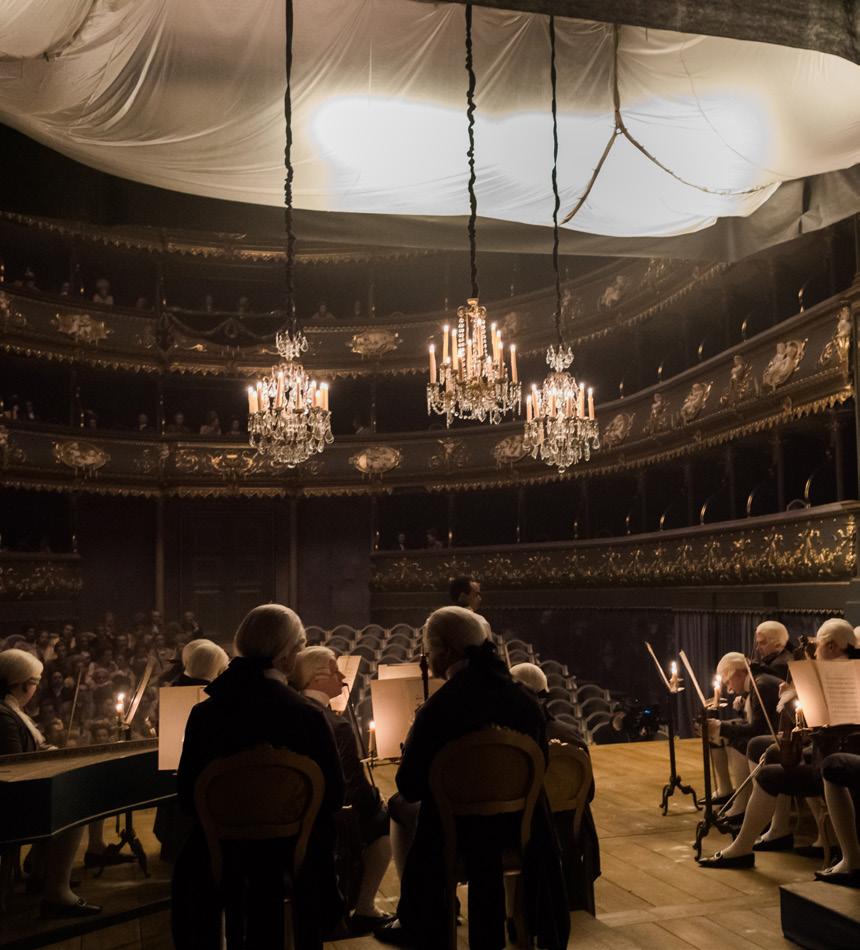
Meanwhile, after extensive testing, Hall chose the Sony Venice camera to shoot the movie, especially attracted to its low-light capabilities using the 2,500ISO option. A bigger question, however, for Hall was how to lens the picture. In collaboration with Panavision VP of optical engineering, Dan Sasaki, Hall was able to have Panavision construct unique, customised, high-speed lenses to maximise his ability to shoot the night interiors in candlelight.
“We worked on a prototype lens that was large-
“Dan also worked on the lenses’ close-focus capability, because we often placed the camera close to Chevalier to experience the world from his perspective. These lenses have a kind of ethereal feel to them. The depth-of-field is not perceived as extremely shallow like you would expect from a T0.9 to T1.4 lens. That was something we managed to achieve, which also made it possible to move the camera in the way we desired and to maintain focus. Without modified lensing, the fluidity and flexibility of camera movement we employed might not have been possible.”
Hall adds that the 90mm micro was also crucial for certain shots where music sheets, with notes penned by Chevalier, were closely highlighted as he was imagining his compositions.

“As he imagines the note, the note comes into focus,” he says. “That is why Dan built us the 90mm micro, which was more than 1:1. He managed to build it in a small form factor and with a very specific character to the fall-off in focus.”
The other crucial creative decision Hall made was to make extensive use of a moving camera. Steadicam was the primary tool of preference for this, but a Technocrane and a dolly with an ARRI remote head were also utilised for certain sequences. Hall says his purpose with this choice was to achieve “fluidity and elegance of movement to compliment the unique compositions of Chevalier.”


54 MARCH 2023 CINEMATOGRAPHY WORLD CHEVALIER•JESS HALL BSC ASC
I grew up experiencing two very different kinds of light
For this work, Hall relied heavily on his single camera operator, Geoffrey Haley SOC, who had experience as a concert cellist and understood how to elegantly follow a musician and work with musical sequences.
Hall says he, director Stephen Williams, and Haley
worked together to create “a camera choreography that was largely in harmony with the music. Using the pre-score, we started working on camera-pacing early. We were able to time camera movement on the Steadicam precisely. Geoff, being a former concert cellist himself, could synchronise with ease as he has extensive musical training.
“In one sequence, where we see Chevalier and Marie-Josephine falling in love, we choreographed the camera movement to within the accuracy of a single note. We knew exactly where the transitions were going to occur and, with the collaboration of our fantastic music department, we were even able to make slight edits to the score. The timings of the camera moves for each section of that score were extremely tight. The syncopation of camera movement to the music was executed by Geoff with significant precision.”
More generally, Hall says that the mission Williams gave him regarding camera movement was to make sure viewers got “an incredibly immersive experience,” meaning he wanted to film the world largely from Chevalier’s point-of-view.
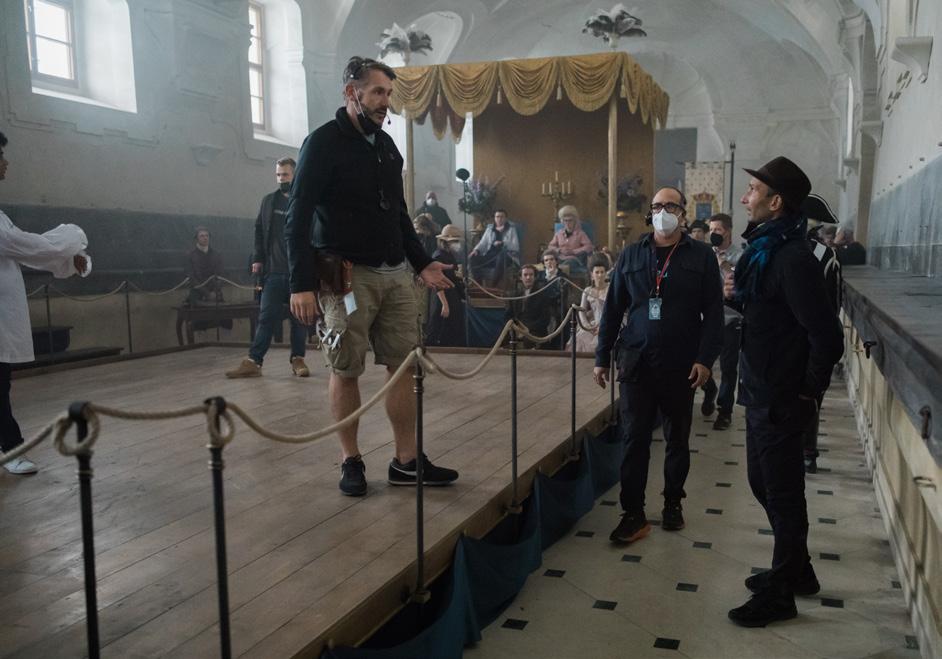

“The idea was essentially to inhabit the subjective,” he explains. “Stephen wanted a consistent approach to the camera syntax. A lot of the world was revealed with quite a simple classic structure, by following Chevalier through environments, seeing him look, and seeing what he sees.”
Czech technician Viktor Lonek served as DIT on the project, managing a single show-LUT that was designed by Company 3 digital intermediate colourist Yvan Lucas
in collaboration with Hall. During post, Lucas relied on the ASC CDL correction system for various adjustments to candlelit scenes compared to daylight scenes. Hall says the DI process largely involved a series of “fine adjustments” performed by Lucas, whom he calls “a master colourist.”


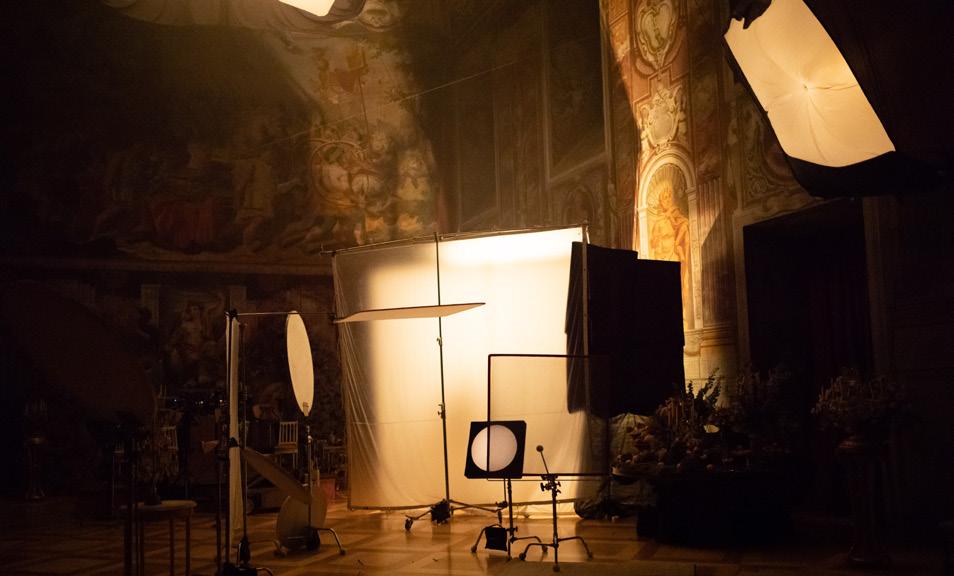
Hall and Lucas both suggest that, among other things, Chevalier addresses an interesting question—how the aesthetic quality of a period film like Barry Lyndon can be translated into a digital context.

“We adjusted specific colours, saturation, and reduced contrast,” Lucas remarks. “Colour grading was largely done using printer lights to maintain consistency of scenes, like a print-light, relying on the tools we have in the Baselight [colour correction system]. But the dailies were already so beautiful that I didn’t need many power windows. I really hope the audience will appreciate as much as I have the nuance in Jess’ lighting.”
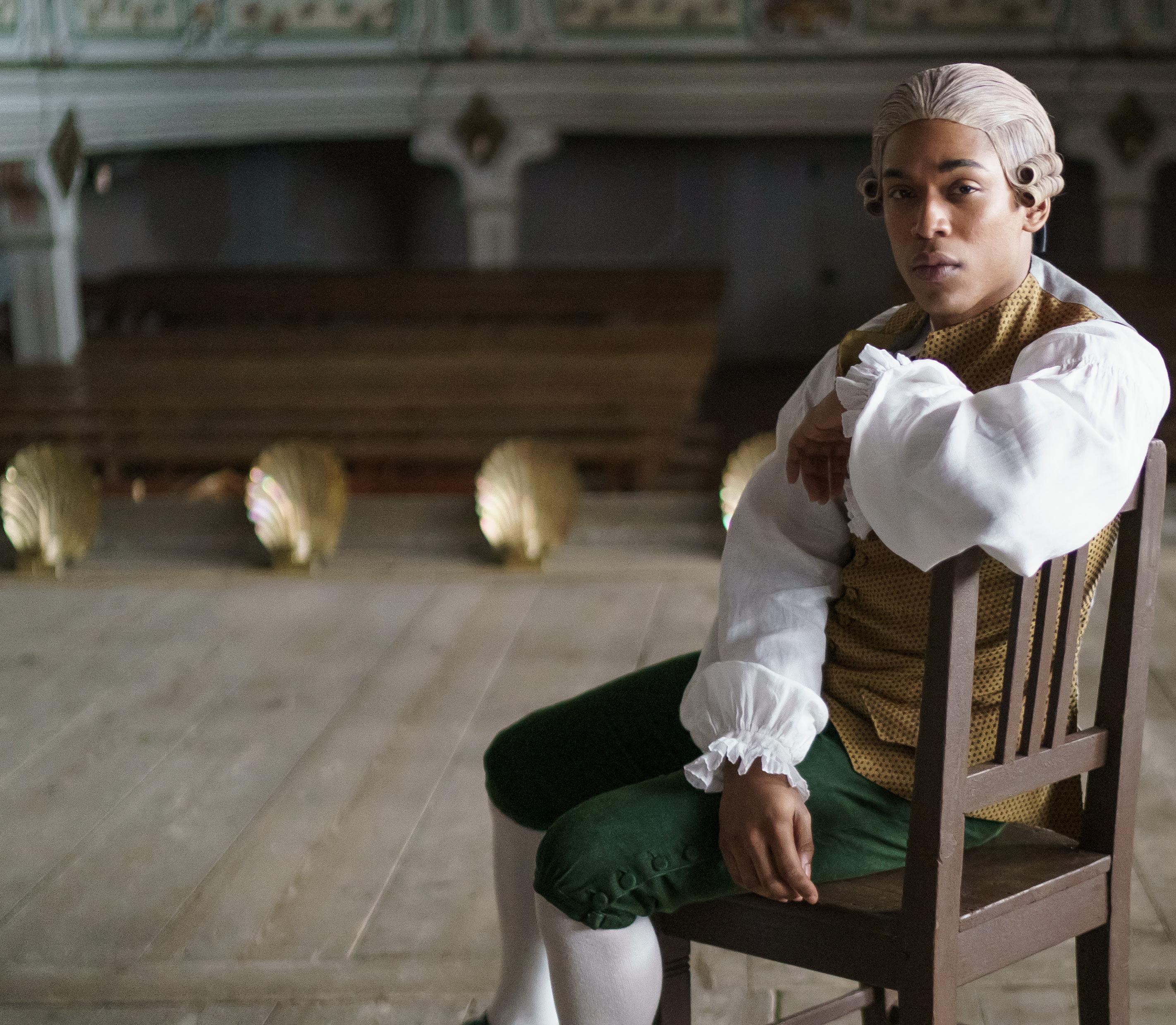
JESS HALL BSC ASC•CHEVALIER CINEMATOGRAPHY WORLD MARCH 2023 55
I had a specific approach –I wanted Chevalier to glow!
EXPANDING THE LEGACY
By Darek Kuźma
With Luther: The Fallen Sun, veteran DP Larry Smith BSC ASC made the brilliantbut-disgraced TV detective’s first foray into a feature film territory a cinematic experience. A young night cleaner performing his tedious job in one of London’s glass skyscrapers receives a disturbing phone call. A malevolent male voice orders him to drop everything and go to a certain location – if not, something horrible will happen. The hapless janitor drives in heavy rain, only to fall into a peculiarly gruesome trap.
The next morning, DCI John Luther arrives at the crime scene. Although he immediately suspects something is off, he has no idea yet that it marks the start of a vicious, vile project, by a psychopath he failed to capture previously, that will leave dozens more bodies across Europe. Because Luther’s investigation becomes a threat, the serial killer ensures the detective is arrested and incarcerated for his own past sins. But, disgraced and desperate for justice, Luther escapes from prison and all bets are off.
Five seasons and twenty agonisingly-emotional episodes of Luther, the British TV psychological crime thriller, aired between 2010 and 2019. They earned Detective Chief Inspector John Luther, played by Idris Elba, a massive following and made him a TV icon.

Luther: The Fallen Sun, directed by Jamie Payne and showing on Netflix, reimagines the final season’s conclusion of Luther getting handcuffed and introduces his new nemesis, David (Andy Serkis), a devious tech-genius with a penchant for theatrically-macabre murders – including immolations. Whilst Luther remains the same, the world outside the prison walls has become a lot more oppressive, with cyber-puppeteers, such as David, blackmailing and coercing people into submission through malicious online means. Accordingly, the film needed a DP who could handle the task of giving the series a big-budget cinematic treatment.
“I worked with director Jamie Payne on an episode of The Alienist (2018) and he asked me if I was available to shoot Luther’s fifth season for him,” says Smith. “Regrettably, I couldn’t do it because of prior engagements. It was such a shame, but there was nothing I could do. Fortunately, I was available when Jamie asked me in September 2021 about shooting Luther: The Fallen Sun. I had just wrapped-up Dark Harvest (dir. David Slade) in Canada, and was about to prep a project for Apple, shooting in Japan in January 2022, but that got pushed back until April due
56 MARCH 2023 CINEMATOGRAPHY WORLD
LUTHER: THE FALLEN SUN•LARRY SMITH BSC ASC
For the studio-based sequences, I used mostly LEDs to have full control over colour and intensity
to Covid restrictions.”
The Fallen Sun was shot from November 2021 to early March 2022 in the UK, Belgium and Iceland. Prior to Payne’s offer, Smith says he had only watched small chunks of Luther, and did not think it was necessary to catch-up with the original TV series.
“I didn’t want it to affect my approach,” he admits. “Not only because this obviously was a much bigger canvas to work on, but also because I was eager to shoot it with fresh eyes, and in a way that felt organic to the script. Jamie was very keen to use the ARRI Alexa with Leitz Thalia lenses and I agreed.”
Smith shot Luther: The Fallen Sun with ARRI Alexa 65 (open gate 6.5K) and ARRI Alexa Mini LF (open gate 4.5K) cameras, fitted with Leica Thalia spherical lenses (24, 30, 35, 45, 55, 70, 100, 120, 180mm). At his disposal, he also had a Hawk 150-450mm HighSpeed Telephoto Zoom, an ARRI/Zeiss Ultra Prime 8R and Sigma High Speed Primes (20, 24, 35, 40, 50, 85, 105, 135mm) for immersive drone-shot vistas. The principal photography was a mix of exterior
location work and shooting interiors that were built on sets at Shepperton Studios in London. These included the prison in which Luther spends time before he is provoked by the maniacal David to break-out during a spectacularly-staged riot sequence.

“For the studio-based sequences, I used a variety of light sources, mostly LEDs, to have full control over the colour and intensity – lots of Astera Titan Tubes and ARRI SkyPanel S30s, S60s and S360s, plus 18Ks from time-to-time. We shot with grey screens behind the windows, so the lighting didn’t vary that much in other set-ups. At Shepperton we also shot David’s office, the police headquarters, the bunker where Luther is tortured and the Bishops Avenue house where the bodies are burnt.”
The filmmakers shot in different areas of London, including the bright and busy Chinatown area, plus a disused underground station through which Luther chases David after one of the psychopath’s most grizzly crimes.
“I was impressed with the level of maintenance on
the London Underground. The ceilings could probably use some paintwork, but the tracks and the fluorescent tubes were immaculate!” he says. “Because the dark of the tunnels plays a crucial part in the chase, my gaffer, Harlon Haveland, and I decided to keep the lighting as natural as possible, using mostly Astera Tubes that were essentially fluorescent to the eye anyway. The green you see in the images comes from the original station lights. We only added a bit of red in the tunnels to have some interesting visual contrast.”
One of the biggest, and most dramatic, setpiece in Luther: The Fallen Sun was shot in London’s renowned Piccadilly Circus.
“The sequence has some VFX that were done later in post, but the motorcycle accident and the bus crash, that are part of the chaos brought by David’s crime, were shot in-camera. We did five nights there and had the entire area more-or-less under our control. It’s amazing you can still close down such places for filming.
However, Smith does not remember that shoot with particular fondness. “When you do night
LARRY SMITH BSC ASC•LUTHER: THE FALLEN SUN
CINEMATOGRAPHY WORLD MARCH 2023 57
Images: Luther: The Fallen Sun. Cr. John Wilson/Netflix © 2023.
LUTHER: THE FALLEN SUN•LARRY SMITH BSC ASC





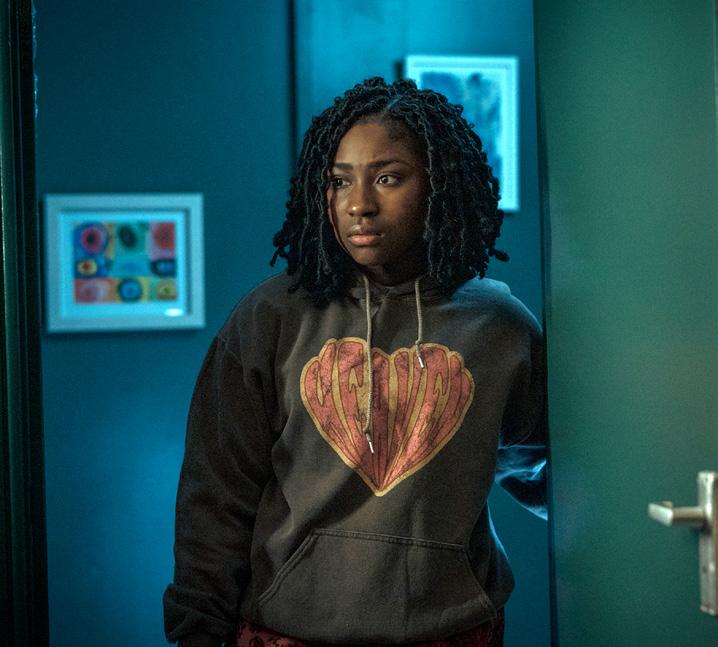
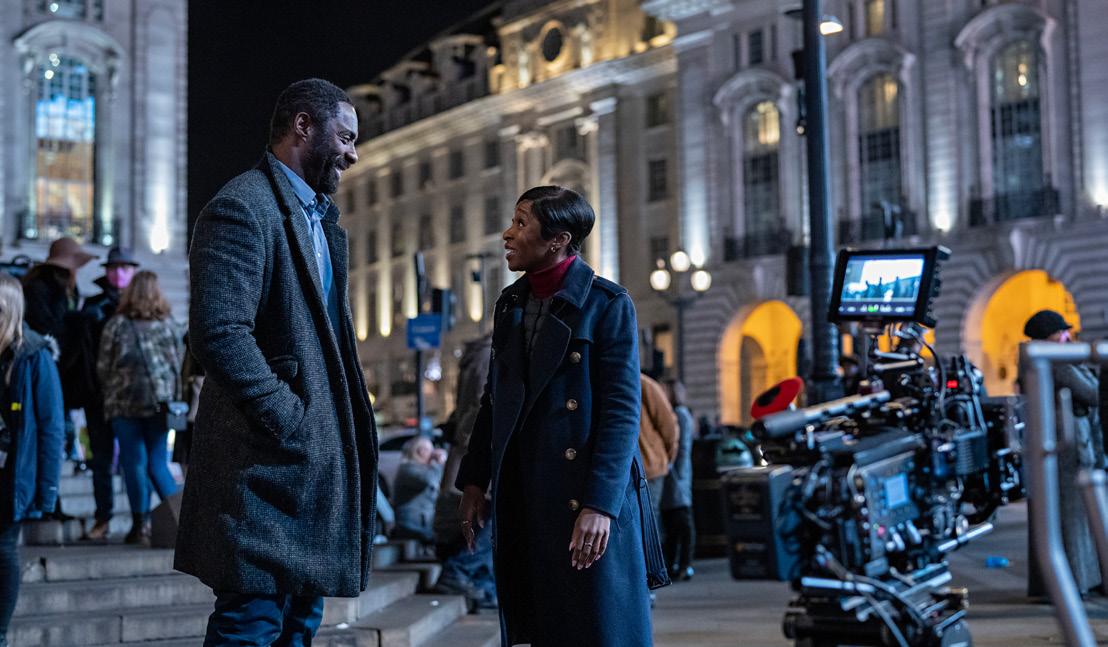







58 MARCH 2023 CINEMATOGRAPHY WORLD
exteriors in Piccadilly Circus, the light from the big LED signs is impossible to control. You’re shooting a scene and suddenly they change to a different design and become 100% brighter. The locations itself really adds to the film’s production value, but honestly, being there was problematic from my point-of-view. The only thing I could do was to shoot in a way that meant we’d finish scenes before the signs change. We mostly succeeded at that.”
Nonetheless, probably the most impressive location work was done on a glacier in Iceland, which stood in for David secret hideout in northern Norway, where intends to bring his intricately-wicked Se7en -like project to life.
“The day work was obvious, it was all lit with the sun,” Smith reveals. “There was nothing else we needed. Artificial additions would only corrupt the clear beauty of the place. The night stuff was more difficult, because it was all white and reflective, and bringing-in big sources on cherry pickers was not practical with that sort of terrain, especially with the amount of flashing police lights that appear at one
point. I wanted to emphasise the depth of the vistas, as if you’d see them with the naked eye. So I simply picked-out the mountains by positioning a couple of larger HMIs and 18Ks in high spots in which they were not visible to the cameras.”
One other challenge Smith faced was shooting in an underwater tank in Belgium’s state-of-the-art Lite Studios.
“This was a gruesome scene, quite dark in terms of lighting and atmosphere. I had several bigger HMIs at hand, but most of the light came from the beautifully designed in-house overhead rig. The rest became a matter of punching something from time to time for a more pronounced feel,” he admits.
“To be honest, the schedule and most of the location work weren’t that difficult from my point-ofview. The project demanded quite a lot of thought, prep and work, but it was all manageable. The only real issue was getting the most out of locations that we had only for one day, where we weren’t able to pre-light them. But that’s the challenge of any project, big or small.”

“With big-budget projects such as Luther: The Fallen Sun you invariably get to a place where you have more shooting days across the whole project than you might have on smaller-budget production. But, you are aware that it doesn’t always translate into having more physical time, and to be able to work in a more relaxed way. It’s like when you move out of a small apartment to have more space for your stuff. You move into a bigger one and before you know it, you’ve got no space again. I think we used our time and skills to fulfill Luther’s legacy, but that’s obviously for the audience to decide.

All in all, Smith revelled at the experience and was glad to be a part of the production. Apart from one vital aspect.
“I went to Japan straight after this and I wasn’t available to do the final colour grade. It’s always a problem for DPs when they are not involved in the final grade, but in this case it wasn’t possible.”
CINEMATOGRAPHY WORLD MARCH 2023 59
LARRY SMITH BSC ASC•LUTHER: THE FALLEN SUN
This was a much bigger canvas… and I was eager to shoot it with fresh eyes
MISSIO N IMPOSS IBLE
By Ron Prince
In the late 19th century, Lucas, a young Danish priest, armed with his Lutheran faith and a wet-plate camera, is dispatched on an evangelising mission to a remote part of Iceland to build a church and photograph its people. But the deeper he goes into the unforgiving landscape, on his cross-county expedition to establish a new parish in a foreign land, the more he strays from his purpose, the mission and morality.
Examining how faith and nature shape cultural identity, the bilingual historical drama, spoken in Danish and Icelandic, premiered in the Un Certain Regard section of the 2022 Cannes Film Festival. Godland has been particularly praised for the way in which the cast inhabit their performances, along with its stunning 4:3 cinematographic canvas, taking-in character portraits amid misty landscapes, precipitous waterfalls, austere glaciers and rumbling volcanoes, along with atmospheric 360-degrees shots, making the audience feel part of Lucas’s journey.
Godland represents the third longform partnership between Icelandic director Hlynur Pálmason and Swedish cinematographer Maria von Hausswolff DFF, who resides in Copenhagen, Denmark, following their collaborations on Winter Brothers (Vinterbrødre) (2017), shot on Kodak 16mm, and A White, White Day 2019 (Hvítur, Hvítur Dagur), captured in 2-perf on Kodak 35mm film. Pálmason picked-up awards at many film festivals around the world for Winter Brothers, and von Hausswolff won the Camerimage 2017 Best Cinematography Debut Award for her work on the film.
“Hlynur and I were contemporaries at filmschool, where I shot his short films. I knew about Godland as early as 2014, when I received a script from him just after I had graduated,” she says. “We talked onand-off about this film during our time together filming Winter Brothers and A White, White Day. What I like about working with Hlynur is that the visual language we built together during our filmschool days is the language we continue to working with. Our goal is always to try to find a simple, truthful way of expressing the story, and each film takes on its own temperament,
look and sound, as we slowly work our way into it.
“But you also want to evolve with each project, in new ways and contexts, such as the 360-shots for example. We always aim to take a new step towards even crazier and more demanding set-ups than our previous films.”
Von Hausswolff arrived two months before cameras turned-over, and was able to secure day-care for her young child – then aged just one-and-a-half –for the duration of what turned out to be a five-month long production period.
Shot in narrative order, the DP reports that filming Lucas’s voyage across the wilds of Iceland often required burdensome and physically-demanding hikes with filming equipment in brutal weather conditions. Consequently, the cast and crew were given a week’s rest before photography resumed at the main location where the wooden church was being erected.

Von Hausswolff says there were no particular filmic references for the visuals. “We had references from paintings, plus historic photographs and old documentaries about hiking in the Icelandic mountains. For me, however, the main inspiration was about spending time with Hlynur, observing the mood and atmosphere at our locations, doing camera tests and discussing what we wanted to achieve from the landscape and portrait photography. During prep, we got the chance to shoot the volcano erupting. It was a powerful experience, feeling connected to the centre of the Earth, and a beautiful beginning of our adventure.”
She adds, “Shooting on celluloid film again was never in doubt. We both felt that framing Godland in 4:3 aspect ratio on 35mm film created a real connection to the landscape and the portraiture of the people, whilst also resonating with the photographs that Lucas takes with his wet-plate camera.”
Principal photography on Godland took place over 40 shooting days between June and early August 2021 around the Icelandic fishing town Höfn in the south-eastern part of the country, close by the Hornafjörður fjord which is noted for its scenic views of Vatnajökull, the largest ice sheet in Europe by volume.

Von Hasswolff operated the camera throughout the production, supported by 1st AC Julian Lalinde and 2nd AC Marta Natoli. The key grip was Haraldur Hrafn Thorlacius, with Dagur Benedikt Reynisson working as gaffer. The wet-plate camera photographer was Hördur Geirsson. Pálmason operated some of the handheld shots, and also filmed timelapse sequences that feature at the end of the film.
Following the camera and lens tests, Von Hausswolff filmed Godland using ARRICAM ST and ARRICAM LT cameras, fitted with Zeiss Superspeed optics, plus an Angénieux 25-250mm HR zoom, shooting mainly on sticks and dolly, except for a small clutch of scenes where the visceral energy in a scene required handheld coverage. The camera package was provided by TFS in France and KUKL in Iceland.
Having a good handle on the challenges to come, the DP selected KODAK VISION3 50D 5203 for daytime exteriors, KODAK VISION3 250D (5207) for overcast day exteriors and daytime interiors, plus KODAK VISION3 500T 5219 for all of the nighttime scenes. Film processing and 4K scanning was done at Focus Film Lab in Stockholm, and the final DI grade was completed by colourist Nikolai Waldman at Can Film in Gothenberg.
“The weather in Iceland is unpredictable, sometimes with rain, snow, sunshine and wind on the same day,” says von Hausswolff. “The colourful nature of the 50D and 250D gives an incredible connection
60 MARCH 2023 CINEMATOGRAPHY WORLD GODLAND•MARIA VON HAUSSWOLFF DFF
Using Kodak 35mm film, DP Maria Von Hausswolff DFF created a landscape of breathtaking beauty for director Hlynur Pálmason’s test-of-faith movie Godland
Centre-framing opens up a lot of interesting possibilities for strong compositions
Framing in 4:3 aspect ratio on 35mm film created a real connection to the landscape and the portraiture
to the landscapes, with lovely rendition of skin and faces in the portraiture. I knew they would blend well together in terms of texture and grain across the changeable lighting conditions we were going to face during the shoot.
“I’m a very intuitive person, I love simplicity, and have always tended to lean towards the balance and symmetry of centre-framing. It opens up a lot of interesting possibilities for strong compositions, and you can use it to draw the audience’s attention to a particular subject. It also helps with the visual storytelling, as eyes don’t need to shift across screen to find the point of interest in the next frame.”
Von Hausswolff also designed two notable 360-degree shots for Godland – one in which the camera observes the evening light as Lucas lies bruised and vulnerable in a grassy valley, the other a portrait of community Lucas has come to evangelise, as they gather for a summer celebration, to the tunes of an accordion band.
Perhaps the most striking visual of all is a slow, downward camera tilt, framing the course of a huge waterfall over several hundred of precipitous rocks feet from top to bottom.
exposures as we shot. On exteriors we worked mainly with natural, available light and controlled the aperture with ND filters on the lens, overhead frames or diffusion silks. If we needed light on a face, or negative fill, we generally used reflectors.
“The lighting package itself was limited to SkyPanel S60s, M18 and M40 HMIs, a small number of ARRI Fresnels, plus real candles and oil lamps. The interiors were generally very dark, and along with oil lamps, fire and candle light, I had to bounce in light to bring volume and shape, and lifted the key lighting with Fresnels.”
In conclusion, von Hausswolff says, “It was great to collaborate once again with Hlynur. I’m glad to work with a director who constantly pushes the vision and my limits in difficult situations. It’s stimulating, frustrating and challenging, but most of all very rewarding.
“Using the 250D we could film indoors, whilst also capturing excellent detail and colour in the landscape thorough windows, which I am not sure you could achieve so easily if you shot digitally. The 250D was excellent in the misty, foggy exteriors we encountered, also helped to elongate the shooting day. At that time of year it does not get truly black at night, so there was often enough available light get good exposures as the dark closed in around us.
“Although I tended to use the 250D for most of the day interiors, I switched to the 500T for the scenes inside the wooden church. The natural daylight was extremely limited there and I could only introduce a small number of lighting fixtures, so the extra stops that the 500T gives were really useful.”
Centre-framing is somewhat of a stylistic signature of von Hausswollf’s work with Pálmason, and proved an enticing proposition once again, across the variety of static, panning and tracking shots, as she explains,




“I remember the day we shot that scene very well,” recalls von Hausswolff. “It was extremely wet, windy and cold. To get the shot, we had to hike up a huge hillside with the camera gear to a cliff opposite the cascade. I had the camera on a tripod with the Angénieux 25-250mm HR zoom, and practised the move over and over again – partly to learn where to frame, as it was sometimes hard to see the course of the water, and partly to get a nice gentle pace to the take.
“The tripod head was not motorised, and it took a lot of effort to perform the move by hand. We had to wrap because the actors got really cold, and was really upset afterwards because I felt it was not as perfect as it could have been. But, I was much happier a few days later when I saw the dailies, as that shot had become really abstract, uncanny and dark, almost like a painting.”
When it came to lighting, von Hausswolff remarks, “Dagur, my gaffer, was incredibly helpful in keeping an eye on the weather and how this might affect my
“At times it was an incredibly tough and physicallydemanding shoot, but the cast and the crew were always willing to dedicate themselves to it with love and passion, and it felt like a family, with a real sense of togetherness, as we carried props and cameras up hills in challenging weather.”
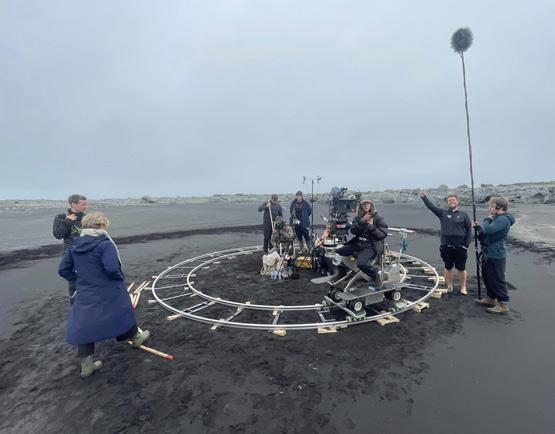
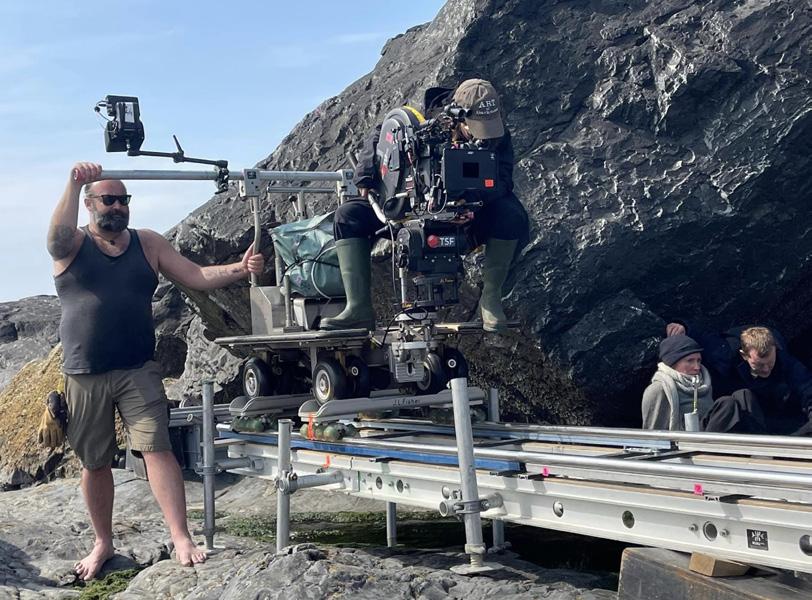
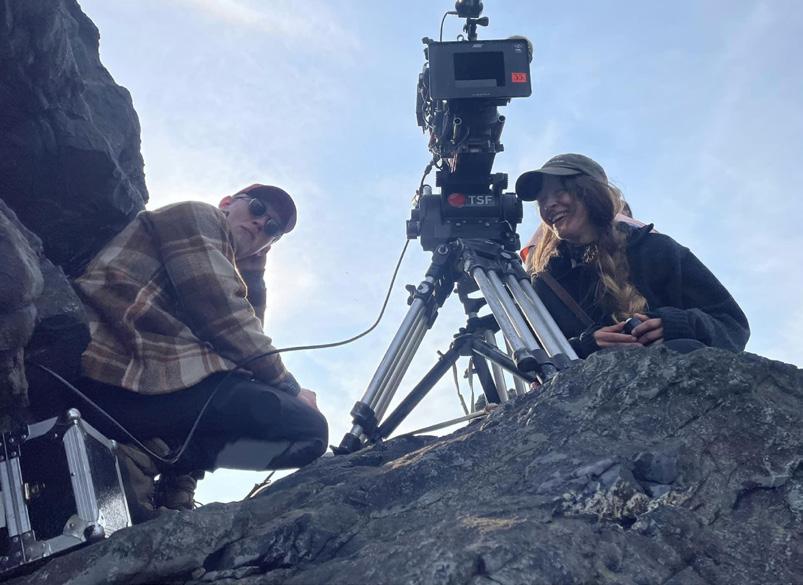

MARIA VON HAUSSWOLFF DFF•GODLAND
CINEMATOGRAPHY WORLD MARCH 2023 61
Images: Godland, directed by Hlynur Palmason. BTS photos © Maria von Hausswolff DFF and Hlynur Pálmason. Film images © Snowglobe.
SOUL MATES
By Oliver Webb
Following 13-year-old best friends, Leo and Remi (portrayed by newcomers Eden Dambrine and Gustav De Waele), as they adjust to their new school environment, Close is a devastating tale of childhood friendship and loss.

Directed by Lukas Dhont, and beautifully-captured by DP Frank van den Eeden SBC NSC in warm and natural hues, Close won the Grand Prix at the 75th Cannes Film Festival and was nominated for the Academy Award for Best International Feature film at the 2023 Academy Awards.
“Close is my second film with Lukas,” says van den Eeden, who had previously shot Dhont’s debut feature Girl (2018), which picked-up multiple awards, including the Camera D’Or and the Queer Palm at Cannes.
“Before we ever met I knew who Lukas was and understood his interest in visual storytelling because I’d seen many of his short films. We started off with Girl, but I had to wait a few years before he came back with Close. I had no hesitation about Close at all, as it was beautiful script. We had established a great working relationship on Girl and I was happy to work with him again.”
During van den Eeden’s initial conversations with Dhont about the look of Close, Dhont already had a vision in mind for the film.
“He brought to the table 20 or so references –pictures, stills, photographs and paintings. It isn’t about copy and pasting. He has this broad idea of where he wanted this film to be, and these were a starting position for him,” says van den Eeden.
“The biggest inspiration was the script itself. We read the script together and then we went through each scene and we talked about how to shoot it. We were going to shoot in spring, summer and autumn,
plus a small portion in winter, and was very important to Lukas that we could really see and feel the passing of time in colours and light.”
“We also discussed Leo, who is the central character in the film, as he is a non-professional actor, but he is in each scene and almost every shot, and there would be this very intense thing going on around him in the story,” adds van den Eeden. “Lukas and I spoke about working with a non-professional actor, because we wanted to keep him away from film set distractions and try to create an environment which felt comfortable to him. That would also allow us to get the
of friendship going on. He was very precise about this preparation before shooting.”
Discussing the challenges of working with the children, van den Eeden notes, “We had one important rule on how to approach this shoot, and that was to be able to shoot 360-degrees at almost every location, unless the was an obvious reason otherwise. This meant crew around Leo was kept to a minimum and all the equipment had to be out of sight. As a result, we would carefully pick our time of day to shoot exterior scenes but almost all of them are shot available light.
“On of the biggest challenges was being in the school yard, where all the youngsters gather for break and there were so many people around the actors. There was so much energy going on, and what we were after in this complex layout was sometimes a very small beat.
“If you are shooting with kids there is no use of doing nine or ten hours a day because after a long day not much good comes out of them anymore. There is no way of forcing them. If a scene is not working you have to reschedule it and do it again later to get what you want.”
best out of his performance.
“Lukas wanted Leo to get acquainted with me, my assistant and the camera. We organised a few days of shooting with a skeleton crew. It was, in a way, like a rehearsal, where I would be around him and his classmates with the camera on the Easyrig, so that they would all get used to me and the boom being over their heads. The idea was to put all of the kids together a long time before shooting started, so that when arrived on day one, there would be an energy
Van den Eeden captured Close using the ARRI Alexa Mini. “For Close we knee we were going to shoot a lot of footage, and we would have loved to have captured this on celluloid film, but there was no way we could shoot the same amount on film within our budget.
“The look of 35mm was something we were really keen on trying to achieve, to make it feel natural, analogue feel, but without beautifying it. During test shoots we exposed Kodak 250D and 500T and watched them side-by-side with our Alexa footage as a point of reference. We had an excellent grader from the Netherlands, Laurens Orij, who managed to
62 MARCH 2023 CINEMATOGRAPHY WORLD
CLOSE•FRANK VAN DEN EEDEN NSC SBC
We had one important rule… and that was to be able to shoot 360-degrees at almost every location
find the look we were after. The striking difference between 35mm and digital is skin tone. The skin tone on 35mm looks amazingly good. It’s very rich and alive. This is what we were working on especially during prep.”
In terms of aspect ratio, van den Eeden and Dhont opted for 1.66:1. “4:3 would have been too conceptual and too visually-present for this story. The framing very much followed the storyline, in that Leo and Remi would often be together in the frame at the beginning of the film, but, as the story progresses, we separated them more and more by panning between them.
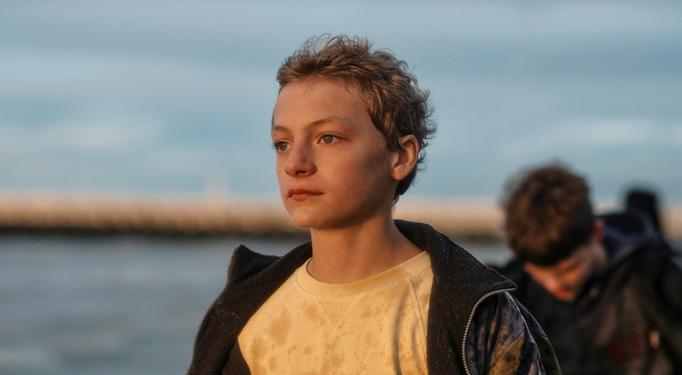



“I operated myself and had the camera on the Easyrig pretty much all the time. I really like the intensity of shooting like this, to be in the middle of the scene and to make decisions during a take.”

The film was shot over a period of 45 days, with the days spread out throughout 2021. Regarding the approach to shooting the film’s various tracking shots of the two friends, such as the cycling sequences, van den Eeden explains that locations were a key factor.
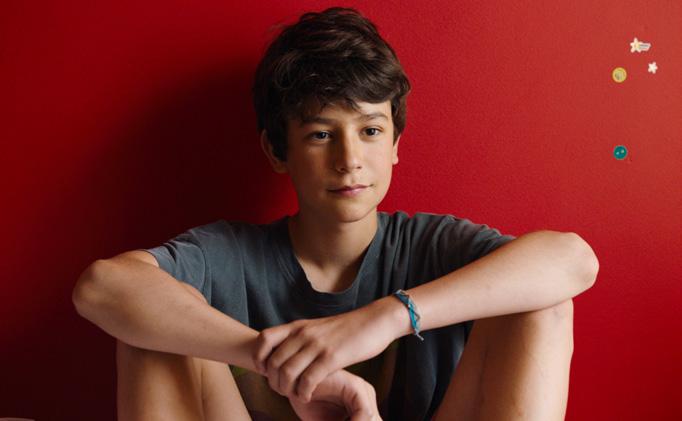


“We had been looking for a places which allowed us to pull off these shots on a technical level. For the cycling scene, the road needed to be long-enough, because it was not only about when they split off from one another, it was also about the beginning, who would be in front, who would be behind, and how are they each try to overtake one another.
“In a way, these moments visually express the relationship between Leo and Remi. We shot those scenes with a golf cart and had the camera stabilised on a gimbal. There is this repetitive character to the cycling sequences, which come

back throughout the movie, but they are all a little bit different. In a way they are little storytelling beats inside the bigger picture. These were in the script as well and this is how Lukas builds his stories, without any words. I think he is super-clever with how to tell a story and explain the mood of a character, especially with scenes like this.”
Another challenging aspect of production were the ice rink scenes. “I can’t skate myself, so we had a camera operator from the UK, Daniel Ilabaca,” explains van den Eeden. “Some of these scenes are actually about Leo going at full-speed on the ice. It was very physical and with that there is a lot of storytelling going on, about Leo being accepted in a group and becoming one of them. We reflected this concept in framing. There were not many single shots in these scenes. We’d have Leo pretty much always surrounded by other skaters.”
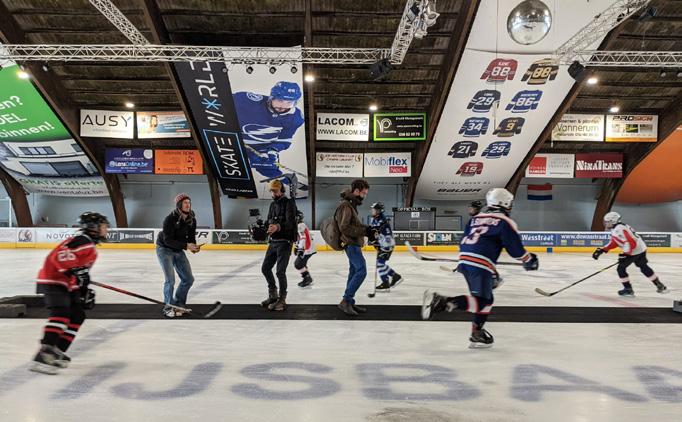
Van den Eeden’s gaffer was Bert Reyskens, and the pair took a natural approach when it came to lighting the film.
“We had some sets which were heavily-lit, but the approach was always for things to look as natural as possible. A good example is during Remi’s musical performance with the audience,” says van den Eeden. “We had overhead LED lights and HMI sources outside providing continuity throughout the day, but we had very few or no sources on the floor around the actors, again to be able to shoot pretty much 360-degrees.”
“I’m very happy with how Close is reaching out to audiences all over the world and to see the emotional response it brings. In a way that’s the power of film, it’s a language we all understand,” concludes van den Eeden.
FRANK VAN DEN EEDEN NSC SBC•CLOSE CINEMATOGRAPHY WORLD MARCH 2023 63
The approach was always for things to look as natural as possible with the lighting
THE COLOUR OF MEMORY
By Ron Prince
Harnessing Kodak 35mm, DP Gregory Oke captured the colour of memory for Aftersun, Charlotte Well’s awardwinning contemplation on love and loss.
Set in the late 1990s, Aftersun follows Sophie, an 11-year-old girl, on vacation with her father, Calum, at a Turkish beach-resort on the eve of his 31st birthday. Sophie records her holiday adventures and experiences –scuba diving, playing arcade games with other teenagers and, of course, spending time with her dad – on a MiniDV camera.
Amicably separated from Sophie’s mother, but unbeknownst to Sophie, Calum has occupational and financial struggles. He exhibits signs of depression and detachment, engaging in Tai chi routines, reading self-help books and smoking, a fact he conceals from Sophie.
All too soon she is at the airport, the holiday is over, and Calum disappears from her life. Some 20 years later Sophie reflects on the trip to Turkey with her father, prying through the old video camera footage, using her own memories and some new imaginings, to understand what happened to him.
Marking Charlotte Well’s directorial debut, the emotionally-autobiographical, coming-of-age drama, stars Paul Mescal as Calum, with debutante Frankie Corio and Celia Rowlson-Hall respectively as the young and adult Sophie. The film, which cleverly intersperses Sophie’s videocam footage throughout for storytelling purposes, premiered during International Critics’ Week at the 2022 Cannes Film Festival. It received acclaim for Wells’ screenplay and direction, lead performances and stylistic editing, along with the luminous cinematography by DP Gregory Oke.
A slew of nominations and awards followed, amongst which Wells became the Outstanding Debut winner at the 2023 BAFTA Awards, and Oke picked-up the 2022 BIFA Award for best cinematography. Aftersun was named one of the best films of 2022 by the National Board Of Review.


Wells, Oke and Aftersun’s editor Blair McClendon were all contemporaries at The New York University Tisch School Of The Arts, collaborating on filmschool projects and a good many shorts after graduating, including the SXSW Awards-winning Laps (2017). Oke also shot Raf (2019, dir. Harry Cepka), produced by Wells, which played at the 2019 Toronto Film Festival. Another collaborator, colourist Kath Raisch, at Company 3 in New York, graded Laps and continued working across many shorts as well as the feature Raf
“It was great to be asked by Charlie to collaborate on another project with so many longstanding companions and creative partners,” says Oke, who hails from the UK, and now works in Berlin. “She is a great film writer, and I felt really lucky to have her wonderfully-worked script as a foundation. What is now on the screen was very much there on the page.
“Although it was incredibly personal to her, we talked openly about the different aspects of the story. Our early discussions were about how to build the sense of the film coming from Sophie’s adolescent and adult points-ofview, and how we could express memory and emotions aesthetically on-screen via the framing and camera positions.”
Inspirations for the look of the film came from a variety of sources dealing with the idea of remembrance – stills from photographers such as Luigi Ghirri, Mary Frey, Silke
ideas backwards and forth.
“Celluloid film production was learnt and ingrained during our time at filmschool, and the look it gives has remained with us,” says Oke. “We both agreed earlyon that, being a film about memory, Aftersun had to be captured on 35mm. It has an amazing way of rendering colour and softening the complexion of skin in a visuallyengaging and connective way. We faced some resistance, I guess it was risk-aversion, saying that shooting on film with a child actor making her debut would not give us enough takes. But we fought pretty hard and convinced production that it just had to be on film.”
Pre-production on Aftersun began on May 21, 2021 with six weeks of prep. Principal photography commenced during the last week of June and wrapped in the first week of August. Filming took place around the sunny, seaside holiday resort of Ölüdeniz, Turkey, where Corio and Mescal spent a fortnight during rehearsals in order to make
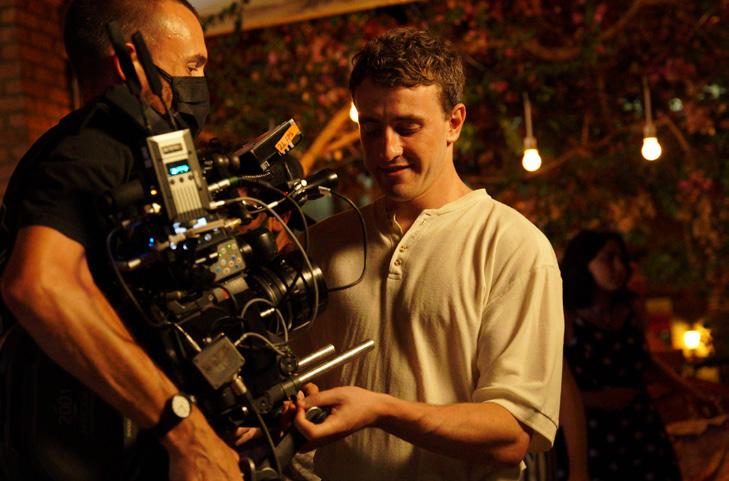
64 MARCH 2023 CINEMATOGRAPHY WORLD AFTERSUN•GREGORY OKE
Grossman and Sascha Weidner; paintings by KudzaniaiViolet Hwami and Tom Anholt; films from Chantel Akerman, Claire Denis, Hou Hsiou Hsien, Tsai Ming Liang and Apichatpong Weerasethakul; and avant-garde experimental works from director such as Bruce Baillee and Jonas Mekas. Wells and Oke also shared a good many holiday photos from their own childhoods, as they bounced
It was great to collaborate with so many longstanding companions and creative partners
their dynamic more authentic.
Framing in 1.85:1 to create intimacy with the characters, Oke shot Aftersun using an ARRICAM LT, mounted variously with 400ft and 1,00ft magazines, and fitted with Cooke S4 lenses. The camera and lens package was supplied by Phoenix Camera & Lighting in Istanbul.

“During prep, we shot interior and beach tests at our location with a range of different lenses, including vintage ZEISS Standard Speeds and ARRI/ZEISS Ultra Primes,” Oke explains. “The Standard Speeds were designed in the 1960s, specifically for use with ARRI film cameras, and although I liked them, they were a little too vintage for the look we were after. The Ultra Primes proved a little too sharp. The Cooke S4s rendered the actors’ faces really nicely, were overall closest to how we envisaged the film and nicely cinematic.
“It was really good to shoot those tests with Frankie, as she hadn’t acted before, so it was a fun way to introduce her to what it would be like when production started in earnest.”
Oke tested all KODAK VISION3 film stocks, and settled on the combination of 200T 5213 and 500T 5219 for the shoot, budgeting on exposing 4,000ft per day.
“What Charlie and I really liked, for daylight exteriors and very bright daylight interiors, was the 200T with a halfcorrection using an 81EF filter,” he says. “This goes halfway
to warming the Tungsten-rated stock to daylight, keeping quite a clean, not overly warm, white point whilst out in the sun. It also gave us a headstart towards the look we finessed later in the colour grade. All of the low-light and night-time sequences were shot using 500T, as that’s the de facto standard for those scenarios.”
Film processing was originally planned to take place at Kodak Film Lab on the lot at Pinewood Studios. However, with the imposition of travel restrictions between the UK and Turkey, due to the Covid pandemic, the production had to find an alternative solution.
“Turkey being on the UK ‘red list’ had a big effect on our shoot, in terms of extras and crew not being able to fly-out very easily, and also meant we couldn’t process and scan the rushes in London,” divulges the DP.


“With the help of Antonio Rasura and Sam Clark at Kodak, we made contact with Cornelia Popa at Cinelab in Bucharest, Romania. She is amazing, a real old-school stalwart of the film world. We ended-up processing and getting 2K scans done there, as well as 4K rescans for a small number of shots where we wanted to reframe or do punch-ins during post production. And it all worked remarkably well.”
Oke operated during production, supported by 1st AC Yuri Horvath, with gaffer Evren Özfirat looking after the lighting, who Oke says, “were both wonderful to me and good sports.”
“The camera perspective, the way it depicted Sophie and Calum individually, was key to the emotional storytelling in the film. Apart from one handheld scene, the camera work was all about making those compositions on sticks or from the dolly. We decided that when we see Sophie, we observe the world from her point-of-view – in close-ups, mid shots and reverses – to ground the audience in her perspective. But, we observed Calum in more abstracted way, in reflections or from behind from strong and more disjointed angles.”



Oke says lighting also played a key role in the defining the characters. “Overall, the lighting was designed to be naturalistic, especially in the scenes where Calum and Sophie are hanging-out together. However, we went for more stylised looks when Calum is pictured on his own, such as when he walks down the beach and into the sea, which we made purposefully more dreamlike and theatrical than Sophie’s scenes.”
Speaking more generally about the lighting, he adds, “As it was so bright, I had to use a lot of butterflies and other overheads to control the sunlight, plus flats and flags to adjust the negative fill and shape the light around the characters on exteriors and hotel-room interiors. On
occasion, we lifted the illumination with ARRI SkyPanels above the windows. For the night scenes around the hotel, we had to throw in a bit more light into our lighting set-ups, using 4K HMIs and small selection of Titan Astra tubes that we could conceal here and there around the set.
“The scene of Calum raving in strobe light wasn’t quite as straightforward as I imagined it would be. We were shooting at 48fps and encountered synching issues between the shutter and the strobe pattern. So we shot that scene twice – once with a real strobe, the again with ARRI SkyPanels in strobe mode. If anyone wants to shoot a rave scene, I have a lot of test footage and knowledge about how best to achieve that now!”
Oke concludes, “I enjoyed a great rapport with my crew and am grateful for the support they gave me. It was searingly-hot on some days, around 45°C/115°F, and we covered the camera with ice packs and a reflective foil blanket, to keep it cool and out of direct sun. But film is incredibly resilient – the camera actually never stopped and we didn’t have any problems with the filmstock either.

“Although it was hot when we shot, the biggest challenge was the time we had with Frankie. Being a child actor, she was only allowed in front of the camera for four hours a day. So it was all about being prepared, moving as concisely as possible between set-ups.
“Film imposes a way of working, especially if you have a limited budget, which is extremely helpful. It forces into a level of planning that you might not necessarily especially do on a digital production. Everyone on-set picked up on that, including Frankie. It was a fun shoot, and I am thrilled for Charlie that it has been so successful.”
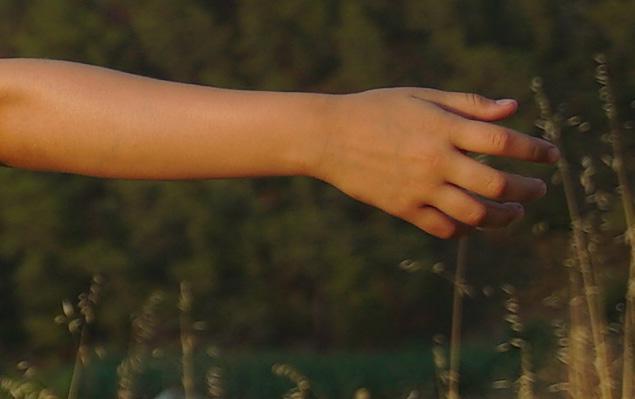
GREGORY OKE•AFTERSUN CINEMATOGRAPHY WORLD MARCH 2023 65
Celluloid film production was learnt and ingrained during our time at filmschool, and the look it gives has remained with us
Images: all images courtesy of A24
DIVERSITY OF ONE
ONE
We’ve been encouraged to believe that new technology will revolutionize and homogenize our creation of art. At the turn of the century a major Broadway producer complained about the ever-increasing cost of putting on a show. His foot had come to rest on a stack of film cannisters in the lobby of his grand theatrical palace. He was convinced that film would rescue the world of entertainment. Costs could be contained, and expensive talent marginalized because stage craft and performances would be captured once with an unlimited stream of unincumbered revenue. No more taking the show on the road after its Broadway run, shipping sets, musicians, stage hands, talent and renting theatres from town to town across the country.
The finest technology, no matter how perfect, can never create a work of art. Those tools allow expression through an individual artist. The same tools under the direction of others will respond differently. They assume the emotion and personality of their user.
What’s so extraordinary is that, based upon our personal journey, communal or national bias and eccentric behavior, we respond in uniquely diverse ways. How then can we possibly come together to create a unified expression that will not seem cacophonous?
The members of an orchestra come to the concert with their own perspective and their own egocentric desire to express themselves as individuals. The only similarity amongst all of them is often their formal attire. When observing them play, their body language contorts differently when playing the same note, the same phrase. How then can we possibly unify them into a concert created by the composer and its conductor?
The same can be said about a motion picture. We come together with a unique set of skills and personal biases. Each performer, whether an actor,
grip, sound mixer or cinematographer, must find their place within the structure of the material. In effect, all that knowledge, bias and perspective must be channeled into an embraceable means of telling the story.
contributions of the many form a uniquely different piece of work.
One Sunday morning, William A. Fraker ASC was chatting with a group of directors and cinematographers about the authorship of a film. Billy suggested that they all go over to MGM and ask the guard to open Stage 16. “We’ll stand in the midst of the empty stage and shout ‘ACTION’.”
Obviously, no film can be created without the support of a team of disparate filmmakers. They may all dress differently, have personal preferences, diverse skills and desires, but at that moment when the baton is raised, or the director calls for action, the many become one.
It is suggested that a communal work of art must have an auteur. That suggests a leader with such a personal influence and control that they alone are the creator. That may be the case on an individually-created work of art and yet it cannot be so in a commercial art form such as the cinema, the theatre or an orchestra. The combined talent, worldview and circumstantial path taken individually
The expression of ideas must unify across a diverse community. Those who suggest that there is a Hollywood film or some other national endeavor must realize that many matriculate to communities formed with like minded artisans. Historically the finest Hollywood filmmakers came from other countries. We often forget the value of a divergent community coming together into a unified expression. One of our master cinematographers, Gregg Toland ASC, was born in Kentucky, others come from Australia, Great Britain, France, Poland and Germany.
The same could be said of one of Great Britain’s finest producer/directors, Alexander Korda. We dress, speak and believe differently and yet, in many art forms, that diversity of thought and heritage creates the unity of one. A “one” that bonds into an extraordinarily broad and wise simplicity that makes masterpieces of the cinema, music and theatre.
is influenced by the many. To suggest that any film is the sole property of one voice discounts the value of each contributor to the final project. Certainly, the many have to be congealed into a singular expression, but each one of those contributors has spent a lifetime of practice and study in order to come to that moment.

A perfect example is the same score or a remake of a film. Even with the same script the
The death of any great society occurs when art and culture are segregated into elitism. We must endeavor to embrace and learn from all of those who seek to express their vision of the past, present and the future. Diversity of thought and actions is healthy. The discovery amidst that diversity can meld us into another cultural revolution. We must never reject a journey outside of a comfortable bias. For those journey’s reveal the potential that remolds society.
66 MARCH 2023 CINEMATOGRAPHY WORLD
ROY H. WAGNER ASC FRPS•LETTER FROM AMERICA
Diversity of thought and actions is healthy
When the baton is raised, or the director calls for action, the many become one
“NAB Show allows me to learn about gear that I might not see, or a rental house might not show me. And the great thing is I get to see everything in one place.”
—Eric Fletcher, SOC - Technical Chair
LIGHTS. CAMERA. ACTION. THE GEAR IS HERE
Experience the broadcast, media and entertainment industry’s unrivaled event for must-see tech, tools and gear. Connect with a global community of content creators, cinematographers, editors and crew. Get hands-on with products that enable the future of the art of storytelling.

You’ll find everything to master your craft in CREATE, the most massive of four distinct show floor destinations. Learn advanced cinematic techniques, engage with the leaders of Cine Live and hear from the best in Hollywood. NAB Show has it all. REGISTER NOW with code MP04.
INCREDIBLE, IMMERSIVE EDUCATION
Level up with ASC Cinematography Lighting Workshops, ACE Editorial Workshops, the NAB Show Conference CREATE Track and/or Post|Production World.
NABShow.com

EYES OF THE BEHOLDER
Filmography (so far): Enzo (2021, dir. Sasha Tuz), Master And Margarita (2021, dir. Sophie Muzychenko), Rembrandt (2022, dir. Sasha Khomenko), documentary Shadows Of The Previous Life (2022, dir. Sophie Muzychenko), Lolly (2022, dir. Patrick Kennedy, co-credit with Seamus McGarvey BSC ASC), adapted scene from Lillian Hellman’s 1934 play The Children’s Hour (2023, dir. Haley Bennett).
When did you discover you wanted to be a cinematographer?

I remember when I was about five years old, and my granddad gave me my first film camera, taught me how to use it, how to set-up lighting and composition. We spent hours in the darkroom through all my childhood. It was always a lot of fun, but I never thought about it as a job.
Much later, in a book shop in my small town, whilst having a chat with friend about Andrei Tarkovsky and his film Nostalgia (1983, DP Giuseppe Lanci), I realised I wanted more than photographs, something more powerful and more influencing, that could touch hearts. And that was moving images and creating narratives.
Where did you train?
So here my story begins. When I was 16, I went to Kyiv National I. K. Karpenko-Karyi Theatre, Cinema & Television University, Ukraine, where I found the second person, after my granddad, who gently directed me towards discovering my own vision. This person was my mentor, the cinematographer and writer, Bogdan Verzhbitsky.
University helped me to understand that everything is possible, if you really believe in the idea of what you’re doing. You can do whatever what appears in your head and it will come to life, however crazy it might sound.
For example, we once we had to choose a painting that we’d like to create a story behind, so that the final shot was a recreation of that painting with the same light and composition. I thought it would be nice to challenge myself, and I chose a most complicated one, Rembrandt ’s 1634 painting Decent From The Cross, for the film called Rembrandt. We had to make, light and shoot a four-metre-high cross for that!
University also helped me to understand the need to keep going despite no-one believing in you. After you graduate, it’s really important to keep an experimental
feeling going, to listen to your inner voice and instincts about visuals, and to be ready to turn-on the camera and discover something even more interesting.
Tell us about any lucky breaks you’ve had?
My first break was really exciting and really painful at the same time – a real turning point in my life. When Russia fully-invaded Ukraine, I went to Poland to stay with my sister. There I was in despair about what was going-on in my country, in my home, and about my beloved granddad passing away.
So I tried to find ways to continue my study. I wrote a message on Instagram to one of my favourite DPs, Seamus McGarvey BSC ASC, something like, “I would love to have the chance to chat about art or cinematography.” We had never met before, so I didn’t expect he would reply. But answered my text saying, “Come to Tuscany or to London”.
A Well For The Thirsty (1965, dir. & DP Yuri Ilyenko)
– a Ukrainian movie that was shot on film that was specifically used for sound recording, and had only a three T-stops of dynamic range and high contrast. The faces are little more than outlines, giving the audience few specifics, and that was a creative decision to create a pure, artistic picture. At that time, quality standards were very precise, especially in totalitarian USSR, which was trying to kill any sign of poetic Ukrainian cinema. Because of its ‘incorrect’ exposure, the lab that controlled quality didn’t let this film come out until 1994, after Ukrainian independence in 1991. The Cranes Are Flying (1957, dir. Mikhail Kalatozov, DP Sergei Urusevsky) – I love this movie with its movement, angles and the feeling of how the light highlights only important narrative details. The scene from the stairs, or how Veronika runs to the train station, are still so powerful. Also, this movie is a great antiwar manifesto, and I now sense that in a much more sensitive way.
What’s the best advice you were ever given, and from whom?
From Ed Lachman ASC, one of my cinematographic heroes. I met him at Camerimage 2022. He said, “The important thing is that we look inside and outside ourselves with new eyes.”
So I did and we’ve been working together ever since. Seamus has introduced me to some of the greatest directors and industry professionals, and I’m so grateful to him. Honestly, he is the kindest, and most vivid, person I have ever met in my life. You could never meet as warm a human being as he is. Since that time everything has been so surreal.
What are you favourite films, and why?
All About Eve (1950, dir. Joseph L Mankiewicz, DP Milton R Krasner ASC) – it’s so fascinating how every detail, every shot, every cut, every sound and every movement in the actor’s performance works for the idea of the film and brings everything together.
Paris Texas (1984, dir. Wim Wenders, DP Robby Müller) – the greatest example of colour lighting in all cinematographic history. The only one I could compare it to is The Red Shoes (1948, dirs. Michael Powell/ Emeric Pressburger, DP Jack Cardiff BSC).
I try to interpret this as every story needs to have its own visual language, through new eyes. Ideas that suit one narrative, would never fit another. Every film has its own distinct journey or exploration, with different aims and proposes. Always as a DP you have to question who is looking, how your characters see the world, and what they highlight in the story.
What is one thing you wish you knew when you were starting out?
Despite the really important technical aspects of our job during pre-production and production – like which lenses you want, which camera or resolution – in the end, in the movie theatre, there’s only one thing that the audience will experience, and that’s your visual language, your way of telling story creatively. Everything else for them doesn’t matter.
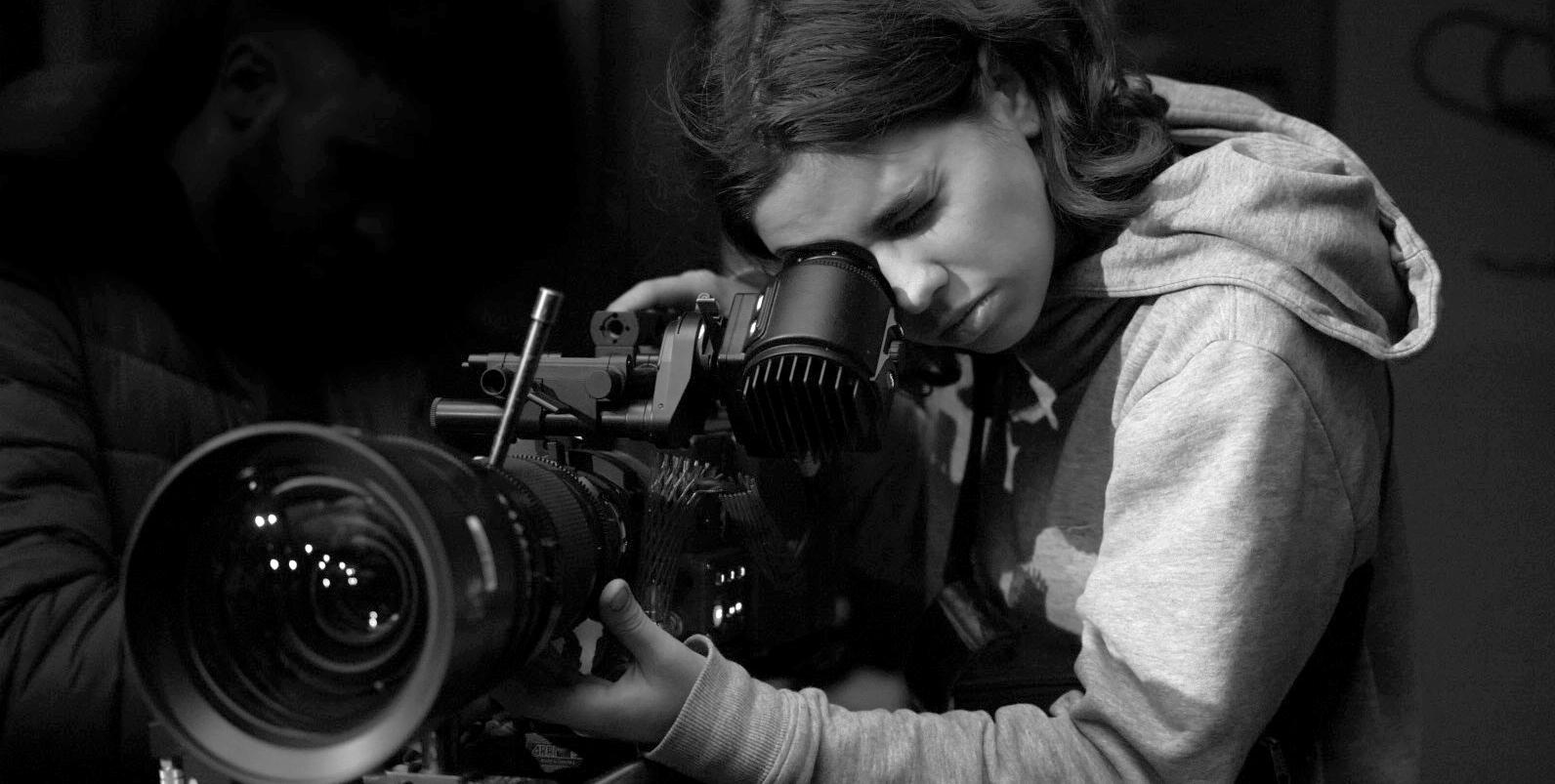
Where do you get your visual inspirations?
From any form of art. I love to read and imagine stories. Sometimes writers are so precise with their words, that you can literally see the image. Also, I love
68 MARCH 2023 CINEMATOGRAPHY WORLD ONE TO WATCH•SOPHIE MUZYCHENKO
Everything is possible, if you really believe in the idea of what you’re doing
spending time in museums, especially in front of Flemish masterpieces. I can spend hours in front of Rembrandt’s paintings, just discovering the light, and observing faces on the canvases. My next stop is always ancient sculptures, going back to the simplicity of art and the artistic image. They are timeless.
What’s the hardest shot/thing you’ve had to light/frame?
Definitely the four-metre-high cross in the film Rembrandt, where we were recreating Rembrandt’s Descent From The Cross and the story behind it. I wanted to create a moving image with every detail in mind; my vision was for his painting to come fully-alive. In the final shot I recreated the light and composition of the painting itself. Rembrandt as a painter had the most significant way of lighting figures, so I experimented a lot to find what could work for this particular film. We couldn’t use fixtures like Astera NYX bulbs, because we needed to see the source of lighting. We required something more specific. So I invented my own ‘candle’ light that looked like a candle, but has the power of 150W Dedolight bulb. It was an exciting journey using all the possibilities of the language of light, shadow and contrast. It was like first love. Two days before the end of filming, I burst into tears when I realised that production would soon be over and I would never experience such emotions again, even if I make a million films, a hundred thousand times longer than this.
Who would you invite to your dream industry dinner party?
Of course, Seamus McGarvey BSC ASC, Joe Wright and Haley Bennett. Definitely John de Borman BSC AFC and Ed Lachman ASC too. It would be great to see my mentor, Bogdan Verzbitski, there as well. I’d also bring Charlie Chaplin, Harry Dean Stanton and Ingmar Bergman. Besides them, Natalie Kingston and Charlotte Bruus Christensen DFF would be on the invitation list. They would all be really interesting, warm company, with great stories.
In the entire history of filmmaking, which film would you love to have shot?
Something that changed the way of looking at cinematography, something that brought more emotions to the image, the way of looking at the story. Something like Carl Theodor Dreyer’s The Passion Of Joan Of Arc (1928, DP Rudolph Maté).
The scene at the court is a literal verbal attack, and the evocative shape of contrast light to show Joan’s innocence, combined with camera movement that is travelling continuously from one close-up of a judge to another, it’s all so tense and powerful. You can feel goosebumps when you’re watching it. That’s the kind of movie that I’d love to shoot, one that can touch the deepest string in human hearts.
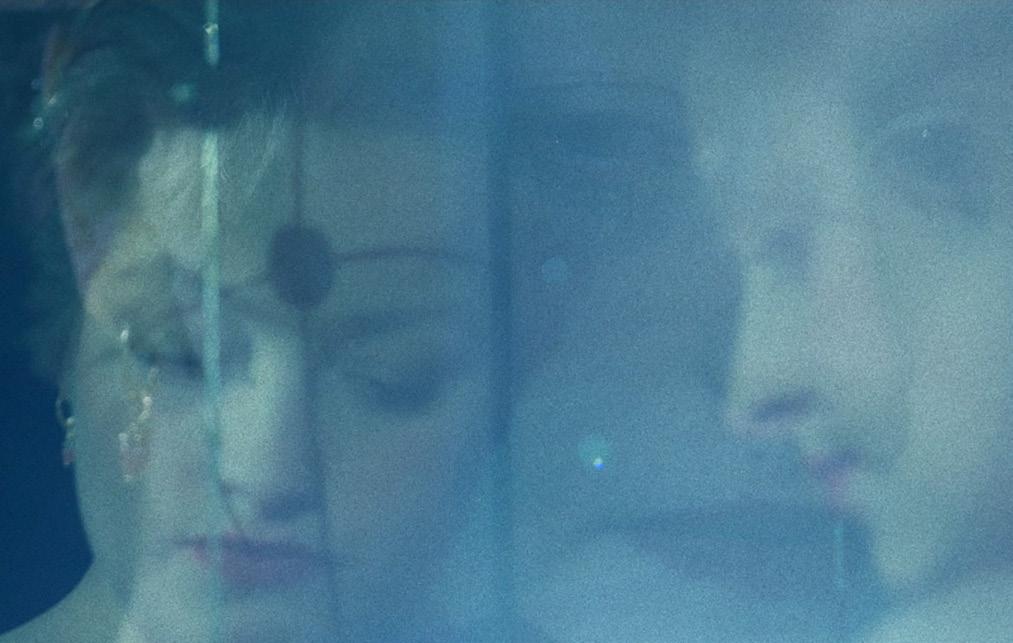


Give us three adjectives that best describe you and your approach to cinematography?
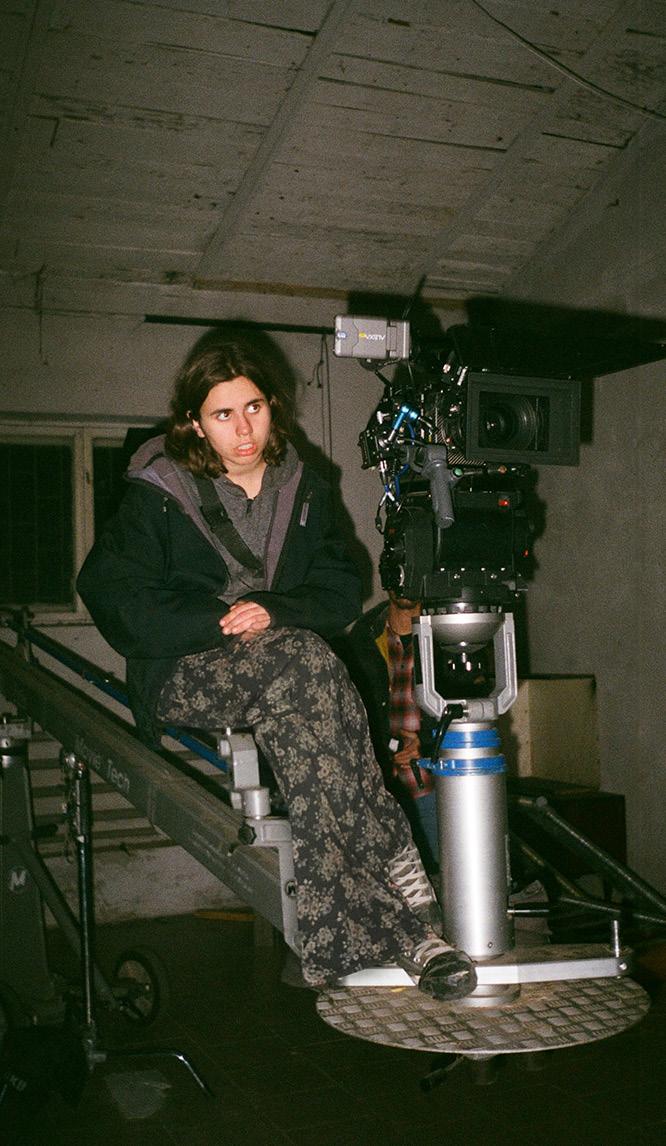
Purposeful. Empathic. Resourceful.
If you weren’t a DP, what job would you be doing now?
Definitely, I would be a painter. I thought about it when I was a kid. I love light and composition, and how the placing of objects can manipulate people’s attention. This is a reason why still-life as a genre is the most complicated. Every chaos in a painting is very thoughtful and not accidental.
I’m doing the same in films to bring life to the picture. The camera is only a tool, like a pencil, that creates a drawing with light and shadows, but instead of a blank canvas we have reality.
What’s up next for you?
I’m working on my debut feature film with a great director.

Who is your agent?
I don’t have an agent at the moment.
What is your URL/website address?
https://sophiemuzychenko.myportfolio.com/
What is your most treasured cinematographic possession?


Confidence in what I’m doing, and strong energy.
Tell us your greatest extravagance?
A Hasselblad XPAN that Seamus gave as a present for my 20 th birthday.
Do you have a hidden talent/party trick?
I’m really good at playing the piano. It gives freedom for my imagination.
It’s fascinating how revolutionary that film was in the 1920s and ‘30s. Because no one knew the rules of how to shoot, no one taught them how to shoot, which meant that generation had such purity of creativity.
What are your current top albums?
Since the war started in Ukraine, I have experienced the feeling of loss in my heart.
The top album I love is Nick Cave’s Carnage
It’s helped me feel like I’m not alone in my despair and everything will heal with time – that everything is leading to something bigger.
SOPHIE MUZYCHENKO•ONE TO WATCH CINEMATOGRAPHY WORLD MARCH 2023 69
Sophie frames Seamus!
FUTURE FILM STARS
By Larissa Mori
Over the past ten years, the number of Finnish films screened at international festivals has almost doubled. In 2022, audiences saw a Finnish feature showcased at Sundance’s World Cinema Dramatic Competition for the first time ever. Called Girl Picture (2022, DP Jarmo Kiuru), the teen romance about three young women trying to defy the persistent winter darkness in Finland, directed by Alli Haapasalo, promptly won the audience award, and became Finland’s official submission for the Academy Award for Best International Feature Film 2023.
As more filmmakers like Haapasalo become household names, it’s clear that Finland’s film schools are doing something right. This is certainly clear when you look at Kpedu. First started in the 1980s, Kpedu’s media school, based in the town Kokkola, is Finland’s oldest media school to date and now offers 30 different programmes in everything from photography to multi-camera production.
Practical training at any age
“First and foremost, we’re a technical school,” begins Kari Kaasinen, project manager at Kpedu. Now one of the institute’s senior educators, he had his start in the industry working at Nokia before moving into teaching teenagers with special needs in 1991. He then joined Kpedu in 1995, where he spent almost a decade educating unemployed
adults before focusing his efforts on Kpedu’s media school, called Mediacenter Lime. There, he helps to manage the education of small classes of up to 40 students – ranging from 15-year-old teenagers who want
opportunity to get hands-on using professional cameras and working on-set with a diverse team. Last year, Kpedu even installed a professional-grade virtual studio that students could work in to boost their CVs.
Future-proofed skills in virtual production

Supported by funding from local municipalities, as well as the European Regional Development Fund, the studio was installed by Broadcast Solutions Nordic. It features a 6 x 7-meter greenscreen with four Panasonic AW-UE150 PTZ cameras, two of which are equipped with a Totem elevation unit, and one of which has both a 10-meter Technopoint dolly and an elevation unit. All camera feeds are fed into two Zero Density Re Ampere workstations that run two real-time image-based Reality Keyers and RealityHub, enabling any student to broadcast ultraHD Unreal Engine visuals ‘live’ for any project shot at the studio.


vocational training, all the way to adult professionals looking to change their careers.
“We offer short training courses for anyone who wants to extend their knowledge, or full threeyear undergraduate degree courses in multimedia production,” Kaasinen explains. “For our three-year courses, students will typically first do a foundation year where they get to try a little bit of everything, from photography to videography, editing and animation. After that, they get to specialise by spending the following two years training in what they are most excited about, whether that’s graphic design or multicamera production.”
For aspiring cinematographers, this flexibility offers the ultimate creative freedom. At the start of the course, everyone gets given a personal development plan with individual goals that take their previous experience and industry qualifications into account. Kpedu’s “learn by doing” approach means students quickly have the
“The virtual studio is just another example of the technical training that Kpedu is so well known for,” says Antti Hotakainen who works with Kaasinen as a media teacher at the school. “During the coronavirus lockdowns, we held several remote events, and we realised that being trained to work in virtual environments would probably help our students get more job opportunities in the future, whether that was as a camera operator, director, or robotics operator. That’s why we decided to build the stage.”
Once the build of the virtual studio was complete, the school decided to use it to provide free productions for twenty local companies that needed a boost after the pandemic, helping them create everything from product launches to PR announcements in real-time – all whilst ensuring students got the experience of working on-set.
“With the studio in place, we got the students involved in all sorts of projects, including a new brand launch for a news media company, which we created in the virtual studio. We’ve also scheduled a live sports event broadcast this year,” adds Hotakainen. “Throughout it all, Kpedu students will
70 MARCH 2023 CINEMATOGRAPHY WORLD
STUDENT UNION•KPEDU MEDIA SCHOOL – FINLAND
Being trained in virtual environments will probably help our students get more job opportunities in the future
be operating and managing the whole multi-camera feeds, as well as all the Reality Engine graphics. Even the director will be a student.”


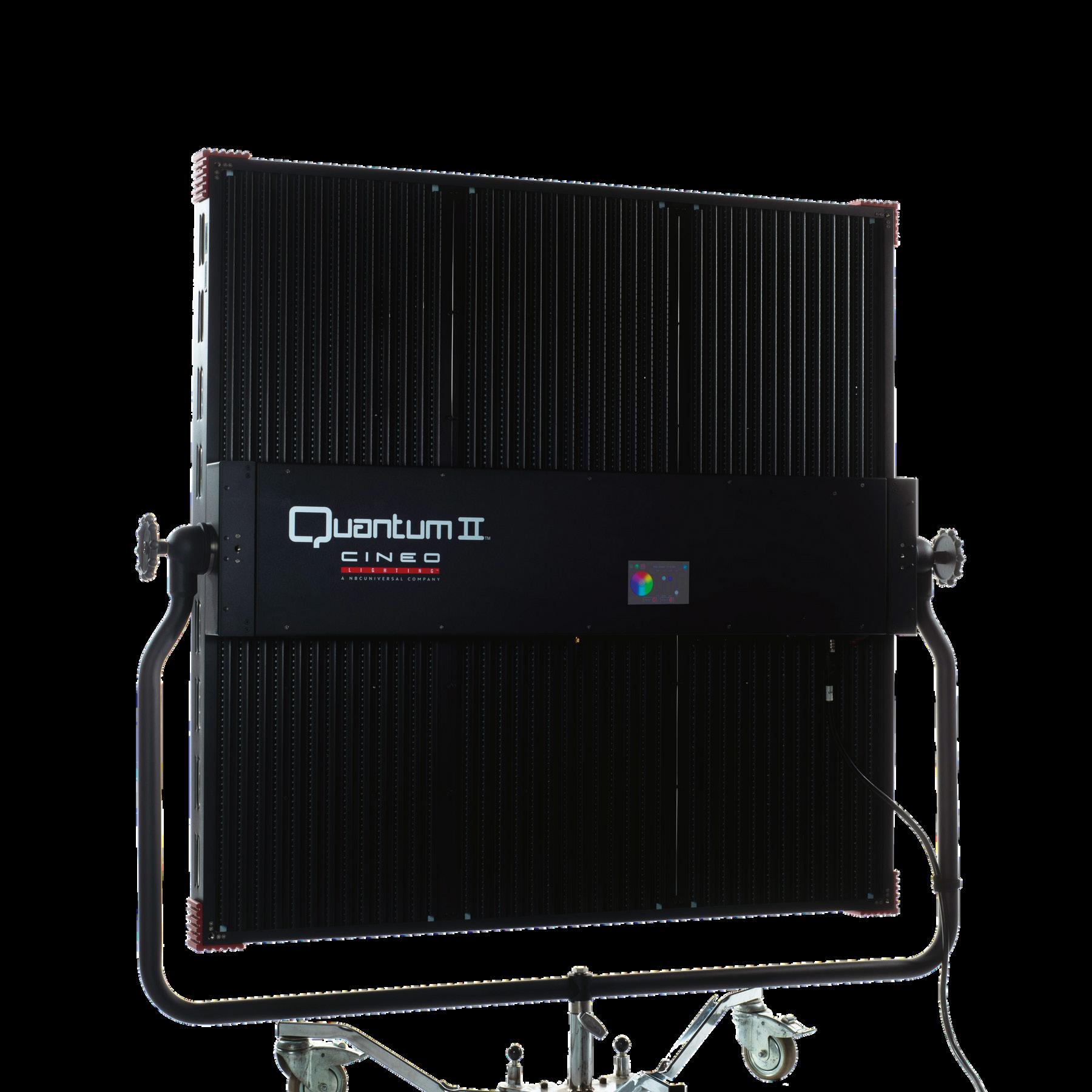




Supporting Finland’s creative future

As Kpedu plans for 2023 and beyond, both Kaasinen and Hotakainen aim to ensure the school’s students continue to contribute to Finland’s creative boom. So far, Kpedu graduates have gone on to work for Finland’s national broadcaster, YLE, and to even win Cannes Film Festival awards for their work. Several have also been hired to support the school’s virtual studio productions as directors.
“For the future, we’re looking forward to growing while still staying true to our core values: teaching the practice alongside the theory. We never want to tell a student they can’t touch a camera or operate in virtual production. Instead, we want to show them exactly how it’s done, right from the very start.”



KPEDU MEDIA SCHOOL – FINLAND•STUDENT UNION
1,500 watts Water resistant 100,000 Lumens sales@cineolighting com cineolighting com 40 kg Just a shipment away - available globally! E x p e r i e n c e t o t a l c o n t r o l o f C i n e o L i g h t s v i a t h e t o u c h s c r e e n i n t e r f a c e o r t h e m o b i l e a p p ! D O W N L O A D T O D A Y !
We never want to tell a student they can’t touch a camera
WORLD’S END
By Darek Kuźma
Whilst Polley and Montpellier’s previous feature films – Away From Her (2006) and Take This Waltz (2011) – asked substantial questions about the fallibility of human relationships and the myriad ways we forge our identities based on the strength or instability of our bonds with our partners, they were nowhere near as emotionally-complex as those in Women Talking
The story takes place in 2010 in an isolated Mennonite colony, where the women realise that the terror they have been facing for years – waking up with legs bruised and sheets stained with blood – is not the work of demons, but several men who have been drugging and raping them and their daughters. As the monsters are finally caught, the community’s female representatives gather in a hayloft to discuss if they should stay and forgive, or leave and thus resign from the kingdom of heaven.
“Sarah is an artist and activist who tackles subjects that are trying to change the way we think, and she does it in a very honest way, showing the good and the bad. I’d do any film with her,” says Montpellier.
His chief task was to bring a cinematic experience to Polley’s dialogue-heavy screenplay, based on Miriam Toews’s 2018 novel of the same name, inspired by analogous events in a Mennonite colony in Bolivia. You see, the Oscar-nominated film really is about women talking (with one trusted man present in the loft to take minutes, because they have never been taught to read or write). Because the colony’s men have gone into town to bail out the assailants, the women have two days to arrive at a decision: stay in the name of their faith and imperil everything they ever loved, or go against everything they ever believed in and – having never seen the outside world – travel into the unknown.
One of the most vital decisions was to infuse the
story with a heavily-desaturated colour palette that Montpellier equates to that of a faded postcard.
“Sarah wanted the images to feel epic and gothic, to stylistically mirror the repressive world the characters live in and bring the audience closer to the women’s dilemma,” he explains.
“We initially toyed with the idea of shooting B&W but we felt this might give the film a period look that would make people emotionally disconnect. Yes, the colony is frozen in time, they don’t use technology, but it exists in modern world. This kind of patriarchy and ideas of the roles of men and women still exist.
life in the Mennonite colony, they often referenced the work of Canadian photographer Larry Towell.
“He got unprecedented access to Mennonite colonies and his B&A and colour images were a big touchstone for us. His photography is full of emotion without really complicated framing.”
Despite the fact that the bulk of the film takes place in the hayloft, the camera has a tendency to wander off, peek outside and reveal the colony’s gorgeous open fields and vistas, while the filmmakers often give us glimpses of the children playing in the sun. This was purposefully designed not only to give the audience room to breathe but also to emphasise the beauty and serenity of this life that makes the decision to leave additionally painful.


“We didn’t want the film to feel like a stage play, and we spent lots of time dissecting every line, discussing every shot, camera move and change of axis,” says Montpellier. “I decided to shoot using the large format Panavision DXL2 camera with Red Monstro sensor. To support Sarah’s idea of an
“During tests we found that when you suck all the colour away, it can be disheartening, but it also makes you truly look and listen to what’s important. The film is uncomfortable to spur the discussion.”
The colour palette was established early in prep so that every other department – from costumes to production design – would take it into account. Montpellier collaborated with his long-term colourist Mark Kueper at Toronto’s Picture Shop on the appropriate LUT.
“We made it based on our instinct and feelings, just like with every visual element in this film,” he notes. Working their way into understanding everyday
epic scope, I equipped it with Panavision UltraVista Anamorphic lenses. I was curious about filling the sensor with as much information as possible and de-squeeze it into a 70mm-like image to enhance the immersion, and to make you feel every pore in the skin, every blade of grass, every detail.”
In addition to Ultravistas (35, 40, 50, 65, 75, 100, 150mm) he also shot with a modified 42425mm Panavision Anamorphic Zoom.

Initially, Montpellier was adamant about shooting Women Talking in 2.40:1 aspect ratio but the camera and lenses package made him re-think this.
“De-squeezing the UltraVistas on the Red Monstro in tests gave images in 2.76:1 aspect ratio, with 91% of the sensor area used. The picture was still sharp, soft around the edges and had this beautiful quality that only Panavision legacy Anamorphic lenses have,” he reminisces.
“Sarah and I, we both fell in love with the 2.76:1 and it worked really well with the concept of depicting the women as a collective. We could have six or seven close-ups in the same frame, giving amazing intimacy to the discussion inside, whilst also juxtaposing these images with the celebration of life that goes on outside. We didn’t want to be judgemental. In the novel, the characters barely leave the loft, but we wanted the viewers to experience their lives as closely as possible.”
Perhaps the most striking decision was to shoot most of the film in a studio.
“With this amount of dialogue, the film taking
72 MARCH 2023 CINEMATOGRAPHY WORLD
WOMEN TALKING•LUC MONTPELLIER CSC
DP Luc Montpellier CSC’s elegant and evocative cinematography helped to take the emotional and verbal brilliance of Sarah Polley’s Women Talking to the next level.
Shooting 2.76:1 worked really well with the concept of depicting the women as a collective
I had to be in a position to remain in magic hour for days
place over 48 hours, and our cast going to really dark places, I needed to have full control over the environment. In a way, I needed to freeze time as Sarah’s script was very precise that scenes, sometimes over ten pages long, were done at sunrise, sunset, dusk, etc. So I had to be in a position to remain in magic hour for days,” he reveals.
“We built a full-scale, two-level replica of a barn we found during our location scouts. Based on that, production designer Peter Cosco designed the whole colony, different structures and roads, to be surrounded with 270-degrees bluescreen, so that we could give the audience a sense of the place. This isn’t a big VFX film, but it needed a lot of keying, so I consider it to be my victory that no one notices that.”
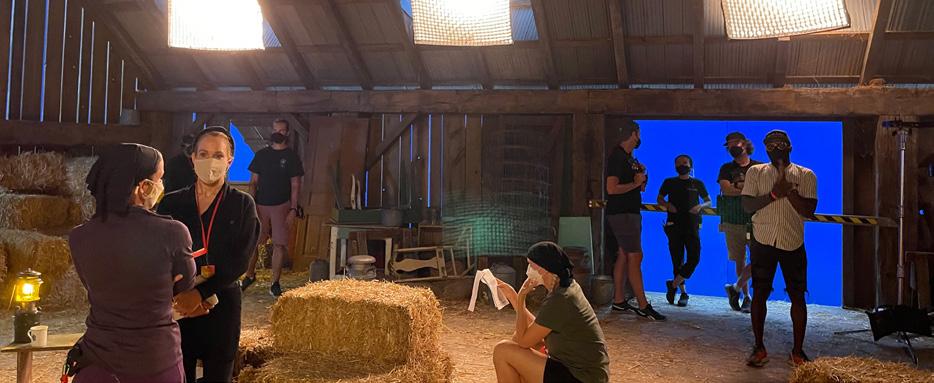
Principal photography took place from July to September 2021, with the studio work being done in a former convention centre in Toronto, which had closed down because of Covid.
It was not a proper soundstage, but it had a 60foot ceiling. This was helpful as we needed to elevate the set so as to be able to drift our camera outside of the window in order to remind the audience what the women are fighting for. We had a 3D model in which I could test lenses and measure distances, and we ended-up with bluescreen almost 30-feet below the frame line,” he notes.
The original plan was to start their 39-shooting days with location work and then move to the studio, but the weather proved capricious.
“I had been given all of the background plates
to know exactly what should be happening with the light outside of the hayloft, but because of the rain we had to go back and forth and I had to look in my crystal ball to match some things.”
To light the loft and the space outside Montpellier and his team used some of the most reliable sources around.
“We talked about LED walls but they were beyond our budget. My gaffer Scott Phillips and key grip Rick Emerson made a series of softboxes, each with four ARRI SkyPanel S60s, that surrounded the set together with 20K Fresnels on tracks. So, I could literally create any time of day I wanted at any time and control exactly where the sun was going to be for every scene. Because they were colour-shiftable LEDs, I was also able to angle everything to push more softlight through a barn door and raise or lower the sky. Peter Cosco also built hatches in the roof that could be opened-up, so that I could lower a Chimera overhead as another source, and I was able to move swiftly and do quick resets. It was seldom I had any lighting instruments on the floor.”
Another thing Montpellier had to keep in mind was emphasising the growing tension of the passing time.
“The women know that the men can return any minute, thus light needed to constantly shift throughout the film. Having such a little amount of colour in the image helped to move this idea forward, to show the coolness of the magic hour shifting into night shades whilst the decision has still not been made.”

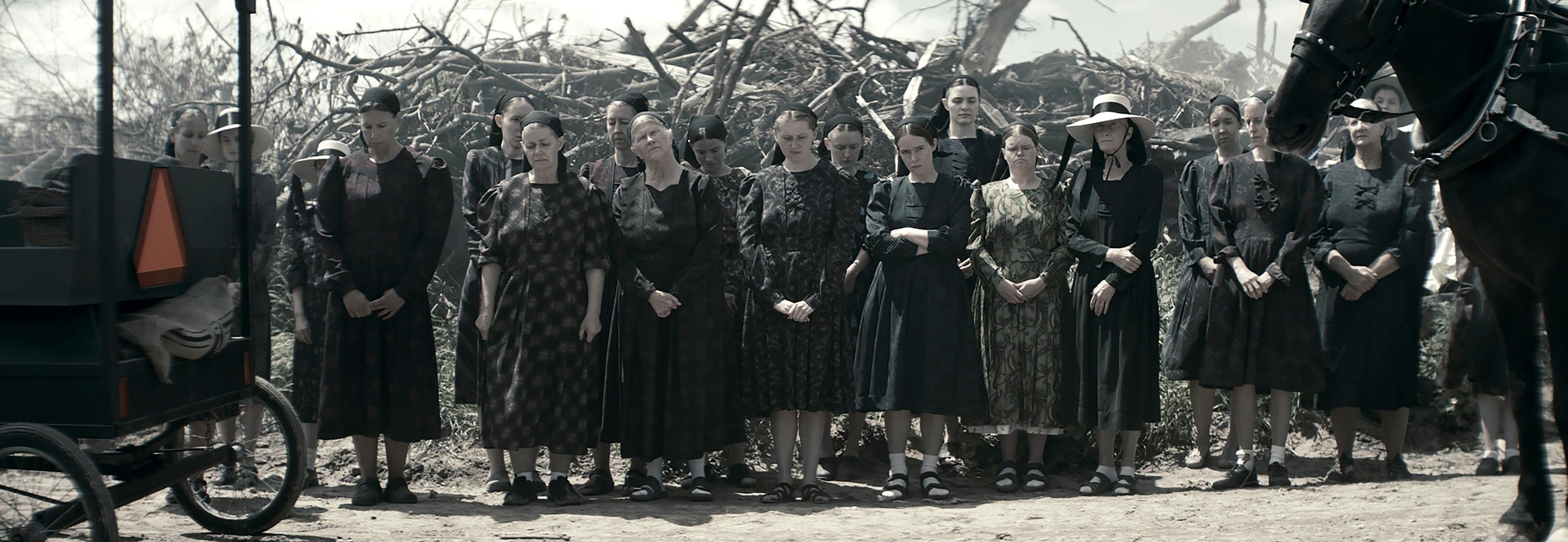

Apart from the occasional glimpse into what
happens outside, the filmmakers also offer the audience a number of subtly interwoven flashbacks of the women waking-up in terror at dawn.
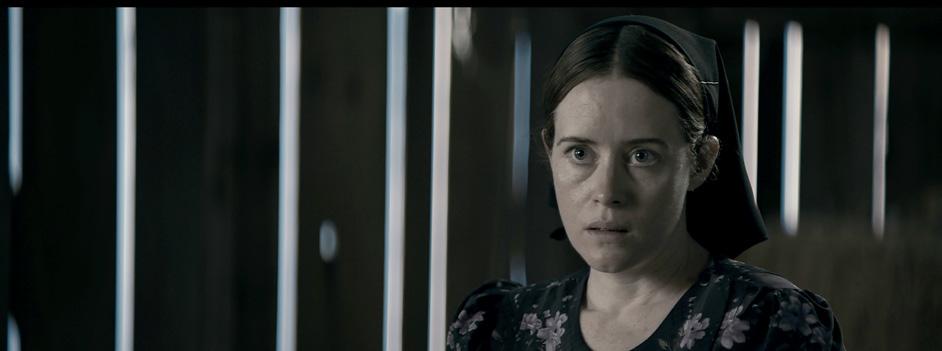
“We never wanted to show these horrible acts, but seeing the women’s reaction to them through an overhead shot has a lot more emotional impact. No optical tricks, just sheer visual honesty. The only thing I did was to shoot some of them with a 45-degree shutter to make it more visceral, often filled with melancholy.”
“The film is tough to watch but it makes us think about how we interact as human beings, how the patriarchy affects everyone, how even the innocent men are complicit in this atrocious thing.
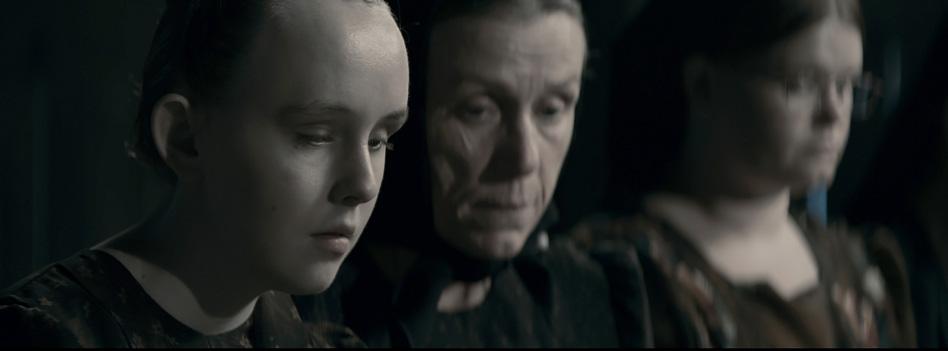
“It was the hardest project I’ve ever worked on emotionally and physically. Each night, after wrapping-up on-set, Sarah and I had long discussions about the next day’s work. I was very appreciative of what we were doing, and I wasn’t the only one. You could feel the motivation in and around the set, people really wanted to work on Women Talking,” says Montpellier.
“A film director once told me that he likes to work with me because I have a bit of Fellini in me, meaning I’m a visual storyteller who brings something extra to the work I believe in. On this film, I felt we all had a bit of Fellini in us, creating something that will hopefully last and change some minds.”
LUC MONTPELLIER CSC•WOMEN TALKING CINEMATOGRAPHY WORLD MARCH 2023 73
COSTA DEL CRIME LORDS
By Ron Prince
ATown Called Malice is a raucous and visually-vibrant eight-part crime series, created by writer/director Nick Love for Sky Max, also showing as a full box-set on Now.
We met-up with DP Chas Bain and director Jamie Donoughue, who worked together on the first three episodes of the series, to get the low-down about their work, and to discover more about their blossoming creative collaboration.
But first, a few details about the show itself. Opening in Bermondsey, southeast London, during the 1980s, the action focusses on the criminally-leaning Lord family, who once ruled the manor with iron fists, but see their long-feared power starting to peter out.
Gene Lord, the youngest in the family, has hopes of going-straight as a newspaper editor, but the family’s dodgy dealings soon bring him back into the feudal fold. When a policeman is killed in a turf war against would-be rivals, Gene and his girlfriend, Cindy, flee to the Costa Del Sol seeking refuge. But, with a psychopathic uncle, double-dealings, gunshots, even more deaths, plus a dogged local detective on their trail, this only leads to even more shenanigans by the Spanish seaside.
A Town Called Malice is not the conventional, gritty, crime caper you might expect. The London backstory excepted, it is unashamedly bold and vivid, and somewhat tongue-in-cheek too. The show opens with Boney M’s ‘Ma Baker’ and closes with The Jam’s 1982 upbeat hit, ‘Town Called Malice’. The band’s leader, Paul Weller, has a brief cameo in episode one, ordering a pint in the local pub. The cast and blood-spattered lens break the fourth wall. Title cards, in huge font sizes, announce big set-piece punch-ups, such as ‘The Battle of Bermondsey’.
Foot-tapping pop music from the period accompanies and propels split-screen action. Indeed, each episode is titled after a well-known tune from the era – such as ‘Two Tribes’ by Franke Goes To Hollywood. Even the blanking on the top and bottom of the widescreen TV frame changes colour from time to time – from black to pink or red – depending on the nature of the romantic or combustible action.
Bringing both satirical swagger and gravitas, the cast includes: Jason Flemyng as the hard-bitten patriarch, Albert Lord; Martha Plimpton, the matriarch, Mint Ma; Jack Rowan as the would-be-good Gene; Tahirah Sharif as Gene’s seemingly sweet fiancée; and Dougray Scott as the deceptive and lecherous Uncle Tony.

“Nick Love’s script was one of the craziest and most unique things that I’ve read, totally different to the moody and dark dramas that Chas and I have shot before,” says Donoughue, who worked initially with Bain on The Last Kingdom (2017, two episodes), followed by Endeavour (2019, one episode) and A Discovery Of Witches (2022, four episodes). Before his entrée into helming high-end TV drama, Donoughue enjoyed a career in music videos and was Oscar-nominated for his short film Shok (2015, DP Philip Robertson).
as the script was driven by the songs, we talked about choreographing camera moves with the actors that cut to the beat of the music.”
Donoughue adds, “We didn’t attach ourselves to any specific movie references per se, but did study a lot of the classic music videos from the period. Our main inspiration came from the look-and-feel of the framing in comic books, and how the pictures in graphic novels jump and transition between different scenarios.”
“Everything I decide to direct needs to challenge and scare me a little bit, that’s where I get most creative,” Donoughue continues. “On previous projects Chas and I were tasked with evolving the look of an existing show. But here we had a completely clean slate, a real opportunity to stamp the production with a distinctive mark.
“Chas understood that we had to be bold and brave in giving the show its own identity – that the characters weren’t just the actors. I wanted the camera, the lighting and the locations, to be characters too. And,
Principal photography, using two cameras in the main, began at locations around the borough of Bermondsey, in November 2021, before the production relocated to Tenerife, doubling for the Costa Del Sol, at the end of January 2022. Bain and Donoughue concluded their stint on the show at the end of March 2022, when DP Aaron Reid paired with Joasia Goldyn, and then DP Felix Leiberg with Sean Spencer, to shoot the remaining episodes, with all production wrapping in June 2022.

“Along with Jamie’s ideas, I recall the original brief from Sky was about the show having an elevated, kind of hyper-real look,” says Bain, whose credits include operating on features such as Quantum Of Solace (2008 dir. Marc Forster, DP Roberto Schaeffer AIC
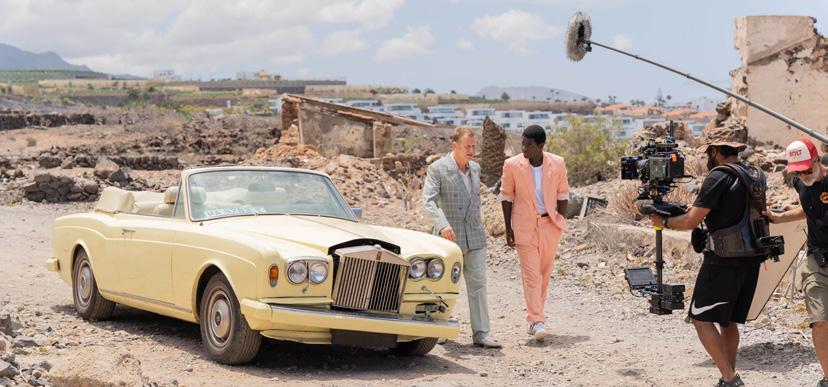
74 MARCH 2023 CINEMATOGRAPHY WORLD
Jamie has pushed me and given me the confidence to be more creative and adventurous with lighting and camera
A TOWN CALLED MALICE•DP CHAS BAIN & DIRECTOR JAMIE DONOUGHUE
ASC), X-Men First Class (2011, dir. Matthew Vaughn, DP John Mathieson BSC), Fast & Furious 6 (2013, dir. Justin Lin, DP Stephen Windon ASC ASC) and World War Z (2013, dir. Mark Forster, DP Ben Seresin BSC ASC).
“Bearing in mind this was an epic family saga, with a need to depict the family together, and portray the sunshine and neon-soaked places you get in Spain, I really wanted to shoot in Anamorphic,” Bain adds.


When it came to choosing cameras and lenses, Bain’s first port of call was to Movietech, now a member of the Sunbelt Rentals UK Ltd group of companies.
“I’ve known Andy Cooper and the team at Movietech for a long time, but had never had the opportunity to work with them before. They took onboard what we wanted to achieve, and the advice and support I got from them was great.”
Bain’s camera package included a pair of Sony Venice cameras, shooting 4K 4:3 squeeze for a 2.39:1 de-squeezed result, with two sets of Cooke Anamorphic prime lenses and Angénieux Optimo zooms. Diffusion was provided through Tiffen Glimmerglass filters.

“I looked at a host of Anamorphic options, like the Atlas Orions and Hawk C-series, but the Cookes gave more of an ‘80s flare, had a bokeh I preferred, and just seemed to give a warmer cinematic feel for the eighties,” Bain explains.
“I had not used the Sony Venice before – the ARRI Alexa Mini has normally been my go-to camera. But, as we were doing this show where everything was going to be slightly different and soaked in colour, I decided to give the Sony Venice a try.
During pre-production Bain created what he calls, “the ‘Golf GTI’ LUT. It gave us a dour-look on our London scenes, but with slightly poppy colours. It only needed a few little tweaks when we shot in Tenerife to give us much
bolder and brighter colours. Our grader Adam Inglis helped us to achieve our final look at Post Republic.”


Whilst the on-screen scenes in Spain certainly deliver a bright and colourful counterpoint to grim and grey London, Bain reports capturing them was not as straightforward as one might imagine.
“We didn’t have constant blue skies and sunshine in Tenerife. In fact, it was often pretty cold, overcast and cloudy. On those days it was all about using powerful lights – like Creamsource Vortex 8s, ARRI SkyPanel 360s and Nanlux Dyno 1200s on interiors, plus daylight lamps like ARRI M90s and M18s on the

quotas and budgets to reckon with,” says Bain.
“But he owned the set straight away. I was impressed by his natural charm to diffuse any situations that came along, his sense of purpose to motivate everyone, including me, to give their best, whilst also being adaptable when necessary to meet the shooting schedule. Over time, he has pushed me and given me the confidence to be more creative and adventurous with lighting and camera, as we were on this production.”
To which Donoughue replies, “I’m quite experimental and like to push boundaries in my work. Chas is always on-board for that, and ready to embrace something new. Working his way up through Hollywood films and high-end TV shows, he’s been there and done that. Having someone to lean on, whatever the situation, whatever the set-up, has really helped me in my career, and it’s great to have him by my side.”
It’s fair to say Bain and Donoughue did what was asked of them in bringing on A Town Called Malice to the screen with style and gusto. We are excited to see their next creative partnership, now confirmed for the finale episodes of the new season of Doctor Who

exteriors – to pump-in loads of light and to give the idea of things being super-sunny the whole time.”
The camera and lighting crew included Jon Beacham on A-camera, assisted by David “Spooky” Churchyard in the UK and Jota Parro in Tenerife. Adam Lyons operated B-camera on the London leg, with Leandro Vaz Da Silva on B-cam/Steadicam and second unit DP in Tenerife. Gaffers on the London stint of production
were Michael Fenelley and Joe Hissey, with and Willy Spruytte taking over the lighting duties during the shoot in Tenerife.
“What I’ve learnt over the years is that because of the fast pace of TV, the amount of scenes and moving around that’s required, it’s better to shoot with two cameras, and even better to have B-camera operators, like Adam and Leandro, who have the ability to DP. We split them off on to second unit or got them involved with pre-lighting up-coming scenes or locations, which really helped with the ambitious schedule,” says Bain.
“I also have to credit Jon Beacham, who understood what we wanted to do, especially in the scenes where we choreographed the camera and the action to the beat of the music. We encouraged the actors to be conscious of the camera, and there’s nobody better than Jon at whipping the camera around them and finding the frame.”
Bain and Donoughue have a clear camaraderie, and are both in awe of one another’s creative and pragmatic talents.
“When I first met Jamie, on The Last Kingdom, his most noteworthy work was his Oscar-nominated short Shok. Whilst that was impressive, I wondered how he might cope being thrown in at the deep-end, on a longform show, with a large cast and crew, daily page-

DP CHAS BAIN & DIRECTOR JAMIE DONOUGHUE•A TOWN CALLED MALICE
CINEMATOGRAPHY WORLD MARCH 2023 75
As this was an epic family saga, with a need to depict the sunshine and neon-soaked places, I really wanted to shoot in Anamorphic
Images: BTS photos courtesy of Chas Bain, Jamie Donoughue and Cristina Ríos Bordón. Images copyright SKY UK.
Chas Bain
Jamie Donoughue
FROM THE HEART
By Iain Blair
Based on the three-minute Internet viral hit of the same name, Marcel The Shell With Shoes On is the funny, poignant and delightful story of Marcel, a chatty, anthropomorphic one-inch-tall shell living with his grandmother Connie (voiced by Isabella Rossellini) who is struggling with dementia. Directed by Dean Fleischer Camp and co-written with SaturdayNight Live veteran Jenny Slate, who also voices Marcel, the film combines live action, shot by cinematographer Bianca Cline, with stop motion shot by Eric Adkins, and animation, supervised by animation director Stephen Chiodo (KillerKlownsFromOuterSpace).


Here, Cline, whose credits include Murder Among The Mormons (2021) and the Peabodynominated Belly Of The Beast (2020), talks about the challenges of shooting the Oscar-nominated film in the animation category.
Give us some insight into your creative collaboration with Dean. It must have been a very different process to normal?
Yes, as this was so unusual and unique. There was no finished script for me, and when I came on-board there was already locked audio –dialogue, music, sound effects, so I watched that. It was like watching an animatic. All the performances were done and they knew how good the film was already. So, we were basically filling in the animatics.
We already knew how long a scene was and how it played, so it was about finding the images to fill the gaps. For instance, there’s a scene with Marcel talking about this and that, and then we had to find a location that worked well for that. We shot most of it in one location, a house in Los
Angeles, but when your main character’s just one centimeter tall that one house is like an entire city. You can find 1,000 locations there. So, in prep, we were in that house every day and found all the locations we needed
How long was the prep and what was entailed?
Prep was about five weeks, which wasn’t quite enough. I did a lot of testing – lenses and processes – as we wanted the final film to feel very natural and look very easy. But it was quite the opposite. It was very difficult.
The goal was to make it feel casual, as if someone had just picked up a camera and started filming Marcel at home. We didn’t want it to look
stop-motion unit, who could see exactly what we were doing.
Then every day Dean would take the footage and insert it into the timeline and basically start covering-up our photoboards with real footage, and we could see how the whole film was developing.
It was interesting as there were so many moving parts between all the various departments, and a lot of them were unique, because no-one had done this before – the mixture of stop-motion, animation, live action. I certainly hadn’t.
too perfect, so the camera wasn’t always so stable. We kept lens flares, and maybe missed focus here and there, so it felt real and a little sloppy.
We shot stills of all the locations and did a photoboard of the entire film, and then covered the storyboards with those photo-boards, so that by the time we began filming everyone could watch finished audio with still images of where we were actually shooting. And that was also great for the VFX and art departments, the puppeteers, and the
We shot it like a live-action film that had a CG character, except that we had a stand-in for Marcel, a finished model of him and his grandmother. We’d put them into the scene and do all the lighting and get focus marks, and move them around on a black stick so we’d know where focus should go, and what the lighting would be like. The lighting had to be replicated on the stop-motion stage, and the puppeteers could see what we wanted to do. Then we’d shoot a scene twice – first with Marcel, then without him, so we’d have a clean plate. The shoot was about 24 days, we did ten weeks of stop motion and then had a lot of VFX work.
76 MARCH 2023 CINEMATOGRAPHY WORLD
MARCEL THE SHELL WITH SHOES ON•BIANCA CLINE
We wanted it to feel natural… but it’s very unnatural to film something that’s 1cm tall from the ground-up
We shot it like a live-action film… and had the flexibility to use handheld a lot
How did you work with DP Eric Adkins and all the stop-motion?
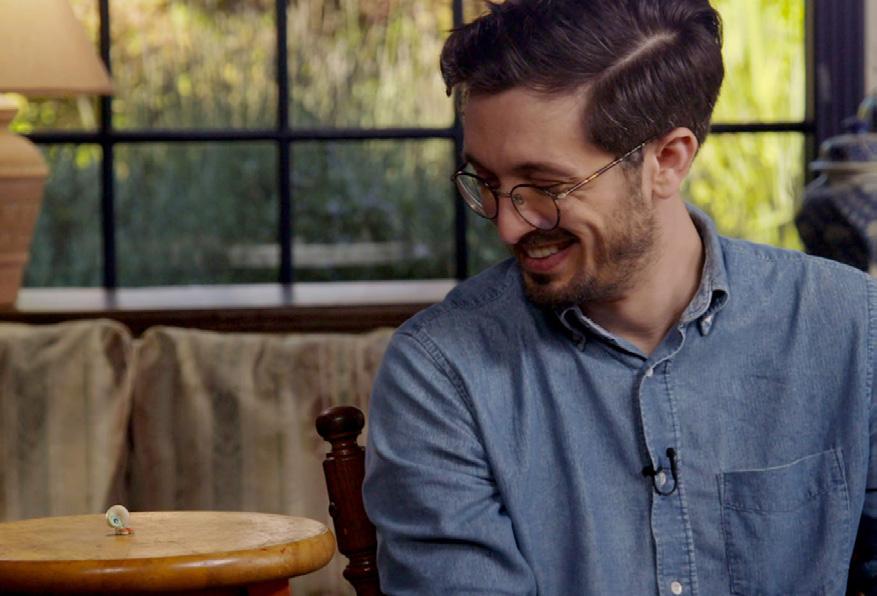
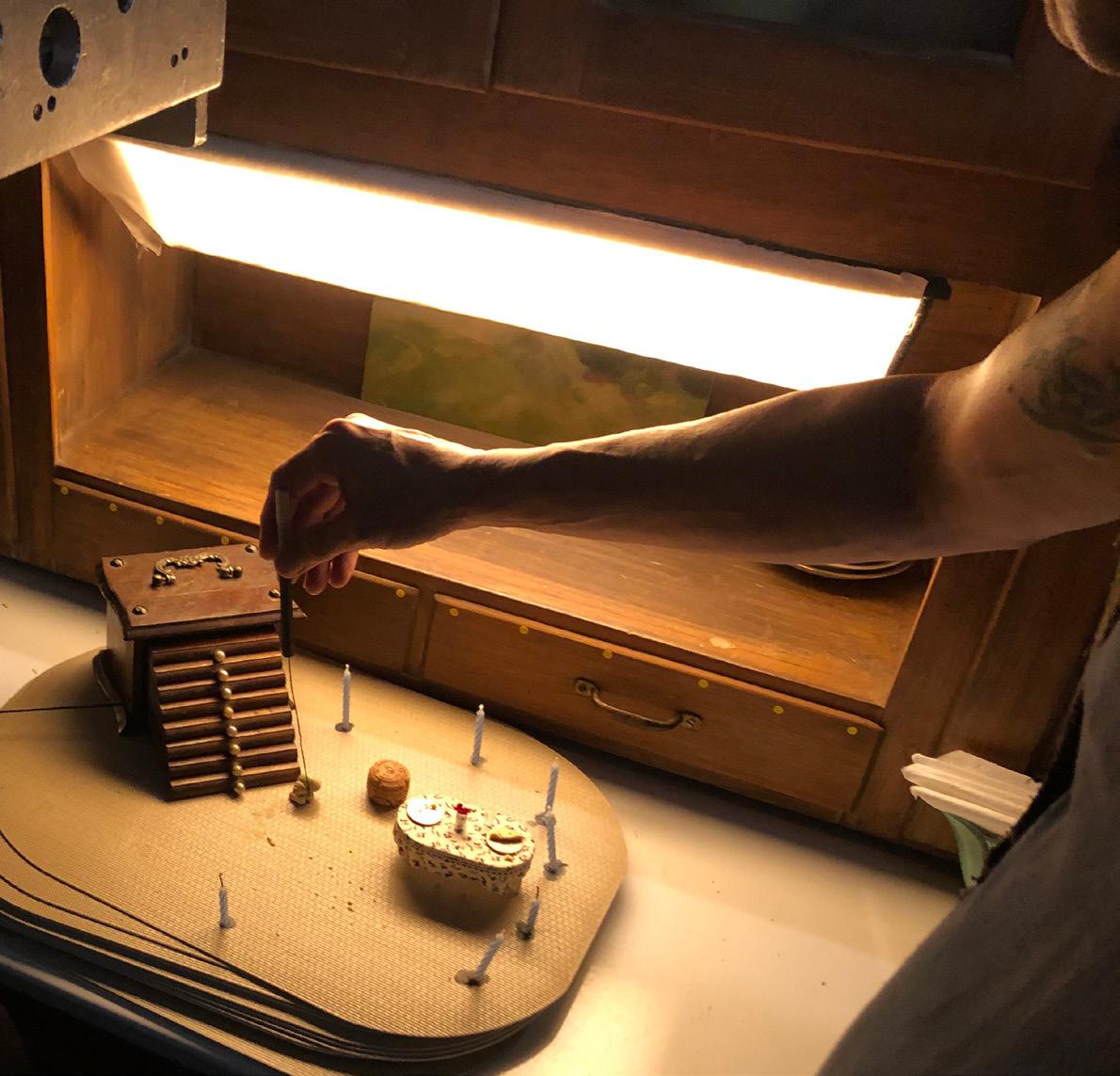

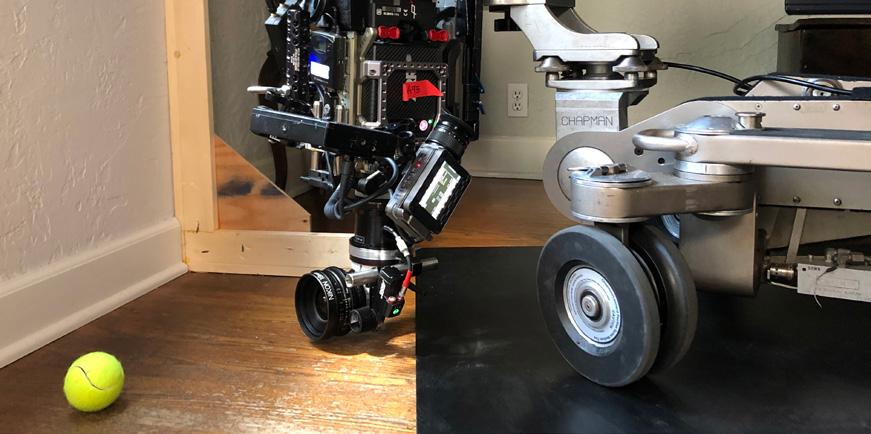


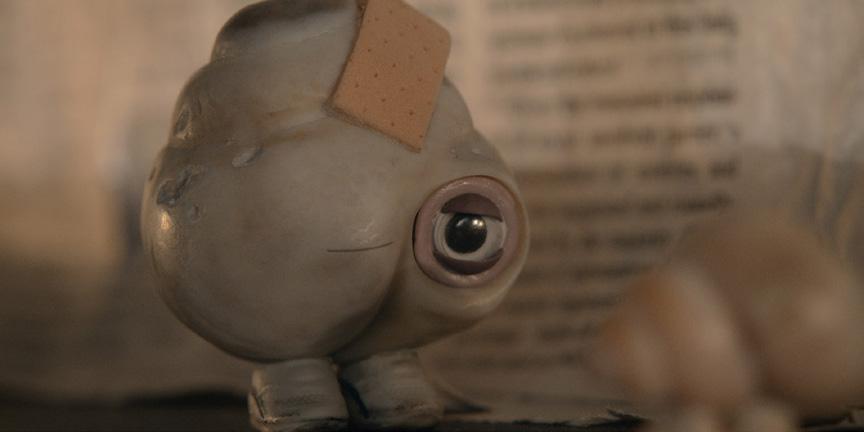
We worked very closely. Eric was amazing and was on-set with me every day, taking notes about which lenses and F-stops I was using, and the depth-of-field. He measured everything so he could copy it on-stage with Marcel, and was so good about letting me shoot the film the way I wanted to shoot it, which was doing it as much like a liveaction film as possible. Eric would let me know if something was too tricky for him.

Most stop-motion is very precise by its very nature, but we did it very differently and Marcel was the only stop-motion. So we had a lot of flexibility and could use handheld a lot. But there are some limitations with stop-motion, like going around the Z-axis. If you rotate around a character it can be very tricky. So when we did that we had to use motion control or hide it a bit.
Considering the miniature-scale you had to deal with, I assume the camera and lens package was pretty unusual?
It was. I shot with the Alexa Mini which I just love, and used Nikon AI Rehoused Primes, Panavision 19-90mm zoom, and a Panavision Periscope, all provided by Panavision, Woodland Hills, California.
The lens system was the trickiest thing. We wanted it all to feel very natural, but it’s very unnatural to film something that is one centimeter tall from the ground-up. So we had to use prism and periscope systems to get the camera low enough to be on the floor, and for filming in window sills and getting into weird places and so on. The Nikons were great as they’re really closefocus and the fall-off is beautiful. We didn’t have to use diopters very often.
Who were your crew?
We had 1st ACs Alaina McManus, Tiffany Nathanson, Tiffany Aug and Aaron Gambel; and 2nd AC Patricia Tscharskyj. The DITs were Mark Wilenkin and Felix Arceneaux. Our B-camera operator was Greg Williams. Brice Bradley worked as the chief lighting technician, with best boy Jesse Smith. Andy Taylor was the key grip with Joe Guzman was the best boy grip.

What about the lighting choices?
Lighting was also very tricky, as it had to feel very natural, and we tried to base it around practicals and window light. But, as it all had to be very controlled, it was all mainly artificial.
We also needed a lot more depth-of-field as we were so close to Marcel – it was less than an inch. We were constantly trying to get the stop up to a 8 or 11, so we had enough depth-of-field that the image didn’t look like it was all out of focus.

Our lighting set-up was quite varied and also fairly typical. We used a mixture of typical HMIs and LEDs, plus some Molebeams for sunlight. We also used unique lights that Brice Bradley made. He created miniature softboxes that would fit into our Marcel-sized sets.
Did you work with a colourist in prep on any LUTs?
We did, and then we did the DI at Light Iron with c olourist Ian Vertovec who is amazing. I’m really happy with the look we got.
Fair to say that making the film was a labour of love that combined a hand-made approach with some very sophisticated technology?
Absolutely. We wanted the result to feel a bit thrown-together, but it was very complicated to achieve that organic, casual look.
BIANCA CLINE•MARCEL THE SHELL WITH SHOES ON
CINEMATOGRAPHY WORLD MARCH 2023 77
BITTER PILL
By Ron Prince
Captured on Kodak 35mm film, by DP Benjamin Loeb, director Kristoffer Borgli’s visceral comedy, Sick Of Myself, satirises the trend of narcissistic obsession and performative victimhood.
Signe (Kristine Kujath Thorp) and Thomas (Eirik Sæther) are an unhealthily-competitive couple, engaged in a constant game of petty one-upmanship. Finding herself overshadowed by Thomas’s rise to fame as a contemporary artist, creating sculptures from furniture that he secretly steals from designer stores, Signe hatches a plan to reclaim her rightfully-deserved attention within the milieu of Oslo’s cultural elite.
She secures candy-coloured sedatives on the black market, which have the side-effect of producing severe scarring if taken in adequate quantities. As Signe grows increasingly faciallydisfigured, she also becomes increasingly adept at leveraging the attention from friends, plus likes on social media, that she desperately craves, to devastating effect.



The low-budget Norwegian/Swedish coproduction, written, directed and edited by Borgli, premiered at the 2022 Cannes Film Festival, and received rave reviews for its masterful achievement in socially-charged and satirical storytelling.
“In this day and age when there’s so much content to watch, I felt like I had read a narrative by someone who has a different brain, a different philosophy on life, and a desire to make something distinct and alternative,” says Loeb about his initial reaction to Borgli’s script. “It was far from mainstream cinema, and projects like that don’t come up very often, especially in Norway. So I was ecstatic about the chance to shoot it.
“During our initial meetings, Kristoffer said he wanted a slightly-elevated but naturalistic aesthetic, through a lens that observed Signe and Thomas from the outside, looking-in,” says Loeb. “Part of the way this film conveys its humour and message, is that the characters are not in on the joke – they are trapped inside themselves, inside the drama.
“Kristoffer was also quite adamant that he didn’t imagine this film being realised in digital. All that matters to me is achieving the feeling of what best suits each film, and what pleases my eye, and I agreed with him that film was my preferred choice too. There is something about film, that is
hard to explain, in the way that gives an emotional connection to the imagery, and therefore the story, that you don’t automatically get with digital.
“So, we discussed this with the producers, who initially replied that film was out of the question, given the low-budget. Rather than capitulate, we proposed to them that we cut three days off the schedule – from 33 down to 30 days – and shoot 2-perf on 35mm to help with stock and processing costs. Kodak UK helped us a lot with the film stock, and in the end the producers gave us their full backing.”
Visual references for the film included Arnaud Desplechin’s Comment Je Me Suis Disputé... (Ma Vie
Loeb shot with an ARRICAM LT in 2-perf on 35mm film, but framed intentionally for a 1.85:1 crop. The camera package supplied by Storyline in Oslo, Loeb’s
“Whilst the native, widescreen aspect ratio of 2-perf lends itself to having two or more characters in-frame at the same time, we really wanted the picture to be centred around the singular personalities of Signe and Thomas, Signe in particular,” Loeb explains. “We fell in love with the look that 2-perf 35mm 1.85:1 gave us – a feeling of something different, between regular 16mm and 35mm, that provided a connection to each character, but without looking obviously cinematic.”
Sexuelle) (1996, DPs Stéphane Fontaine AFC, Eric Gautier AFC, Dominique Perrier-Royer AFC) for the way the cinematography follows a group of friends and deals with their conversations, as well as the pace of the editing.


Loeb says more abstract inspiration also came from Borgli’s desire to play on the false memory that exists in Norway, about separate paintings by two of the country’s most beloved artists – Christian Krohg’s ‘Sick Girl’ (1881) and Edvard Munch’s ‘The Sick Child’ (1907), with their harrowing and sociallypolemical portrayals of the dark underbelly of modern industrial society.
Sick Of Myself was filmed during the summer months of 2021, over the course of 30, eight-hour shooting days, starting at locations around in Oslo for the first 20, before switching to Gothenburg, Sweden, for the remainder of the production, where scenes in Signe and Thomas’s apartment were captured.
As for the choice of lenses, Loeb remarks, “I like it when the framing and camera movement are motivated by the characters. It sort of feels weird to me if you bring too much attention to the camera itself. Knowing that we

78 MARCH 2023 CINEMATOGRAPHY WORLD
first choice rental house when shooting in Norway.
SICK OF MYSELF•BENJAMIN LOEB
I felt I had read a narrative by someone who has a different brain, a different philosophy on life
needed longer focal lengths to remain on the outside looking in, nothing too close, we ended-up with Cooke S4s and an Angénieux Optimo 24-290mm T2.8 zoom.”
As for the filmstocks, Loeb graded test footage for Borgli to review with colourist Julien Alary during prep, and, after due consideration, went with KODAK VISION3 250D 5207 for day exterior/interior, scenes and KODAK VISION3 500T 5219 low-light and night scenes.
“I have always liked these two filmstocks as they deliver a nice punch to the colours, and we wanted to keep the final look a little bit poppy,” say Loeb. “Knowing the Tungsten stocks desaturate the colours a touch we ended-up shooting 95% of the film using
might never make it to the final cut,” says Loeb. “He prefers to shoot different versions and varieties of a scene, and to hone-in on different performances that to develop the comedy in the story.
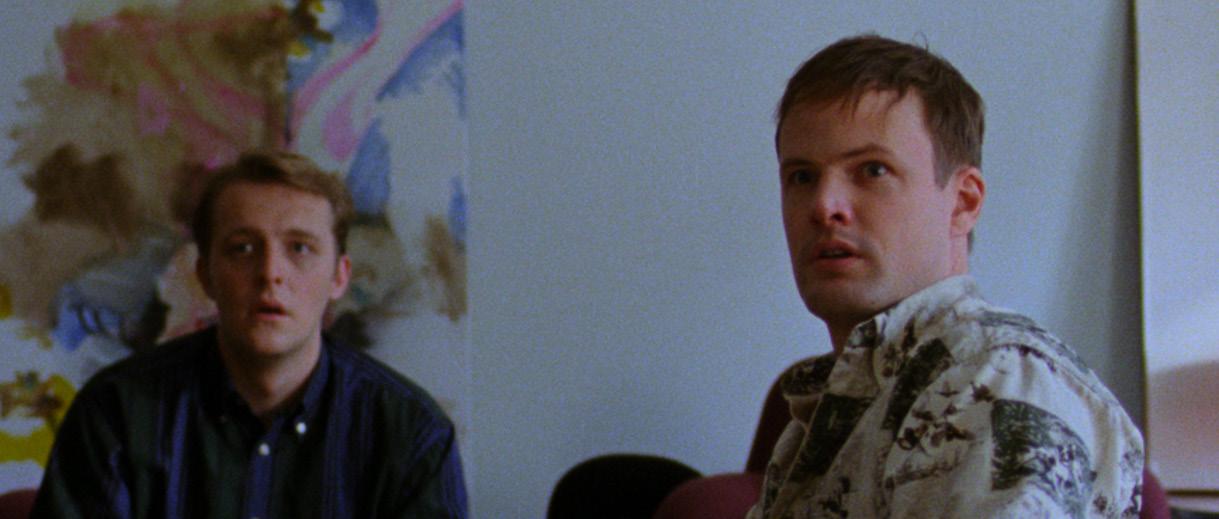

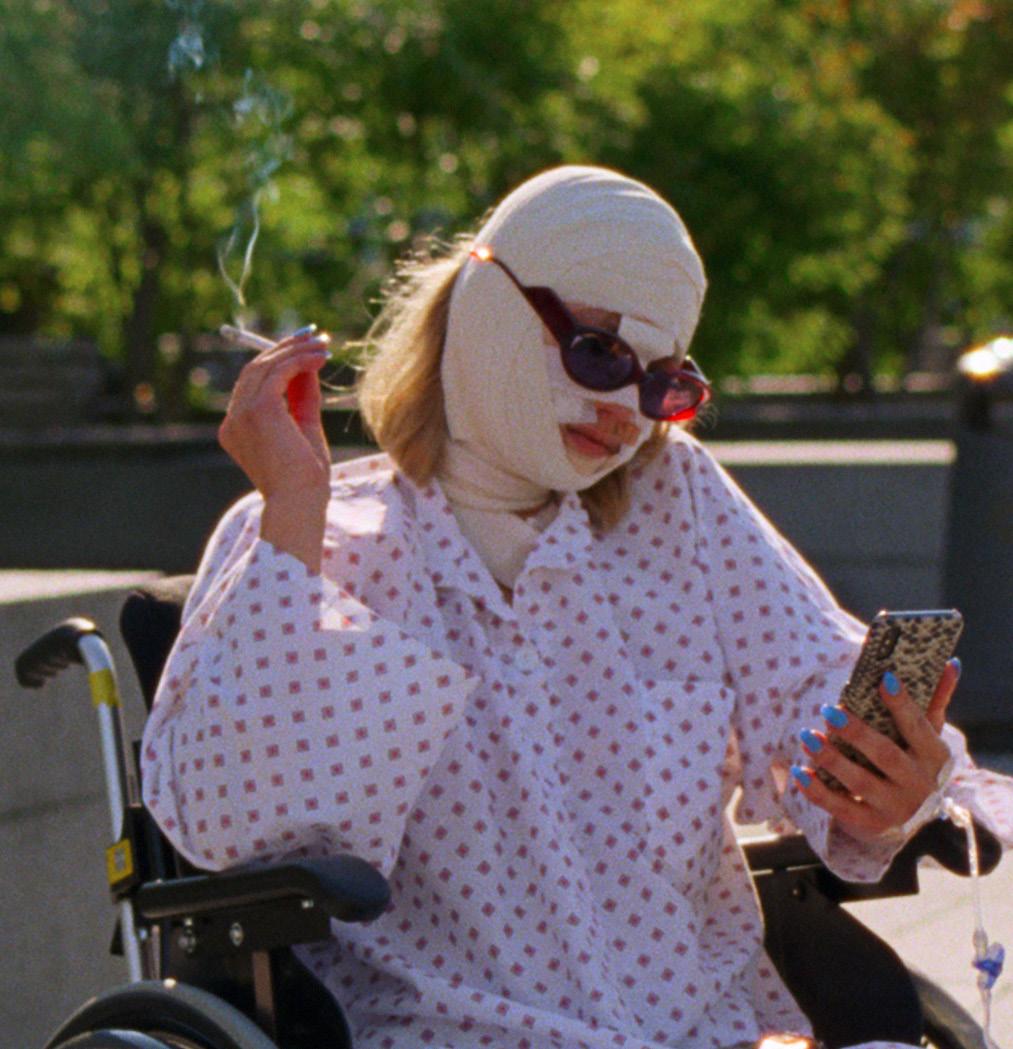
“So the Angénieux zoom came in really handy in that respect, as we could quickly reset the camera and reframe the image, without needing to change lenses. This helped the speed of production that we had promised the producers too. Also, working like this created a family atmosphere for the cast where everything just felt natural and their performances flowed freely. We actually used that Angénieux zoom for the vast majority of the film.”
To depict the one-upmanship and competitive verbal exchanges between Signe and Thomas, Loeb developed a technique of moving the camera between them using whip-pans.


“This ping-pong dynamic, where the camera flips back and forth between the characters, was a great way to show the dynamic of their relationship, and added to the comedic element. It wasn’t something that we figured-out directly in prep, it came more as we were filming. It was fun to shoot these scenes, as I had the script taped on the back of my shirt and Kristoffer would tap my shoulders when he wanted me to move the camera one way or the other.”
the 250D, as you can get outstanding results even in the extremes of exposure. The slightly faster stock also helped with the grain as we were punching into the negative quite a bit.”
Film processing and 2K scanning was done at Cinelab in London. “They gave us a very competitive package-deal, and developed and scanned the negative with great care. Their quality and speed of service in turning-around stills and dailies was phenomenal.” says Loeb.

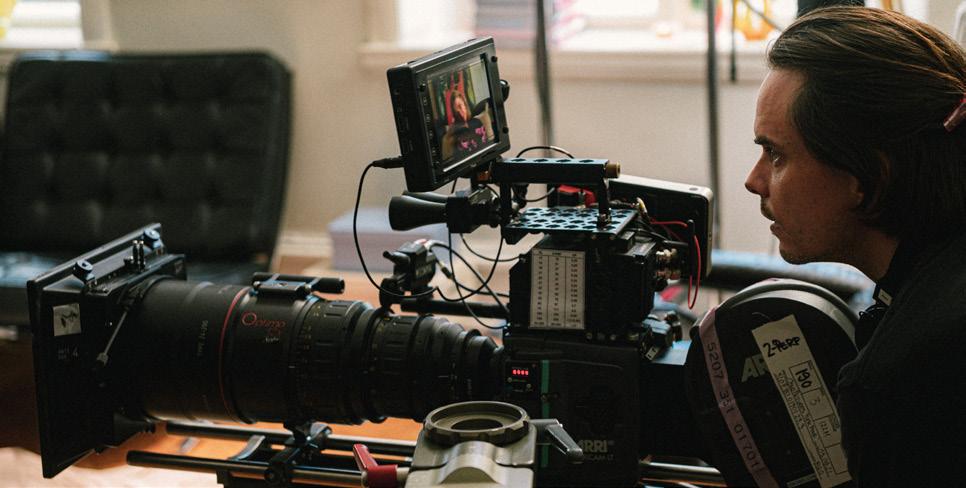
“There is always a certain level of stress that falls you on as to how the rushes are going to look when you’re shooting film. But seeing that things were looking good at an early stage, calmed my nerves, and I kind of forgot about that process after a while.”
Loeb operated during production, assisted by 1st AC Ola Austad and 2nd AC Robin Ottersen, with Bob Carho as key grip. Olav Haddeland was the gaffer.
“Kristoffer is a director who also edits, and he doesn’t spend time shooting traditional coverage that
Speaking about lighting the film, Loeb says the approach was governed by giving the actors a level of freedom to perform and Borgli’s desire for a slightly heightened naturalism.

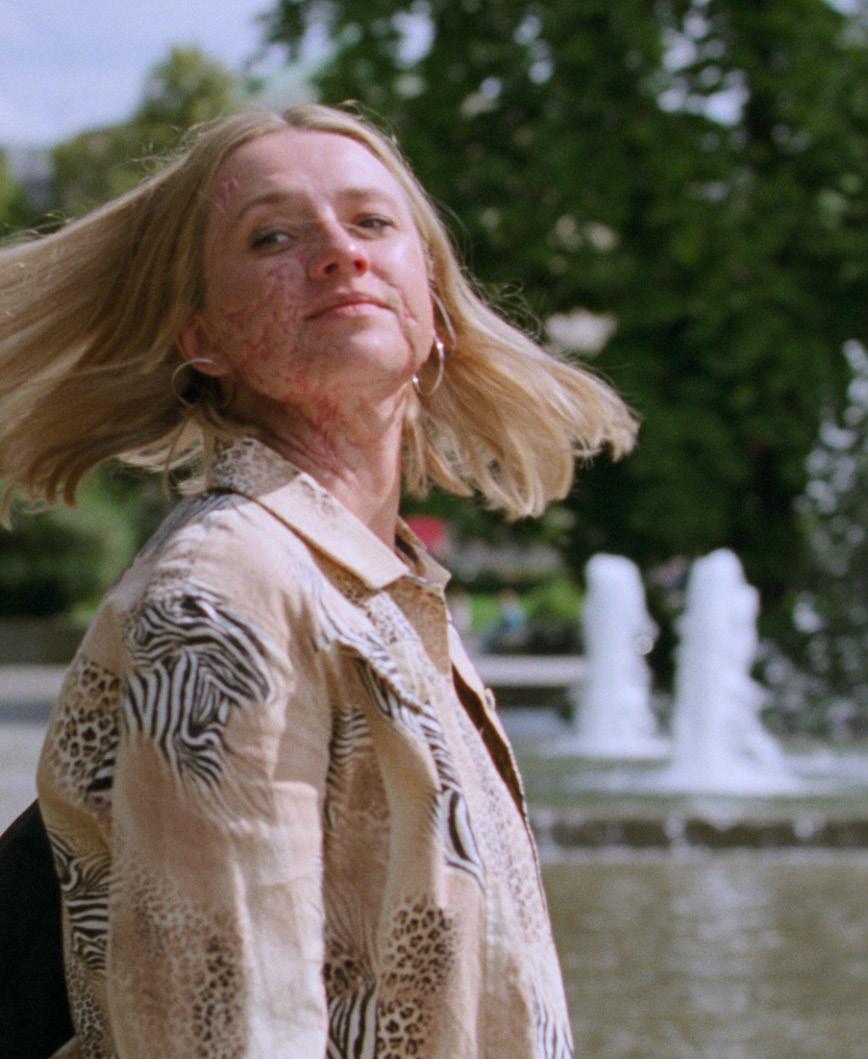
“I kept the lighting units off the floor as much as possible so the actors were not bound to marks or blocking. From an aesthetic point-of-view it was really about trying to keep things very simple, but with a slightly elevated sense of reality. We used a lot of practicals on the interiors, with HMIs pushing light in through the windows, and also had a modicum of hard, directional light on the actors. The result didn’t necessarily look hyper-real, but certainly heightened that sense of self that the story is all about.”
Loeb concludes, “I was very pleased to have been able to make this film in such close collaboration with Kristoffer, and to have had creative conversations with him, from the beginning to the end. I am very happy with the result, and hope that as a means of expression that celluloid film will remain part of the visual vocabulary of filmmakers for many years to come.”
BENJAMIN LOEB•SICK OF MYSELF
CINEMATOGRAPHY WORLD MARCH 2023 79
Sick Of Myself (Syk Pike), directed by Kristoffer Borgli. Film images © Oslo Pictures. BTS photos Per Larsson, 2022.
We used the Angénieux Optimo 24-290mm zoom for the vast majority of the film
MAGICAL MYSTERY TOUR
By Ron Prince
It’s kind of hilarious, and meant to be in all likelihood, that on the walk up Greek Street to visit Warner Bros. De Lane Lea, I pass by the Wizards & Wands Exploratorium. Set in a five-storey Soho townhouse, it promises ‘An immersive experience venue that brings magic to life for people of all ages, with patented magic wand technology and mad scientist beverages’.
So I’m primed and ready to see what other sort of magic lies ahead in a place that’s touted as ‘the only purpose-built post-production house in London, where a team of multi-award winning talent bring another level of service to the post production world’.
I’m meeting Michael Hamilton, the company’s friendly, fresh-faced director of post-production, who offers a WB liveried cup of coffee that has the words ‘Masters Of Picture And Sound’ inscribed on the inside lip. Along with Michael’s warm and enthusiastic welcome, what’s striking is that gaining access to the place has been though an unassuming reception and security area, along a narrow corridor and into a lift that has gone down, instead of up.
For you see, the new three-story facility is completely underground. It is subterranean by design, although there is a broad, circular light-well ushering-in natural daylight from street-level to all those different floors, plus ambient interior illumination, making it all feel like a regular office space.
“It’s a bit different here, but it’s very special,” replies Michael, as I drill down for more information about the who, what when where and why, during our prewalkabout chat.
Warner Bros. De Lane Lea traces its roots as far back as 1947, when Major William De Lane Lea, a French intelligence attaché for the British government, founded De Lane Lea Studios to dub English films into French. Based in Dean Street, Soho, it grew to become a facility of considerable renown for feature film dubbing and sound post services, before being taken over by Warner Bros. in 2012.
Picture post-production services – colour grading, VFX, editing, mastering a QC – were added in 2018, before the facility was moved to its new home at Ilona
Rose House on Greek Street. Michael has been with the company since 2010, working alongside Mike King, the company’s director of operations, to help to oversee that relocation.
“The facility here, which is connected by secure, instantaneous, dark fibre links to Warner Bros. Studios Leavesden and our facilities in LA, was seven years in the planning, took four years to build and three months
DP Larry Smith BSC). The company has also worked on TV series such as Warner Bros./HBO’s Pennyworth S3, Netflix’s The Crown S5, and Amazon Studio’s The Power and House Of The Dragon, to name just a few.
Whilst Warner Bros. De Lane Lea retains its long reputation in sound services – most notably, re-recording mixer, Chris Burdon, won the Academy Award for Best Sound for his work on Top Gun: Maverick – the company has lured an enviable roster of creative talents to its colour and editorial teams, as it steadily builds a similar reputation in picture post.
Senior colourist Asa Shoul, is a multi-award winner with over 25 years of experience. Colourists Otto Rodd and Tim Drewett bring a further 15 years of combined know-how in grading. Online editors, Gareth Parry and Tom Sugden, have a decade each in cutting pictures together.
A key ingredient in its mix of people and services, the company launched a digital on-set and on-location dailies division at Warner Bros. Studios Leavesden (WBSL) in 2019, complete with 4K screening, review and grading theatres, plus dark fibre connectivity to Soho HQ.


to transition the kit, data and people from our premises on Dean Street. And, all of that last part took place during one of our busiest periods,” says Michael.
Opened officially on September 28th 2022, and accessible to all-comers, not only Warner Bros-backed productions, recent DI colour grading projects running through the company include features such as Men (dir. Alex Garland, DP Rob Hardy BSC ACS), Matilda The Musical (dir. Matthew Warchus. DP Tat Radcliffe), Last Night In Soho (dir. Edgar Wright, DP Chung-hoon Chung) and Luther: The Fallen Sun (dir. Jamie Payne,
“ Dailies are a crucial part of the creative filmmaking process, and enable us to ingest images as they were intended to be seen by the director and cinematographer – whether that’s from a hard-drive or live 4K output from the camera on-set, and we’re pretty nimble in that respect,” Michael explains.
“One of the things about our dailies and picture post team is that they all have in-depth knowledge, and are here to offer guidance to productions, right from their earliest test and prep phases – about look-development and colour management, as well as creative and technical advice about workflows,
80 MARCH 2023 CINEMATOGRAPHY WORLD ON TOUR•WARNER BROS. DE LANE LEA
DPs can shoot with the confidence that their artistic intent will remain true from production to the DI
camera and lenses, even set design. It’s a two-way street, an interactive process, that ultimately means the cinematographer can shoot with the confidence of knowing their artistic intent will remain true during production through to the final DI.”
He also adds that, although it’s not a pre-requisite, the company likes ACES colour science management. “We generally specify ACES colour pipelines, as you know where you are with the colour.”
And then we’re off to explore the place, which despite its colossal 32,000sq/ft size, manages to feel intimate and boutique. Social space is a feature of the subterranean layout, set across two floors, linked by a spiral staircase, containing a coffee bar that has plenty of sofas and tables, and a library with even more sofas and tables. Private offices and dining spaces allow clients to hunker and chow-down, or hold private video conferences.
Inside the various ADR rooms, sound mixing and sound editorial stages, the acoustics and ambient soundproofing are such that you can actually hear your own heart beating, but not the nearby Northern Line.
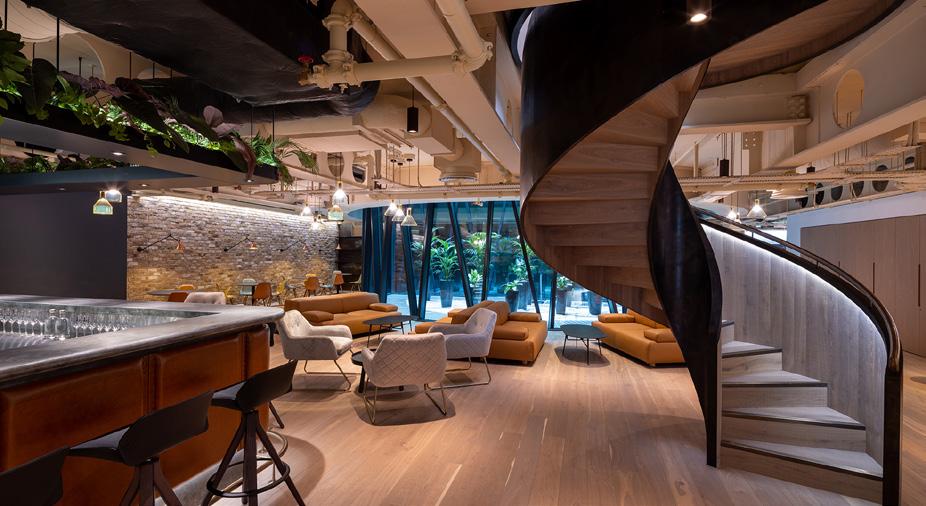

There are four theatres dedicated to sound post production and Stage 1, the largest mixing stage in the UK, will make you gasp at its cavernous size, not to mention the quality of its Dolby Atmos, 7.1 and 5.1 monitoring.
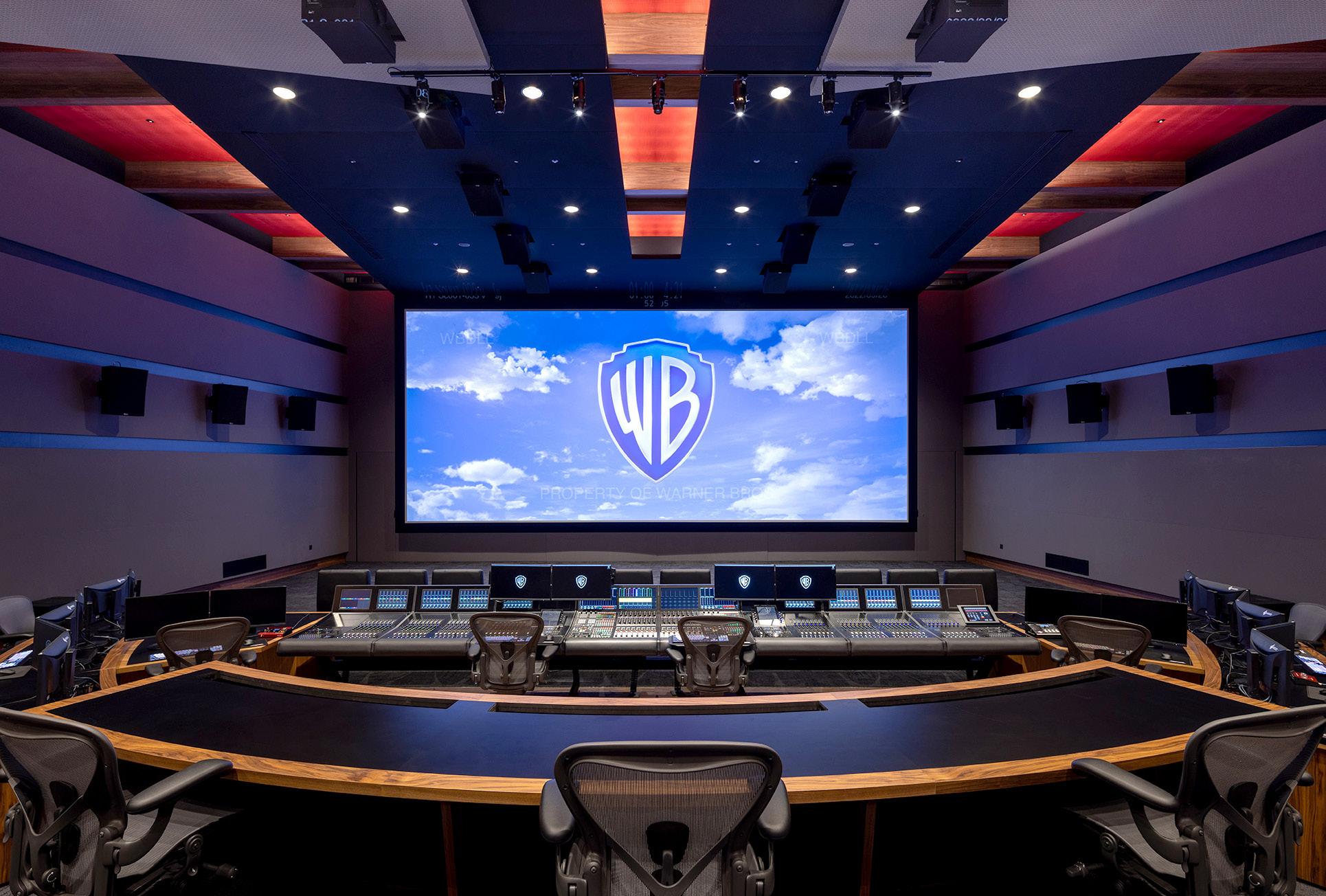

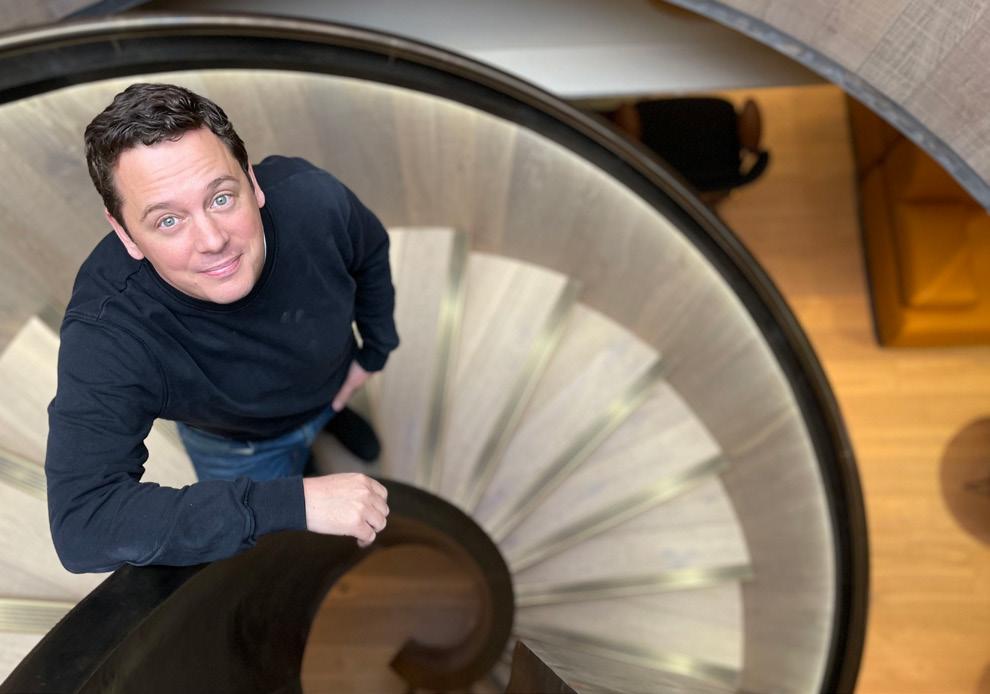
For grading there are three colour rooms, built to ultra-high specs for both picture and sound, with Filmlight Baselight X grading, 4K Christie CP4220 Xenon projection, Sony X300 operator monitoring, Panasonic 2000 series client review monitoring, plus Dolby Atmos and 5.1 sound. There are two online suites for editorial, VFX, review and spotting sessions. Two screening rooms, with bountiful seating capacities, offer 2K, 4K and celluloid film projection. A mastering and
QC suite encompass the full array of IMF and DCP packages.
Along with these impressive physical facilities, the company also offers Alfred an in-house developed workflow platform/portal allowing clients to control and manage their content anywhere, any time through a fully-integrated, secure, cloud-based system.
Michael was not at liberty to tell me what the overall investment has been, but with the premises, infrastructure, technology and talent, it must be a tidy sum.

Before we know it, two hours have gone by on this immersive tour. Warner Bros. De Lane Lea is without doubt a statement of the parent company’s confidence in the UK as a destination, as much as it is a declaration of excellence. It’s been an incredible, eye-opening visit, well worth your trouble too, if only for the ‘wow factor’, but more so, if you really care about the magic of filmmaking at its finest, as they clearly do here.


CINEMATOGRAPHY WORLD MARCH 2023 81 WARNER BROS. DE LANE LEA•ON TOUR
Michael Hamilton
Asa Shoul
Tim Drewett
MOST ILLUMINATING
By Ron Prince
As part of our on-going look at the world of lighting in film and TV production, we’re taking a trip to Universal Production Services – Set Lighting & Rigging, based in Borehamwood, on the outskirts of London.





82 MARCH 2023 CINEMATOGRAPHY WORLD SPOTLIGHT•UNIVERSAL PRODUCTION SERVICES
As the name suggests, the recently-established company is the new UK branch of the mighty Universal Production Services group, which has similar facilities in Albuquerque in New Mexico, Atlanta in Georgia, Chicago, New York and Los Angeles, California, where its global network of industry veterans and inventory, including the very latest lighting technology, help to support in bringing allmanner of productions to life.
Recent productions supported by Universal Production Services at Borehamwood include, Sky’s Brave New World, Bad Wolf/Sky/HBO Max’s I Hate Suzie Too, BBC/Universal’s Dodger, Sky Comedy’s Romantic Getaway and Christmas Carole, plus Wicked (dir. Jon M Chu, DP Alice Brooks ASC, gaffer David Smith), which is due to release in 2024.
The footprint of the facility is presently some 26,000sq/ft, but when you take into account the way kit is stacked in the warehouse, on rows and rows of 50ft-tall racks, the surface area becomes much larger than that. Have a look at the company’s website, where a neat drone shot will reveal all.

As you would expect, there are plenty of lighting stands, coils of cabling, shelves stuffed with ballasts, textiles/flags and other associated paraphernalia. Although the company offers the regular bevvy of traditional incandescent lighting fixtures, such as Fresnels and Pars, it is in perfect synchrony with the industry need for sustainability.
which have zero emissions, are easy transport and operate, and are also completely silent.”
Whilst much of the early focus has been on establishing the business, and supplying its nearby neighbours with equipment, Garvie is keen to spread word about the company, through attendance at events, such as the BSC Expo, Cine Gear Expo in LA and New York, and partnerships with groups such as Illuminatrix, the collective of professional female cinematographers based in the UK and working internationally.
The facility is located within 500 yards of both Elstree Studios and the new Sky Studios, and is the sole provider of lighting, rigging, power and associated equipment to both facilities, which both have expansion plans, in what is a burgeoning UK production industry. Universal also has two stages of its own at Elstree, the new Platinum Stages. Sustainability is a watchword at all of these facilities, as they strive for greener and more environmentally-friendly practices, with LED fixtures on the top of their shopping lists.
Along with having neighbours nearby, the company’s Borehamwood base is also neatly sited so that trucks, loaded with equipment, can easily slip round to other UK studios or location shoots in the southeast via the M25, or deliver wider to other destinations right around the UK via the national motorway network.
UK industry veteran, Rob Garvie, joined the company in 2021, to get things off-the-ground and leads the cause as company director. An affable and well-known figure, he has 35 years of experience in film equipment rental, having started at Grip House before moving to Samuelsons, followed by twenty years at Panavision and then six at Panalux.

“We started Universal Production Services – Set Lighting & Rigging with a crew of five, that has grown now to 24, and I expect we’ll keep growing the team continually as our business and client-base expand due to the global hunger for content,” he says.
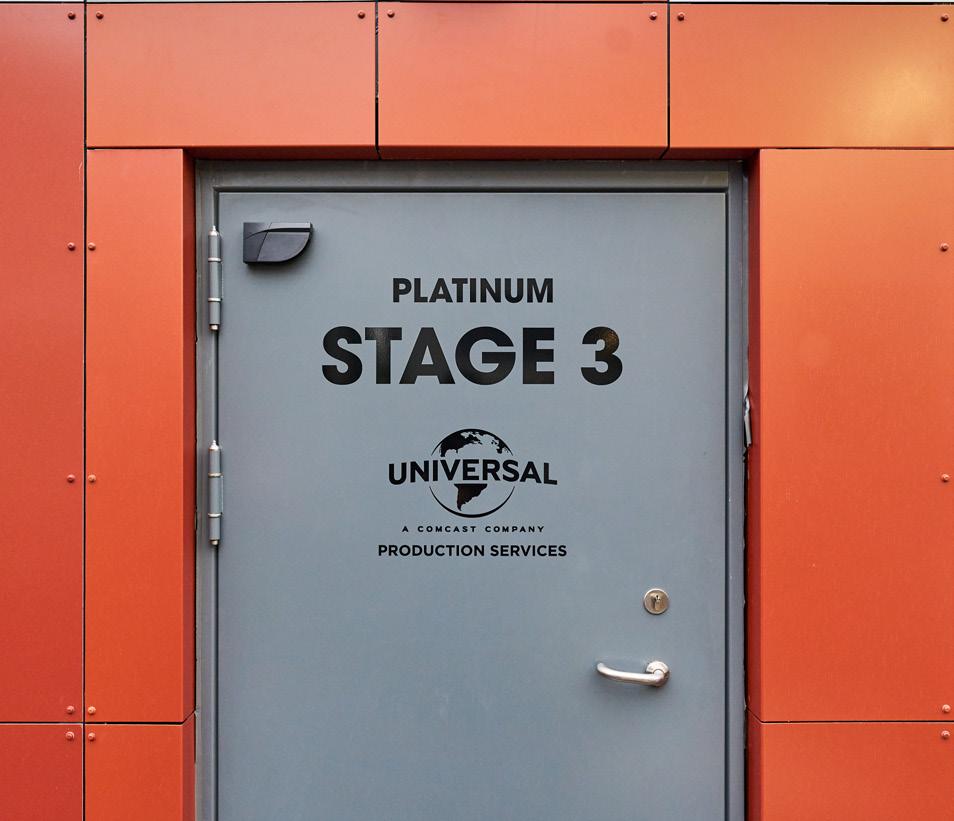
“The UK is an attractive destination for incoming productions, but whilst the figures themselves are big, it’s still very much a people business. I’m thankful that we’ve already attracted a good-many stalwarts, with deep knowledge as well as great professional reputations amongst DPs, gaffers and production managers, to join the effort.”
These include lighting account managers Mark Greaves, Christian Schofield and Karine GamaDavidson, operations manager Peter Carter, Claire Wood as head of set rigging, fleet manager Mick Doe, and technical manager Ben Taylor, who cumulatively bring decades of experience to the business.

NBCUniversal recently become an accredited member of the BAFTA Albert scheme, so there’s an impressive abundance of the most modern LED lighting technology, from manufacturers like Creamsource, ARRI, Chroma-Q, DoPchoice, LiteGear, FilmGear, LitePanels, KinoFlo, Sumolight and Ayrton, to name just a few.
If you’re a DP or gaffer, then you can expect an invitation – or just go ahead and ask for one – as Garvie and his team are keen for as many professional image-makers as possible to come along and see the company for themselves.
Of course, one would love to know how much all of this has cost, but Garvie is not able to divulge that. One imagines that it must be in the tens of millions of dollars. However, he does reveal that the business will continue to expand, and that it has considerable buying power.
This large and ever-growing inventory also encompasses LED lighting instruments from Cineo Lighting (an NBCUniversal Company), such as the high light-output ReFlex R15, Quantum Studio and Quantum II, with the innovative Quantum Ladder available soon. (We’ll be covering Cineo Lighting and its product range in a future edition of Cinematography Word, so stay tuned for that!)
“We provide state-of-the-art lighting technology, associated gear and services to support productions of all sizes, and take the commitment to sustainability very seriously,” affirms Garvie, as we look around those canyons of neatly-stacked gear.
“LEDs use less electricity and emit less heat, reduce overhead costs whilst achieving studio standards of illumination. We have everything here to help productions go green, but without sacrificing quality.

“In fact, our expanding fleet of generator carrier vehicles, from 300KvA to 40KvA 4x4s, run exclusively on hydrotreated vegetable oil (HVO) fuel, which has up to 90% fewer life-cycle emissions than fossil diesel. These vehicles are fuelled with HVO for both driving and location power in order to significantly reduce overall emissions. We also have portable power stations, in the form of Voltstack 5KW and 1.8 kW units,
“The idea is that Universal Production Services always has everything that a production might need, and that our high-quality lighting packages can be instantly secured, at competitive rates,” he says. “Our goal is to see every production succeed, no matter it’s size of scale. This is just the start, so watch this space.”
CINEMATOGRAPHY WORLD MARCH 2023 83 UNIVERSAL PRODUCTION SERVICES•SPOTLIGHT
We have everything here to help productions go green, but without sacrificing quality
Our goal is to see every production succeed, no matter it’s size of scale
SHINING A LIGHT ON...
By David Wood
It can be tough to get a break in film lighting. Jobs can be few and far between, and rarely advertised.
Tougher still if you’re female. Women are doubly-discouraged when it comes to establishing themselves in the lighting department by a killer combination of the profession’s lack of positive role models for women and what many see as its macho culture.
But there are clear signs that chinks in the armour of this male-dominated world are beginning to appear. In Mexico, for example, a group of women have empowered themselves by setting-up their own all-women lighting and grip company, Las Amazonas Eléctricas.

As Sophia Stieglitz, the group’s co-founder, recalls, forging a career for herself growing-up in Mexico was difficult.
“The industry there is still very much a man’s club,” she says. In fact, it wasn’t until she went to LA to study Fine Art Cinematography at the American Film Institute that she began to be recognised and opportunities to further her career presented themselves.
shoot by her focus puller, who added they would be bound to get along as they were both super-passionate about film lighting. She was right. Gaffers Marylu Almazan and Maya Santiago also joined and the shoot was a resounding success.
“They wanted women in every crew position on that job, and that was when we realised that we are unique, we are Amazons,” declares Stieglitz. “And that I how Amazonas Electricas was born.”
Las Amazonas Eléctricas has since gone from strength-to-strength, acting not just as a group of skilled female sparks and grips, but as a platform for women to develop a career in film lighting.
Stieglitz says, “We have been giving workshops and teaching the trade at film schools in Mexico for two years now, and offer intern positions on our productions. In that time we taught a lot of women.”
The group now comprises three gaffers and eight swings (trade professionals who offer both sparks and grip services). Recruits often come from families who already have people working in film production, but group co-founder Anni Martinez reveals she got her original break in the industry completely by chance.
Martinez, then a stay-at-home mum, met someone looking for extras for a commercial as she was picking-up her children from school one day.
Stieglitz, now a full-time cinematographer, reports that sometimes Las Amazonas Eléctricas are so popular and busy, with work ranging from high end-commercials and TV series to feature films, she can’t hire them for the jobs she’s been offered.

In 2018 Stieglitz decided to move back to Mexico because her career as a cinematographer was beginning to take off. That was when she was approached by Mexican DP Leslie Montero to work on a Chrysler commercial which, according to Stieglitz, was very much oriented around the woman’s gaze.
Montero and director Faride Schroeder, who represents the Free The Work movement in Mexico, a global non-profit initiative and talent discovery platform for underrepresented creators, asked Stieglitz if she was able to assemble an allwoman lighting and grip crew for the commercial. This request would prove to be the inspiration for setting-up Las Amazonas Eléctricas.
Group co-founder and gaffer, Anni Martinez, was recommended to Stieglitz for the Chrysler
“When I arrived on-set for the shoot, I was fascinated by what went on behind the cameras,” says Martinez. After that shoot, the company contacted her again, this time to offer her a job cleaning sets, which she did for 18 months before she decided she wanted to join the lighting team.
Martinez says, “Although I only saw men working – not a single female – I asked the gaffer and he said ‘Yes’.”
One of the experiences which boosted her confidence to go on and become a gaffer was receiving an invitation from Carlos S ánchez, a famous gaffer in the industry in Mexico, to work on the 007 Bond film Spectre (2015, DP Hoyte Van Hoytema NSC FSF ASC) as part of his electrical team. “I was like Wow! Yes! It was a huge production.”
Posting their work on social media #amazona selé ctricas has helped inspire women further afield to find careers in sparks and grip and help change d the film industry, with similar groups starting in Spain and Brazil.
The group has credits in TV, including the comedy mini-series The Skinny (DP Moira Morel, gaffer Sophia Stieglitz), and Disney+ series Not My Fault (2022, DP Julia Zakia), the young-adult action-comedy horror series Pinches Momias, and the comedy Pena Ajena (2022, DP Leslie Montero), all gaffed by Anni Martinez.

Feature films include Sunseekers, (gaffer Mexico Maya Santiago) currently in production, Beba in 2021 (DP Sophia Stieglitz, directed by Rebeca Huntt), plus there’s a wide range and growing list of commercials for clients such as BMW, Gucci, Chrysler, Netflix and Amazon.
Stieglitz puts the success of the group down to film crews realising that there is a different dynamic on-set when more women are involved.
“The energy on-set changes when it’s more equilibrated... because female and non-binary crews change the ambience so that it does not feel too loaded on one side,” she says.
“Las Amazonas Eléctricas gets called because its crews help to create a shooting environment where actors feel more comfortable. Sometimes a situation where there’s one woman on-set surrounded by 30 men can feel intimidating. With the inclusion agenda we feel more comfortable,
GAFFERS CAFÉ•LAS
ELÉCTRICAS 84 MARCH 2023 CINEMATOGRAPHY WORLD
The energy on-set changes when it’s more equilibrated... female and non-binary crews change the ambience
AMAZONAS
actors feel safer, and so do the men.
“Also, there’s certainly been a history of bullying on-set, and it’s our responsibility to challenge the expression of toxic masculinity. We can sow a seed, but it’s not only up to us. Men have been relating to each other in a certain way and as women we can feel pressurised to relate in that way too, because
those are the kind of relationships that men have. But now, as the world changes with gender inclusion, we can create new ways to communicate and relate to each other. Even the men feel more comfortable when the crew is in equilibrium.”

The world of film lighting technology is changing, states Stieglitz. “The kit is safer and lighter. There are fewer heavy cables and many more opportunities for women to study, work and train as working mothers.”



Of course, some things don’t change. “We all have to be on our toes and sharp on-set, regardless of gender, because lighting can be dangerous and it’s a big responsibility to keep everybody safe, but that doesn’t mean we can mistreat each other.”
Many of the members of Las Amazonas
Eléctricas have to face the challenge of managing a career with running a family. Martinez, currently expecting her sixth child, points out that being both a mum and working in the industry is complex.
“Who is going to look after your kids and make sure they have food when you’re working, scouting locations or going to meetings? It’s hard when your inner-circle judges you, saying you are a bad mother, that you are abandoning your kids, but for a man that’s OK. That’s the hardest thing.”
Stieglitz adds, “In Mexico the Latin macho culture is intrinsic to culture in general. For women there’s also the Catholic guilt-trip about not being home for the family. The culture is much more permissive towards men.”
As one of the industry’s premier rental resources, we are extremely proud to support crews around the world with an unrivalled collection of production solutions which embrace both the conventional and the very latest in advanced lighting technology.

Las Amazonas Eléctricas’ leaders and most experienced gaffers are all mums who have found a way to create a career in film lighting.
Says Stieglitz, “We have support from our communities, from our families, plus we create the support by hiring people to help us, and that has given us the opportunity to pursue our dreams.
“We are passionate about filmmaking and we want to be women who can follow their dreams. That’s the example we want to be for our children. That makes us good mothers in a new way.”
CINEMATOGRAPHY WORLD MARCH 2023 85
STUDIO LOCATION FEATURES COMMERCIALS DRAMA TELEVISION EQUIPMENT GENERATORS TRANSPORT SUPPORT INNOVATION SAFETY SUSTAINABILITY
MBS Equipment Company Lakeside Road, Colnbrook, Slough, Berkshire SL3 0EL +44 (0) 1753 987 888 mbseco.uk PMBS generic quarter.indd 1 12/01/2022 11:18
Whatever your production type, wherever you are, when it comes to lighting - we’ve got the lot.
LAS AMAZONAS ELÉCTRICAS•GAFFERS CAFÉ
Opposite: Alma, Annie, Sophia and Mari; DP Sophia Stieglitz; and Marylu Almazan. This page: Photos of Maya Santiago and the Amazonas in action.
As the world changes with gender inclusion, we can create new ways to communicate and relate to each other
SHOOTING GALLERY•BSC EXPO 2023 EXTRA-TIME!



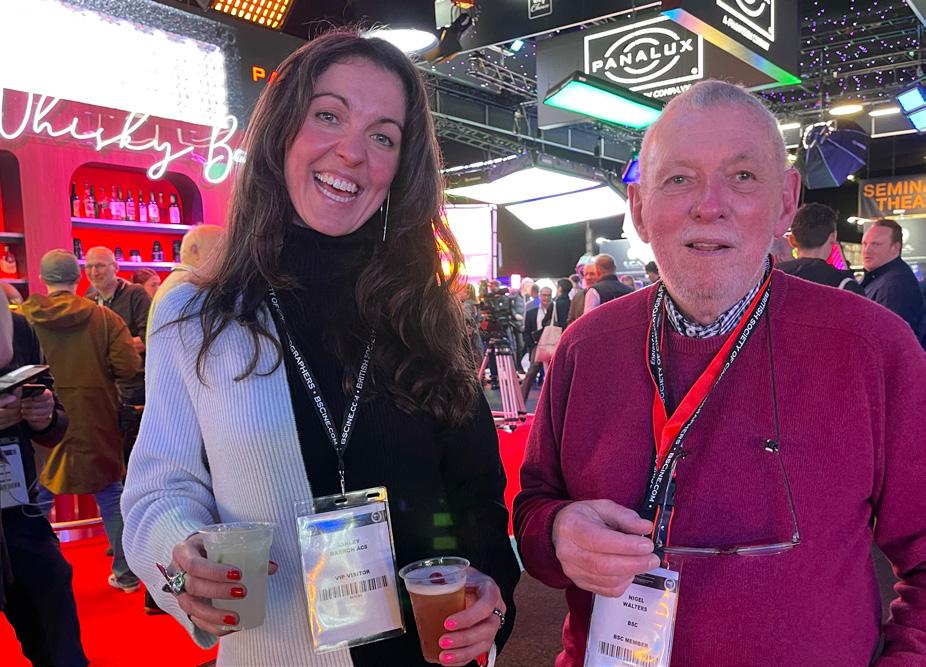





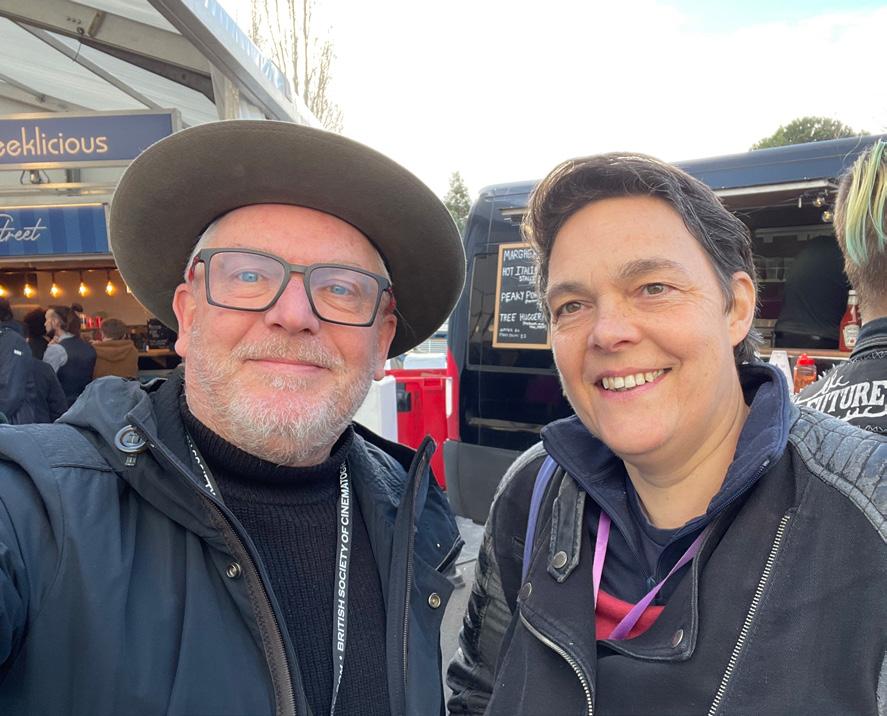
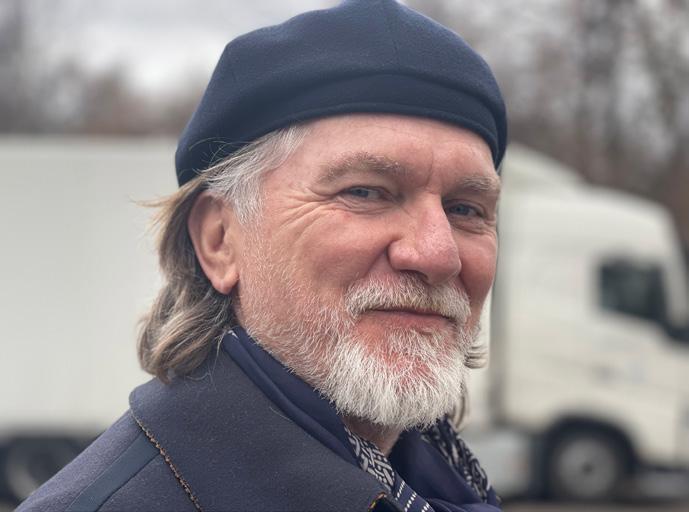






86 MARCH 2023 CINEMATOGRAPHY WORLD
Panavision’s Kim Snyder and Terra Bliss Rob Hardy BSC ASC, Ellen Kuras ASC and John de Borman BSC AFC
The one and only… Bernie Grill Jnr of Licht Technik enjoys a right good read! (Photo by Kaz Pearman)
Photos by Ron Prince.
Dedo Weigert
Another master of light… gaffer Julian White
Cinematography World editor-in-chief, with
The delightful team at
Michael Cioni of Frame IO
Patrick Renner of Pomfort Enthusiastic students from Met Film School
DP Gary Shaw
Dangerous Liaisons… DP Ashley Barron ASC and Nigel Walters BSC
Vicci Clayton of LCA and Sean Goosen from Creamsource LA
It’s a dog’s life… Bracken & Aggie representing NXTGEN BPS
Phil Greenstreet of Rosco loves Cinematography World too!












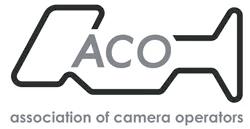
















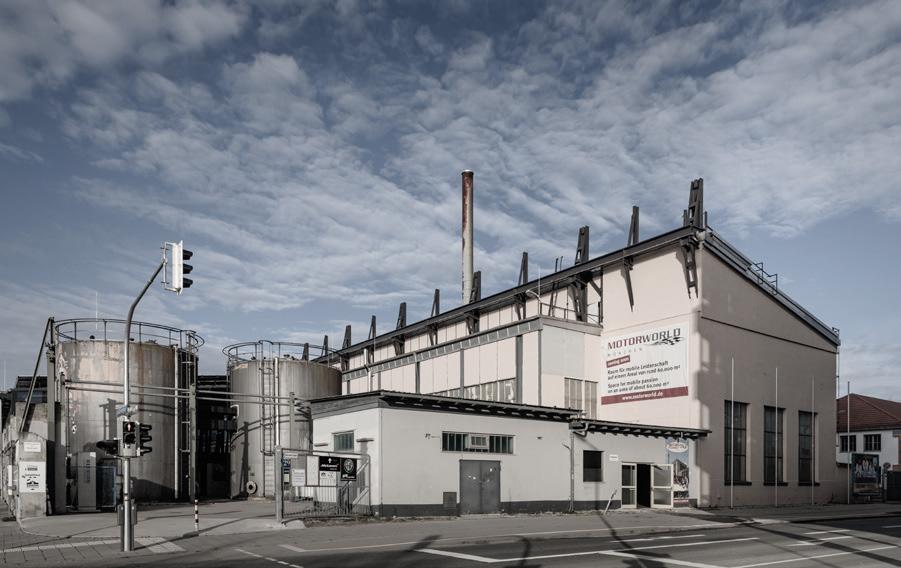

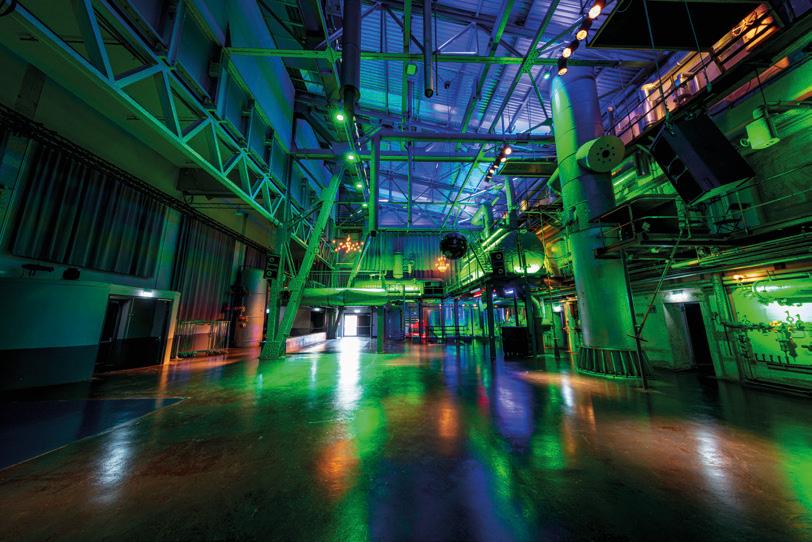
+44 1428 609 382 info@eurocineexpo.com FREE ENTRY! EUROCINEEXPO.COM 2023 30 th JUNE - 1 st JULY 2023 MOTORWORLD MUNICH OFFICIAL PARTNERS REGISTER NOW TO GET YOUR FREE VISITOR TICKET TO THE FASTEST GROWING INDUSTRY EVENT IN THE WORLD! DON’T MISS THE INTERNATIONAL EVENT UNITING THE FILM AND TV INDUSTRY NOW IN ITS 2ND YEAR 5 UNIQUE HALLS PLUS OUTDOOR EXHIBITS VIRTUAL PRODUCTION FEATURE TECHNICAL PRESENTATIONS AND SEMINARS IN CONVERSATIONS WITH LEADING CINEMATOGRAPHERS AND CREW LIGHTING WORKSHOPS NETWORKING EVENTS AND PARTIES INTERNATIONAL EXHIBITOR LIST








 Ron Prince Editor in Chief
Ron Prince Editor in Chief
































































 This page: (clockwise from top) –Arran Green Count Abdulla; Jo Jo Lam at the IFFR worldpremiere of Playland; Tom Turley on Chemistry Of Death.
Opposite: Martyna Knitter during production on My Eyes Are Up Here.
This page: (clockwise from top) –Arran Green Count Abdulla; Jo Jo Lam at the IFFR worldpremiere of Playland; Tom Turley on Chemistry Of Death.
Opposite: Martyna Knitter during production on My Eyes Are Up Here.





 This page: Tony Jackson on set of We Were The Lucky Ones.
This page: Tony Jackson on set of We Were The Lucky Ones.



























 This page: (clockwise from top) – Ed Clark; David Luther on Alex Rider; Ed Clark with the Steadicam.
Peter Zeitlinger ASC has been working with director Marc Recha on Centaurs Of The Night, filming in the ancient Cistercian monestary of Poblet in Catalonia, shooting 4:3 format
Photography by Lucia Faraig
Photograph by Sergi Miranda
One frame fits your large LED panel lighting fixture: ARRI Skypanel 360
This page: (clockwise from top) – Ed Clark; David Luther on Alex Rider; Ed Clark with the Steadicam.
Peter Zeitlinger ASC has been working with director Marc Recha on Centaurs Of The Night, filming in the ancient Cistercian monestary of Poblet in Catalonia, shooting 4:3 format
Photography by Lucia Faraig
Photograph by Sergi Miranda
One frame fits your large LED panel lighting fixture: ARRI Skypanel 360



























































































































































































































































































































































































